ZyXEL Communications NBG-419NV2 Wireless N NetUSB Router User Manual Book
ZyXEL Communications Corporation Wireless N NetUSB Router Book
Contents
- 1. Users Manual-1
- 2. Users Manual-2
Users Manual-1
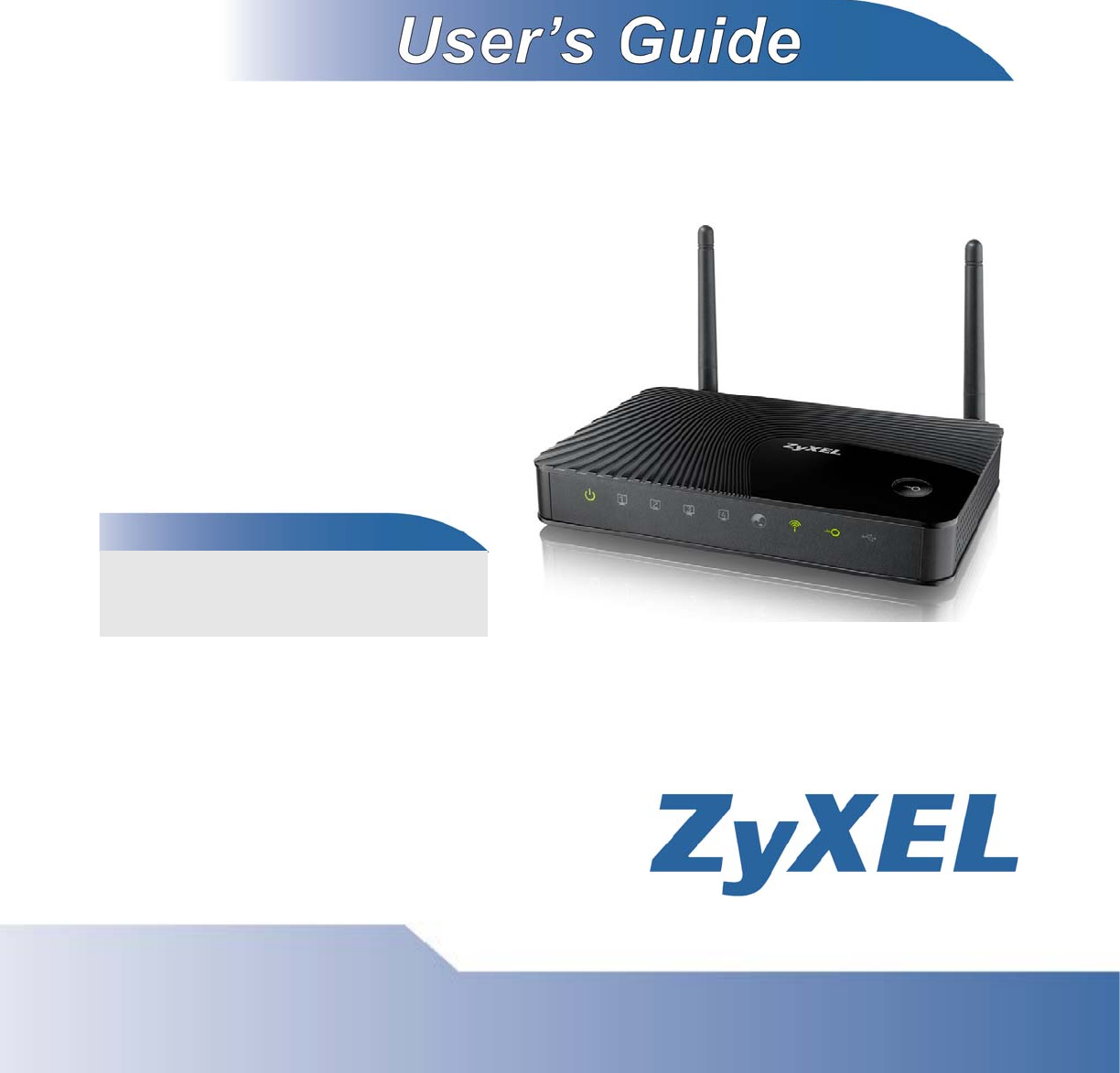
www.zyxel.com
www.zyxel.com
NBG-419N v2
Wireless N NetUSB Router
IMPORTANT!
READ CAREFULLY
BEFORE USE.
KEEP THIS GUIDE
FOR FUTURE
REFERENCE.
Copyright © 2012
ZyXEL Communications Corporation
Version 1.00
Edition 2, 03/2012
Default Login Details
LAN IP
Address http://192.168.1.1
Password 1234

NBG-419N v2 User’s Guide2
IMPORTANT!
READ CAREFULLY BEFORE USE.
KEEP THIS GUIDE FOR FUTURE REFERENCE.
Graphics in this book may differ slightly from the product due to differences in operating systems,
operating system versions, or if you installed updated firmware/software for your device. Every
effort has been made to ensure that the information in this manual is accurate.
Related Documentation
•Quick Start Guide
The Quick Start Guid shows how to connect the NBG-419N v2 and access the Web Configurator .

Contents Overview
NBG-419N v2 User’s Guide 3
Contents Overview
User’s Guide .......................................................................................................................................13
Getting to Know Your Router ..................................................................................................................15
The WPS Button .....................................................................................................................................20
ZyXEL NetUSB Share Center Utility .......................................................................................................21
Connection Wizard ..................................................................................................................................29
Introducing the Web Configurator ...........................................................................................................39
Monitor ....................................................................................................................................................45
Router Modes ..........................................................................................................................................51
Easy Mode ..............................................................................................................................................53
Router Mode ...........................................................................................................................................64
Access Point Mode .................................................................................................................................71
WISP Mode .............................................................................................................................................78
Tutorials ..................................................................................................................................................89
Technical Reference ........................................................................................................................101
Wireless LAN ........................................................................................................................................103
WAN ...................................................................................................................................................... 119
LAN .......................................................................................................................................................133
DHCP Server ........................................................................................................................................137
Network Address Translation (NAT) ......................................................................................................141
Dynamic DNS ........................................................................................................................................147
Static Route ...........................................................................................................................................149
RIP ........................................................................................................................................................153
Firewall ..................................................................................................................................................155
Content Filter .........................................................................................................................................159
Bandwidth Management .......................................................................................................................163
Remote Management ............................................................................................................................170
Universal Plug-and-Play (UPnP) ...........................................................................................................173
Maintenance ..........................................................................................................................................181
Troubleshooting ....................................................................................................................................191

Contents Overview
NBG-419N v2 User’s Guide
4

Table of Contents
NBG-419N v2 User’s Guide 5
Table of Contents
Contents Overview ..............................................................................................................................3
Table of Contents .................................................................................................................................5
Part I: User’s Guide ......................................................................................... 13
Chapter 1
Getting to Know Your Router.............................................................................................................15
1.1 Overview ...........................................................................................................................................15
1.2 Applications .......................................................................................................................................15
1.3 Ways to Manage the Router .............................................................................................................15
1.4 Good Habits for Managing the Router ..............................................................................................16
1.5 LEDs .................................................................................................................................................17
1.6 Wall-mounting Instructions ................................................................................................................18
Chapter 2
The WPS Button..................................................................................................................................20
2.1 Overview ...........................................................................................................................................20
Chapter 3
ZyXEL NetUSB Share Center Utility..................................................................................................21
3.1 Overview ...........................................................................................................................................21
3.1.1 Quick Setup .............................................................................................................................21
3.1.2 Installing ZyXEL NetUSB Share Center Utility .........................................................................21
3.2 The ZyXEL NetUSB Share Center Utility ..........................................................................................22
3.2.1 The Menus ...............................................................................................................................23
3.2.2 The ZyXEL NetUSB Share Center Configuration Window ......................................................25
3.2.3 The Auto-Connect Printer List Window ...................................................................................25
3.2.4 Exit the ZyXEL NetUSB Share Center Utility ...........................................................................26
Chapter 4
Connection Wizard .............................................................................................................................29
4.1 Overview ...........................................................................................................................................29
4.2 Accessing the Wizard ........................................................................................................................29
4.3 Connect to Internet ............................................................................................................................30
4.3.1 Connection Type: DHCP .........................................................................................................31
4.3.2 Connection Type: Static IP ......................................................................................................31
4.3.3 Connection Type: PPPoE ........................................................................................................32

Table of Contents
NBG-419N v2 User’s Guide
6
4.3.4 Connection Type: PPTP ..........................................................................................................33
4.3.5 Connection Type: L2TP ...........................................................................................................34
4.4 Router Password ...............................................................................................................................36
4.5 Wireless Security ..............................................................................................................................36
4.5.1 Wireless Security: No Security ................................................................................................36
4.5.2 Wireless Security: WPA-PSK/WPA2-PSK ...............................................................................37
Chapter 5
Introducing the Web Configurator ....................................................................................................39
5.1 Overview ...........................................................................................................................................39
5.2 Accessing the Web Configurator .......................................................................................................39
5.2.1 Login Screen ...........................................................................................................................39
5.2.2 Password Screen ....................................................................................................................40
5.2.3 Home Screen ...........................................................................................................................41
5.3 Resetting the Router .........................................................................................................................43
5.3.1 Procedure to Use the Reset Button .........................................................................................43
Chapter 6
Monitor.................................................................................................................................................45
6.1 Overview ...........................................................................................................................................45
6.2 What You Can Do .............................................................................................................................45
6.3 The Log Screen .................................................................................................................................45
6.3.1 View Log ..................................................................................................................................45
6.4 BW MGMT Monitor ...........................................................................................................................47
6.5 DHCP Table ...................................................................................................................................47
6.6 Packet Statistics .............................................................................................................................48
6.7 WLAN Station Status .....................................................................................................................49
Chapter 7
Router Modes......................................................................................................................................51
7.1 Overview ...........................................................................................................................................51
7.1.1 Web Configurator Modes .........................................................................................................51
7.1.2 Device Modes ..........................................................................................................................51
Chapter 8
Easy Mode...........................................................................................................................................53
8.1 Overview ...........................................................................................................................................53
8.2 What You Can Do .............................................................................................................................54
8.3 What You Need to Know ...................................................................................................................54
8.4 Navigation Panel ...............................................................................................................................55
8.5 Network Map .....................................................................................................................................55
8.6 Control Panel ....................................................................................................................................56
8.6.1 Game Engine ...........................................................................................................................57

Table of Contents
NBG-419N v2 User’s Guide 7
8.6.2 Power Saving ..........................................................................................................................57
8.6.3 Content Filter ...........................................................................................................................59
8.6.4 Bandwidth MGMT ....................................................................................................................59
8.6.5 Firewall ....................................................................................................................................60
8.6.6 Wireless Security .....................................................................................................................60
8.6.7 WPS ........................................................................................................................................62
8.7 Status Screen in Easy Mode .............................................................................................................63
Chapter 9
Router Mode........................................................................................................................................64
9.1 Overview ...........................................................................................................................................64
9.2 What You Can Do .............................................................................................................................64
9.3 Status Screen ....................................................................................................................................65
9.3.1 Navigation Panel .....................................................................................................................68
Chapter 10
Access Point Mode.............................................................................................................................71
10.1 Overview .........................................................................................................................................71
10.2 What You Can Do ...........................................................................................................................71
10.3 What You Need to Know .................................................................................................................71
10.3.1 Setting your Router to AP Mode ............................................................................................72
10.3.2 Accessing the Web Configurator in Access Point Mode ........................................................72
10.3.3 Configuring your WLAN, Bandwidth Management and Maintenance Settings ......................73
10.4 AP Mode Status Screen ..................................................................................................................74
10.5 LAN Screen .....................................................................................................................................76
Chapter 11
WISP Mode ..........................................................................................................................................78
11.1 Overview .........................................................................................................................................78
11.2 What You Can Do ............................................................................................................................78
11.3 What You Need to Know .................................................................................................................78
11.3.1 Setting your Router to WISP Mode ........................................................................................79
11.3.2 Accessing the Web Configurator in WISP Mode ...................................................................79
11.4 WISP Mode Status Screen ..............................................................................................................80
11.5 Wireless LAN General Screen ........................................................................................................82
11.5.1 Static WEP .............................................................................................................................84
11.5.2 WPA(2)-PSK ..........................................................................................................................85
11.5.3 Advance Screen .....................................................................................................................86
11.5.4 Site Survey Screen ................................................................................................................87
Chapter 12
Tutorials...............................................................................................................................................89
12.1 Overview .........................................................................................................................................89

Table of Contents
NBG-419N v2 User’s Guide
8
12.2 Connecting to the Internet from an Access Point ............................................................................89
12.3 Configuring Wireless Security Using WPS ......................................................................................89
12.3.1 Push Button Configuration (PBC) ..........................................................................................90
12.3.2 PIN Configuration ..................................................................................................................91
12.4 Enabling and Configuring Wireless Security (No WPS) ..................................................................93
12.4.1 Configure Your Notebook ......................................................................................................94
12.5 Connecting to USB Storage with the ZyXEL NetUSB Share Center Utility .....................................96
12.5.1 Multiple Connections to the USB Device ...............................................................................96
12.6 Automatically Connecting to a USB Printer .....................................................................................98
Part II: Technical Reference.......................................................................... 101
Chapter 13
Wireless LAN.....................................................................................................................................103
13.1 Overview .......................................................................................................................................103
13.2 What You Can Do .........................................................................................................................103
13.3 What You Should Know ................................................................................................................104
13.3.1 Wireless Security Overview .................................................................................................104
13.4 General Wireless LAN Screen .....................................................................................................106
13.4.1 No Security ..........................................................................................................................107
13.4.2 WEP Encryption ..................................................................................................................108
13.4.3 WPA-PSK/WPA2-PSK ......................................................................................................... 110
13.5 MAC Filter ..................................................................................................................................... 110
13.6 Wireless LAN Advanced Screen ................................................................................................... 111
13.7 Quality of Service (QoS) Screen ................................................................................................... 113
13.8 WPS Screen .................................................................................................................................. 114
13.9 WPS Station Screen ...................................................................................................................... 115
13.10 Scheduling Screen ......................................................................................................................116
13.11 WDS Screen ................................................................................................................................ 117
Chapter 14
WAN ...................................................................................................................................................119
14.1 Overview ....................................................................................................................................... 119
14.2 What You Can Do ......................................................................................................................... 119
14.3 What You Need To Know .............................................................................................................. 119
14.3.1 Configuring Your Internet Connection ..................................................................................120
14.3.2 Multicast ..............................................................................................................................121
14.4 Internet Connection .......................................................................................................................121
14.4.1 Ethernet Encapsulation .......................................................................................................121
14.4.2 PPPoE Encapsulation .........................................................................................................123
14.4.3 PPTP Encapsulation ............................................................................................................125

Table of Contents
NBG-419N v2 User’s Guide 9
14.4.4 L2TP Encapsulation ............................................................................................................128
14.5 Advanced WAN Screen ................................................................................................................130
14.6 IGMP Blocking Screen ..................................................................................................................131
Chapter 15
LAN ....................................................................................................................................................133
15.1 Overview .......................................................................................................................................133
15.2 What You Can Do .........................................................................................................................133
15.3 What You Need To Know ..............................................................................................................134
15.3.1 IP Pool Setup .......................................................................................................................134
15.3.2 LAN TCP/IP .........................................................................................................................134
15.3.3 IP Alias ................................................................................................................................134
15.4 LAN IP Screen ..............................................................................................................................135
15.5 IP Alias Screen ..............................................................................................................................135
Chapter 16
DHCP Server .....................................................................................................................................137
16.1 Overview .......................................................................................................................................137
16.2 What You Can Do .........................................................................................................................137
16.3 General Screen .............................................................................................................................137
16.4 Advanced Screen .......................................................................................................................138
Chapter 17
Network Address Translation (NAT)................................................................................................141
17.1 Overview ....................................................................................................................................141
17.2 What You Can Do .........................................................................................................................141
17.3 General NAT Screen .....................................................................................................................142
17.4 NAT Application Screen ..............................................................................................................142
17.5 NAT Advanced Screen ..................................................................................................................144
17.5.1 Trigger Port Forwarding Example ........................................................................................146
17.5.2 Two Points To Remember About Trigger Ports ...................................................................146
Chapter 18
Dynamic DNS ....................................................................................................................................147
18.1 Overview ......................................................................................................................................147
18.2 What You Can Do .........................................................................................................................147
18.3 What You Need To Know ..............................................................................................................147
18.4 Dynamic DNS Screen .................................................................................................................147
Chapter 19
Static Route.......................................................................................................................................149
19.1 Overview ....................................................................................................................................149
19.2 What You Can Do .........................................................................................................................149

Table of Contents
NBG-419N v2 User’s Guide
10
19.3 IP Static Route Screen .................................................................................................................150
Chapter 20
RIP......................................................................................................................................................153
20.1 Overview ......................................................................................................................................153
20.2 What You Can Do .........................................................................................................................153
20.3 RIP Screen ..................................................................................................................................153
Chapter 21
Firewall ..............................................................................................................................................155
21.1 Overview .....................................................................................................................................155
21.2 What You Can Do .........................................................................................................................155
21.3 What You Need To Know ..............................................................................................................156
21.4 General Firewall Screen .............................................................................................................156
21.5 Services Screen .........................................................................................................................157
Chapter 22
Content Filter ....................................................................................................................................159
22.1 Overview .......................................................................................................................................159
22.2 What You Can Do .........................................................................................................................159
22.3 What You Need To Know ..............................................................................................................159
22.3.1 Content Filtering Profiles .....................................................................................................159
22.4 Content Filter Screen ....................................................................................................................160
Chapter 23
Bandwidth Management...................................................................................................................163
23.1 Overview ......................................................................................................................................163
23.2 What You Can Do .........................................................................................................................163
23.3 What You Need To Know ..............................................................................................................164
23.4 General Screen ............................................................................................................................164
23.5 Advanced Screen .........................................................................................................................164
23.5.1 Rule Configuration: Application Rule Configuration .........................................................166
23.5.2 Rule Configuration: User Defined Service Rule Configuration .........................................167
23.6 Monitor Screen ..............................................................................................................................168
23.6.1 Predefined Bandwidth Management Services .....................................................................169
Chapter 24
Remote Management........................................................................................................................170
24.1 Overview .......................................................................................................................................170
24.2 What You Can Do .........................................................................................................................170
24.3 What You Need to Know ...............................................................................................................170
24.3.1 Remote Management and NAT ...........................................................................................170
24.3.2 System Timeout ..................................................................................................................171

Table of Contents
NBG-419N v2 User’s Guide 11
24.4 WWW Screen .............................................................................................................................171
Chapter 25
Universal Plug-and-Play (UPnP)......................................................................................................173
25.1 Overview ......................................................................................................................................173
25.2 What You Can Do .........................................................................................................................173
25.3 What You Need to Know ...............................................................................................................173
25.3.1 NAT Traversal ......................................................................................................................173
25.3.2 Cautions with UPnP .............................................................................................................174
25.4 UPnP Screen ...............................................................................................................................174
25.5 Technical Refereance ....................................................................................................................174
25.5.1 Using UPnP in Windows XP Example .................................................................................174
25.5.2 Web Configurator Easy Access ...........................................................................................177
Chapter 26
Maintenance......................................................................................................................................181
26.1 Overview .......................................................................................................................................181
26.2 What You Can Do .........................................................................................................................181
26.3 General Screen .............................................................................................................................181
26.4 Password Screen ..........................................................................................................................182
26.5 Time Setting Screen ......................................................................................................................183
26.6 Firmware Upgrade Screen ............................................................................................................184
26.7 Configuration Backup/Restore Screen ..........................................................................................186
26.8 Reset/Restart Screen ....................................................................................................................187
26.9 System Operation Mode Overview ...............................................................................................187
26.10 Sys OP Mode Screen ..................................................................................................................189
Chapter 27
Troubleshooting................................................................................................................................191
27.1 Power, Hardware Connections, and LEDs ....................................................................................191
27.2 Router Access and Login ..............................................................................................................192
27.3 Internet Access .............................................................................................................................193
27.4 Resetting the Router to Its Factory Defaults .................................................................................195
27.5 Wireless Router/AP Troubleshooting ............................................................................................195
27.6 ZyXEL Share Center Utility Problems ...........................................................................................196
Appendix A Pop-up Windows, JavaScript and Java Permissions ...................................................199
Appendix B IP Addresses and Subnetting.......................................................................................211
Appendix C Setting Up Your Computer’s IP Address ......................................................................221
Appendix D Wireless LANs..............................................................................................................249
Appendix E Common Services........................................................................................................263

Table of Contents
NBG-419N v2 User’s Guide
12
Appendix F Legal Information..........................................................................................................267
Index ..................................................................................................................................................275

13
PART I
User’s Guide

14

NBG-419N v2 User’s Guide 15
CHAPTER 1
Getting to Know Your Router
1.1 Overview
This chapter introduces the main features and applications of the Router.
The Router extends the range of your existing wired network without additional wiring, providing
easy network access to mobile users. You can set up a wireless network with other IEEE 802.11b/g/
n compatible devices.
A range of services such as a firewall and content filtering are also available for secure Internet
computing. You can use media bandwidth management to efficiently manage traffic on your
network. Bandwidth management features allow you to prioritize time-sensitive or highly important
applications such as Voice over the Internet (VoIP).
There is one USB 2.0 port on your Router. You can connect a USB (version 2.0 or lower) memory
stick, USB hard drive, or USB device for file sharing. The Router automatically detects the USB
device.
Note: For the USB function, it is strongly recommended to use version 2.0 or lower USB
storage devices (such as memory sticks, USB hard drives) and/or USB devices
(such as USB printers). Other USB products are not guaranteed to function properly
with the Router.
Note: Be sure to install the ZyXEL NetUSBTM Share Center Utility (for NetUSB
functionality) from the included disc, or download the latest version from the
zyxel.com website.
1.2 Applications
Your can create the following networks using the Router:
•Wired. You can connect network devices via the Ethernet ports of the Router so that they can
communicate with each other and access the Internet.
•Wireless. Wireless clients can connect to the Router to access network resources.
•WAN. Connect to a broadband modem/router for Internet access.
1.3 Ways to Manage the Router
Use any of the following methods to manage the Router.

Chapter 1 Getting to Know Your Router
NBG-419N v2 User’s Guide
16
• Web Configurator. This is recommended for everyday management of the Router using a
(supported) web browser.
• Wireless switch. You can use the built-in switch of the Router to turn the wireless function on and
off without opening the Web Configurator.
• WPS (Wi-Fi Protected Setup) button. You can use the WPS button or the WPS section of the Web
Configurator to set up a wireless network with your Router.
1.4 Good Habits for Managing the Router
Do the following things regularly to make the Router more secure and to manage the Router more
effectively.
• Change the password. Use a password that’s not easy to guess and that consists of different
types of characters, such as numbers and letters.
• Write down the password and put it in a safe place.
• Back up the configuration (and make sure you know how to restore it). Restoring an earlier
working configuration may be useful if the device becomes unstable or even crashes. If you
forget your password, you will have to reset the Router to its factory default settings. If you
backed up an earlier configuration file, you would not have to totally re-configure the Router. You
could simply restore your last configuration.
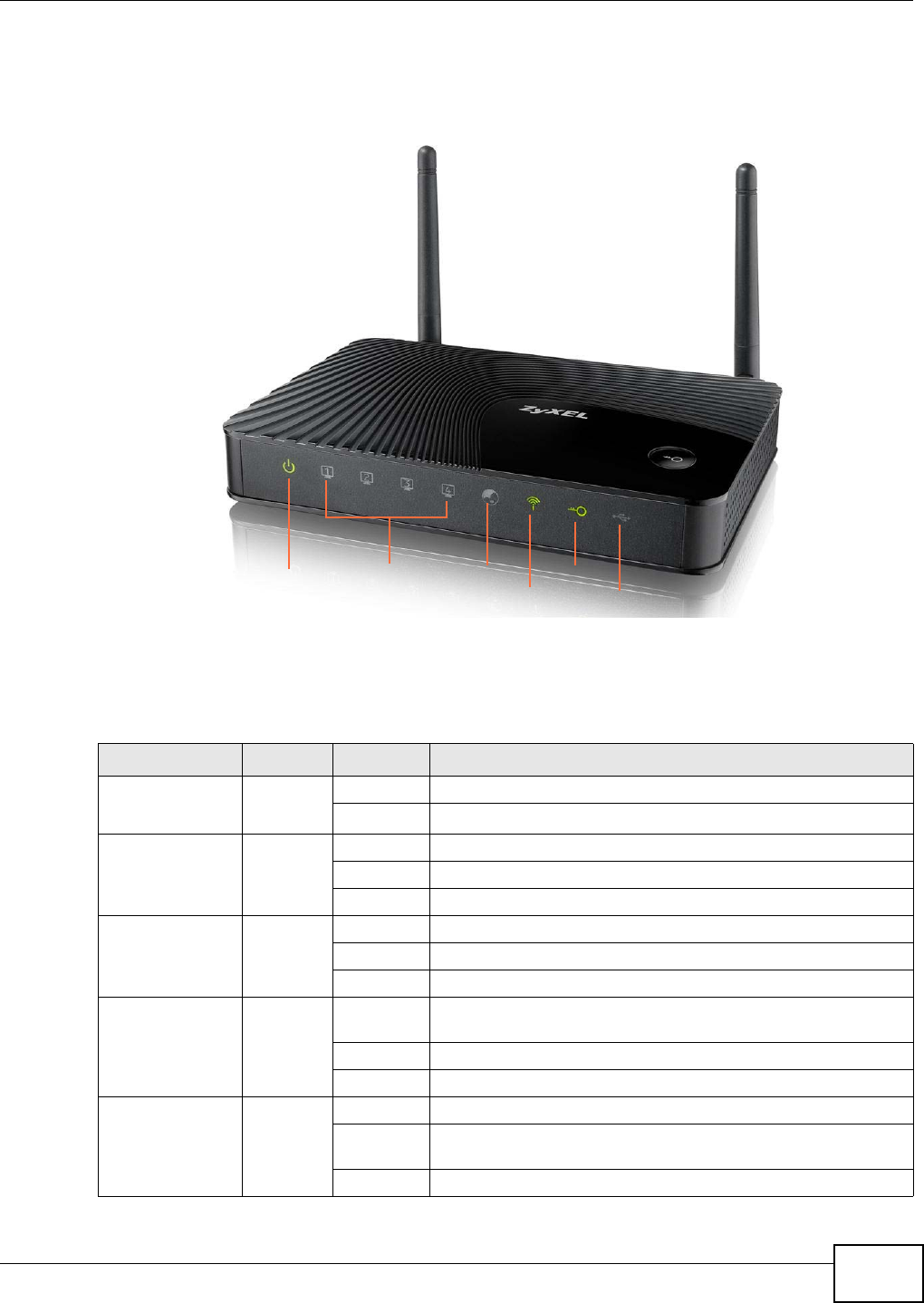
Chapter 1 Getting to Know Your Router
NBG-419N v2 User’s Guide 17
1.5 LEDs
Figure 1 Front Panel
The following table describes the LEDs and the WPS button.
Table 1 Front Panel LEDs and WPS Button
LED COLOR STATUS DESCRIPTION
POWER Green On The Router is receiving power and functioning properly.
Off The Router is not receiving power.
LAN 1-4 Green On The Router has a successful 10/100MB Ethernet connection.
Blinking The Router is sending/receiving data through the LAN.
Off The LAN is not connected.
WAN Green On The Router has a successful 10/100MB WAN connection.
Blinking The Router is sending/receiving data through the WAN.
Off The WAN connection is not ready, or has failed.
WLAN Green On The Router is ready, but is not sending/receiving data through
the wireless LAN.
Blinking The Router is sending/receiving data through the wireless LAN.
Off The wireless LAN is not ready or has failed.
WPS Green On WPS is enabled.
Blinking The Router is negotiating a WPS connection with a wireless
client.
Off The wireless LAN is not ready or has failed.
Power LAN 1-4 WAN
WLAN USB
WPS
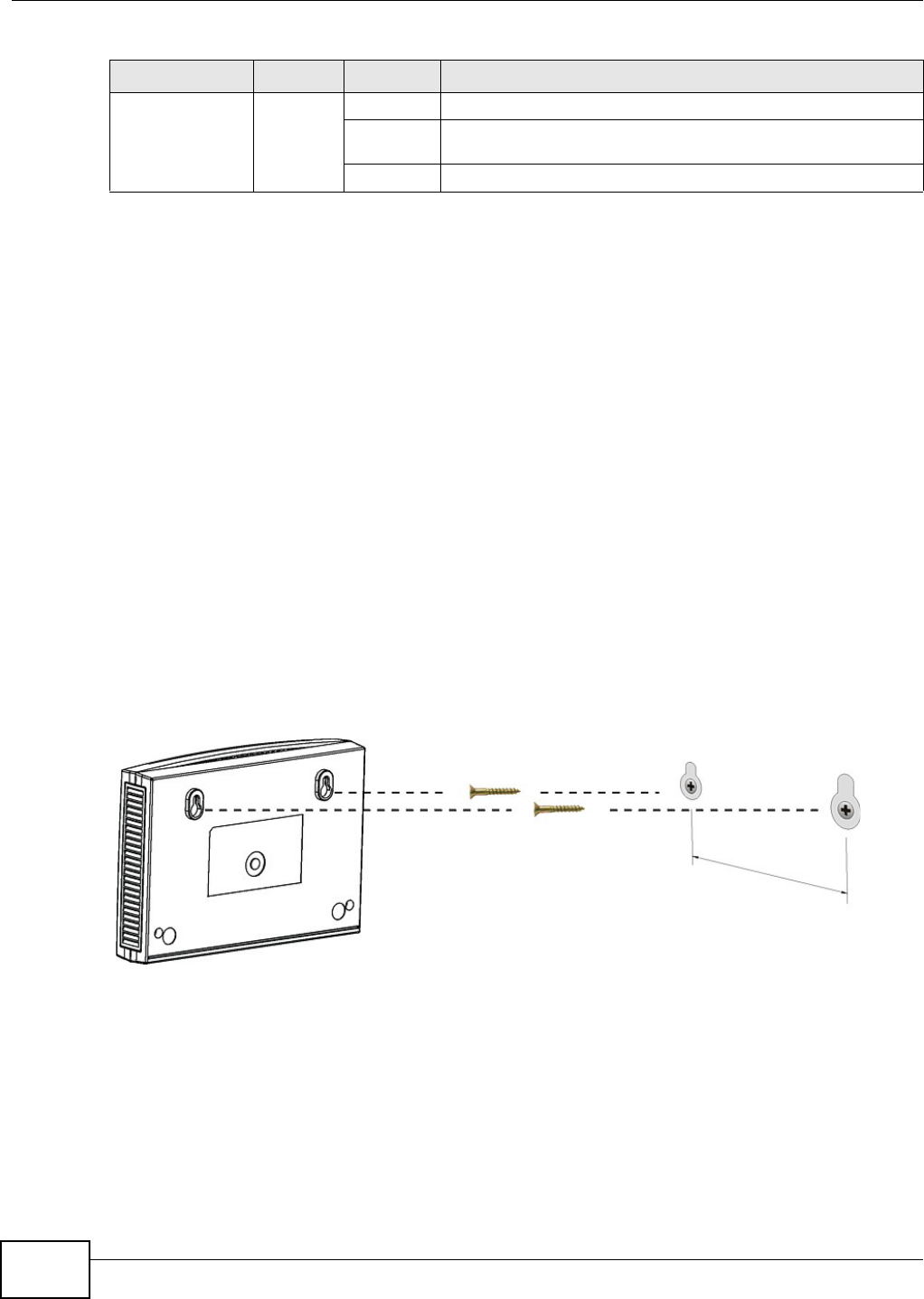
Chapter 1 Getting to Know Your Router
NBG-419N v2 User’s Guide
18
1.6 Wall-mounting Instructions
Complete the following steps to hang your Router on a wall.
1Select a position free of obstructions on a sturdy wall.
2Drill two holes for the screws.
Be careful to avoid damaging pipes or cables located inside the wall
when drilling holes for the screws.
3Do not insert the screws all the way into the wall. Leave a small gap of about 0.5 cm between the
heads of the screws and the wall.
4Make sure the screws are snugly fastened to the wall. They need to hold the weight of the Router
with the connection cables.
5Align the holes on the back of the Router with the screws on the wall. Hang the Router on the
screws.
Figure 2 Wall-mounting Example
USB Green On The Router has a USB device installed.
Blinking The Router is transmitting and/or receiving data from routers
through an installed USB device.
Off There is no USB device connected to the Router.
Table 1 Front Panel LEDs and WPS Button (continued)
LED COLOR STATUS DESCRIPTION
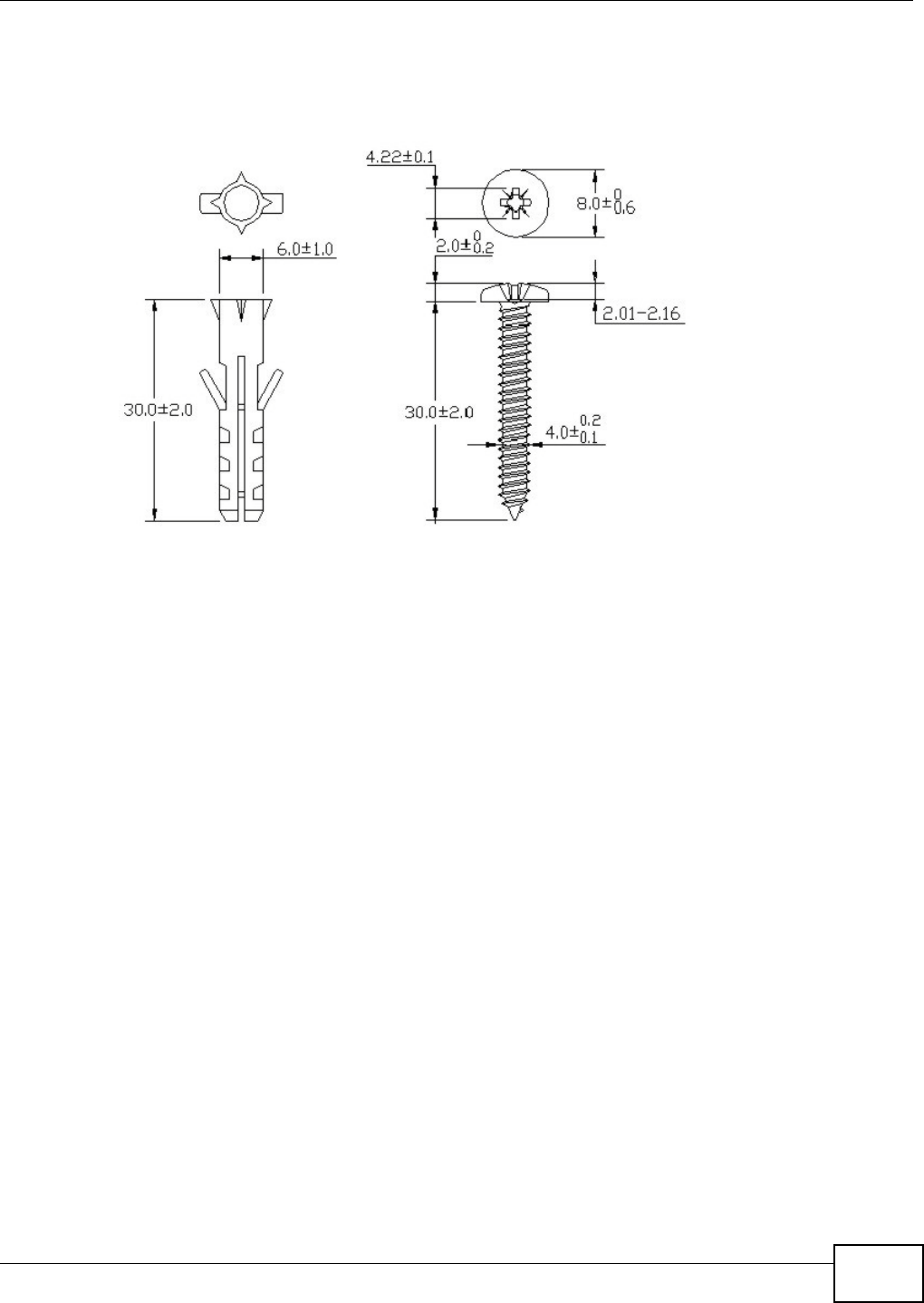
Chapter 1 Getting to Know Your Router
NBG-419N v2 User’s Guide 19
The following are dimensions of an M4 tap screw and masonry plug used for wall mounting. All
measurements are in millimeters (mm).
Figure 3 Masonry Plug and M4 Tap Screw

NBG-419N v2 User’s Guide 20
CHAPTER 2
The WPS Button
2.1 Overview
Your Router supports WiFi Protected Setup (WPS), which is an easy way to set up a secure wireless
network. WPS is an industry standard specification, defined by the WiFi Alliance.
WPS allows you to quickly set up a wireless network with strong security, without having to
configure security settings manually. Each WPS connection works between two devices. Both
devices must support WPS (check each device’s documentation to make sure).
Depending on the devices you have, you can either press a button (on the device itself, or in its
configuration utility) or enter a PIN (a unique Personal Identification Number that allows one device
to authenticate the other) in each of the two devices. When WPS is activated on a device, it has two
minutes to find another device that also has WPS activated. Then, the two devices connect and set
up a secure network by themselves.
For more information on using WPS, see Section 12.3 on page 89.

NBG-419N v2 User’s Guide 21
CHAPTER 3
ZyXEL NetUSB Share Center Utility
3.1 Overview
The ZyXEL NetUSB Share Center Utility allows you to work with the USB devices that are connected
directly to the Router as if they are connected directly to your computer. This allows you to easily
share USB-based devices such as printers, scanners, portable hard disks, MP3 players, faxes, and
digital cameras (to name a few) with all the other people in your home or office as long as they are
connected to the Router and have the ZyXEL NetUSB Share Center Utility installed.
Note: Be sure to install the ZyXEL NetUSB Share Center Utility (for NetUSB functionality)
from the included disc, or download the latest version from the zyxel.com website.
3.1.1 Quick Setup
This section shows you how to get started using the ZyXEL NetUSB Share Center Utility.
1Install the ZyXEL NetUSB Share Center Utility on each computer connected to the Router.
2Connect a USB device to the USB port on the Router.
Note: If you are connecting multiple devices to the Router, first connect a USB hub to the
Router then connect your other USB devices to it.
3Run the ZyXEL NetUSB Share Center Utility to display a list of all connected USB devices, then use
it to connect your computer to them.
3.1.2 Installing ZyXEL NetUSB Share Center Utility
Before you can access USB devices connected to the Router, you must first install the ZyXEL
NetUSB Share Center Utility on any computer on your LAN to which you want to allow access to
these devices.
Note: In order to properly use the utility with your Router, ensure that the Router
firmware is version v1.00(BWQ.0) or higher. See Chapter 26 on page 184 for
information on updating your device’s firmware.
To install the ZyXEL NetUSB Share Center Utility:
1Insert the disc that came with your Router into your computer’s disc drive.
2Run the Setup program by double-clicking it and then follow the on-screen instructions for
installing it on your computer.
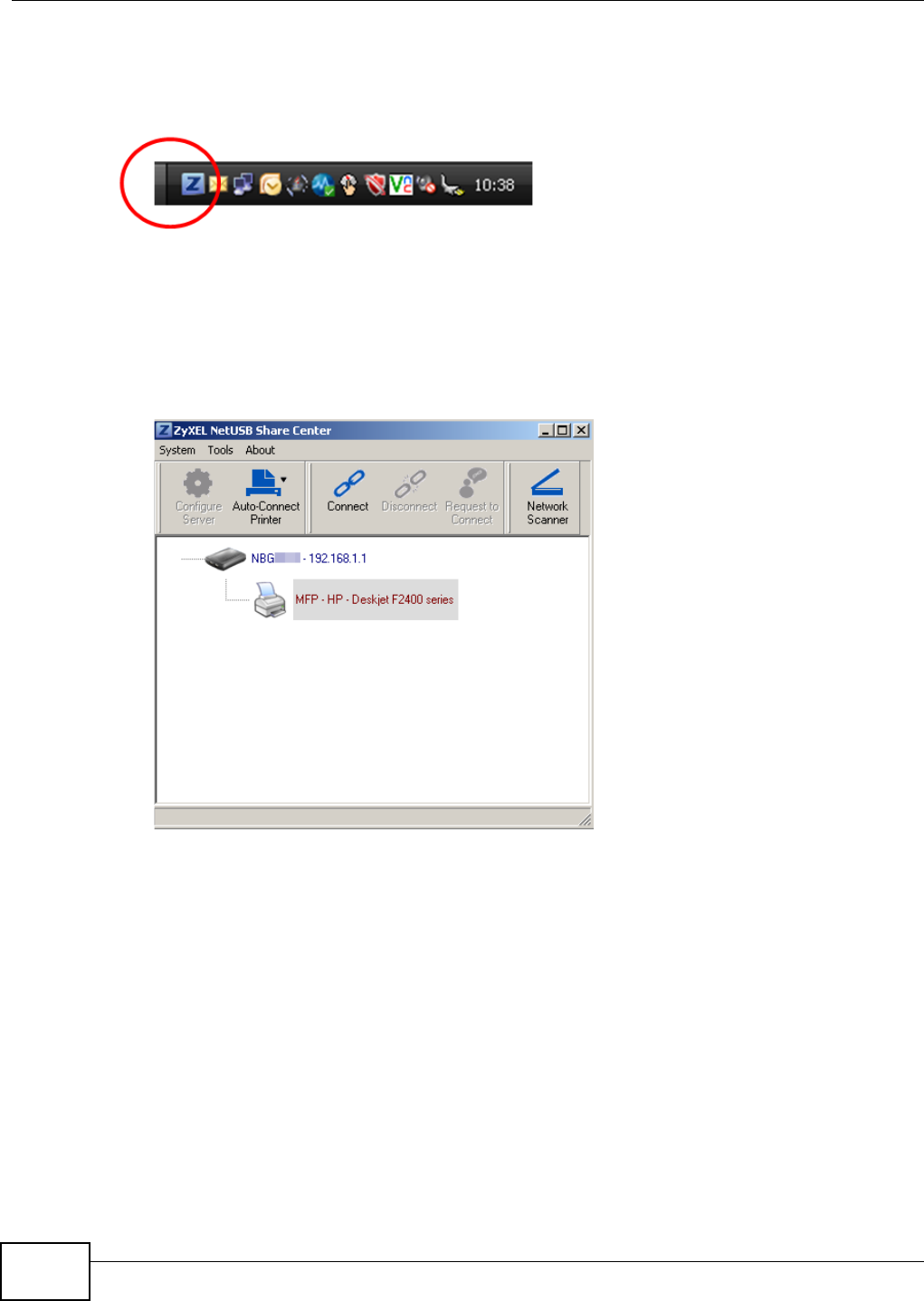
Chapter 3 ZyXEL NetUSB Share Center Utility
NBG-419N v2 User’s Guide
22
Note: The following operating systems are supported: Windows XP/Vista/7 (32 and 64-bit
versions), and Mac OS X 10.6.
3To open the ZyXEL NetUSB Share Center Utility, double-click its system tray icon.
3.2 The ZyXEL NetUSB Share Center Utility
This section describes the ZyXEL NetUSB Share Center Utility main window.
Figure 4 ZyXEL NetUSB Share Center Utility Main Window
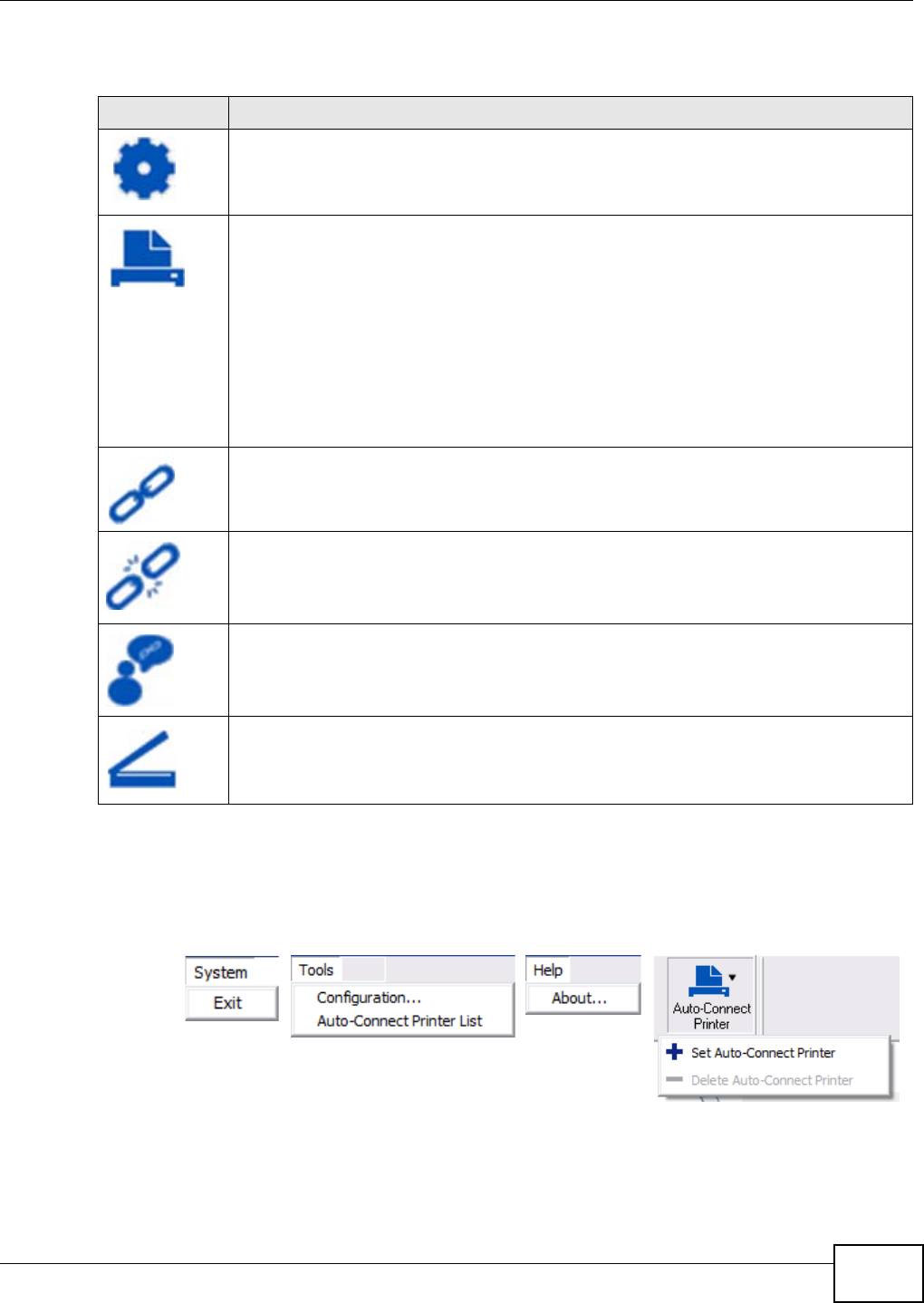
Chapter 3 ZyXEL NetUSB Share Center Utility
NBG-419N v2 User’s Guide 23
The following table describes the icons in this window.
3.2.1 The Menus
This section describes the utility’s menus.
Figure 5 ZyXEL NetUSB Share Center Utility Menus
Table 2 ZyXEL NetUSB Share Center Utility Main Window Icons
ICON DESCRIPTION
Configure Server
Click to open the Router’s built-in Web Configurator, which you can use to set up the Router
(see Chapter 5 on page 39 for details).
Auto-Connect Printer
You can set the selected printer to ‘auto-connect’ after you have connected it to your
computer during inital connection. If the printer is auto-connected to your computer, they
will always be connected over the network. You do not need to configure it manually each
time.
Note: If the computer is connecting to the shared USB printer for the first time, you need to
click Connect and setup the printer before you can use the Auto-Connect Printer
function. See Chapter 12 on page 89 for more details.
Note: You first must install the appropriate drivers for the printer that you intend to use.
Connect
Select a USB device and then click this button to connect to it. Your computer can connect
to as many USB devices as are connected to the Router.
Disconnect
Select a device to which your computer is connected and then click this button to disconnect
from it.
Request to Connect
Some USB devices may not allow automatic connections over the network. If so, select the
device in question and click this button to issue a request to connect to it.
Network Scanner
Click this to open the scanner options on your computer for working with a scanner
connected to the network.

Chapter 3 ZyXEL NetUSB Share Center Utility
NBG-419N v2 User’s Guide
24
The following table describes the menus in this screen.
Table 3 ZyXEL NetUSB Share Center Utility Main Screen Menus
MENU ITEM DESCRIPTION
System Exit This closes the ZyXEL NetUSB Share Center Utility.
Tools Configuration This opens the ZyXEL NetUSB Share Center Utility
configuration window.
Auto-Connect Printer List This opens the list window that displays all of the
printing devices connected to the Router.
Help About This opens the about window, which provides
information of the utility software and driver versions.
Auto-Connect
Printer
Set Auto-Connect Printer You can set the selected printer to ‘auto-connect’
after you have connected it to your computer during
inital connection. If the printer is auto-connected to
your computer, they will always be connected over
the network. You do not need to configure it manually
each time.
Click this to show your installed printer list and select
the one you want to set as auto-connected.
Note: If the computer is connecting to the shared USB
printer for the first time, you need to click
Connect and setup the printer before you can
use the Auto-Connect Printer function. See
Chapter 12 on page 89 for more details.
Note: You first must install the appropriate drivers for
the printer that you intend to use.
Delete Auto-Connect Printer This removes the auto-connect option from the
selected printer.
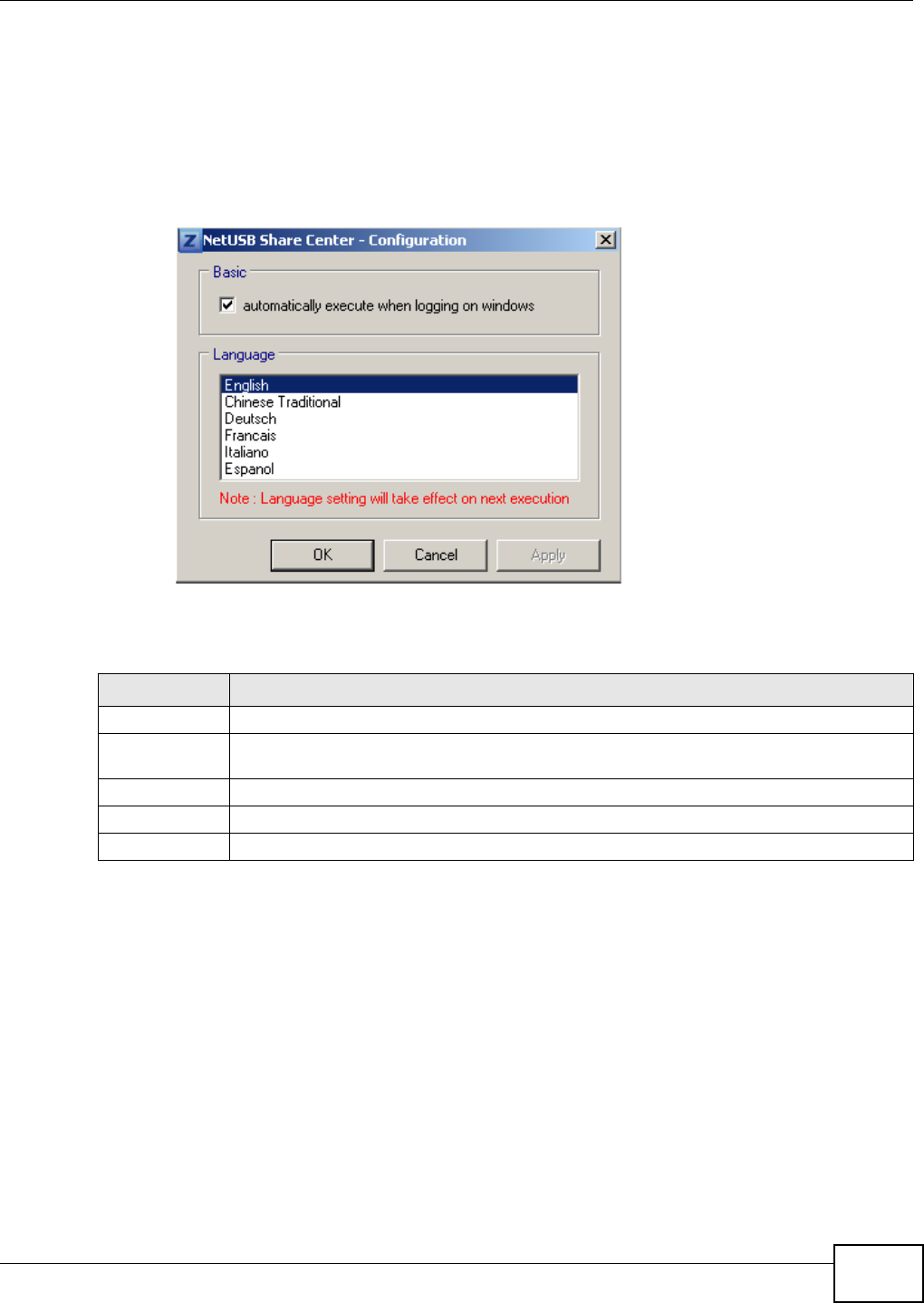
Chapter 3 ZyXEL NetUSB Share Center Utility
NBG-419N v2 User’s Guide 25
3.2.2 The ZyXEL NetUSB Share Center Configuration Window
This section describes the utility’s configuration window, which allows you to set certain options for
the utility. These options do not apply to the USB devices connected to the Router.
You can open it by clicking the Tools > Configuration menu command.
Figure 6 ZyXEL NetUSB Share Center Utility Configuration Window
The following table describes the labels in this window.
3.2.3 The Auto-Connect Printer List Window
This section describes the utility’s auto-connect printer list window. You can open it by clicking the
Tools > Auto-Connect Printer List menu command.
Note: If the computer is connecting to the shared USB printer for the first time, you need
to click Connect and setup the printer before you can use the Auto-Connect
Printer function. See Chapter 12 on page 89 for more details.
Table 4 ZyXEL NetUSB Share Center Utility Configuration Window
LABEL DESCRIPTION
Basic Select this to run the utility automatically when you log into or start up Windows.
Language Select a language for the ZyXEL NetUSB Share Center Utility. You must restart the utility for
the change to take effect.
OK Click this to save your changes and close the window.
Cancel Click this cancel to close the window without saving.
Apply Click this to save your changes without closing the window.
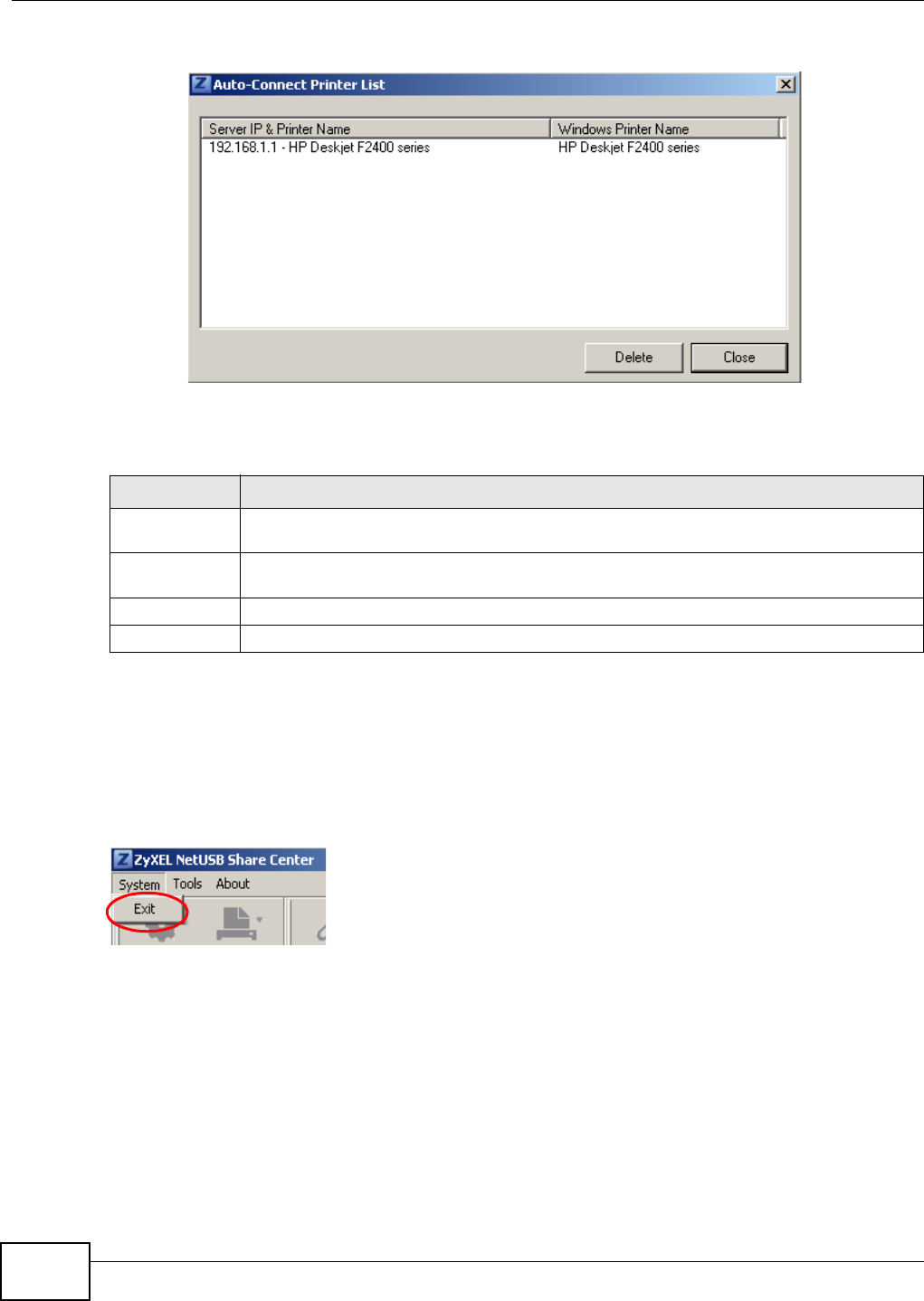
Chapter 3 ZyXEL NetUSB Share Center Utility
NBG-419N v2 User’s Guide
26
Figure 7 ZyXEL NetUSB Share Center Utility Auto-Connect Printer List Window
The following table describes the labels in this screen.
3.2.4 Exit the ZyXEL NetUSB Share Center Utility
If you want to exit the ZyXEL NetUSB Share Center Utility when your computer is not connected to
any USB device, follow the steps below:
1Click System > Exit on the Utility screen. The Utility will automatically close.
Or you can close the Utlity screen first, then exit:
Table 5 ZyXEL NetUSB Share Center Utility Auto-Connect Printer List Window
LABEL DESCRIPTION
Server IP &
Printer Name
Displays a list of print server IPs and printer names connected to this Router.
Windows
Printer Name
Displays a corresponding list of Windows printer names connected to this devices listed in
the other list.
Delete Select an printer from the list and click this to remove it.
Close Click this to close the window.
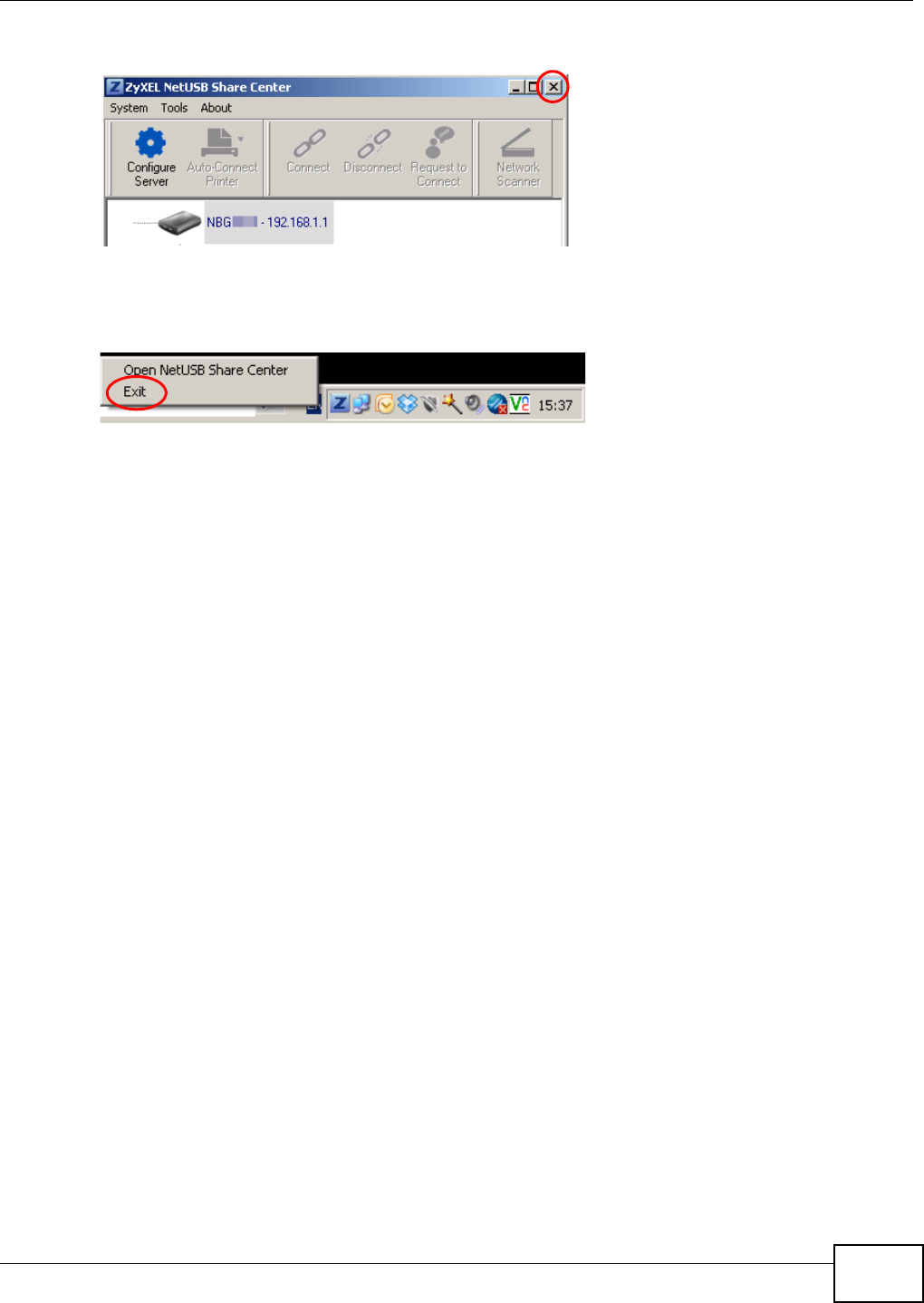
Chapter 3 ZyXEL NetUSB Share Center Utility
NBG-419N v2 User’s Guide 27
1Click the X on the upper-right corner of the Utility:
2This will close the Utility screen to an icon at the system tray of your computer. Right-click on the
Utility’s icon and click Exit.

Chapter 3 ZyXEL NetUSB Share Center Utility
NBG-419N v2 User’s Guide
28
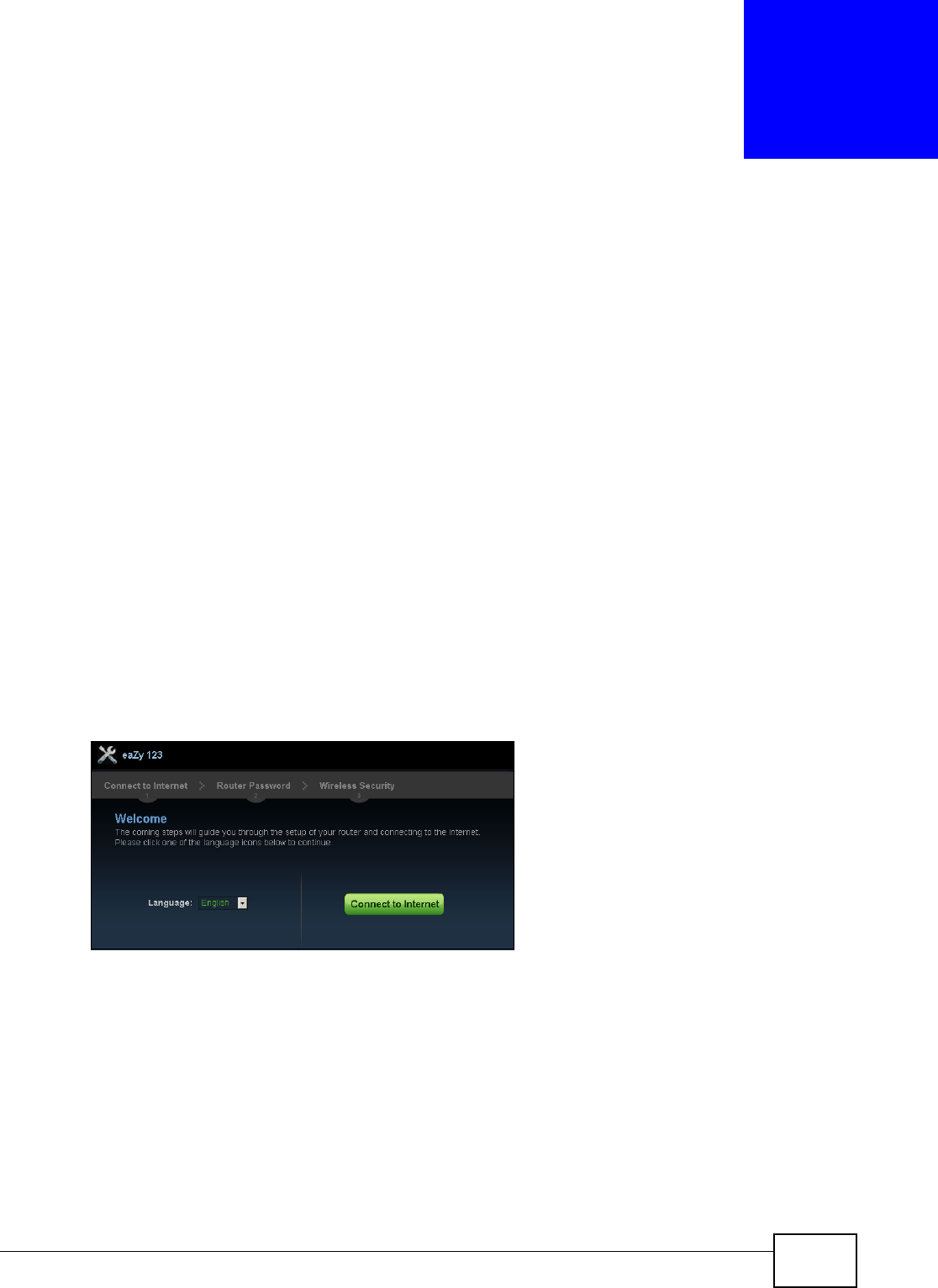
NBG-419N v2 User’s Guide 29
CHAPTER 4
Connection Wizard
4.1 Overview
This chapter provides information on the wizard setup screens in the Web Configurator.
The Web Configurator’s wizard setup helps you configure your device to access the Internet. Refer
to your ISP for your Internet account information. Leave a field blank if you don’t have that
information.
4.2 Accessing the Wizard
Launch your web browser and type "http://192.168.1.1" as the website address. Type "1234"
(default) as the password and click Login.
Note: The Wizard appears when the Router is accessed for the first time or when you
reset the Router to its default factory settings.
The Wizard screen opens. Choose your Language and click Connect to Internet.
Figure 8 Welcome
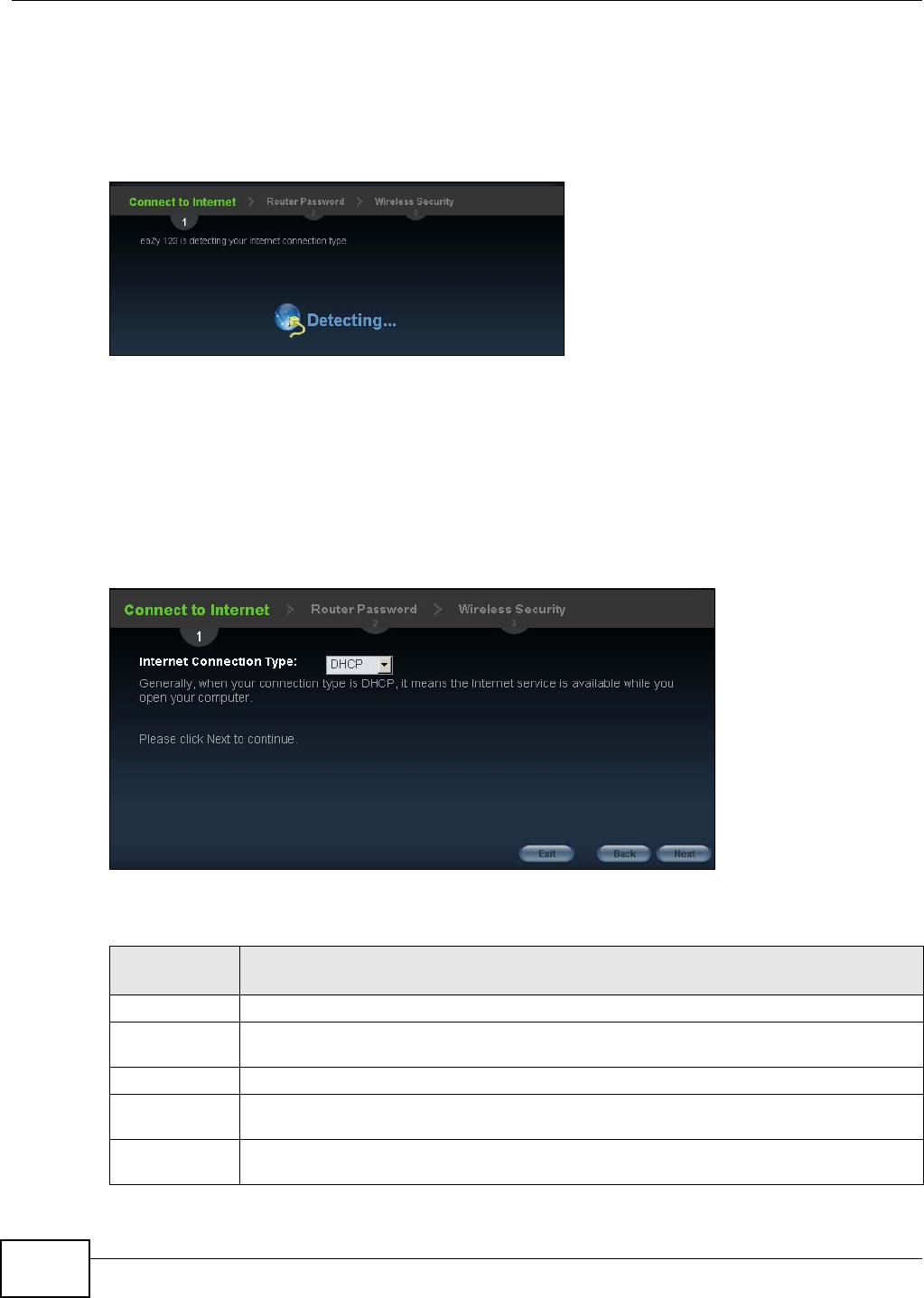
Chapter 4 Connection Wizard
NBG-419N v2 User’s Guide
30
4.3 Connect to Internet
The Router offers five Internet connection types. They are Static IP, DHCP, PPPoE, PPTP or
L2TP. The wizard attempts to detect which WAN connection type you are using.
Figure 9 Detecting your Internet Connection Type
If the wizard does not detect a connection type, you must select one from the drop-down list box.
Check with your ISP to make sure you use the correct type.
Note: If you get an error message, check your hardware connections. Make sure your
Internet connection is up and running.
The following screen depends on your Internet connection type. Enter the details provided by your
Internet Service Provider (ISP) in the fields (if any).
Figure 10 Internet Connection Type
Your Router detects the following Internet Connection type.
Table 6 Internet Connection Type
CONNECTION
TYPE DESCRIPTION
Static IP Select the Static IP if an administrator assigns the IP address of your computer.
DHCP Select the DHCP (Dynamic Host Configuration Protocol) option when the WAN port is used
as a regular Ethernet.
PPPoE Select the PPPoE (Point-to-Point Protocol over Ethernet) option for a dial-up connection.
PPTP Select the PPTP (Point-to-Point Tunneling Protocol) option for a dial-up connection, and
your ISP gave you an IP address and/or subnet mask.
L2TP Select the L2TP (Layer 2 Tunnel Protocol) if you are connecting to another device over
another network (like the Internet or VPN).
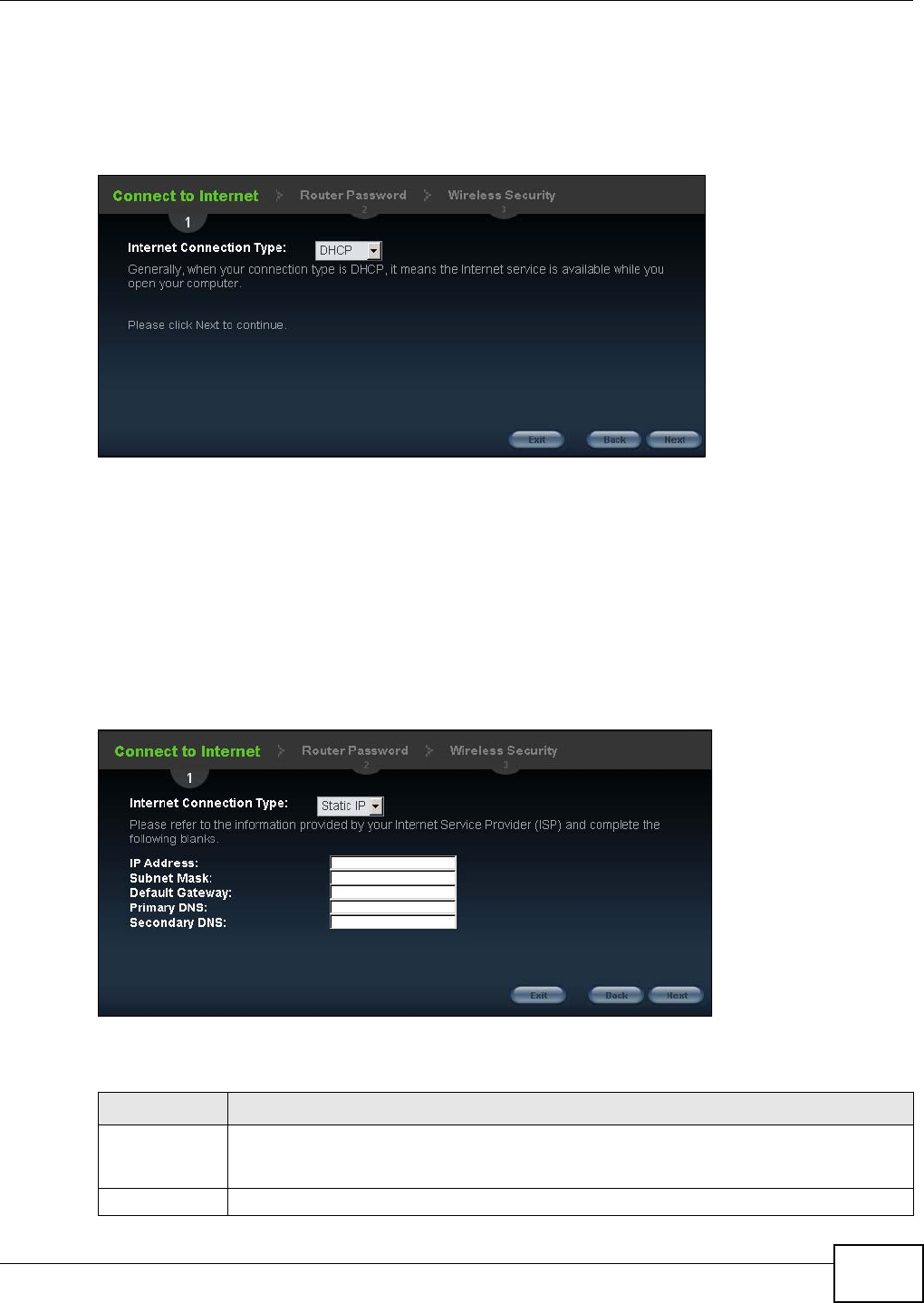
Chapter 4 Connection Wizard
NBG-419N v2 User’s Guide 31
4.3.1 Connection Type: DHCP
Choose DHCP as the Internet Connection Type when the WAN port is used as a regular
Ethernet. Click Next.
Figure 11 Internet Connection Type: DHCP
Note: If you get an error screen after clicking Next, you might have selected the wrong
Internet Connection type. Click Back, make sure your Internet connection is
working and select the right Connection Type. Contact your ISP if you are not sure
of your Internet Connection type.
4.3.2 Connection Type: Static IP
Choose Static IP as the Internet Connection Type if your ISP assigned an IP address for your
Internet connection. Click Next.
Figure 12 Internet Connection Type: Static IP
The following table describes the labels in this screen.
Table 7 Internet Connection Type: Static IP
LABEL DESCRIPTION
Internet
Connection
Type
Select the Static IP option.
IP Address Enter the IP address provided by your ISP.
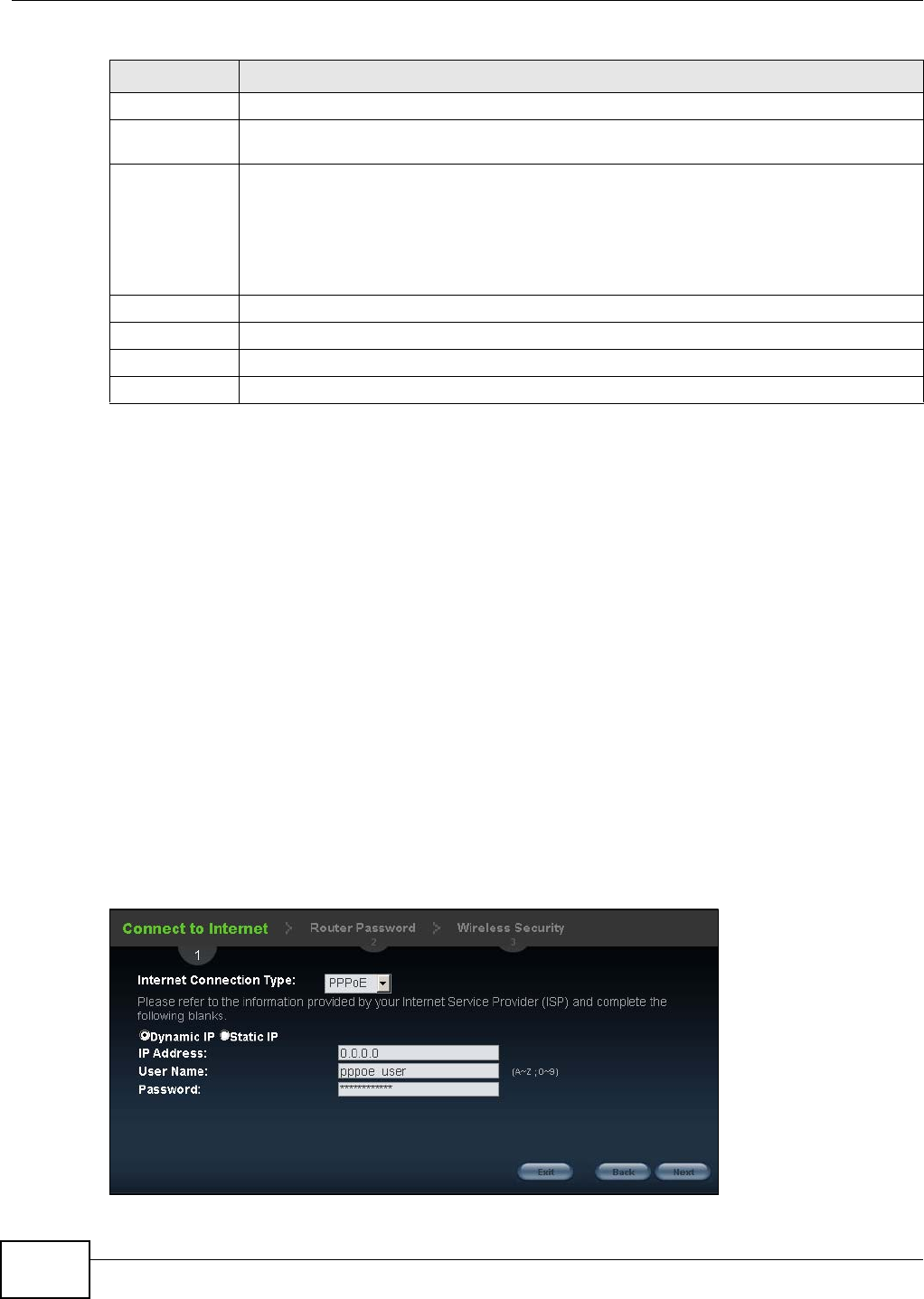
Chapter 4 Connection Wizard
NBG-419N v2 User’s Guide
32
4.3.3 Connection Type: PPPoE
Point-to-Point Protocol over Ethernet (PPPoE) functions as a dial-up connection. PPPoE is an IETF
(Internet Engineering Task Force) standard specifying how a host personal computer interacts with
a broadband modem (for example DSL, cable, wireless, etc.) to achieve access to high-speed data
networks.
For the service provider, PPPoE offers an access and authentication method that works with existing
access control systems (for instance, RADIUS).
One of the benefits of PPPoE is the ability to let end users access one of multiple network services,
a function known as dynamic service selection. This enables the service provider to easily create
and offer new IP services for specific users.
Operationally, PPPoE saves significant effort for both the subscriber and the ISP/carrier, as it
requires no specific configuration of the broadband modem at the subscriber's site.
By implementing PPPoE directly on the Router (rather than individual computers), the computers on
the LAN do not need PPPoE software installed, since the Router does that part of the task.
Furthermore, with NAT, all of the LAN's computers will have Internet access.
Figure 13 Internet Connection Type: PPPoE
Subnet Mask Enter the IP subnet mask in this field.
Default
Gateway
Enter the gateway IP address in this field.
Primary DNS DNS (Domain Name System) is for mapping a domain name to its corresponding IP address
and vice versa. The DNS server is extremely important because without it, you must know
the IP address of a computer before you can access it. The Router uses a system DNS
server (in the order you specify here) to resolve domain names for DDNS and the time
server.
Enter the primary DNS server's IP address in the fields provided.
Secondary DNS Enter the secondary DNS server's IP address in the fields provided.
Exit Click this to close the wizard screen without saving.
Back Click this to return to the previous screen.
Next Click this to continue.
Table 7 Internet Connection Type: Static IP (continued)
LABEL DESCRIPTION
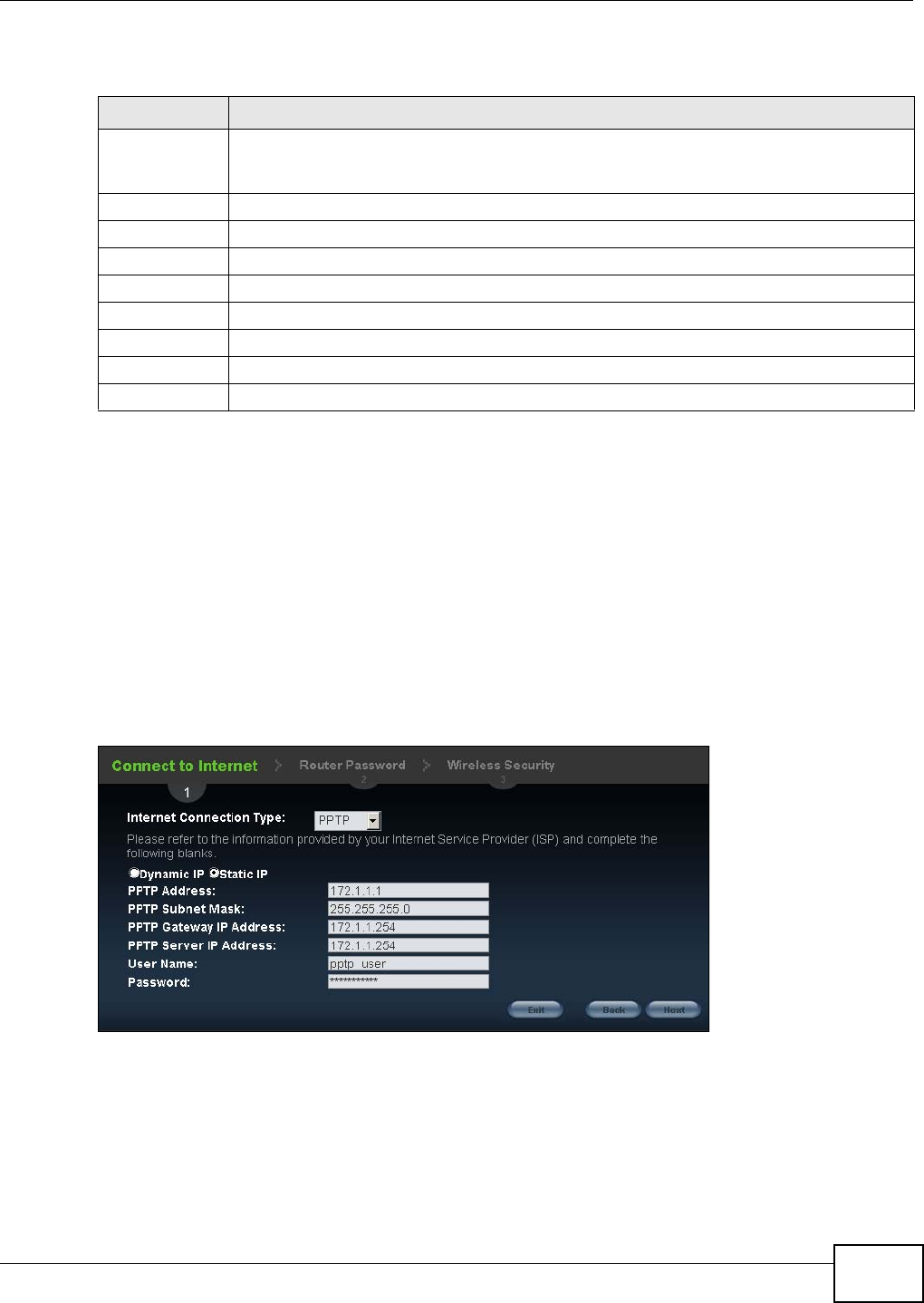
Chapter 4 Connection Wizard
NBG-419N v2 User’s Guide 33
The following table describes the labels in this screen.
4.3.4 Connection Type: PPTP
Point-to-Point Tunneling Protocol (PPTP) is a network protocol that enables transfers of data from a
remote client to a private server, creating a Virtual Private Network (VPN) using TCP/IP-based
networks.
PPTP supports on-demand, multi-protocol, and virtual private networking over public networks,
such as the Internet.
Refer to the appendix for more information on PPTP.
The Router supports one PPTP server connection at any given time.
Figure 14 Internet Connection Type: PPTP
Table 8 Internet Connection Type: PPPoE
LABEL DESCRIPTION
Internet
Connection
Type
Select the PPPoE option for a dial-up connection.
Dynamic IP Select this radio button if your ISP did not assign you a fixed IP address.
Static IP Select this radio button, provided by your ISP to give the Router a fixed, unique IP address.
IP Address Type the name of your service provider.
User Name Type the user name given to you by your ISP.
Password Type the password associated with the user name above.
Exit Click this to close the wizard screen without saving.
Back Click this to return to the previous screen.
Next Click this to continue.
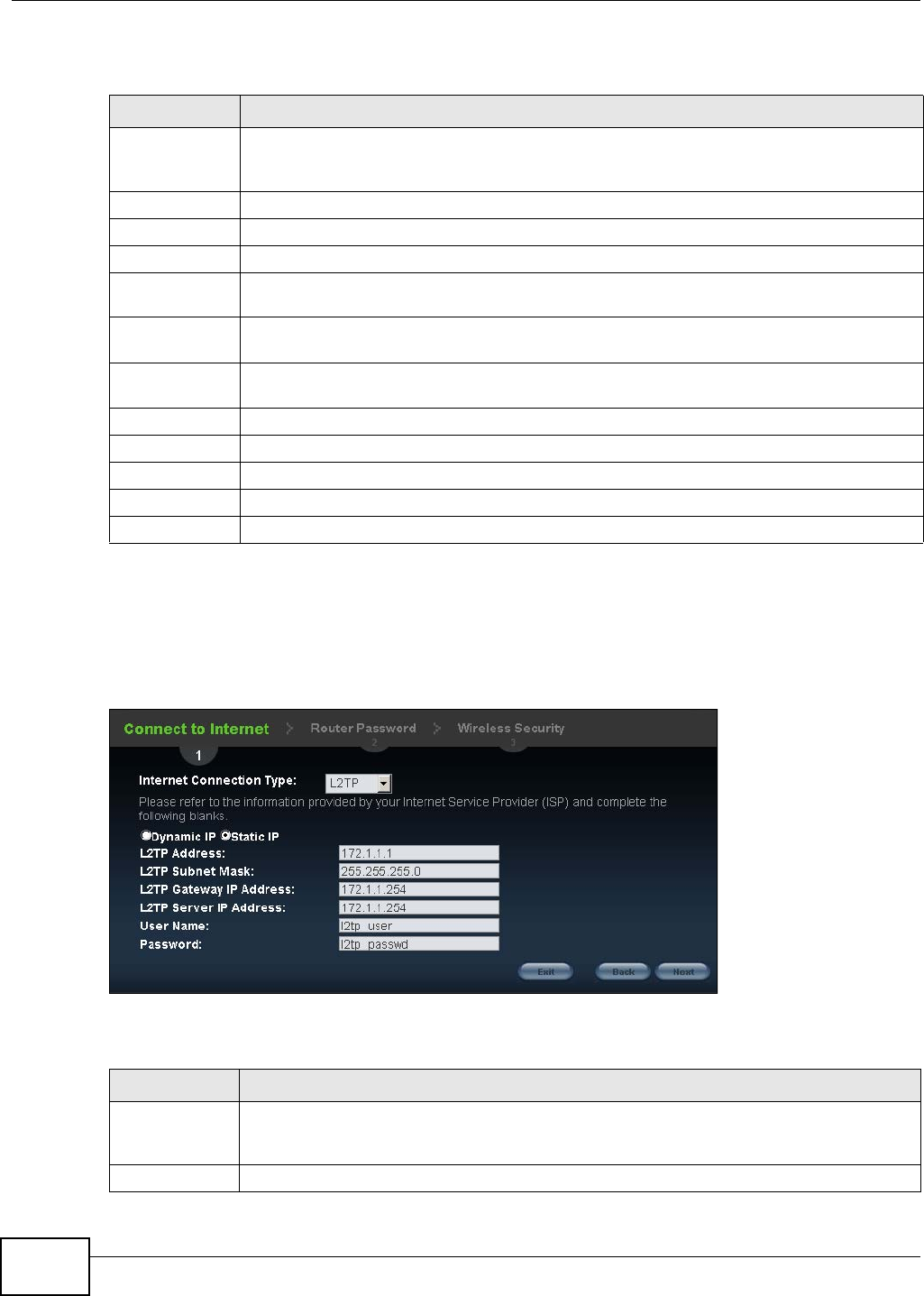
Chapter 4 Connection Wizard
NBG-419N v2 User’s Guide
34
The following table describes the fields in this screen
4.3.5 Connection Type: L2TP
The Layer 2 Tunneling Protocol (L2TP) works at layer 2 (the data link layer) to tunnel network traffic
between two peer devices over another network (like the Internet).
Figure 15 Internet Connection Type: L2TP
The following table describes the fields in this screen
Table 9 Internet Connection Type: PPTP
LABEL DESCRIPTION
Internet
Connection
Type
Select PPTP from the drop-down list box. To configure a PPTP client, you must configure the
User Name and Password fields for a PPP connection and the PPTP parameters for a PPTP
connection.
Dynamic IP Select this radio button if your ISP did not assign you a fixed IP address.
Static IP Select this radio button, provided by your ISP to give the Router a fixed, unique IP address.
PPTP Address Type the (static) IP address assigned to you by your ISP.
PPTP Subnet
Mask
Type the subnet mask assigned to you by your ISP (if given).
PPTP Gateway
IP Address
Type the gateway IP address of the PPTP server.
PPTP Server IP
Address
Type the server IP address of the PPTP server.
User Name Type the user name given to you by your ISP.
Password Type the password associated with the User Name above.
Exit Click this to close the wizard screen without saving.
Back Click this to return to the previous screen.
Next Click this to continue.
Table 10 Internet Connection Type: L2TP
LABEL DESCRIPTION
Internet
Connection
Type
Select L2TP from the drop-down list box.
Dynamic IP Select this radio button if your ISP did not assign you a fixed IP address.
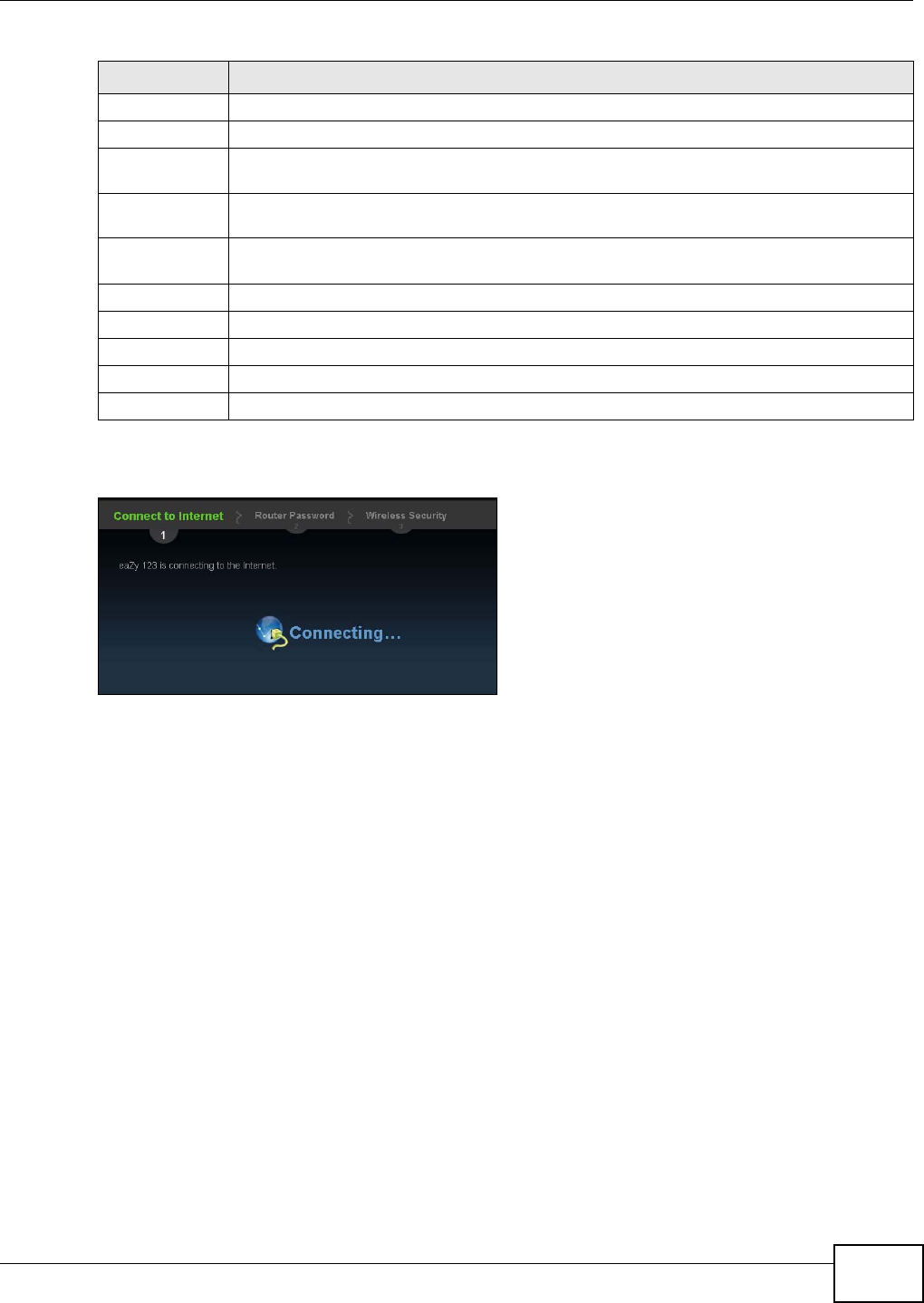
Chapter 4 Connection Wizard
NBG-419N v2 User’s Guide 35
The Router connects to the Internet.
Figure 16 Connecting to the Internet
Note: If the Wizard successfully connects to the Internet, it proceeds to the next step. If
you get an error message, go back to the previous screen and make sure you have
entered the correct information provided by your ISP.
Static IP Select this radio button, provided by your ISP to give the Router a fixed, unique IP address.
L2TP Address Type the (static) IP address assigned to you by your ISP.
L2TP Subnet
Mask
Type the subnet mask assigned to you by your ISP (if given).
L2TP Gateway
IP Address
Type the gateway IP address of the L2TP server.
L2TP Server IP
Address
Type the server IP address of the L2TP server.
User Name Type the user name given to you by your ISP.
Password Type the password associated with the User Name above.
Exit Click this to close the wizard screen without saving.
Back Click this to return to the previous screen.
Next Click this to continue.
Table 10 Internet Connection Type: L2TP (continued)
LABEL DESCRIPTION
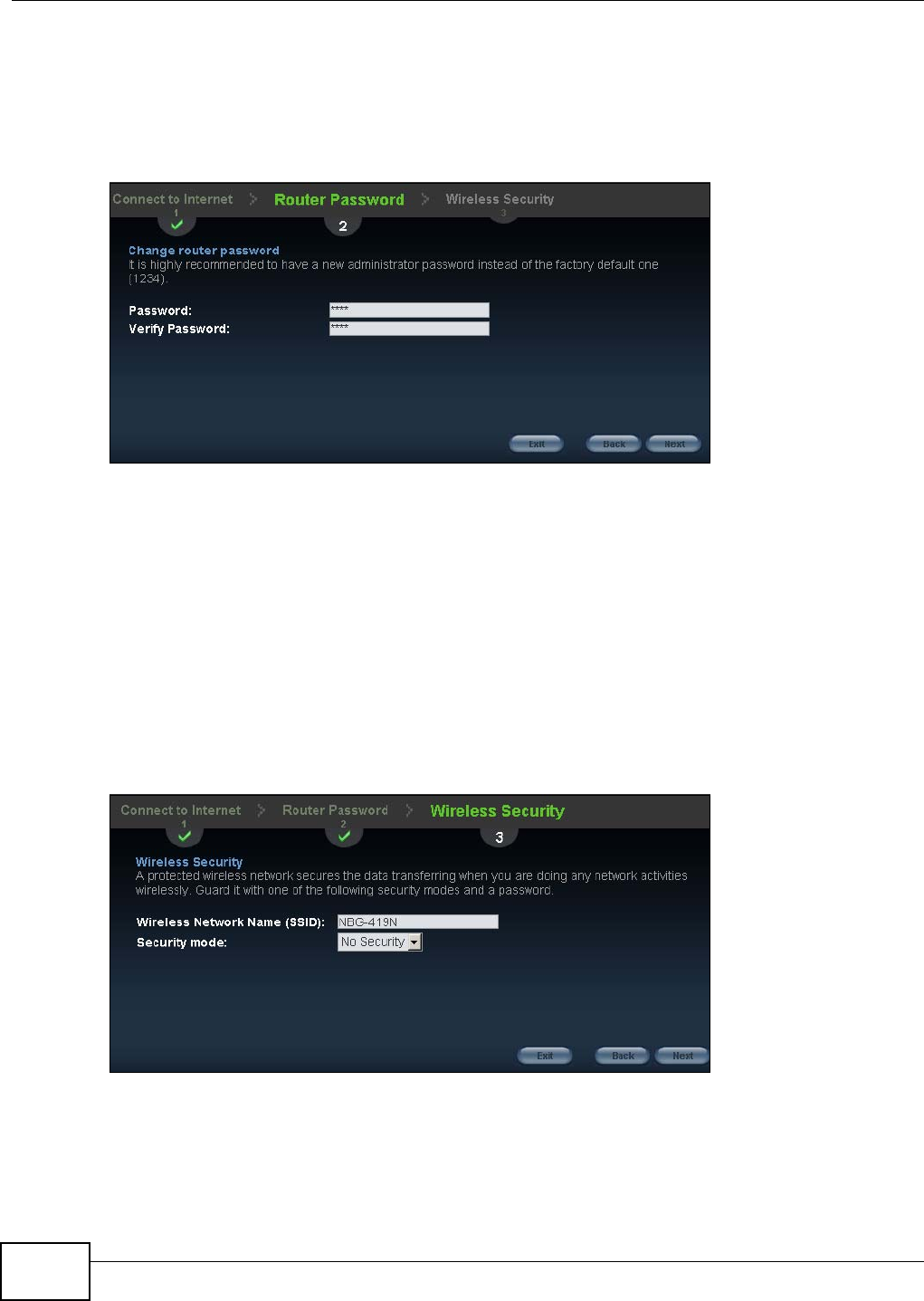
Chapter 4 Connection Wizard
NBG-419N v2 User’s Guide
36
4.4 Router Password
Change the login password in the following screen. Enter the new password and retype it to
confirm. Click Next to proceed with the Wireless Security screen.
Figure 17 Router Password
4.5 Wireless Security
Configure Wireless Settings. Configure the wireless network settings on your Router in the following
screen. The fields that show up depend on the kind of security you select.
4.5.1 Wireless Security: No Security
Choose No Security in the Wireless Security screen to let wireless devices within range access
your wireless network.
Figure 18 Wireless Security: No Security
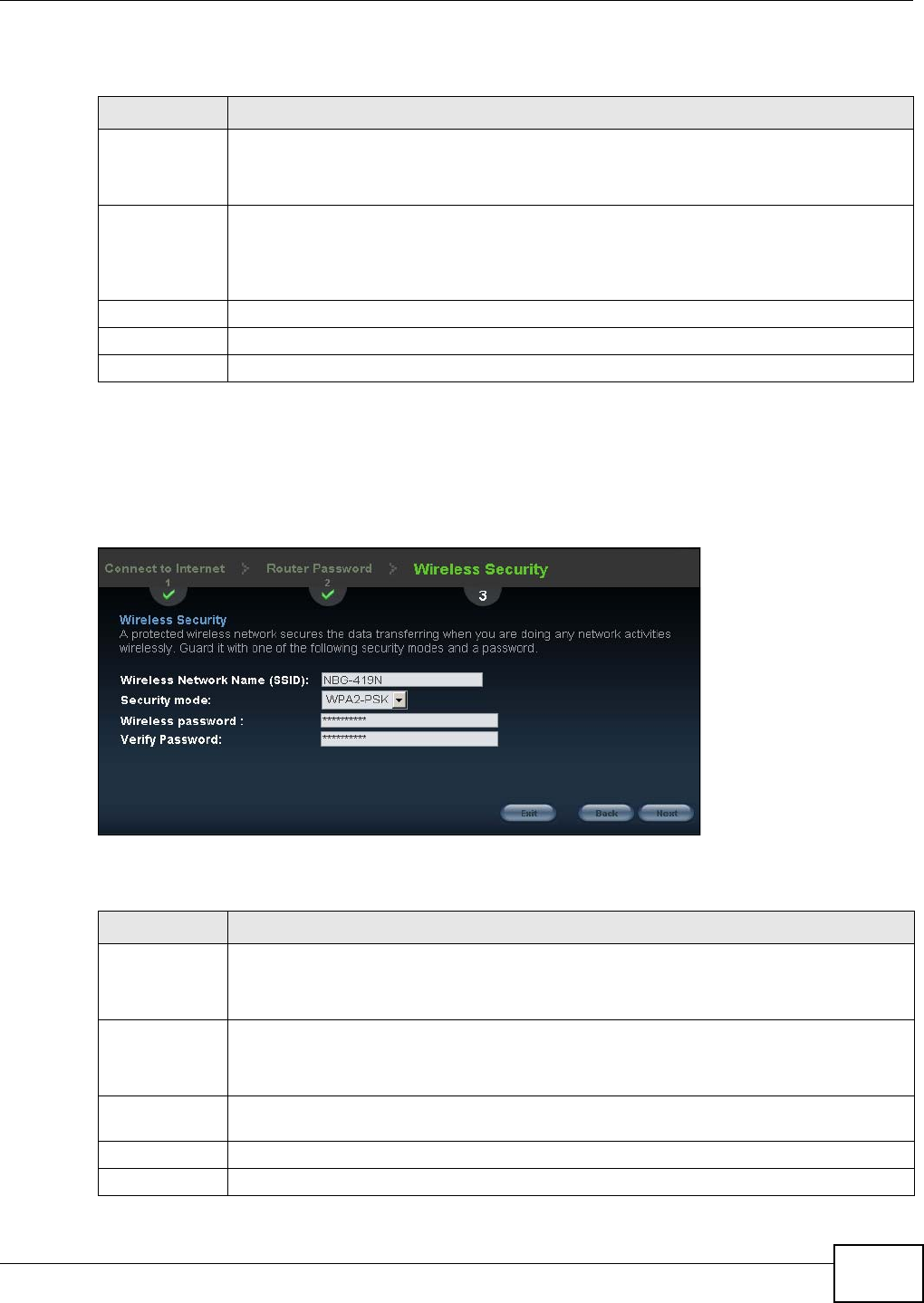
Chapter 4 Connection Wizard
NBG-419N v2 User’s Guide 37
The following table describes the labels in this screen.
4.5.2 Wireless Security: WPA-PSK/WPA2-PSK
Choose WPA-PSK or WPA2-PSK security in the Wireless Security screen to set up a password for
your wireless network.
Figure 19 Wireless Security: WPA-PSK/WPA2-PSK
The following table describes the labels in this screen.
Table 11 Wireless Security: No Security
LABEL DESCRIPTION
Wireless
Network Name
(SSID)
Enter a descriptive name (up to 32 printable 7-bit ASCII characters) for the wireless LAN.
If you change this field on the Router, make sure all wireless stations use the same SSID in
order to access the network.
Security mode Select a Security level from the drop-down list box.
Choose None to have no wireless LAN security configured. If you do not enable any wireless
security on your Router, your network is accessible to any wireless networking device that is
within range.
Exit Click this to close the wizard screen without saving.
Back Click this to return to the previous screen.
Next Click this to continue.
Table 12 Wireless Security: WPA-PSK/WPA2-PSK
LABEL DESCRIPTION
Wireless
Network Name
(SSID)
Enter a descriptive name (up to 32 printable 7-bit ASCII characters) for the wireless LAN.
If you change this field on the Router, make sure all wireless stations use the same SSID in
order to access the network.
Security mode Select a Security level from the drop-down list box.
Choose WPA-PSK or WPA2-PSK security to configure a Pre-Shared Key. Choose this
option only if your wireless clients support WPA-PSK or WPA2-PSK respectively.
Wireless
password
Type from 8 to 63 case-sensitive ASCII characters. You can set up the most secure wireless
connection by configuring WPA in the wireless LAN screens.
Verify Password Retype the password to confirm.
Exit Click this to close the wizard screen without saving.
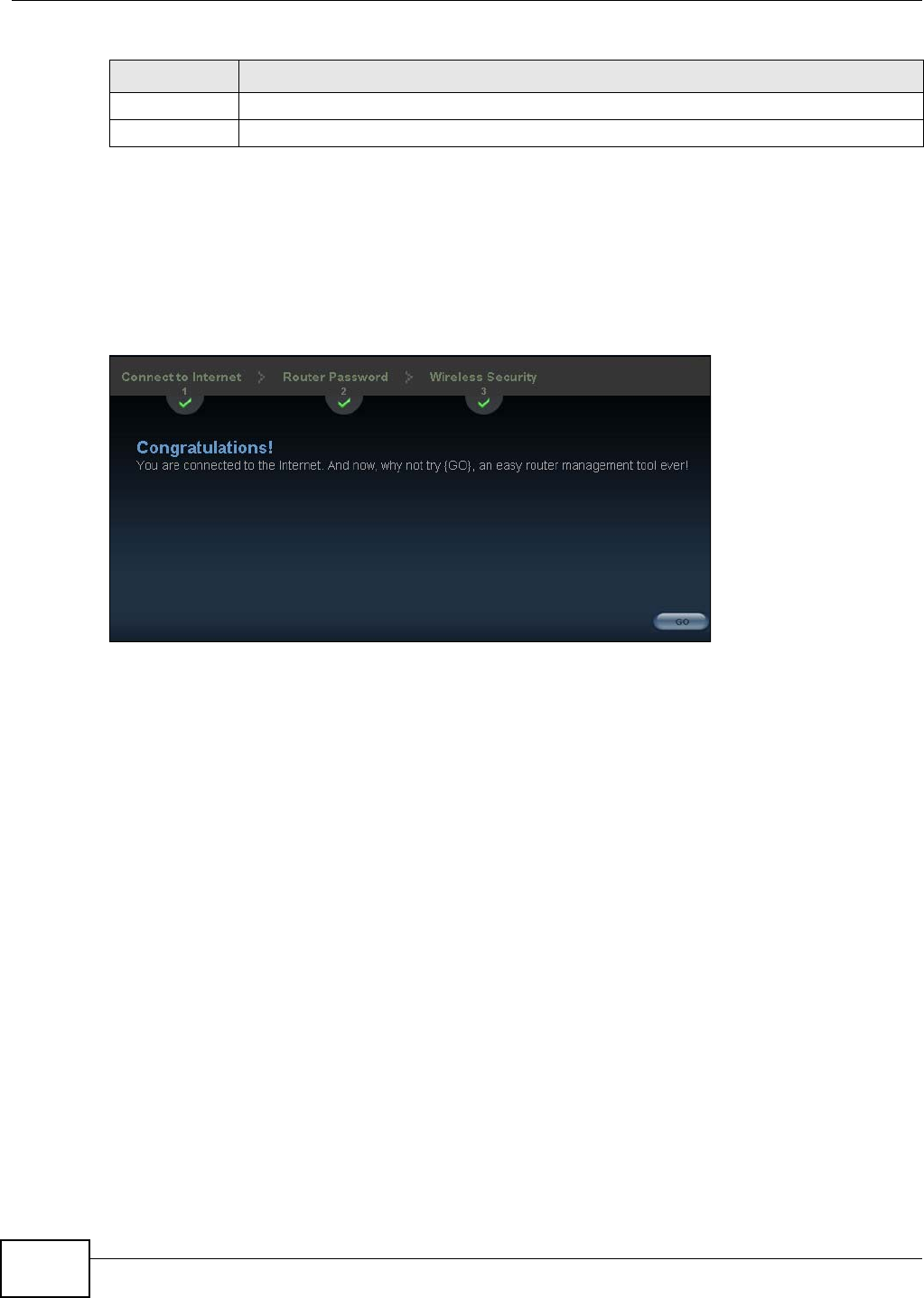
Chapter 4 Connection Wizard
NBG-419N v2 User’s Guide
38
Congratulations! Open a web browser, such as Internet Explorer, to visit your favorite website.
Note: If you cannot access the Internet when your computer is connected to one of the
Router’s LAN ports, check your connections. Then turn the Router off, wait for a few
seconds then turn it back on. If that does not work, log in to the web configurator
again and check you have typed all information correctly. See the User’s Guide for
more suggestions.
Figure 20 Congratulations
You can also click ZyGO to open the Easy Mode Web Configurator of your Router.
You have successfully set up your Router to operate on your network and access the Internet. You
are now ready to connect wirelessly to your Router and access the Internet.
Back Click this to return to the previous screen.
Next Click this to continue.
Table 12 Wireless Security: WPA-PSK/WPA2-PSK (continued)
LABEL DESCRIPTION

NBG-419N v2 User’s Guide 39
CHAPTER 5
Introducing the Web Configurator
5.1 Overview
This chapter describes how to access the Router Web Configurator and provides an overview of its
screens.
The Web Configurator is an HTML-based management interface that allows easy setup and
management of the Router via Internet browser. Use Internet Explorer 6.0 and later or Netscape
Navigator 7.0 and later versions or Safari 2.0 or later versions. The recommended screen resolution
is 1024 by 768 pixels.
In order to use the Web Configurator you need to allow:
• Web browser pop-up windows from your device. Web pop-up blocking is enabled by default in
Windows XP SP (Service Pack) 2.
• JavaScript (enabled by default).
• Java permissions (enabled by default).
Refer to the Troubleshooting chapter (Chapter 27 on page 191) to see how to make sure these
functions are allowed in Internet Explorer.
5.2 Accessing the Web Configurator
1Make sure your Router hardware is properly connected and prepare your computer or computer
network to connect to the Router (refer to the Quick Start Guide).
2Launch your web browser.
3Type "http://192.168.1.1" as the website address.
Your computer must be in the same subnet in order to access this website address.
5.2.1 Login Screen
Note: If this is the first time you are accessing the Web Configurator, you may be
redirected to the Wizard. Refer to Chapter 4 on page 29 for the Connection Wizard
screens.
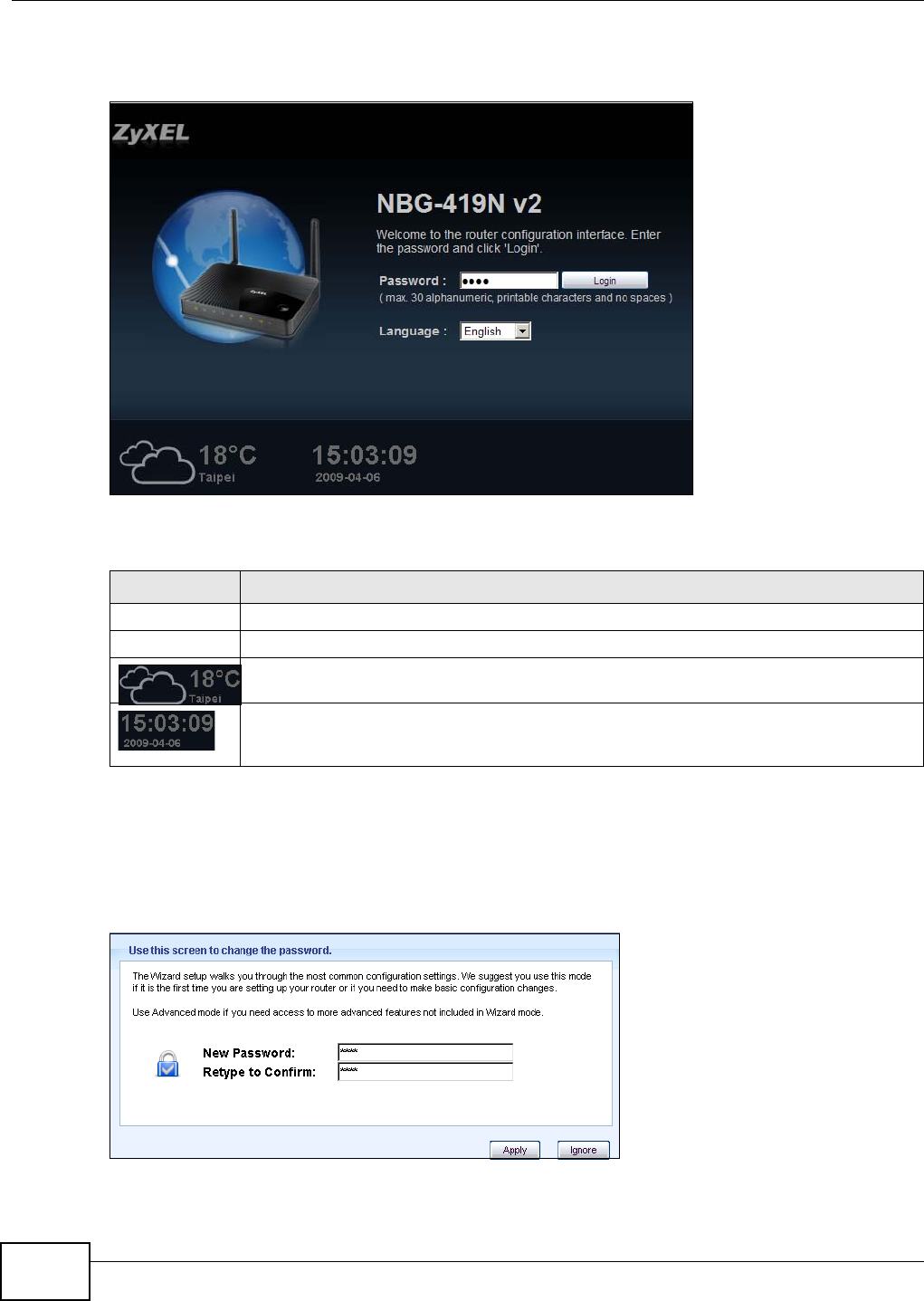
Chapter 5 Introducing the Web Configurator
NBG-419N v2 User’s Guide
40
The Web Configurator initially displays the following login screen.
Figure 21 Login screen
The following table describes the labels in this screen.
5.2.2 Password Screen
You should see a screen asking you to change your password (highly recommended) as shown
next.
Figure 22 Change Password Screen
Table 13 Login screen
LABEL DESCRIPTION
Password Type "1234" (default) as the password.
Language Select the language you want to use to configure the Web Configurator. Click Login.
This shows the current weather, either in celsius or fahrenheit, of the city you specify in
Section 5.2.3.1 on page 42.
This shows the time (hh:mm:ss) and date (yyyy:mm:dd) of the timezone you select in
Section 5.2.3.2 on page 42 or Section 26.5 on page 183. The time is in 24-hour format, for
example 15:00 is 3:00 PM.
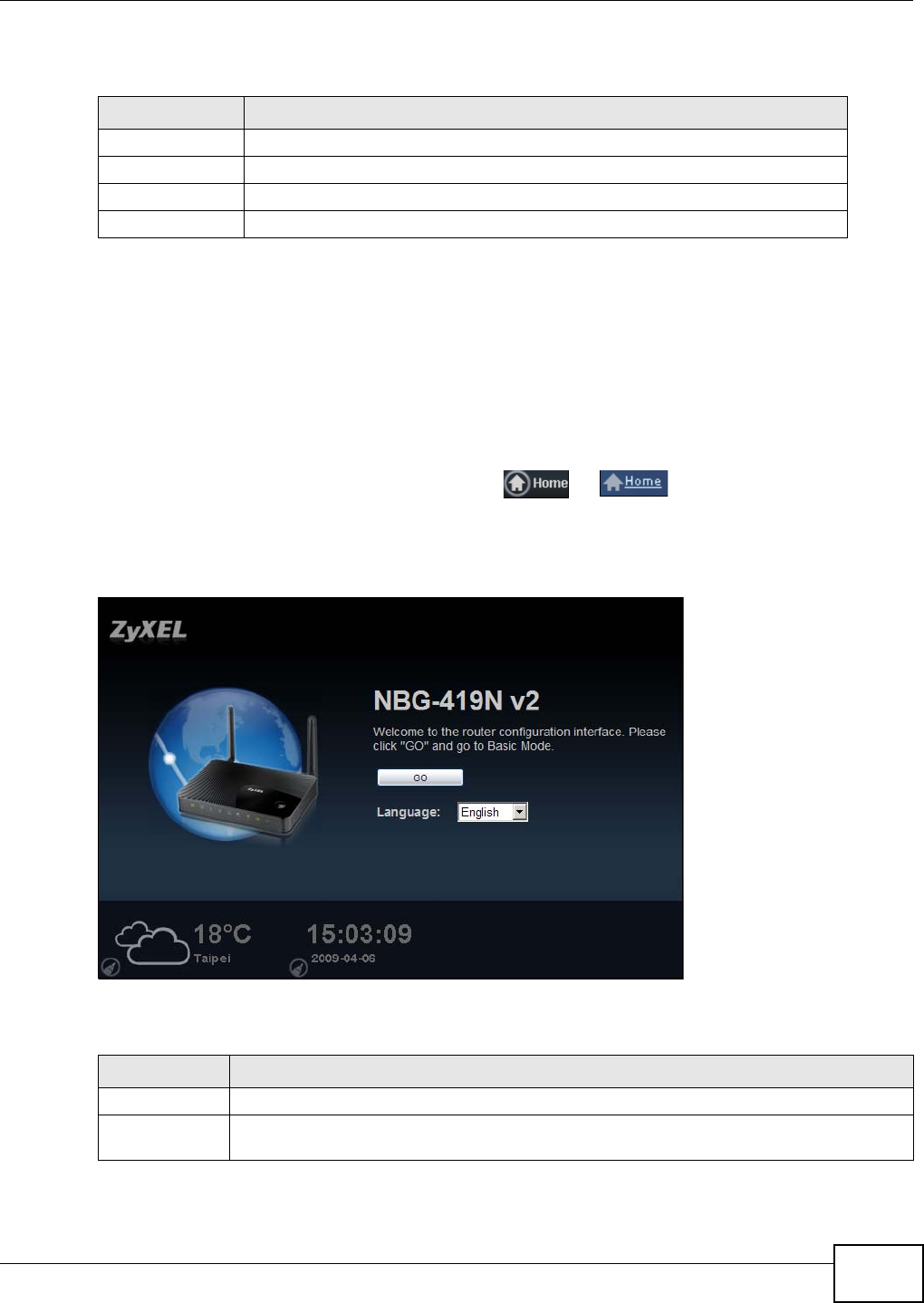
Chapter 5 Introducing the Web Configurator
NBG-419N v2 User’s Guide 41
The following table describes the labels in this screen.
Note: The management session automatically times out when the time period set in the
Administrator Inactivity Timer field expires (default five minutes; go to Chapter
26 on page 181 to change this). Simply log back into the Router if this happens.
5.2.3 Home Screen
If you have previously logged into the Web Configurator but did not click Logout, you may be
redirected to the Home screen.
You can also open this screen by clicking Home ( or ) in the Easy Mode or Expert
mode screens.
The Home screen displays as follows.
Figure 23 Home Screen
The following table describes the labels in this screen.
Table 14 Change Password Screen
LABEL DESCRIPTION
New Password Type a new password.
Retype to Confirm Retype the password for confirmation.
Apply Click Apply to save your changes back to the Router.
Ignore Click Ignore if you do not want to change the password this time.
Table 15 Home Screen
LABEL DESCRIPTION
Go Click this to open the Easy mode Web Configurator.
Language Select a language to go to the Easy mode Web Configurator in that language and click
Login.
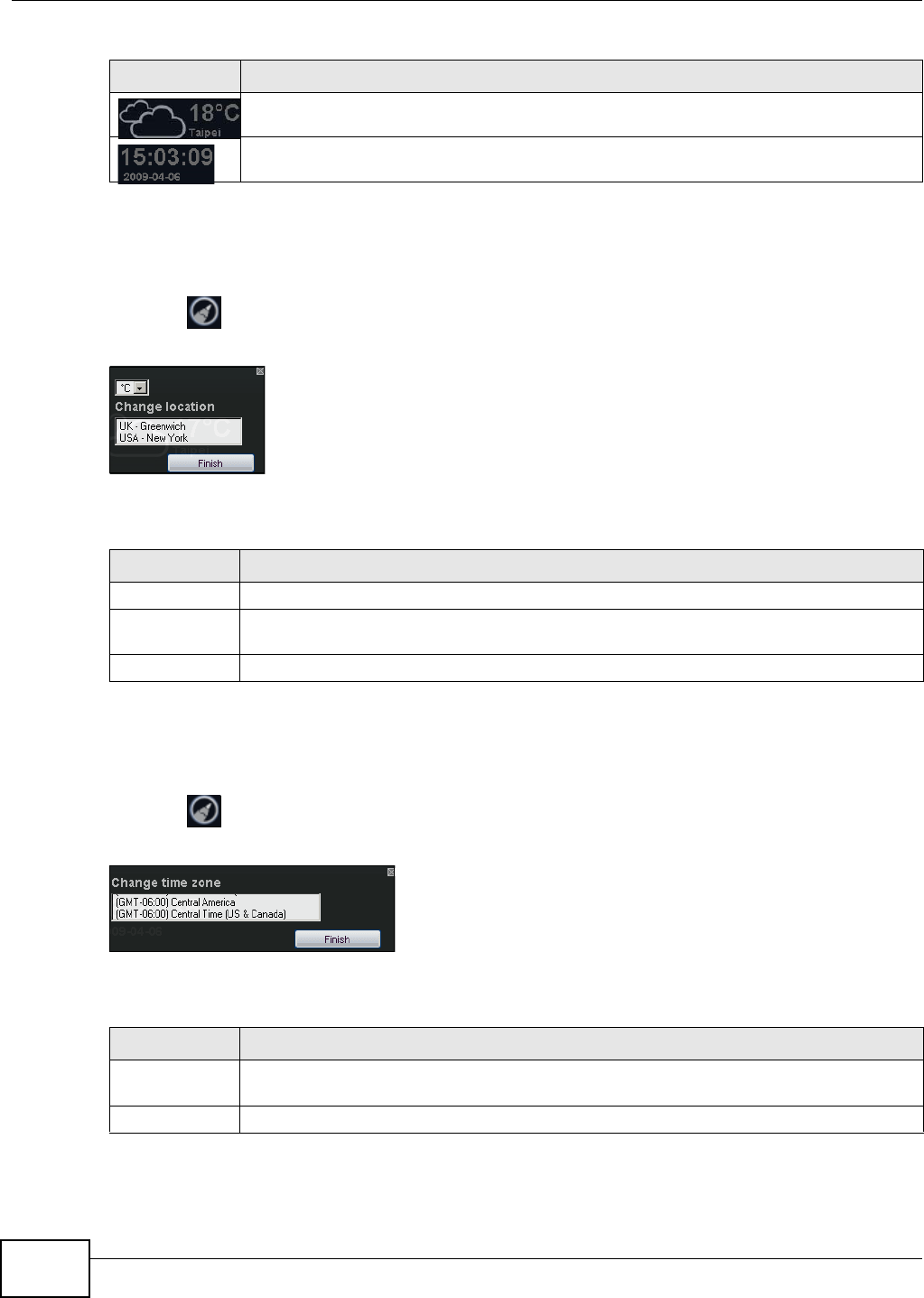
Chapter 5 Introducing the Web Configurator
NBG-419N v2 User’s Guide
42
5.2.3.1 Weather Edit
You can change the temperature unit and select the location for which you want to know the
weather.
Click the icon to change the Weather display.
Figure 24 Change Weather
The following table describes the labels in this screen.
5.2.3.2 Time/Date Edit
One timezone can cover more than one country. You can choose a particular country in which the
Router is located and have the Router display and use the current time and date for its logs.
Click the icon to change the Weather display.
Figure 25 Change Password Screen
The following table describes the labels in this screen.
Note: You can also edit the timezone in Section 26.5 on page 183.
(This is just an example). This shows the current weather, either in celsius or fahrenheit, of
the city you specify in Section 5.2.3.1 on page 42.
(This is just an example). This shows the time (hh:mm:ss) and date (yyyy:mm:dd) of the
timezone you select in Section 5.2.3.2 on page 42 or Section 26.5 on page 183.
Table 15 Home Screen (continued)
LABEL DESCRIPTION
Table 16 Change Weather
LABEL DESCRIPTION
oC or oF Choose which temperature unit you want the Router to display.
Change
Location
Select the location for which you want to know the weather. If the city you want is not listed,
choose one that is closest to it.
Finish Click this to apply the settings and refresh the date and time display.
Table 17 Change Password Screen
LABEL DESCRIPTION
Change time
zone
Select the specific country whose current time and date you want the Router to display.
Finish Click this to apply the settings and refresh the weather display.

Chapter 5 Introducing the Web Configurator
NBG-419N v2 User’s Guide 43
5.3 Resetting the Router
If you forget your password or IP address, or you cannot access the Web Configurator, you will need
to use the RESET button at the back of the Router to reload the factory-default configuration file.
This means that you will lose all configurations that you had previously saved, the password will be
reset to “1234” and the IP address will be reset to “192.168.1.1”.
5.3.1 Procedure to Use the Reset Button
1Make sure the power LED is on.
2Press the RESET button for longer than 1 second to restart/reboot the Router.
3Press the RESET button for longer than five seconds to set the Router back to its factory-default
configurations.

Chapter 5 Introducing the Web Configurator
NBG-419N v2 User’s Guide
44

NBG-419N v2 User’s Guide 45
CHAPTER 6
Monitor
6.1 Overview
This chapter discusses read-only information related to the device state of the Router.
Note: To access the Monitor screens, you can also click the links in the Summary table of
the Status screen to view the bandwidth consumed, packets sent/received as well
as the status of clients connected to the Router.
6.2 What You Can Do
•Use the Log (Section 6.3 on page 45) screen to see the logs for the activity on the Router.
•Use the BW MGMT Monitor screen (Section 6.4 on page 47) to view the amount of network
bandwidth that applications running in the network are using.
•Use the DHCP Table screen (Section 6.5 on page 47) to view information related to your DHCP
status.
•use the Packet Statistics screen (Section 6.6 on page 48) to view port status, packet specific
statistics, the "system up time" and so on.
•Use the WLAN Station Status screen (Section 6.7 on page 49) to view the wireless stations
that are currently associated to the Router.
6.3 The Log Screen
The Web Configurator allows you to look at all of the Router’s logs in one location.
6.3.1 View Log
Use the View Log screen to see the logged messages for the Router. The log wraps around and
deletes the old entries after it fills. Select what logs you want to see from the Display drop list. The
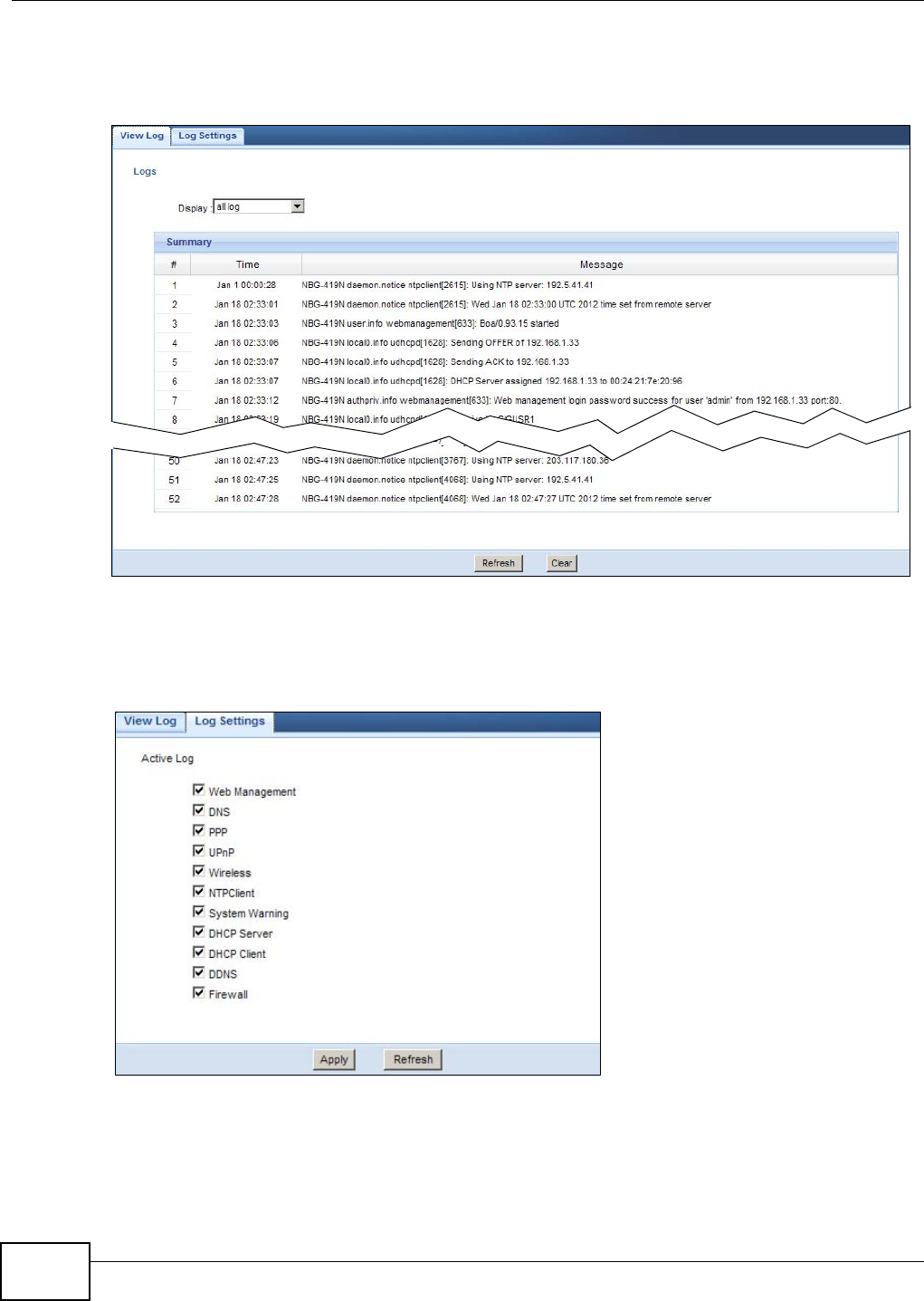
Chapter 6 Monitor
NBG-419N v2 User’s Guide
46
log choices depend on your settings in the Log Settings screen. Click Refresh to renew the log
screen. Click Clear to delete all the logs.
Figure 26 View Log
You can configure which logs to display in the View Log screen. Go to the Log Settings screen
and select the logs you wish to display. Click Apply to save your settings. Click Refresh to start the
screen afresh.
Figure 27 Log Settings
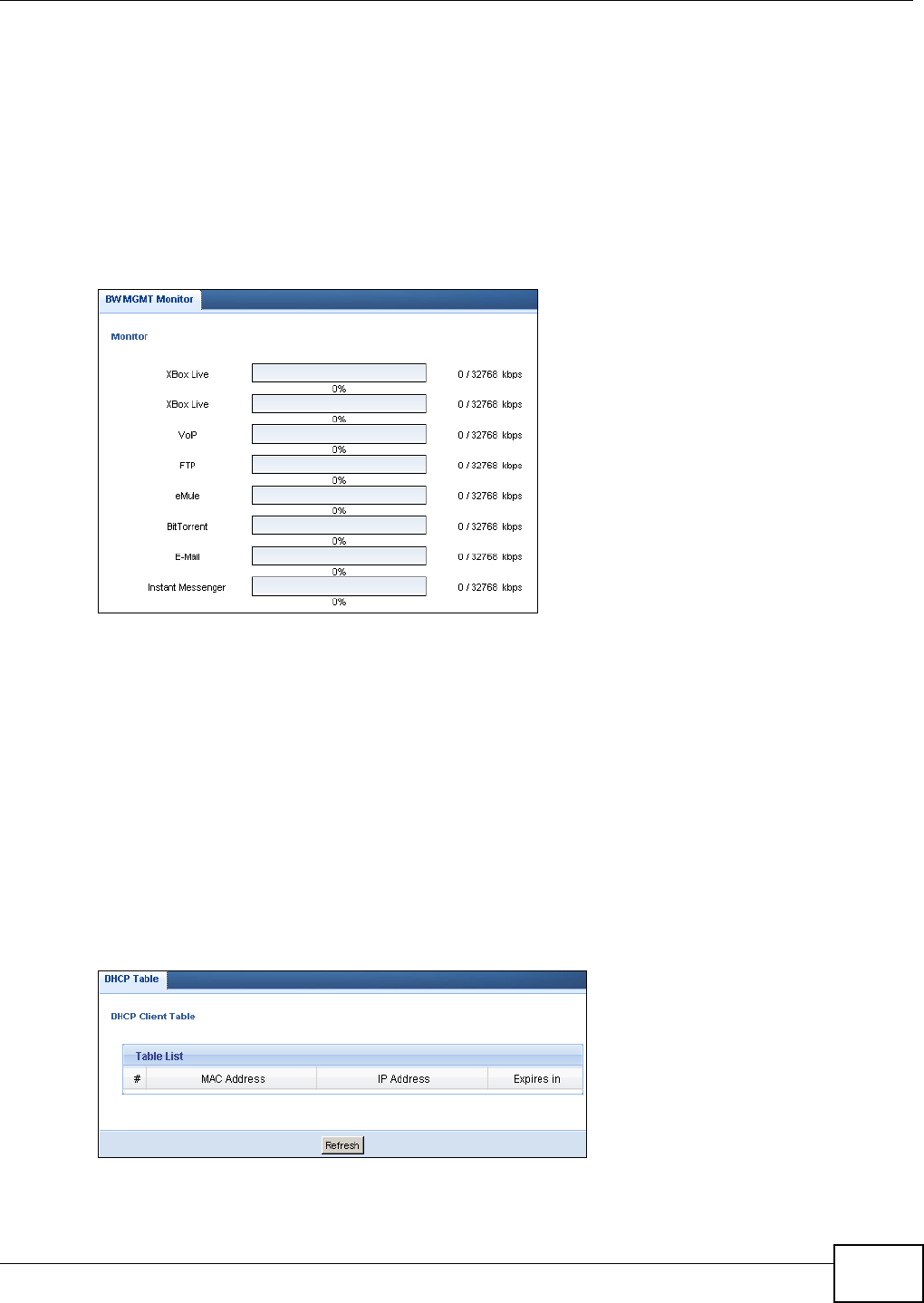
Chapter 6 Monitor
NBG-419N v2 User’s Guide 47
6.4 BW MGMT Monitor
The Bandwidth Management (BW MGMT) Monitor allows you to view the amount of network
bandwidth that applications running in the network are using.
The bandwidth is measured in kilobits per second (kbps).
The monitor shows what kinds of applications are running in the network, the maximum kbps that
each application can use, as well as the percentage of bandwidth it is using.
Figure 28 Summary: BW MGMT Monitor
6.5 DHCP Table
DHCP (Dynamic Host Configuration Protocol, RFC 2131 and RFC 2132) allows individual clients to
obtain TCP/IP configuration at start-up from a server. You can configure the Router’s LAN as a DHCP
server or disable it. When configured as a server, the Router provides the TCP/IP configuration for
the clients. If DHCP service is disabled, you must have another DHCP server on that network, or
else the computer must be manually configured.
Click the DHCP Table (Details...) hyperlink in the Status screen. Read-only information here
relates to your DHCP status. The DHCP table shows current DHCP client information (including IP
Address, Host Name and MAC Address) of all network clients using the Router’s DHCP server.
Figure 29 Summary: DHCP Table
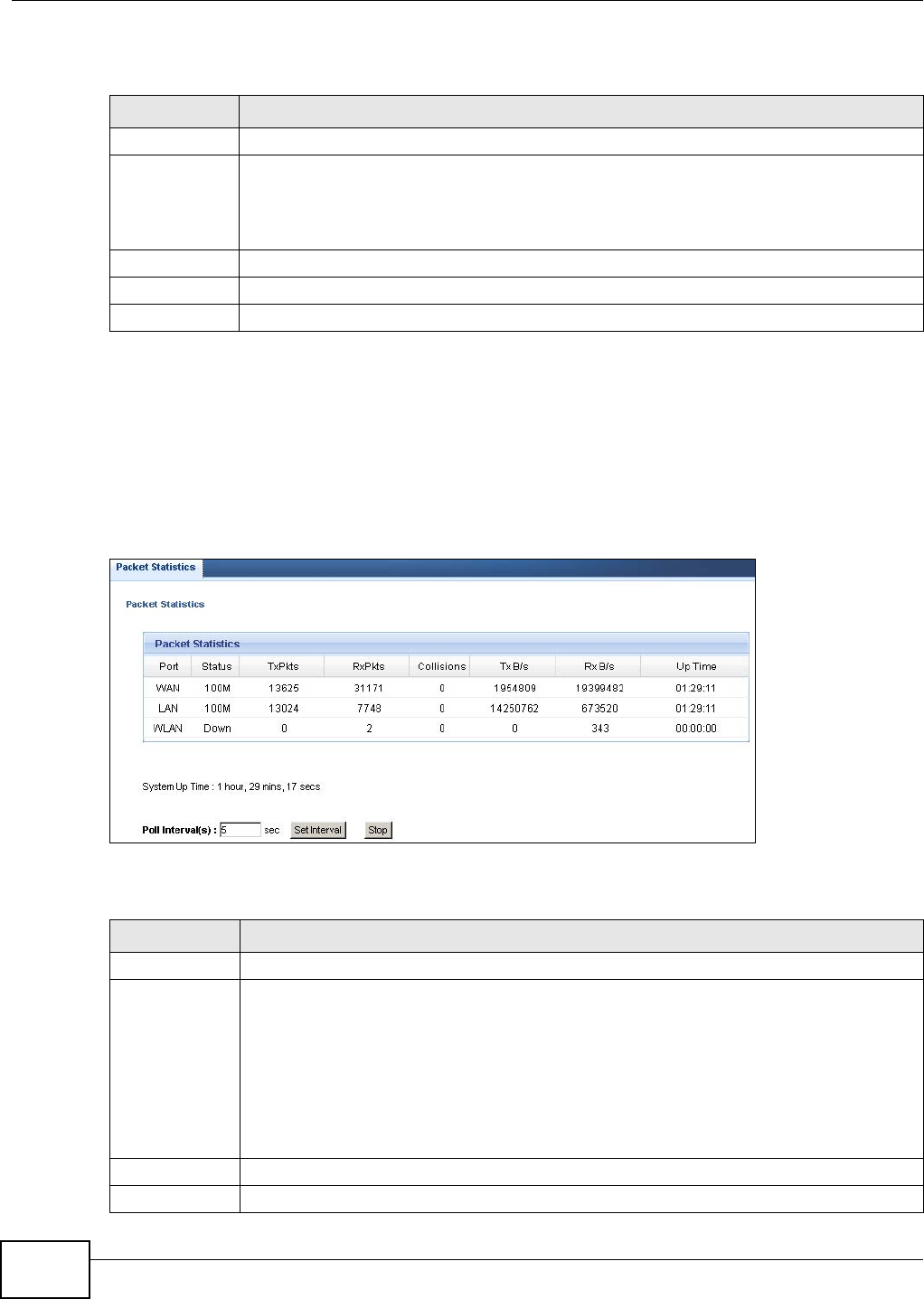
Chapter 6 Monitor
NBG-419N v2 User’s Guide
48
The following table describes the labels in this screen.
6.6 Packet Statistics
Click the Packet Statistics (Details...) hyperlink in the Status screen. Read-only information
here includes port status, packet specific statistics and the "system up time". The Poll Interval(s)
field is configurable and is used for refreshing the screen.
Figure 30 Summary: Packet Statistics
The following table describes the labels in this screen.
Table 18 Summary: DHCP Table
LABEL DESCRIPTION
# This is the index number of the host computer.
MAC Address This field shows the MAC address of the computer with the name in the Host Name field.
Every Ethernet device has a unique MAC (Media Access Control) address which uniquely
identifies a device. The MAC address is assigned at the factory and consists of six pairs of
hexadecimal characters, for example, 00:A0:C5:00:00:02.
IP Address This field displays the IP address relative to the # field listed above.
Expires in This field displays the time when the IP address and MAC address association ends.
Refresh Click Refresh to renew the screen.
Table 19 Summary: Packet Statistics
LABEL DESCRIPTION
Port This is the Router’s port type.
Status For the LAN ports, this displays the port speed and duplex setting or Down when the line is
disconnected.
For the WAN port, it displays the port speed and duplex setting if you’re using Ethernet
encapsulation and Idle (line (ppp) idle), Dial (starting to trigger a call) and Drop (dropping
a call) if you're using PPPoE or PPTP encapsulation. This field displays Down when the line is
disconnected.
For the WLAN, it displays the maximum transmission rate when the WLAN is enabled and
Down when the WLAN is disabled.
TxPkts This is the number of transmitted packets on this port.
RxPkts This is the number of received packets on this port.
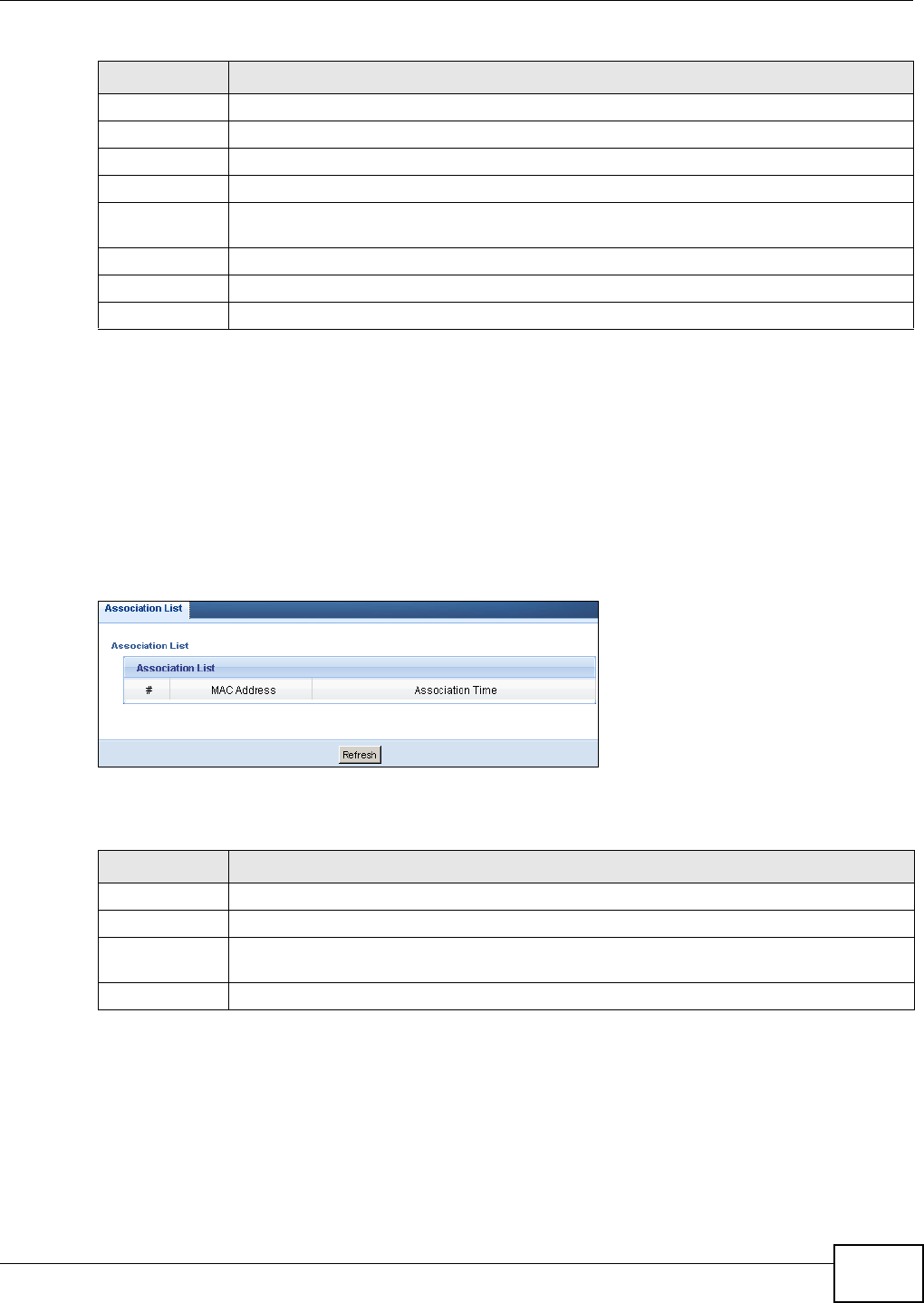
Chapter 6 Monitor
NBG-419N v2 User’s Guide 49
6.7 WLAN Station Status
Click the WLAN Station Status (Details...) hyperlink in the Status screen. View the wireless
stations that are currently associated to the Router in the Association List. Association means
that a wireless client (for example, your network or computer with a wireless network card) has
connected successfully to the AP (or wireless router) using the same SSID, channel and security
settings.
Figure 31 Summary: Wireless Association List
The following table describes the labels in this screen.
Collisions This is the number of collisions on this port.
Tx B/s This displays the transmission speed in bytes per second on this port.
Rx B/s This displays the reception speed in bytes per second on this port.
Up Time This is the total time the Router has been for each session.
System Up
Time
This is the total time the Router has been on.
Poll Interval(s) Enter the time interval in seconds for refreshing statistics in this field.
Set Interval Click this button to apply the new poll interval you entered in the Poll Interval(s) field.
Stop Click Stop to stop refreshing statistics.
Table 19 Summary: Packet Statistics (continued)
LABEL DESCRIPTION
Table 20 Summary: Wireless Association List
LABEL DESCRIPTION
# This is the index number of an associated wireless station.
MAC Address This field displays the MAC address of an associated wireless station.
Association
Time
This field displays the time a wireless station first associated with the Router’s WLAN
network.
Refresh Click Refresh to reload the list.

Chapter 6 Monitor
NBG-419N v2 User’s Guide
50

NBG-419N v2 User’s Guide 51
CHAPTER 7
Router Modes
7.1 Overview
This chapter introduces the different modes available on your Router. First, the term “mode” refers
to two things in this User’s Guide.
•Web Configurator mode. This refers to the Web Configurator interface you want to use for
editing Router features.
•Device mode. This is the operating mode of your Router, or simply how the Router is being used
in the network.
7.1.1 Web Configurator Modes
This refers to the configuration interface of the Web Configurator, which has two modes:
•Easy. The Web Configurator shows this mode by default. Refer to Chapter 8 on page 53 for more
information on the screens in this mode. This interface may be sufficient for users who just want
to use the device.
•Expert. Advanced users can change to this mode to customize all the functions of the Router.
Click Expert Mode after logging into the Web Configurator. The User’s Guide Chapter 5 on page
39 through Chapter 26 on page 181 discusses the screens in this mode.
7.1.2 Device Modes
This refers to the operating mode of the Router, which can act as a:
•Router. This is the default device mode of the Router. Use this mode to connect the local
network to another network, like the Internet. Go to Section 9.3 on page 65 to view the Status
screen in this mode.
•Access Point. Use this mode if you want to extend your network by allowing network devices to
connect to the Router wirelessly. Go to Section 10.4 on page 74 view the Status screen in this
mode.
•WISP mode. Use this mode if there is an existing wireless router or access point in the network
to which you want to connect your local network. Go to Section 11.4 on page 80 to view the
Status screen in this mode.
For more information on these modes and to change the mode of your Router, refer to Section
26.10 on page 189.
The menu for changing device modes is available in Expert mode only.
Note: Choose your Device Mode carefully to avoid having to change it later.

Chapter 7 Router Modes
NBG-419N v2 User’s Guide
52
When changing to another mode, the IP address of the Router changes. The running applications
and services of the network devices connected to the Router can be interrupted.
In WISP mode, you should know the SSID and wireless security details of the access point to which
you want to connect.
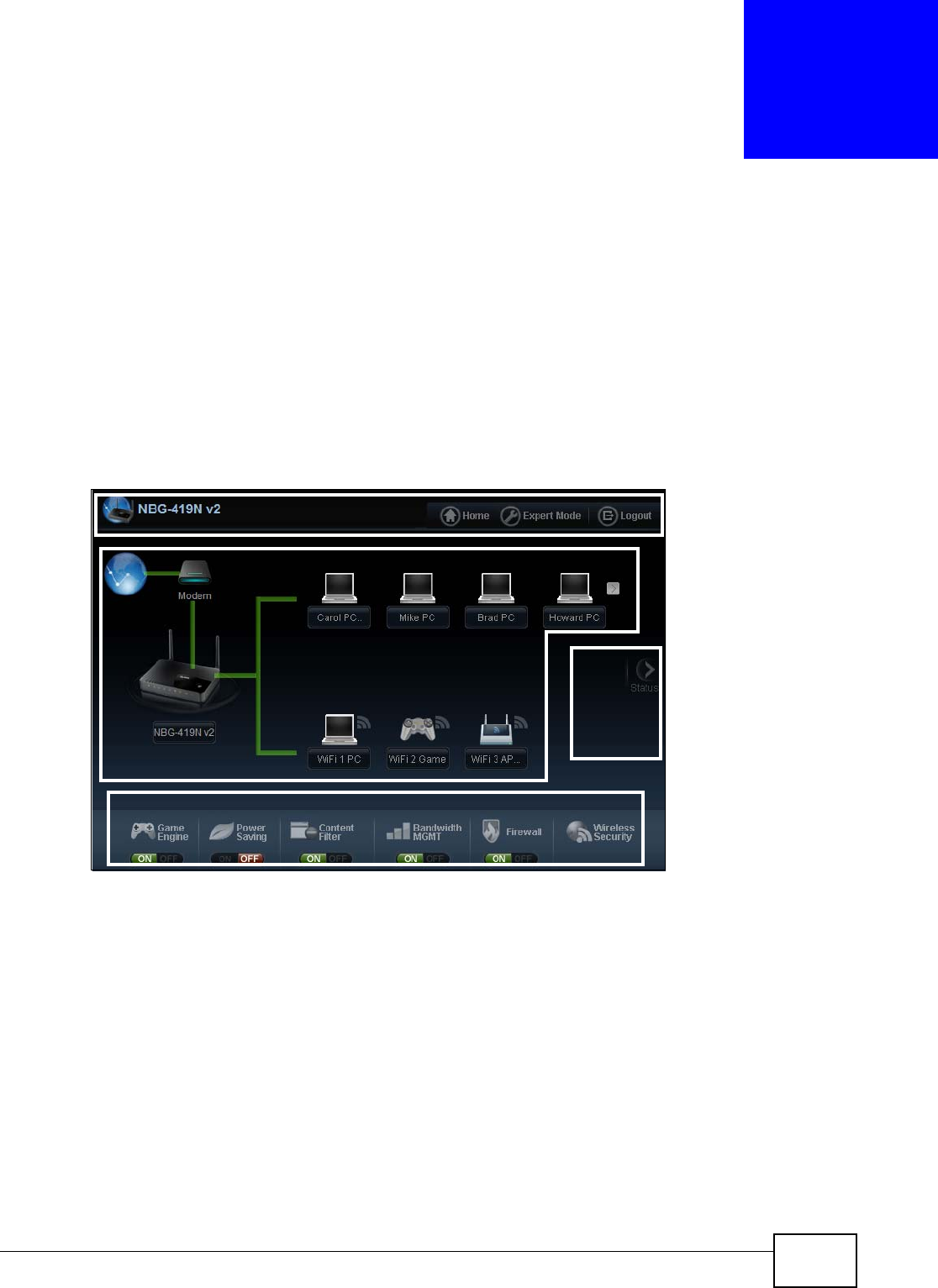
NBG-419N v2 User’s Guide 53
CHAPTER 8
Easy Mode
8.1 Overview
The Web Configurator is set to Easy Mode by default. You can configure several key features of the
Router in this mode. This mode is useful to users who are not fully familiar with some features that
are usually intended for network administrators.
When you log in to the Web Configurator, the following screen opens.
Figure 32 Easy Mode: Network Map
Network Map
Control Panel
Go to
Status
Screen
Navigation Panel
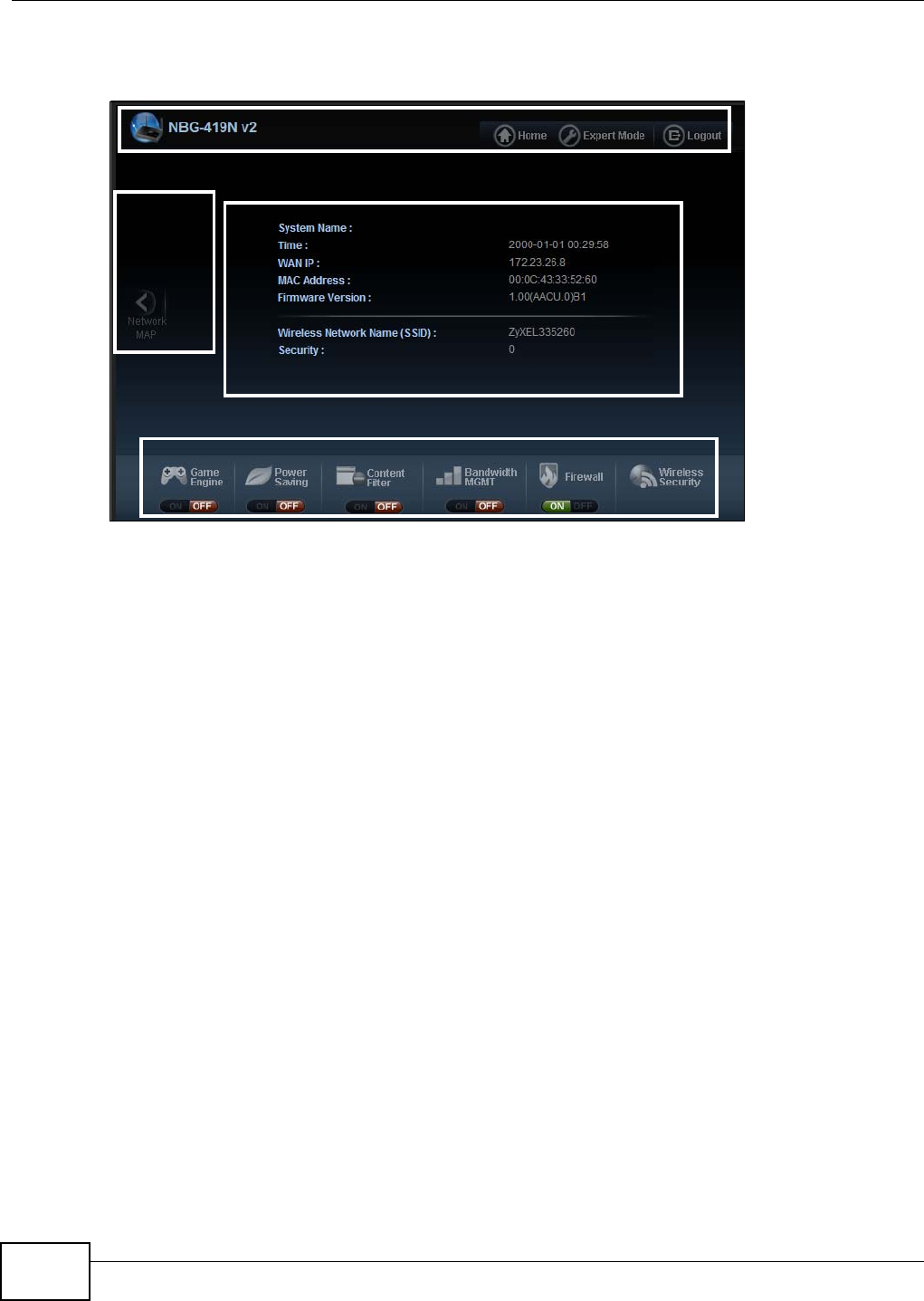
Chapter 8 Easy Mode
NBG-419N v2 User’s Guide
54
Click Status to open the following screen screen.
Figure 33 Easy Mode: Status Screen
8.2 What You Can Do
You can do the following in this mode:
•Use this Navigation Panel (Section 8.4 on page 55) to opt out of the Easy mode.
•Use the Network Map screen (Section 8.5 on page 55) to check if your Router can ping the
gateway and whether it is connected to the Internet.
•Use the Control Panel (Section 8.6 on page 56) to configure and enable Router features,
including wireless security, wireless scheduling and bandwidth management and so on.
•Use the Status Screen screen (Section 8.7 on page 63) to view read-only information about the
Router, including the WAN IP, MAC Address of the Router and the firmware version.
8.3 What You Need to Know
Between the different device modes, the Control Panel (Section 8.6 on page 56) changes depending
on which features are applicable to the mode:
•Router Mode: All Control Panel features are available.
•Access Point Mode: Only Power Saving and Wireless Security are available.
•WISP Mode: The available features for this mode are Game Console, Content Filter,
Bandwidth MGMT, and Firewall.
Control Panel
Status Screen
Go to
Network
Map
Screen
Navigation Panel
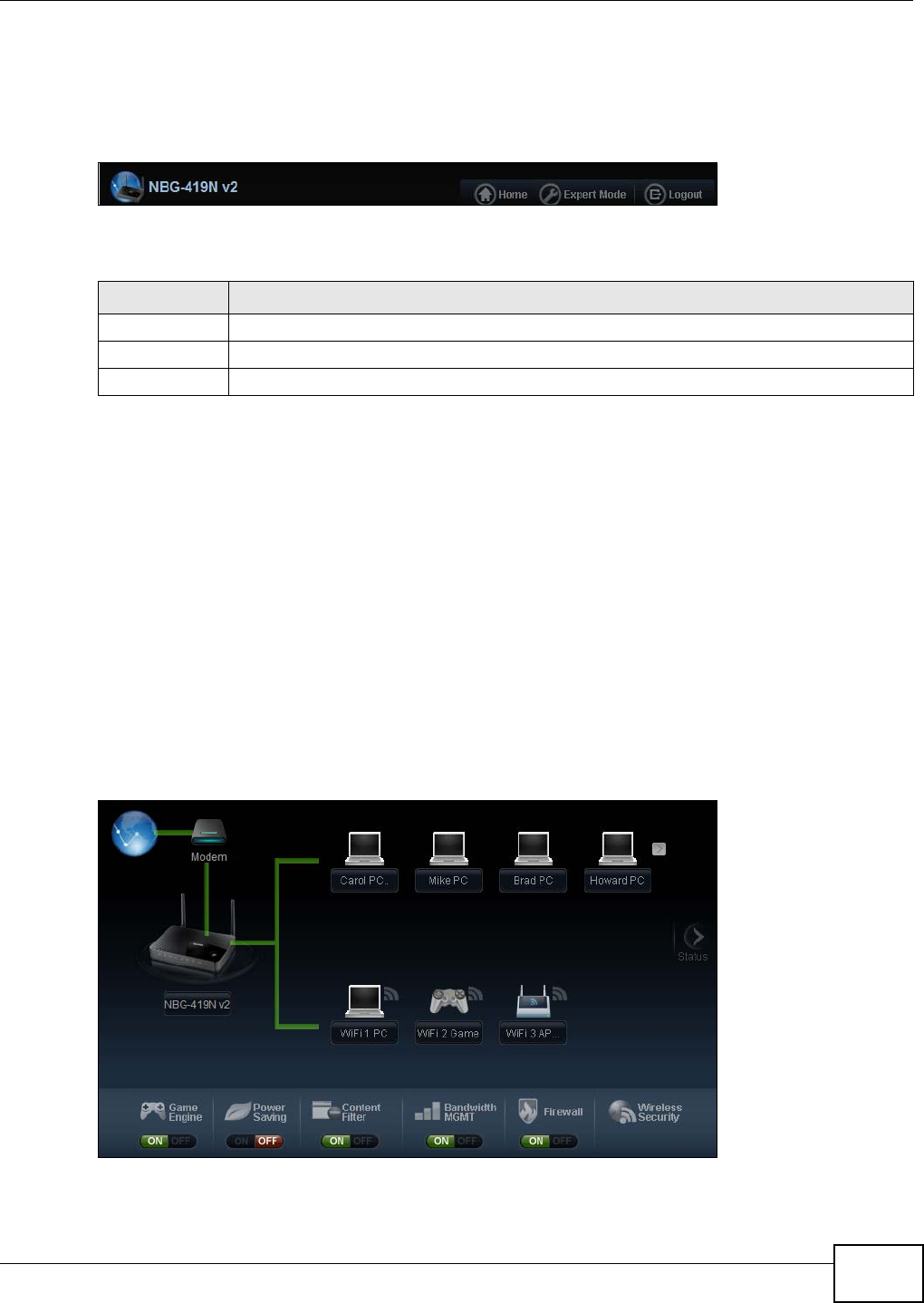
Chapter 8 Easy Mode
NBG-419N v2 User’s Guide 55
8.4 Navigation Panel
Use this navigation panel to opt out of the Easy mode.
Figure 34 Control Panel
The following table describes the labels in this screen.
8.5 Network Map
Note: The Network MAP is viewable by Windows XP (need to install patch), Windows
Vista and Windows 7 users only. For Windows XP (Service Pack 2) users, you can
see the network devices connected to the Router by downloading the LLTD (Link
Layer Topology Discovery) patch from the Microsoft Website.
Note: Don’t worry if the Network Map does not display in your web browser. This feature
may not be supported by your system. You can still configure the Control Panel
(Section 8.6 on page 56) in the Easy Mode and the Router features that you want to
use in the Expert Mode.
When you log into the Network Configurator, the Network Map is shown as follows.
Figure 35 Network Map
Table 21 Control Panel
ITEM DESCRIPTION
Home Click this to go to the Login page.
Expert Mode Click this to change to Expert mode and customize features of the Router.
Logout Click this to end the Web Configurator session.
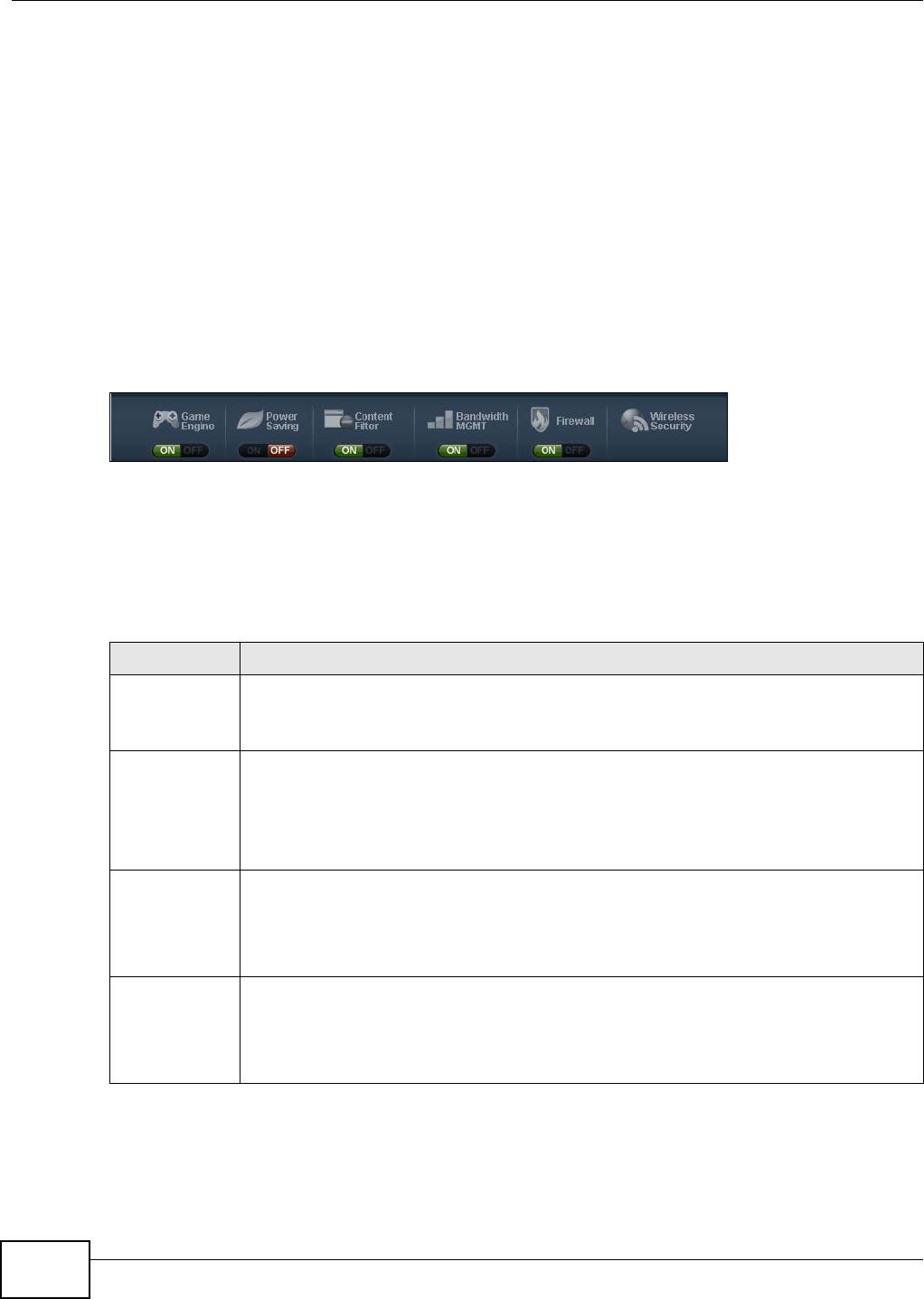
Chapter 8 Easy Mode
NBG-419N v2 User’s Guide
56
The line connecting the Router to the gateway becomes green when the Router is able to ping the
gateway. It becomes red when the ping initiating from the Router does not get a response from the
gateway. The same rule applies to the line connecting the gateway to the Internet.
You can also view the devices (represented by icons indicating the kind of network device)
connected to the Router, including those connecting wirelessly. Right-click on the Router icon to
refresh the network map and go to the Wizard. Right click on the other icons to view information
about the device.
8.6 Control Panel
The features configurable in Easy Mode are shown in the Control Panel.
Figure 36 Control Panel
Switch ON to enable the feature. Otherwise, switch OFF. If the feature is turned on, the green light
flashes. If it is turned off, the red light flashes.
Additionally, click the feature to open a screen where you can edit its settings.
The following table describes the labels in this screen.
Table 22 Control Panel
ITEM DESCRIPTION
Game Engine Switch ON to maximize bandwidth for gaming traffic in your network. Otherwise, switch
OFF.
Refer to Section 8.6.1 on page 57 to see this screen.
Power Saving Click this to schedule the wireless feature of the Router.
Disabling the wireless function helps lower the energy consumption of the Router.
Switch ON to apply wireless scheduling. Otherwise, switch OFF.
Refer to Section 8.6.2 on page 57 to see this screen.
Content Filter Click this to restrict access to certain websites, based on keywords contained in URLs, to
which you do not want users in your network to open.
Switch ON to apply website filtering. Otherwise, switch OFF.
Refer to Section 8.6.3 on page 59 to see this screen.
Bandwidth
MGMT
Click this to edit bandwidth management for predefined applications.
Switch ON to have the Router management bandwidth for uplink and downlink traffic
according to an application or service. Otherwise, switch OFF.
Refer to Section 8.6.4 on page 59 to see this screen.
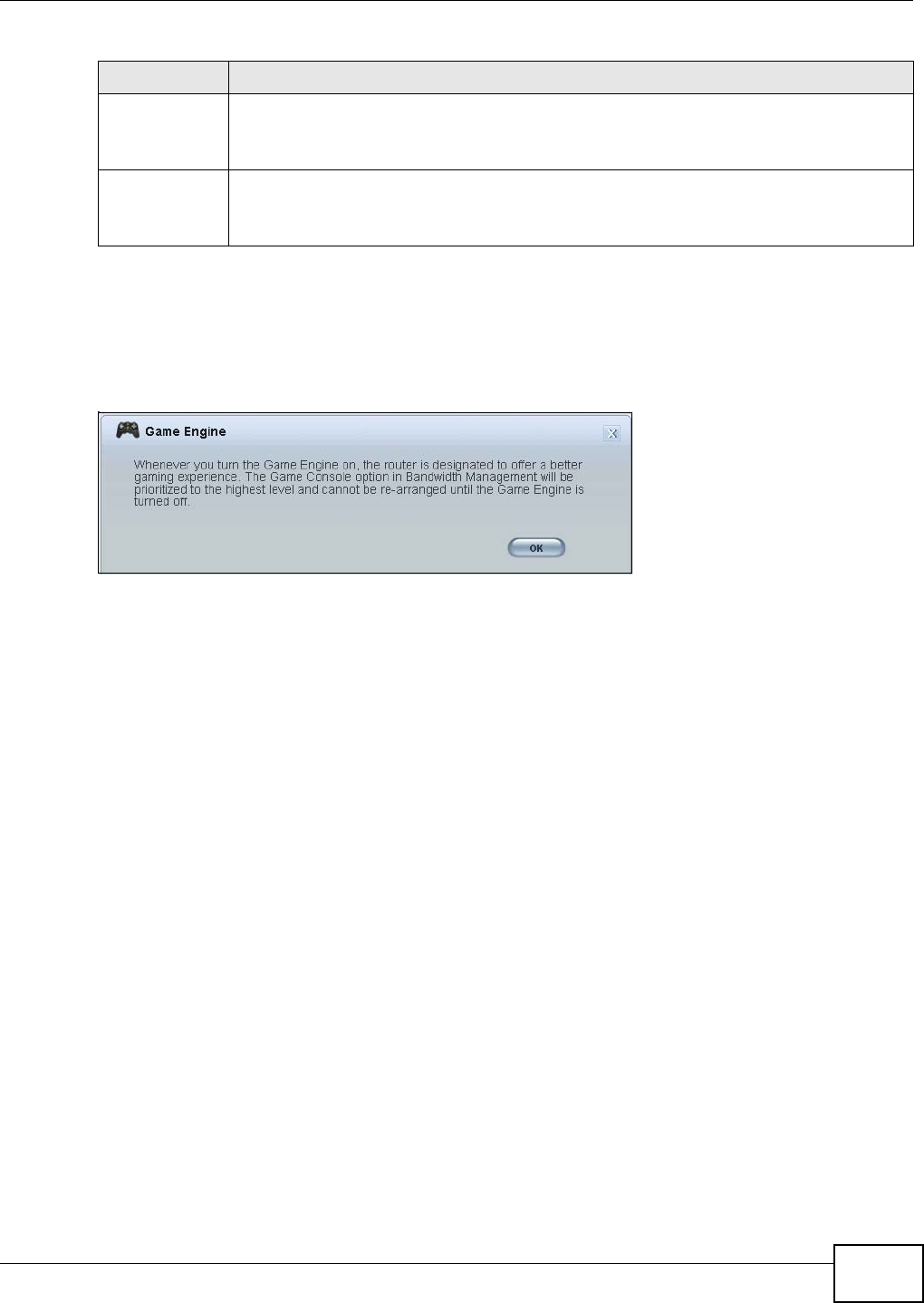
Chapter 8 Easy Mode
NBG-419N v2 User’s Guide 57
8.6.1 Game Engine
When this feature is enabled, the Router maximizes the bandwidth for gaming traffic that it
forwards out through an interface.
Figure 37 Game Engine
Note: When this is switched on, the Game Console tab in the Bandwidth MGMT screen
is automatically positioned on top.
Turn this off if your network is not using gaming.
Click OK to close this screen.
8.6.2 Power Saving
Use this screen to set the day of the week and time of the day when your wireless LAN is turned on
and off. Wireless LAN scheduling is disabled by default.
Firewall Switch ON to ensure that your network is protected from Denial of Service (DoS) attacks.
Otherwise, switch OFF.
Refer to Section 8.6.5 on page 60 to see this screen.
Wireless
Security
Click this to configure the wireless security, such as SSID, security mode and WPS key on
your Router.
Refer to Section 8.6.6 on page 60 to see this screen.
Table 22 Control Panel (continued)
ITEM DESCRIPTION
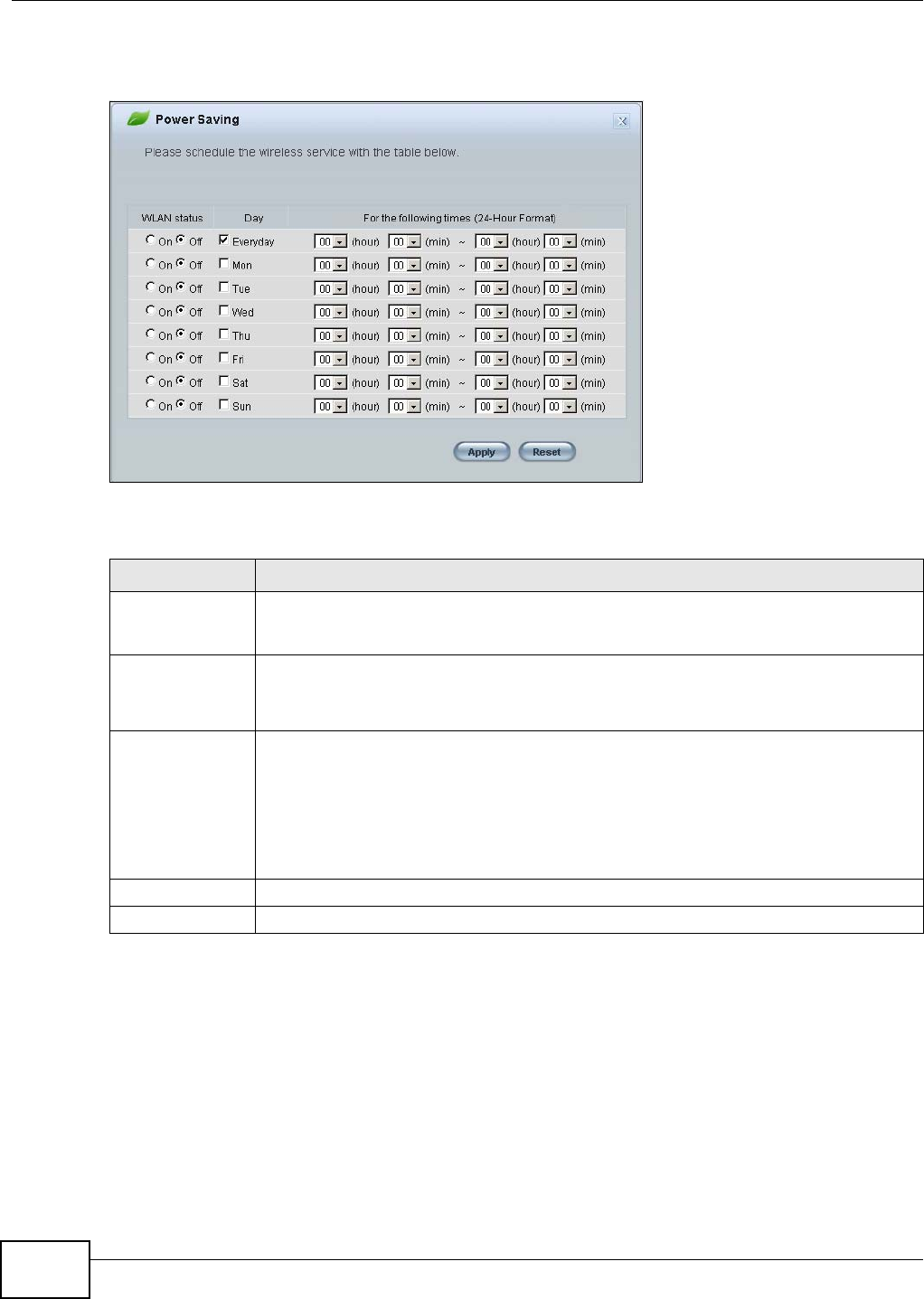
Chapter 8 Easy Mode
NBG-419N v2 User’s Guide
58
Disabling the wireless capability lowers the energy consumption of the of the Router.
Figure 38 Power Saving
The following table describes the labels in this screen.
Table 23 Power Saving
LABEL DESCRIPTION
WLAN Status Select On or Off to specify whether the Wireless LAN is turned on or off (depending on
what you selected in the WLAN Status field). This field works in conjunction with the
Day and Except for the following times fields.
Day Select Everyday or the specific days to turn the Wireless LAN on or off.
If you select Everyday you can not select any specific days. This field works in
conjunction with the Except for the following times field.
For the following
times (24-Hour
Format)
Select a begin time using the first set of hour and minute (min) drop down boxes and
select an end time using the second set of hour and minute (min) drop down boxes. If
you have chosen On earlier for the WLAN Status the Wireless LAN will turn on between
the two times you enter in these fields. If you have chosen Off earlier for the WLAN
Status the Wireless LAN will turn off between the two times you enter in these fields.
In this time format, midnight is 00:00 and progresses up to 24:00. For example, 6:00 PM
is 18:00.
Apply Click Apply to save your changes back to the Router.
Reset Click Reset to begin configuring this screen afresh.
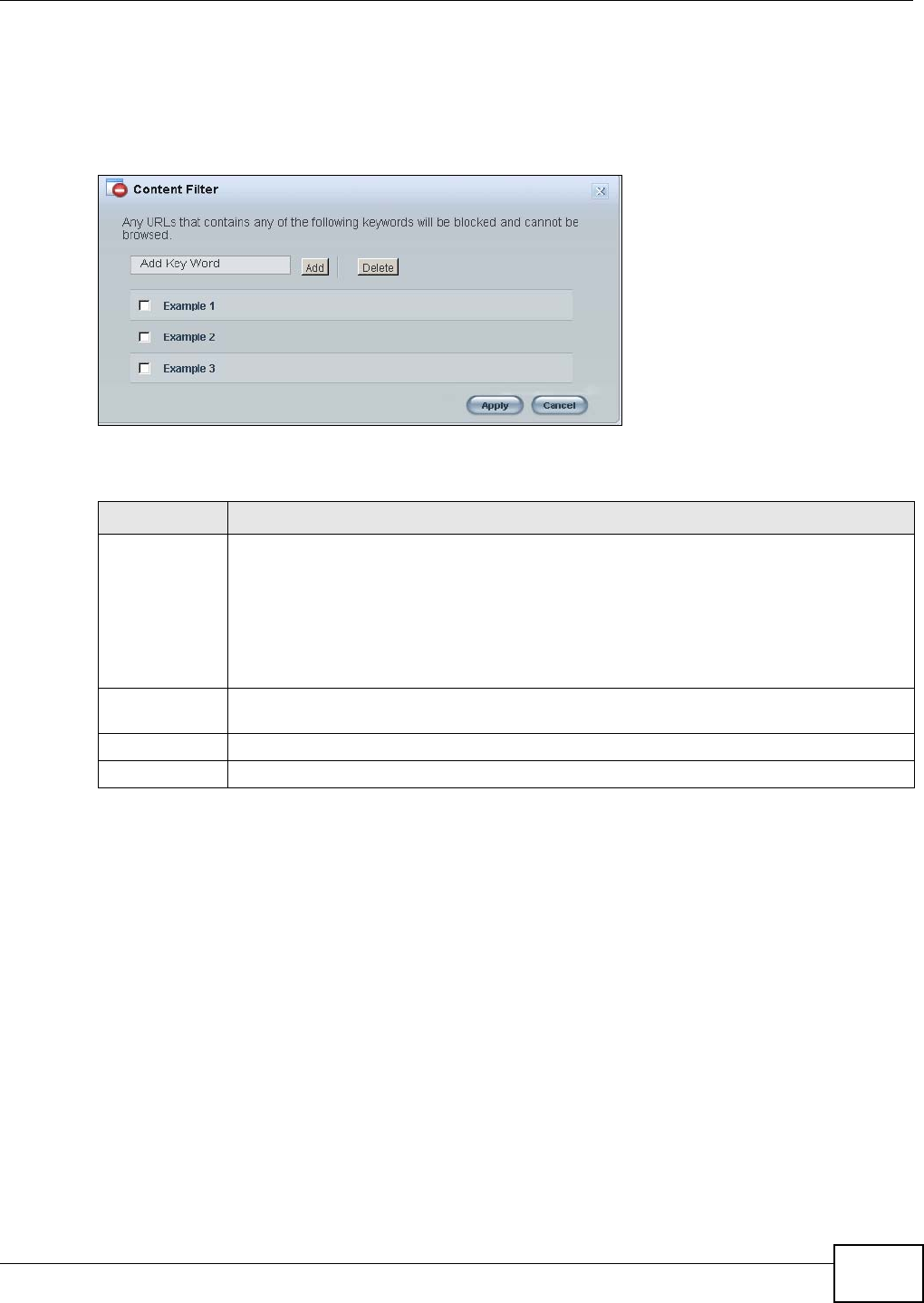
Chapter 8 Easy Mode
NBG-419N v2 User’s Guide 59
8.6.3 Content Filter
Use this screen to restrict access to certain websites, based on keywords contained in URLs, to
which you do not want users in your network to open.
Figure 39 Content Filter
The following table describes the labels in this screen.
8.6.4 Bandwidth MGMT
Use this screen to set bandwidth allocation to pre-defined services and applications for bandwidth
allocation.
Table 24 Content Filter
LABEL DESCRIPTION
Add Click Add after you have typed a keyword.
Repeat this procedure to add other keywords. Up to 64 keywords are allowed.
Note: The Router does not recognize wildcard characters as keywords.
When you try to access a web page containing a keyword, you will get a message telling you
that the content filter is blocking this request.
Delete Highlight a keyword in the text box and click Delete to remove it. The keyword disappears
from the text box after you click Apply.
Apply Click Apply to save your changes.
Cancel Click Cancel to close this screen without saving any changes.
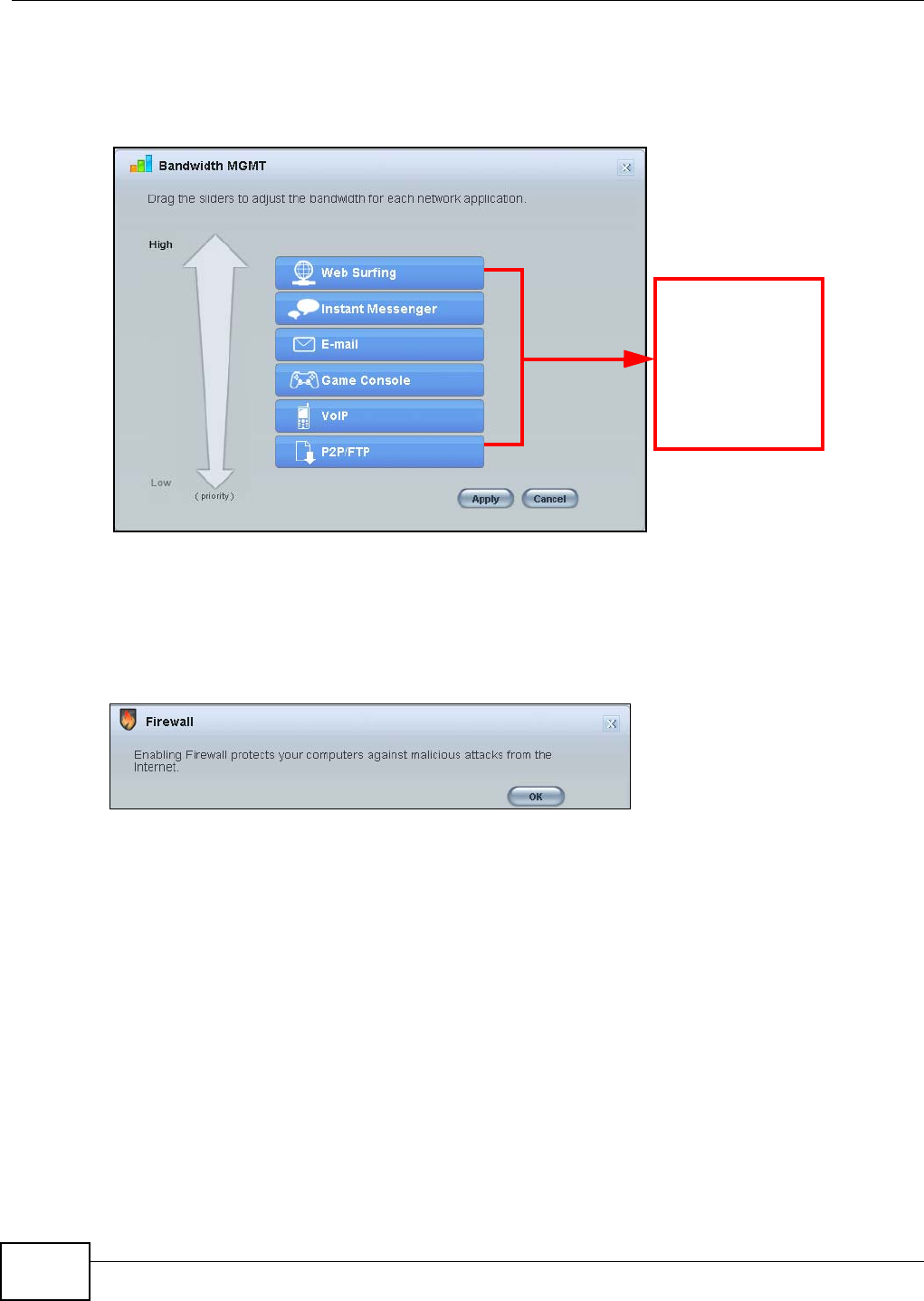
Chapter 8 Easy Mode
NBG-419N v2 User’s Guide
60
The Router uses bandwidth management for incoming and outgoing traffic. Rank the services and
applications by dragging them accordingly from High to Low and click Apply. Click Cancel to close
the screen.
Figure 40 Bandwidth MGNT
8.6.5 Firewall
Enable this feature to protect the network from Denial of Service (DoS) attacks. The Router blocks
repetitive pings from the WAN that can otherwise cause systems to slow down or hang.
Figure 41 Firewall
Click OK to close this screen.
8.6.6 Wireless Security
Use this screen to configure security for your the Wireless LAN. You can enter the SSID and select
the wireless security mode in the following screen.
Use your mouse
to drag the items
according to how
you want to
prioritze them.
Left-click and
slide up or down.
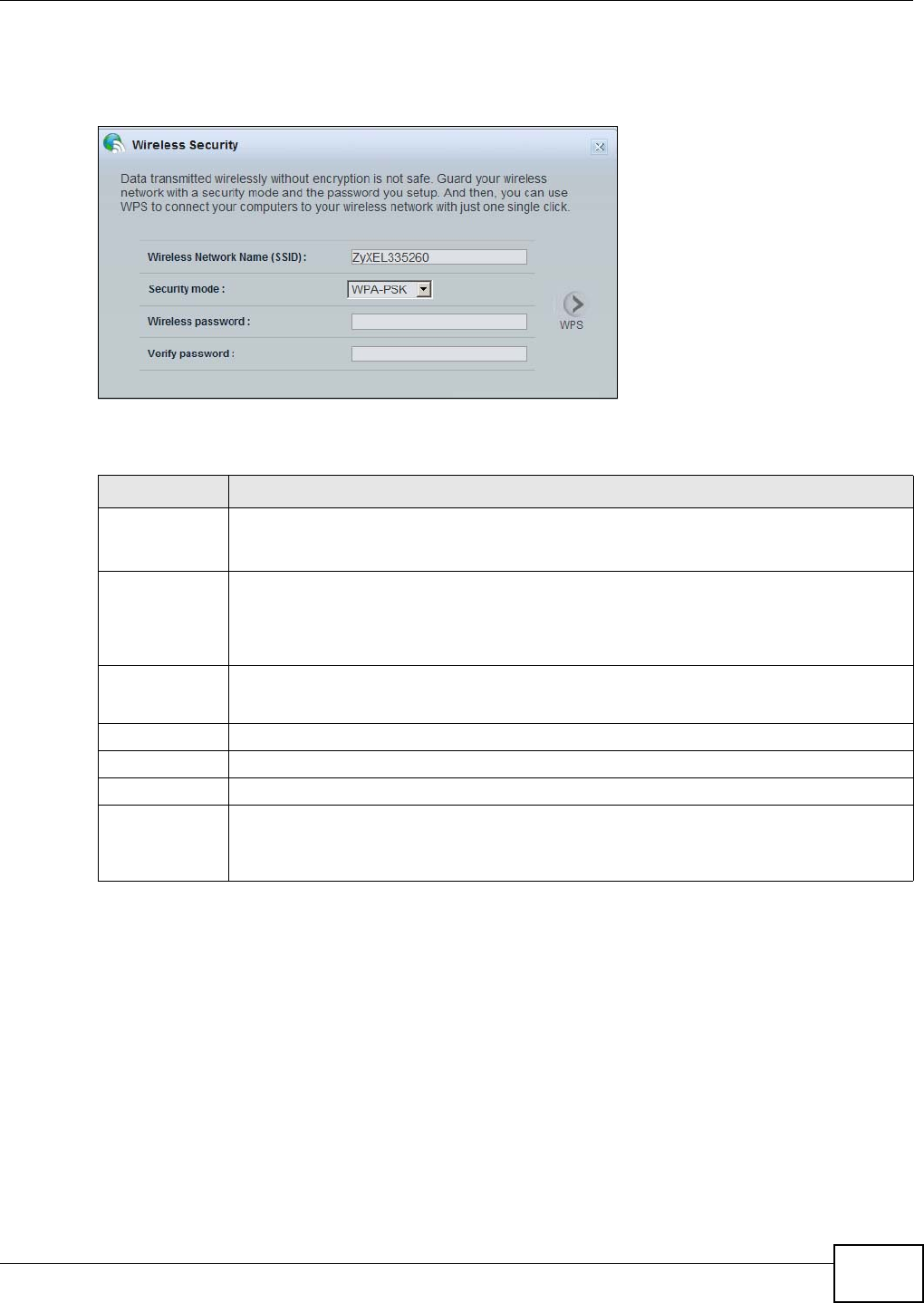
Chapter 8 Easy Mode
NBG-419N v2 User’s Guide 61
Note: You can enable the Wireless function of your Router by first turning on the switch in
the back panel.
Figure 42 Wireless Security
The following table describes the general wireless LAN labels in this screen.
Table 25 Wireless Security
LABEL DESCRIPTION
Wireless
Network Name
(SSID)
(Service Set IDentity) The SSID identifies the Service Set with which a wireless station is
associated. Wireless stations associating to the access point (AP) must have the same SSID.
Enter a descriptive name (up to 32 keyboard characters) for the wireless LAN.
Security mode Select WPA-PSK or WPA2-PSK to add security on this wireless network. The wireless
clients which want to associate to this network must have same wireless security settings as
this device. After you select to use a security, additional options appears in this screen.
Select No Security to allow any client to connect to this network without authentication.
Wireless
password
This field appears when you choose wither WPA-PSK or WPA2-PSK as the security mode.
Type a pre-shared key from 8 to 63 case-sensitive keyboard characters.
Verify password Type the password again to confirm.
Apply Click Apply to save your changes back to the Router.
Cancel Click Cancel to close this screen.
WPS Click this to configure the WPS screen.
You can transfer the wireless settings configured here (Wireless Security screen) to
another wireless device that supports WPS.
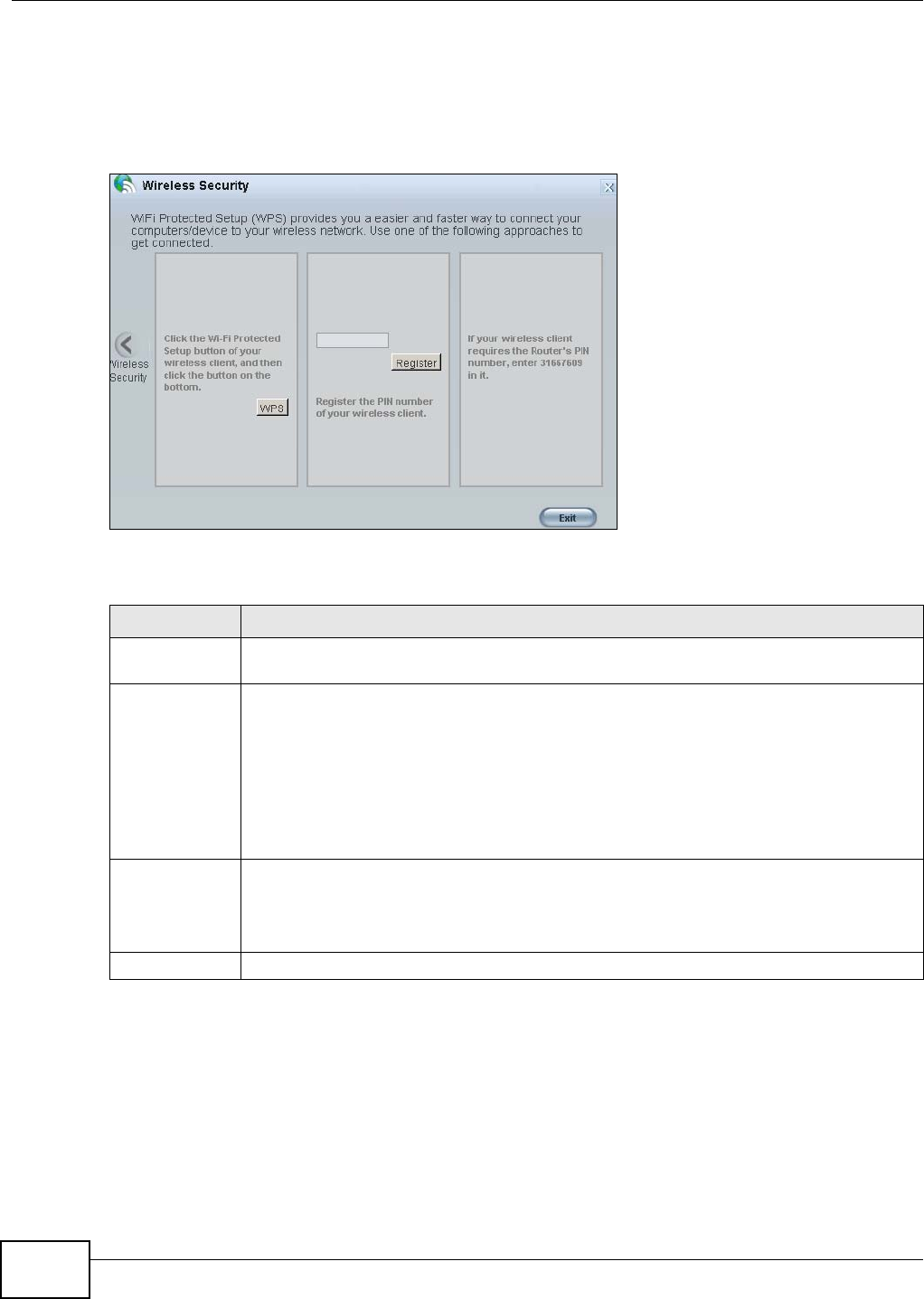
Chapter 8 Easy Mode
NBG-419N v2 User’s Guide
62
8.6.7 WPS
Use this screen to add a wireless station to the network using WPS. Click WPS in the Wireless
Security to open the following screen.
Figure 43 Wireless Security: WPS
The following table describes the labels in this screen.
Table 26 Wireless Security: WPS
LABEL DESCRIPTION
Wireless
Security
Click this to go back to the Wireless Security screen.
WPS Create a secure wireless network simply by pressing a button.
The Router scans for a WPS-enabled device within the range and performs wireless security
information synchronization.
Note: After you click the WPS button on this screen, you have to press a similar button in the
wireless station utility within 2 minutes. To add the second wireless station, you have
to press these buttons on both device and the wireless station again after the first 2
minutes.
Register Create a secure wireless network simply by entering a wireless client's PIN (Personal
Identification Number) in the Router’s interface and pushing this button.
Type the same PIN number generated in the wireless station’s utility. Then click Register to
associate to each other and perform the wireless security information synchronization.
Exit Click Exit to close this screen.
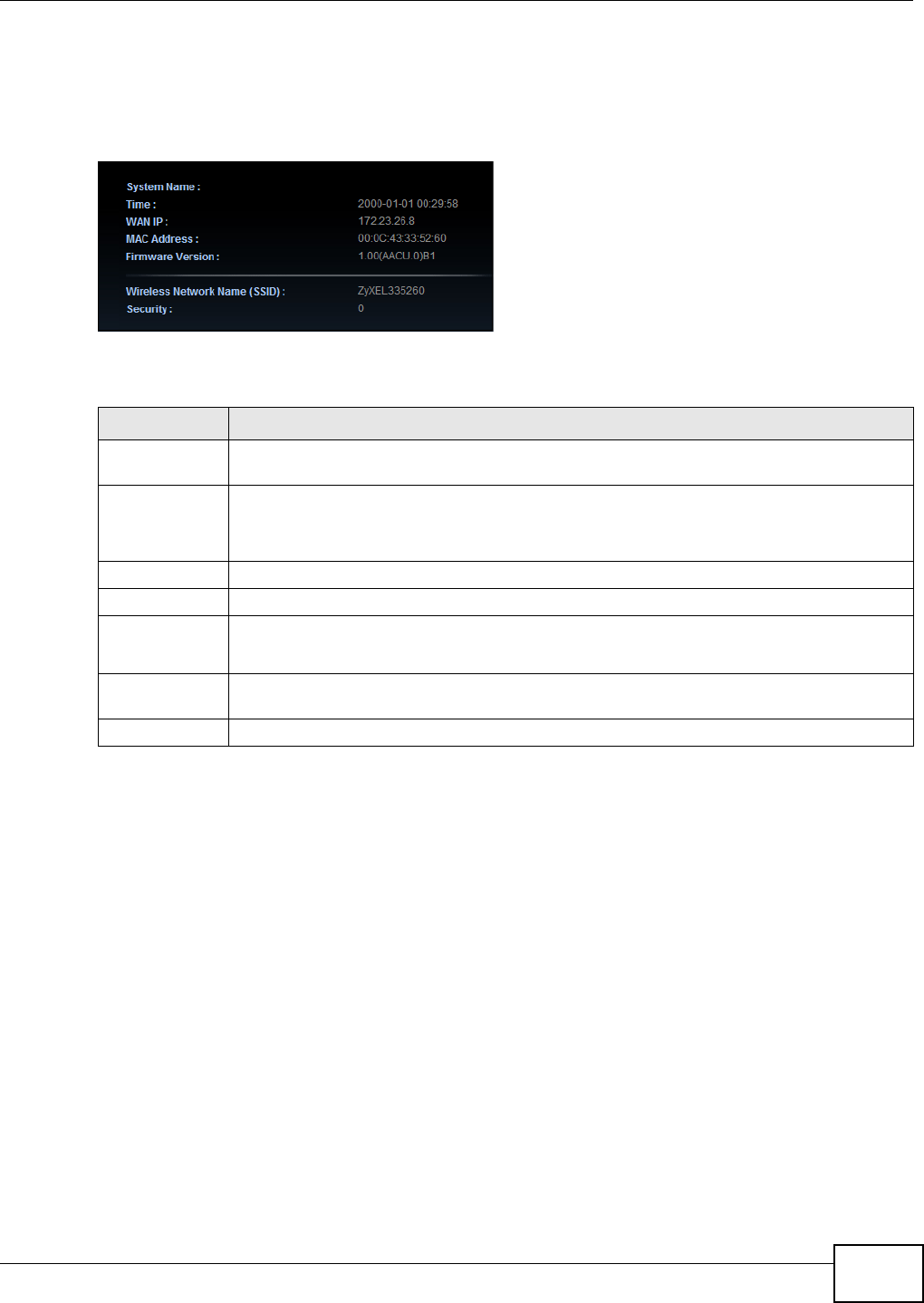
Chapter 8 Easy Mode
NBG-419N v2 User’s Guide 63
8.7 Status Screen in Easy Mode
In the Network Map screen, click Status to view read-only information about the Router.
Figure 44 Status Screen in Easy Mode
The following table describes the labels in this screen.
Table 27 Status Screen in Easy Mode
ITEM DESCRIPTION
Name This is the name of the Router in the network. You can change this in the Maintenance >
General screen in Section 26.3 on page 181.
Time This is the current system date and time.
The date is in YYYY:MM:DD (Year-Month-Day) format. The time is in HH:MM:SS
(Hour:Minutes:Seconds) format.
WAN IP This is the IP address of the WAN port.
MAC Address This is the MAC address of the Router.
Firmware
Version
This shows the firmware version of the Router.
The firmware version format shows the trunk version, model code and release number.
Wireless
Network Name
This shows the SSID of the wireless network. You can configure this in the Wireless Security
screen (Section 8.6.6 on page 60; Section 13.3.1.1 on page 104).
Security This shows the wireless security used by the Router.
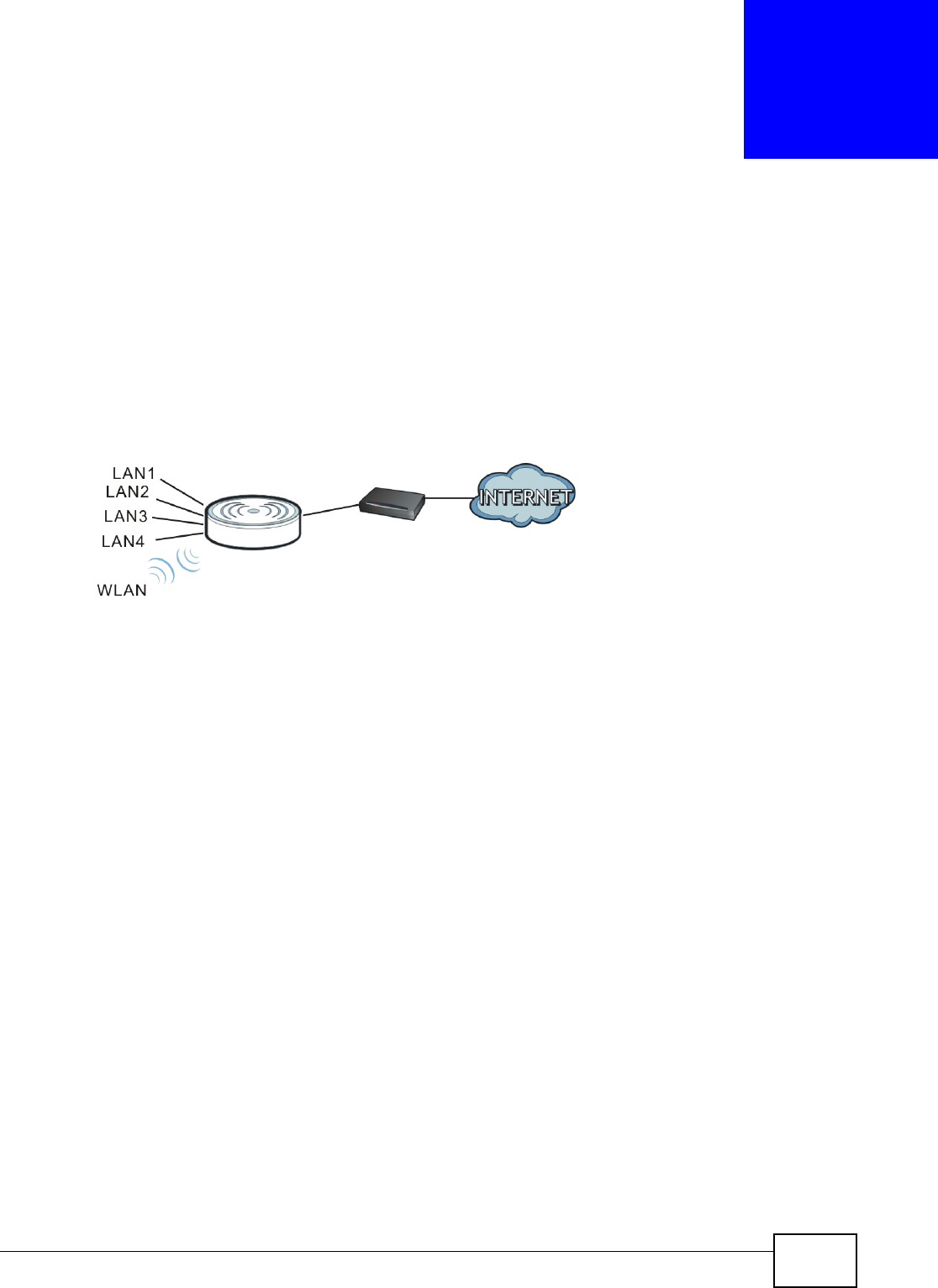
NBG-419N v2 User’s Guide 64
CHAPTER 9
Router Mode
9.1 Overview
The Router is set to router mode by default. Routers are used to connect the local network to
another network (for example, the Internet). In the figure below, the Router connects the local
network (LAN1 ~ LAN4) to the Internet.
Figure 45 Router Network
Note: The Status screen is shown after changing to the Expert mode of the Web
Configurator. It varies depending on the device mode of your Router.
9.2 What You Can Do
Use the Status screen (Section 9.3 on page 65) to view read-only information about your Router.
Modem
Router
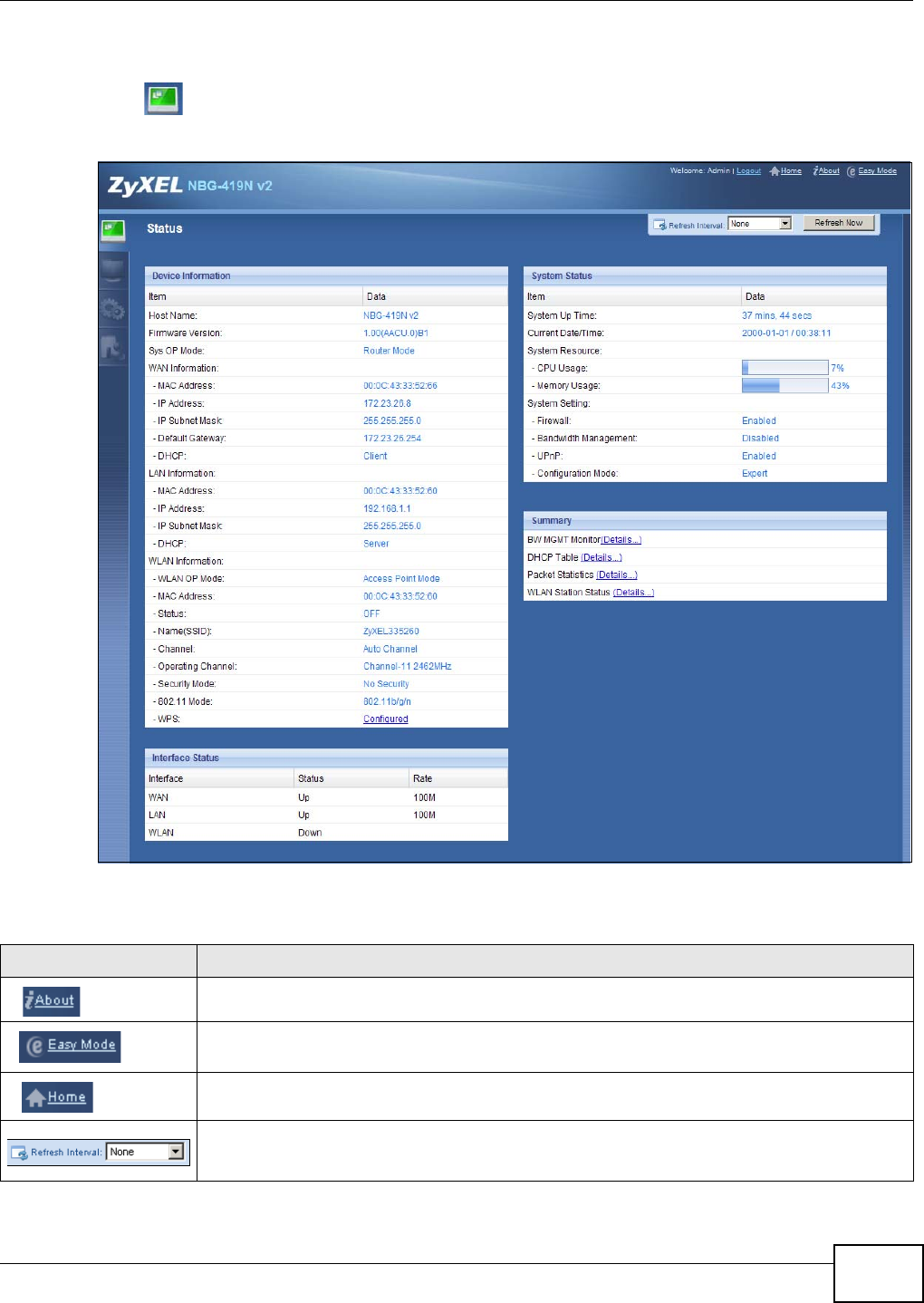
Chapter 9 Router Mode
NBG-419N v2 User’s Guide 65
9.3 Status Screen
Click to open the status screen.
Figure 46 Status Screen: Router Mode
The following table describes the icons shown in the Status screen.
Table 28 Status Screen Icon Key: Router Mode
ICON DESCRIPTION
Click this icon to view copyright and a link for related product information.
Click this icon to go to Easy Mode. See Chapter 8 on page 53.
Click this to go to the Home page. See Chapter 6 on page 45.
Select a number of seconds or None from the drop-down list box to refresh all screen statistics
automatically at the end of every time interval or to not refresh the screen statistics.
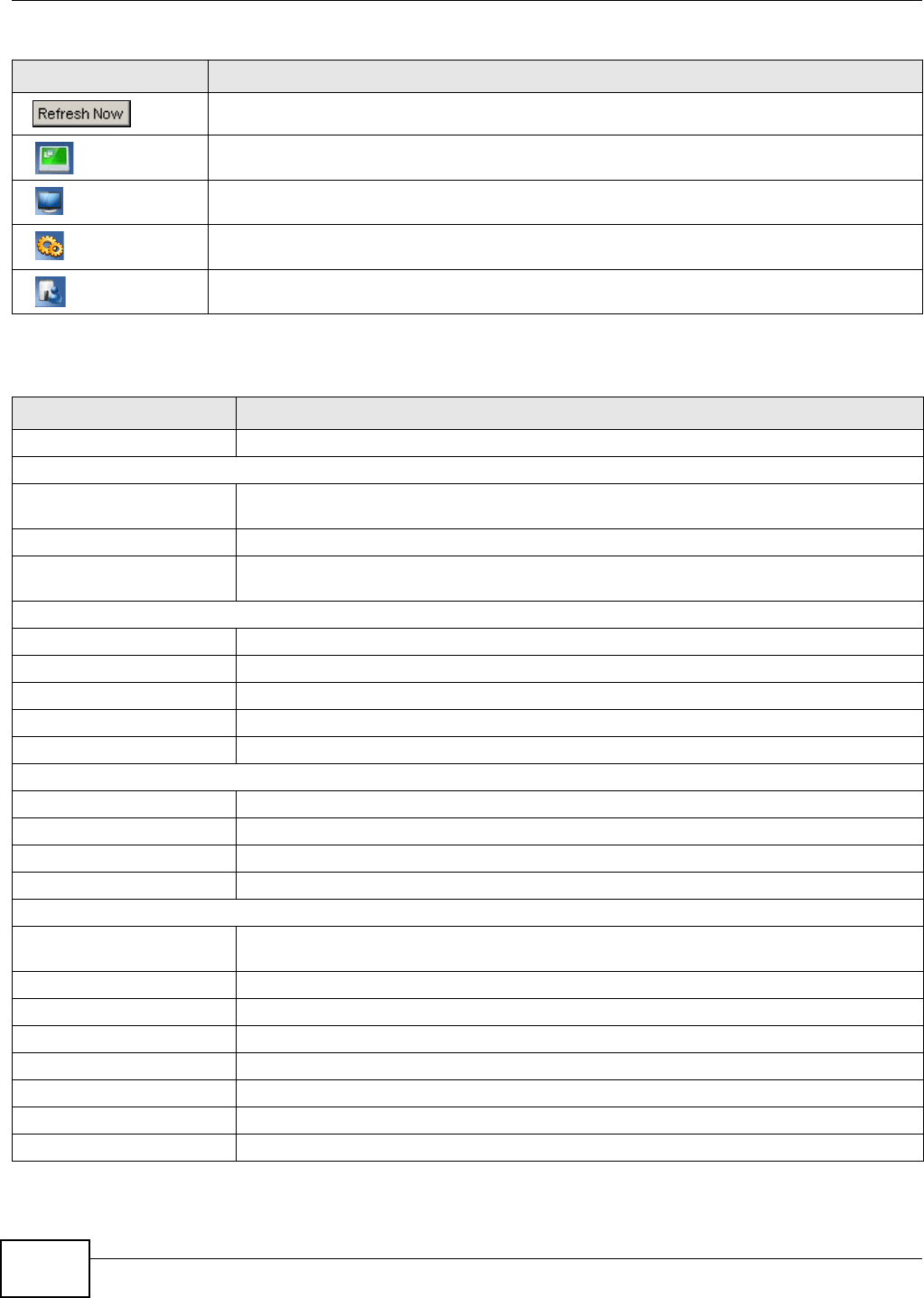
Chapter 9 Router Mode
NBG-419N v2 User’s Guide
66
The following table describes the labels shown in the Status screen.
Click this button to refresh the status screen statistics.
Click this icon to see the Status page. The information in this screen depends on the device
mode you select.
Click this icon to see the Monitor navigation menu.
Click this icon to see the Configuration navigation menu.
Click this icon to see the Maintenance navigation menu.
Table 28 Status Screen Icon Key: Router Mode (continued)
ICON DESCRIPTION
Table 29 Status Screen: Router Mode
LABEL DESCRIPTION
Logout Click this at any time to exit the Web Configurator.
Device Information
Host Name This is the System Name you enter in the Maintenance > General screen. It is for
identification purposes.
Firmware Version This is the firmware version and the date created.
Sys OP Mode This is the device mode (Section 7.1.2 on page 51) to which the Router is set - Router
Mode.
WAN Information
- MAC Address This shows the WAN Ethernet adapter MAC Address of your device.
- IP Address This shows the WAN port’s IP address.
- IP Subnet Mask This shows the WAN port’s subnet mask.
- Default Gateway This shows the WAN port’s gateway IP address.
- DHCP This shows the LAN port’s DHCP role - Client or Server.
LAN Information
- MAC Address This shows the LAN Ethernet adapter MAC Address of your device.
- IP Address This shows the LAN port’s IP address.
- IP Subnet Mask This shows the LAN port’s subnet mask.
- DHCP This shows the LAN port’s DHCP role - Server or None.
WLAN Information
- WLAN OP Mode This is the device mode (Section 7.1.2 on page 51) to which the Router’s wireless LAN is set
- Access Point Mode.
- MAC Address This shows the wireless adapter MAC Address of your device.
- Status This shows the current status of the Wireless LAN - ON or OFF.
- Name (SSID) This shows a descriptive name used to identify the Router in the wireless LAN.
- Channel This shows the channel number which you select manually.
- Operating Channel This shows the channel number which the Router is currently using over the wireless LAN.
- Security Mode This shows the level of wireless security the Router is using.
- 802.11 Mode This shows the wireless standard.

Chapter 9 Router Mode
NBG-419N v2 User’s Guide 67
- WPS This displays Configured when the WPS has been set up.
This displays Unconfigured if the WPS has not been set up.
Click the status to display Network > Wireless LAN > WPS screen.
System Status
Item This column shows the type of data the Router is recording.
Data This column shows the actual data recorded by the Router.
System Up Time This is the total time the Router has been on.
Current Date/Time This field displays your Router’s present date and time.
System Resource
- CPU Usage This displays what percentage of the Router’s processing ability is currently used. When this
percentage is close to 100%, the Router is running at full load, and the throughput is not
going to improve anymore. If you want some applications to have more throughput, you
should turn off other applications (for example, using bandwidth management.)
- Memory Usage This shows what percentage of the heap memory the Router is using.
System Setting
- Firewall This shows whether the firewall is enabled or not.
- Bandwidth
Management This shows whether the bandwidth management is enabled or not.
- UPnP This shows whether UPnP is enabled or not.
- Configuration Mode This shows the web configurator mode you are viewing - Expert.
Interface Status
Interface This displays the Router port types. The port types are: WAN, LAN and WLAN.
Status For the LAN and WAN ports, this field displays Down (line is down) or Up (line is up or
connected).
For the WLAN, it displays Up when the WLAN is enabled or Down when the WLAN is
disabled.
Rate For the LAN ports, this displays the port speed and duplex setting or N/A when the line is
disconnected.
For the WAN port, it displays the port speed and duplex setting if you’re using Ethernet
encapsulation and Idle (line (ppp) idle), Dial (starting to trigger a call) and Drop (dropping
a call) if you're using PPPoE or PPTP encapsulation. This field displays N/A when the line is
disconnected.
For the WLAN, it displays the maximum transmission rate when the WLAN is enabled and N/
A when the WLAN is disabled.
Summary
BW MGMT Monitor Click Details... to go to the Monitor > BW MGMT Monitor screen (Section 6.4 on page
47). Use this screen to view the amount of network bandwidth that applications running in
the network are using.
DHCP Table Click Details... to go to the Monitor > DHCP Table screen (Section 6.5 on page 47). Use
this screen to view current DHCP client information.
Packet Statistics Click Details... to go to the Monitor > Packet Statistics screen (Section 6.6 on page 48).
Use this screen to view port status and packet specific statistics.
WLAN Station Status Click Details... to go to the Monitor > WLAN Station Status screen (Section 6.7 on page
49). Use this screen to view the wireless stations that are currently associated to the Router.
Table 29 Status Screen: Router Mode (continued)
LABEL DESCRIPTION
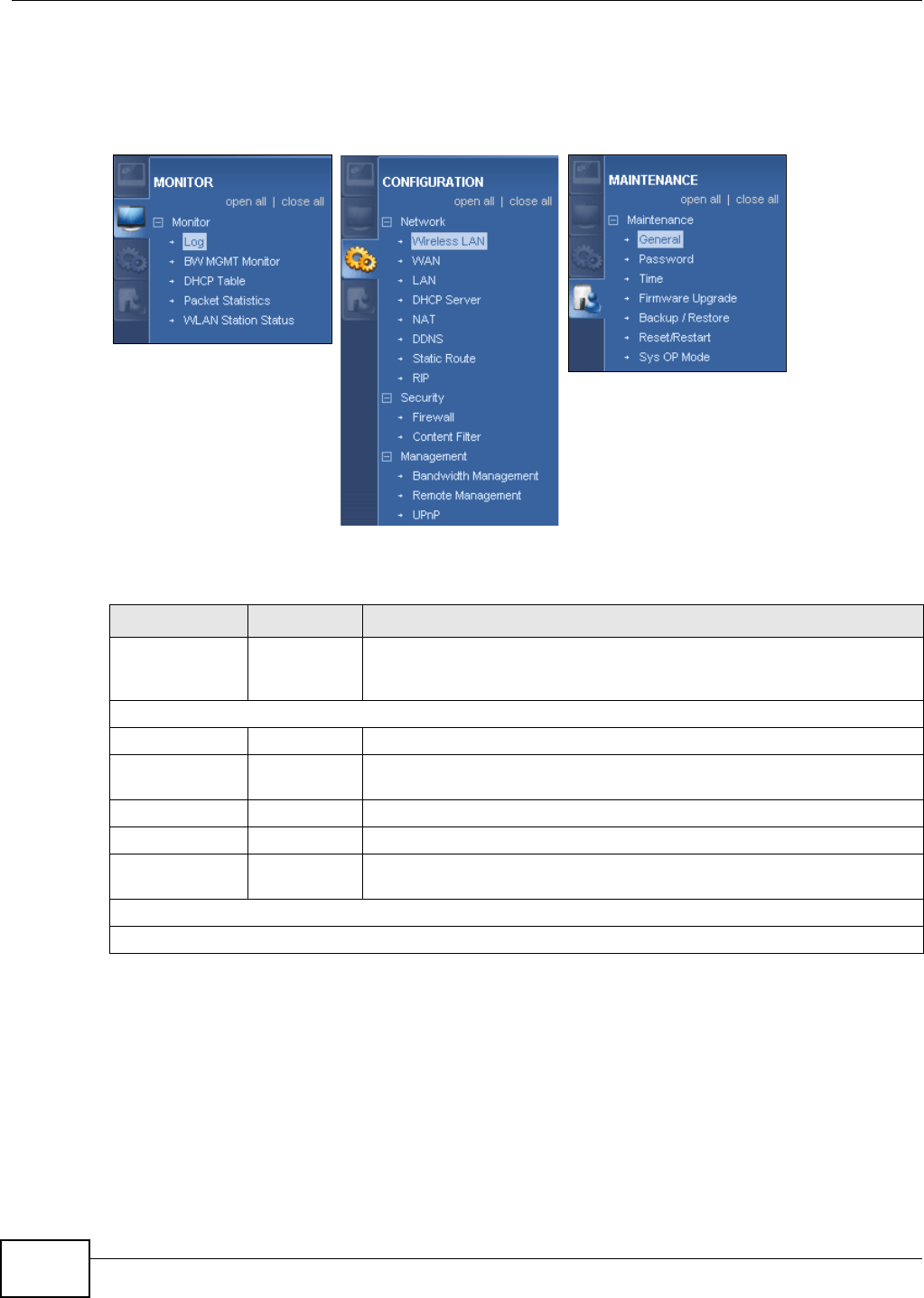
Chapter 9 Router Mode
NBG-419N v2 User’s Guide
68
9.3.1 Navigation Panel
Use the sub-menus on the navigation panel to configure Router features.
Figure 47 Navigation Panel: Router Mode
The following table describes the sub-menus.
Table 30 Navigation Panel: Router Mode
LINK TAB FUNCTION
Status This screen shows the Router’s general device, system and interface status
information. Use this screen to access the wizard, and summary statistics
tables.
MONITOR
Log Use this screen to view the list of activities recorded by your Router.
BW MGMT Use this screen to view the amount of network bandwidth that applications
running in the network are using.
DHCP Table Use this screen to view current DHCP client information.
Packet Statistics Use this screen to view port status and packet specific statistics.
WLAN Station
Status
Use this screen to view the wireless stations that are currently associated
to the Router.
CONFIGURATION
Network

Chapter 9 Router Mode
NBG-419N v2 User’s Guide 69
Wireless LAN General Use this screen to configure wireless LAN.
MAC Filter Use the MAC filter screen to configure the Router to block access to devices
or block the devices from accessing the Router.
Advanced This screen allows you to configure advanced wireless settings.
QoS Use this screen to configure Wi-Fi Multimedia Quality of Service (WMM
QoS). WMM QoS allows you to prioritize wireless traffic according to the
delivery requirements of individual services.
WPS Use this screen to configure WPS.
WPS Station Use this screen to add a wireless station using WPS.
Scheduling Use this screen to schedule the times the Wireless LAN is enabled.
WDS Use this screen to set up Wireless Distribution System (WDS) on your
Router.
WAN Internet
Connection
This screen allows you to configure ISP parameters, WAN IP address
assignment, DNS servers and the WAN MAC address.
Advanced Use this screen to configure other advanced properties.
IGMP
Snooping
Use this screen to enable IGMP snooping if you have LAN users that
subscribe to multicast services.
LAN IP Use this screen to configure LAN IP address and subnet mask.
IP Alias Use this screen to have the Router apply IP alias to create LAN subnets.
DHCP Server General Use this screen to enable the Router’s DHCP server.
Advanced Use this screen to assign IP addresses to specific individual computers
based on their MAC addresses and to have DNS servers assigned by the
DHCP server.
NAT General Use this screen to enable NAT.
Application Use this screen to configure servers behind the Router.
Advanced Use this screen to change your Router’s port triggering settings.
DDNS General Use this screen to set up dynamic DNS.
Static Route IP Static
Route
Use this screen to configure IP static routes.
RIP Use this screen to enable RIPv1 or RIPv2, which are LAN broadcast
protocols.
Security
Firewall General Use this screen to activate/deactivate the firewall.
Services This screen shows a summary of the firewall rules, and allows you to edit/
add a firewall rule.
Content Filter Use this screen to block certain web features and sites containing certain
keywords in the URL.
Management
Bandwidth
Management General Use this screen to enable bandwidth management.
Advanced Use this screen to set the upstream bandwidth and edit a bandwidth
management rule.
Monitor Use this screen to view the amount of network bandwidth that applications
running in the network are using.
Remote
Management WWW Use this screen to be able to access the Router from the LAN, WAN or both.
UPnP General Use this screen to enable UPnP on the Router.
Table 30 Navigation Panel: Router Mode (continued)
LINK TAB FUNCTION

Chapter 9 Router Mode
NBG-419N v2 User’s Guide
70
MAINTENANCE
General Use this screen to view and change administrative settings such as system
and domain names.
Password Password
Setup
Use this screen to change the password of your Router.
Time Time Setting Use this screen to change your Router’s time and date.
Remote
Management WWW Use this screen to configure through which interface(s) and from which IP
address(es) users can use HTTP to manage the Router.
Firmware
Upgrade Use this screen to upload firmware to your Router.
Backup/
Restore Use this screen to backup and restore the configuration or reset the factory
defaults to your Router.
Reset/
Restart Restart This screen allows you to reboot the Router without turning the power off.
Sys OP Mode This screen allows you to select whether your device acts as a Router or a
Access Point.
Table 30 Navigation Panel: Router Mode (continued)
LINK TAB FUNCTION
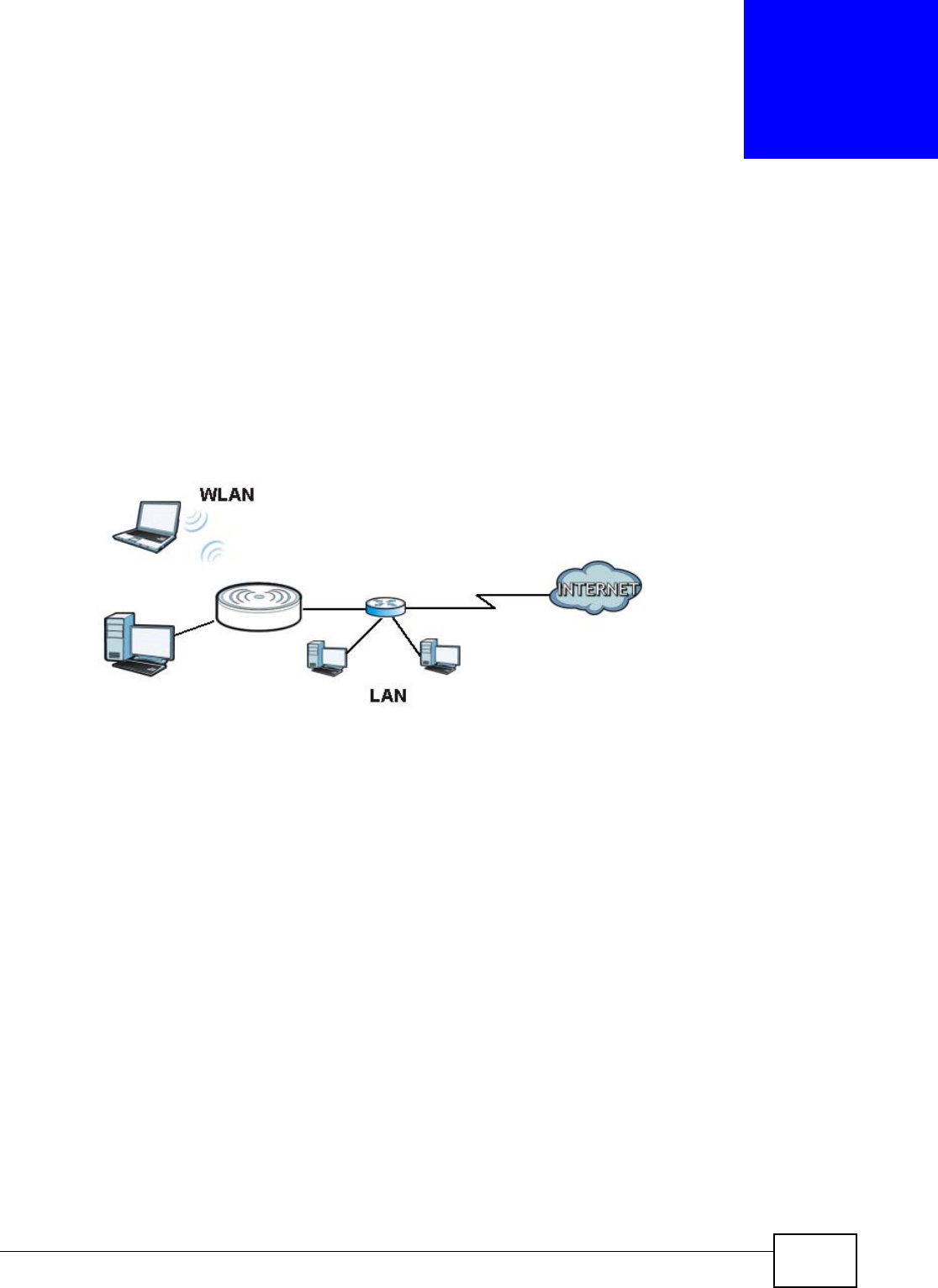
NBG-419N v2 User’s Guide 71
CHAPTER 10
Access Point Mode
10.1 Overview
Use your Router as an access point (AP) if you already have a router or gateway on your network.
In this mode your Router bridges a wired network (LAN) and wireless LAN (WLAN) in the same
subnet. See the figure below for an example.
Figure 48 Wireless Internet Access in Access Point Mode
Many screens that are available in Router mode are not available in Access Point mode, such as
bandwidth management and firewall.
Note: See Chapter 12 on page 89 for an example of setting up a wireless network in
Access Point mode.
10.2 What You Can Do
•Use the Status screen (Section 10.4 on page 74) to view read-only information about your
Router.
•Use the LAN screen (Section 10.5 on page 76) to set the IP address for your Router acting as an
access point.
10.3 What You Need to Know
See Chapter 12 on page 89 for a tutorial on setting up a network with the Router as an access
point.
Router
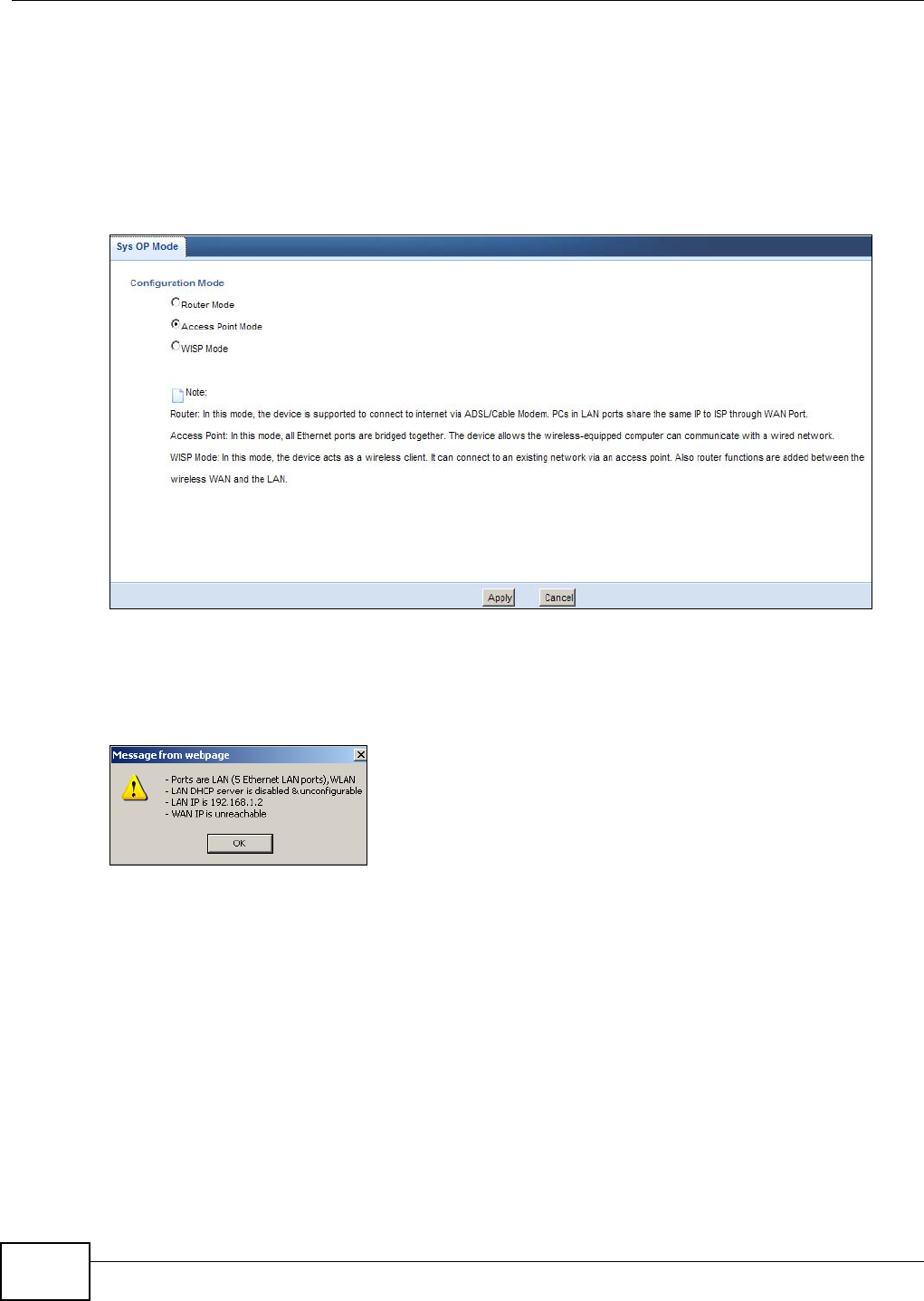
Chapter 10 Access Point Mode
NBG-419N v2 User’s Guide
72
10.3.1 Setting your Router to AP Mode
1Log into the Web Configurator if you haven’t already. See the Quick start Guide for instructions on
how to do this.
2To use your Router as an access point, go to Maintenance > Sys OP Mode > General and select
Access Point mode.
Figure 49 Changing to Access Point mode
Note: You have to log in to the Web Configurator again when you change modes. As soon
as you do, your Router is already in Access Point mode.
3When you select Access Point Mode, the following pop-up message window appears.
Figure 50 Pop up for Access Point mode
Click OK. The Web Configurator refreshes once the change to Access Point mode is successful.
10.3.2 Accessing the Web Configurator in Access Point Mode
Log in to the Web Configurator in Access Point mode, do the following:
1Connect your computer to the LAN port of the Router.
2The default IP address of the Router is “192.168.1.2”. In this case, your computer must have an IP
address in the range between “192.168.1.3” and “192.168.1.254”.
3Click Start > Run on your computer in Windows. Type “cmd” in the dialog box. Enter “ipconfig” to
show your computer’s IP address. If your computer’s IP address is not in the correct range then see
Appendix C on page 221 for information on changing your computer’s IP address.

Chapter 10 Access Point Mode
NBG-419N v2 User’s Guide 73
4After you’ve set your computer’s IP address, open a web browser such as Internet Explorer and
type “192.168.1.2” as the web address in your web browser.
Note: After clicking Login, the Easy mode appears. Refer to page 53 for the Easy mode
screens. Change to Expert mode to see the screens described in the sections
following this.
10.3.3 Configuring your WLAN, Bandwidth Management and Maintenance
Settings
The configuration of wireless, bandwidth management and maintenance settings in Access Point
mode is the same as for Router Mode.
•See Chapter 13 on page 103 for information on the configuring your wireless network.
•See Chapter 23 on page 163 for information on configuring your Bandwidth Management screen.
•See Chapter 26 on page 181 to Chapter 26 on page 181 for information on configuring your
Maintenance settings.
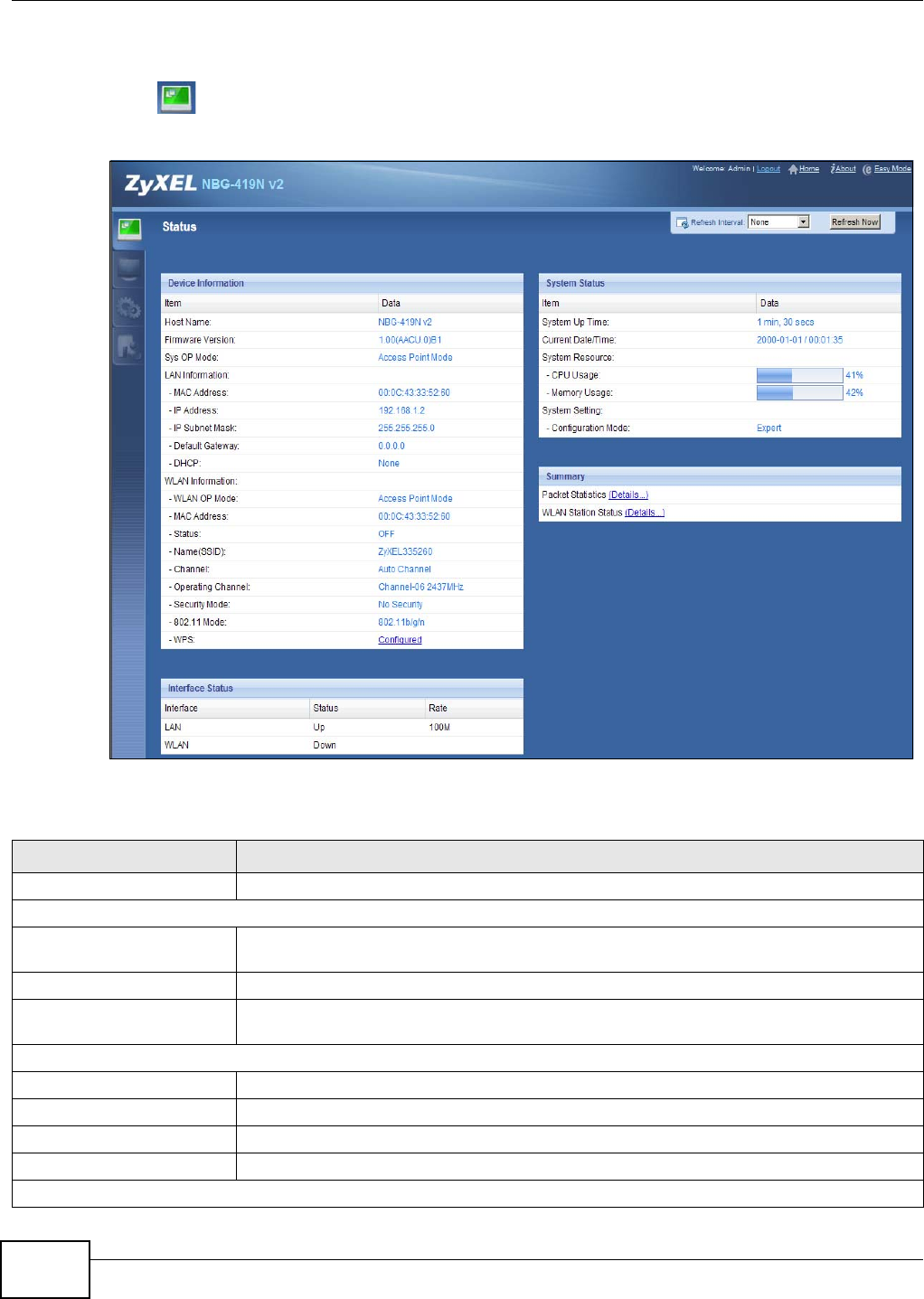
Chapter 10 Access Point Mode
NBG-419N v2 User’s Guide
74
10.4 AP Mode Status Screen
Click to open the Status screen.
Figure 51 Status Screen: Access Point Mode
The following table describes the labels shown in the Status screen.
Table 31 Status Screen: Access Point Mode
LABEL DESCRIPTION
Logout Click this at any time to exit the Web Configurator.
Device Information
Host Name This is the System Name you enter in the Maintenance > General screen. It is for
identification purposes.
Firmware Version This is the firmware version and the date created.
Sys OP Mode This is the device mode (Section 7.1.2 on page 51) to which the Router is set - Access
Point Mode.
LAN Information
- MAC Address This shows the LAN Ethernet adapter MAC Address of your device.
- IP Address This shows the LAN port’s IP address.
- IP Subnet Mask This shows the LAN port’s subnet mask.
- DHCP This shows the LAN port’s DHCP role - Server, Client or None.
WLAN Information

Chapter 10 Access Point Mode
NBG-419N v2 User’s Guide 75
- WLAN OP Mode This is the device mode (Section 7.1.2 on page 51) to which the Router’s wireless LAN is set
- Access Point Mode.
- MAC Address This shows the wireless adapter MAC Address of your device.
- Status This shows the current status of the Wireless LAN - ON or OFF.
- Name (SSID) This shows a descriptive name used to identify the Router in the wireless LAN.
- Channel This shows the channel number which you select manually.
- Operating Channel This shows the channel number which the Router is currently using over the wireless LAN.
- Security Mode This shows the level of wireless security the Router is using.
- 802.11 Mode This shows the wireless standard.
- WPS This displays Configured when the WPS has been set up.
This displays Unconfigured if the WPS has not been set up.
Click the status to display Network > Wireless LAN > WPS screen.
System Status
Item This column shows the type of data the Router is recording.
Data This column shows the actual data recorded by the Router.
System Up Time This is the total time the Router has been on.
Current Date/Time This field displays your Router’s present date and time.
System Resource
- CPU Usage This displays what percentage of the Router’s processing ability is currently used. When this
percentage is close to 100%, the Router is running at full load, and the throughput is not
going to improve anymore. If you want some applications to have more throughput, you
should turn off other applications (for example, using bandwidth management.
- Memory Usage This shows what percentage of the heap memory the Router is using.
System Setting
- Configuration Mode This shows the web configurator mode you are viewing - Expert.
Interface Status
Interface This displays the Router port types. The port types are: LAN and WLAN.
Status For the LAN and WAN ports, this field displays Down (line is down) or Up (line is up or
connected).
For the WLAN, it displays Up when the WLAN is enabled or Down when the WLAN is
disabled.
Rate For the LAN ports, this displays the port speed and duplex setting or N/A when the line is
disconnected.
For the WAN port, it displays the port speed and duplex setting if you’re using Ethernet
encapsulation and Idle (line (ppp) idle), Dial (starting to trigger a call) and Drop (dropping
a call) if you're using PPPoE or PPTP encapsulation. This field displays N/A when the line is
disconnected.
For the WLAN, it displays the maximum transmission rate when the WLAN is enabled and N/
A when the WLAN is disabled.
Summary
Packet Statistics Click Details... to go to the Monitor > Packet Statistics screen (Section 6.6 on page 48).
Use this screen to view port status and packet specific statistics.
WLAN Station Status Click Details... to go to the Monitor > WLAN Station Status screen (Section 6.7 on page
49). Use this screen to view the wireless stations that are currently associated to the Router.
Table 31 Status Screen: Access Point Mode (continued)
LABEL DESCRIPTION
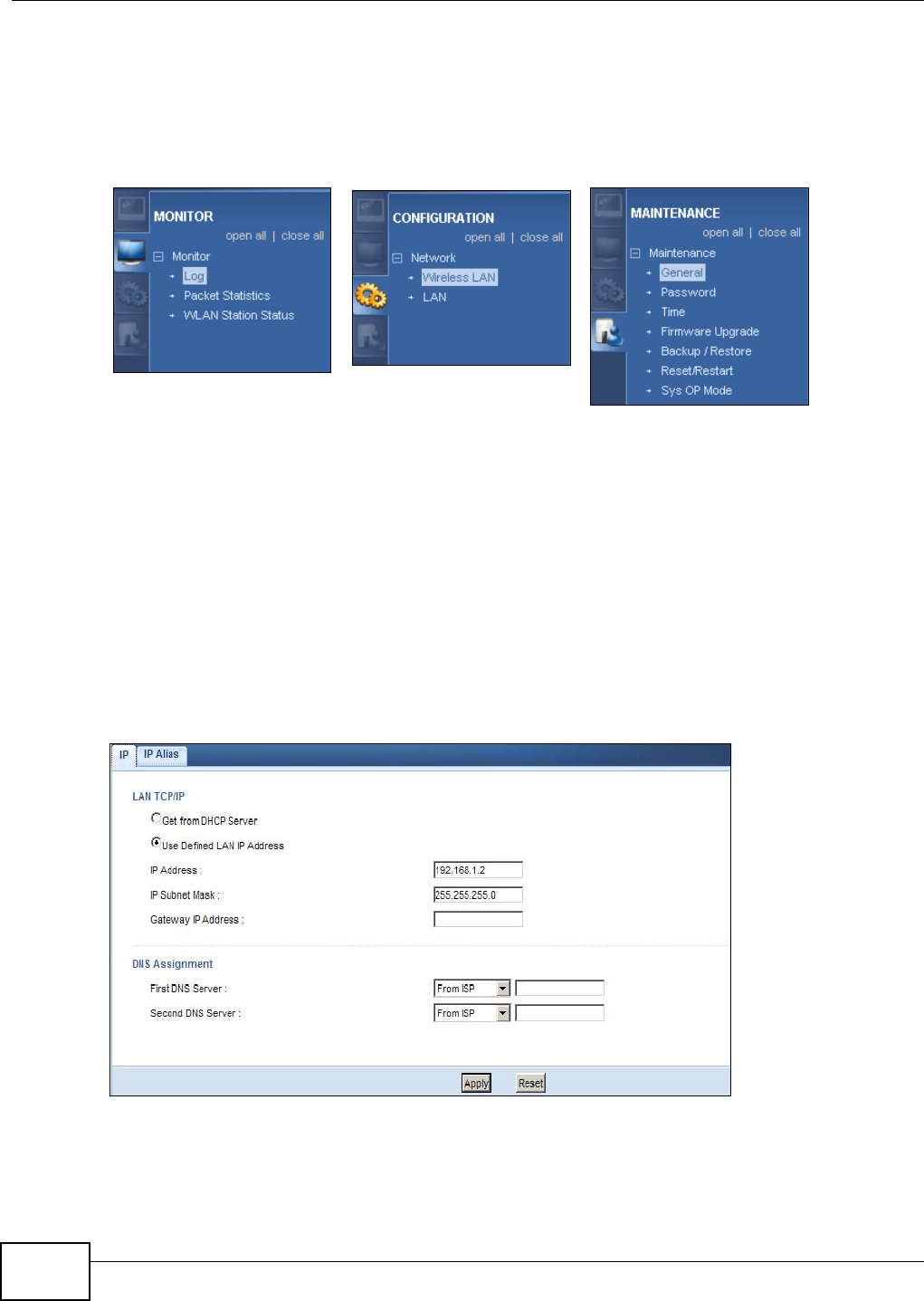
Chapter 10 Access Point Mode
NBG-419N v2 User’s Guide
76
10.4.0.1 Navigation Panel
Use the menu in the navigation panel to configure Router features in Access Point mode.
The following screen and table show the features you can configure in Access Point mode.
Figure 52 Menu: Access Point Mode
Refer to Table 30 on page 68 for descriptions of the labels shown in the Navigation panel.
10.5 LAN Screen
Use this section to configure your LAN settings while in Access Point mode.
Click Network > LAN to see the screen below.
Note: If you change the IP address of the Router in the screen below, you will need to log
into the Router again using the new IP address.
Figure 53 Network > LAN > IP
The table below describes the labels in the screen.

Chapter 10 Access Point Mode
NBG-419N v2 User’s Guide 77
Table 32 Network > LAN > IP
LABEL DESCRIPTION
Get from DHCP
Server
Click this to deploy the Router as an access point in the network.
When you enable this, the Router gets its IP address from the network’s DHCP server (for
example, your ISP). Users connected to the Router can now access the network (i.e., the
Internet if the IP address is given by the ISP).
The Web Configurator may no longer be accessible unless you know the IP address assigned
by the DHCP server to the Router. You need to reset the Router to be able to access the Web
Configurator again (see Section 26.7 on page 186 for details on how to reset the Router).
Also when you select this, you cannot enter an IP address for your Router in the field below.
Use Defined
LAN IP Address
Click this if you want to specify the IP address of your Router. Or if your ISP or network
administrator gave you a static IP address to access the network or the Internet.
IP Address Type the IP address in dotted decimal notation. The default setting is 192.168.1.2. If you
change the IP address you will have to log in again with the new IP address.
IP Subnet Mask The subnet mask specifies the network number portion of an IP address. Your Router will
automatically calculate the subnet mask based on the IP address that you assign. Unless
you are implementing subnetting, use the subnet mask computed by the Router.
Gateway IP
Address
Enter a Gateway IP Address (if your ISP or network administrator gave you one) in this
field.
DNS Assignment
First DNS
Server
Second DNS
Server
Select From ISP if your ISP dynamically assigns DNS server information (and the Router's
WAN IP address). The field to the right displays the (read-only) DNS server IP address that
the ISP assigns.
Select User-Defined if you have the IP address of a DNS server. Enter the DNS server's IP
address in the field to the right. If you chose User-Defined, but leave the IP address set to
0.0.0.0, User-Defined changes to None after you click Apply. If you set a second choice to
User-Defined, and enter the same IP address, the second User-Defined changes to None
after you click Apply.
Select None if you do not want to configure DNS servers. If you do not configure a DNS
server, you must know the IP address of a computer in order to access it.
Apply Click Apply to save your changes to the Router.
Reset Click Reset to reload the previous configuration for this screen.
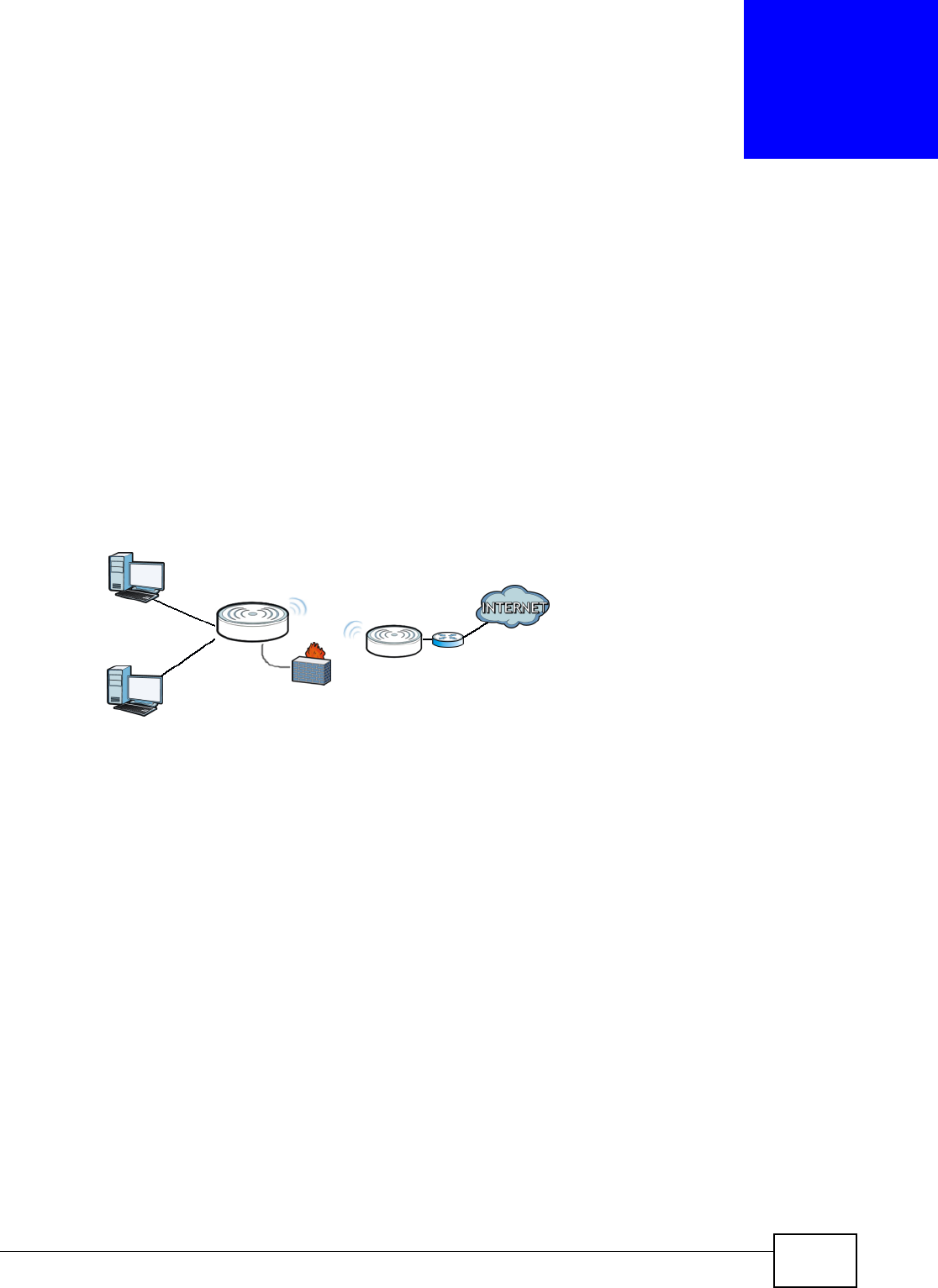
NBG-419N v2 User’s Guide 78
CHAPTER 11
WISP Mode
11.1 Overview
Your Router can act as a wireless client. In wireless client mode, it can connect to an existing
network via an access point. Use this mode if you already have an access point or router in your
network.
In the example below, one Router (A) is configured as a wireless client and another is used as an
access point (B). The wireless client has two clients that need to connect to the Internet. The
Router wirelessly connects to the available access point (B).
Figure 54 Wireless Client Mode
After the Router and the access point connect, the Router acquires its WAN IP address from the
access point. The clients of the Router can now surf the Internet.
11.2 What You Can Do
•Use the Status screen (Section 11.4 on page 80) to view read-only information about your
Router.
•Use the LAN screen (Chapter 15 on page 133) to set the IP address for your Router acting as an
access point.
•Use the Wireless LAN screen (Section 11.5 on page 82) to associate your Router (acting as a
wireless client) with an existing access point.
11.3 What You Need to Know
With the exception of the LAN screen, the Monitor, Configuration and Maintainance screens in
WISP mode are similar to the ones in Router Mode. See Chapter 13 on page 103 through Chapter
26 on page 189 of this User’s Guide.
built-in
firewall
Access
Point
WISP
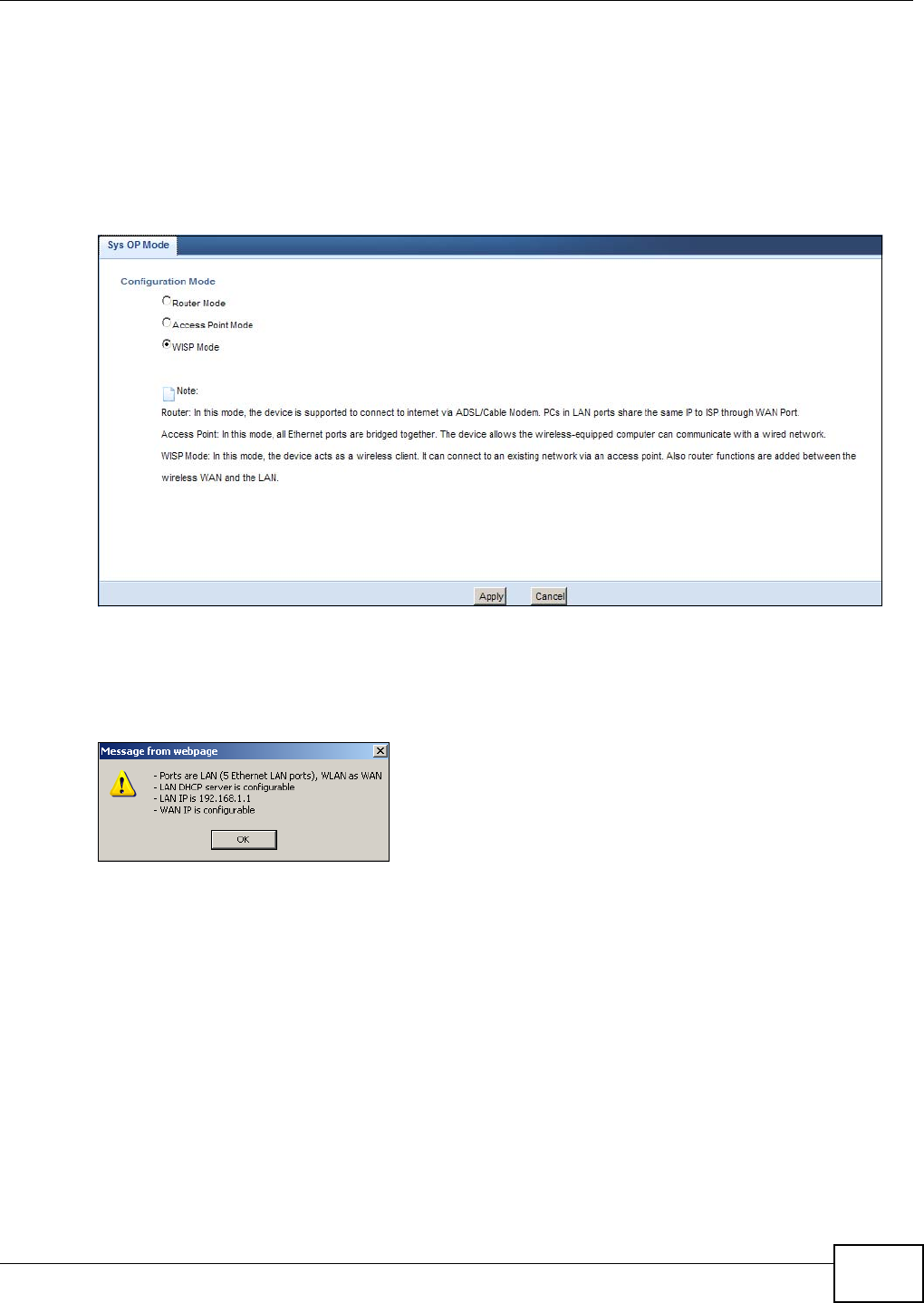
Chapter 11 WISP Mode
NBG-419N v2 User’s Guide 79
11.3.1 Setting your Router to WISP Mode
1Log into the Web Configurator if you haven’t already. See the Quick start Guide for instructions on
how to do this.
2To set your Router to AP Mode, go to Maintenance > Sys OP Mode > General and select WISP
Mode.
Figure 55 Changing to WISP mode
Note: You have to log in to the Web Configurator again when you change modes.As soon
as you do, your Router is already in WISP mode.
3When you select WISP Mode, the following pop-up message window appears.
Figure 56 Pop up window for WISP mode
Click OK. The Web Configurator refreshes once the change to WISP mode is successful.
11.3.2 Accessing the Web Configurator in WISP Mode
To login to Web Configurator in WISP mode, do the following:
1Connect your computer to the LAN port of the Router.
2The default IP address of the Router is “192.168.1.1”. If you did not change this, you can use the
same IP address in WISP mode. Open a web browser such as Internet Explorer and type
“192.168.1.1” as the web address in your web browser.
If you changed the IP address of your Router while in Router Mode, use this IP address in WISP
mode. The WISP mode IP address is always the same as the Router mode IP adderss.
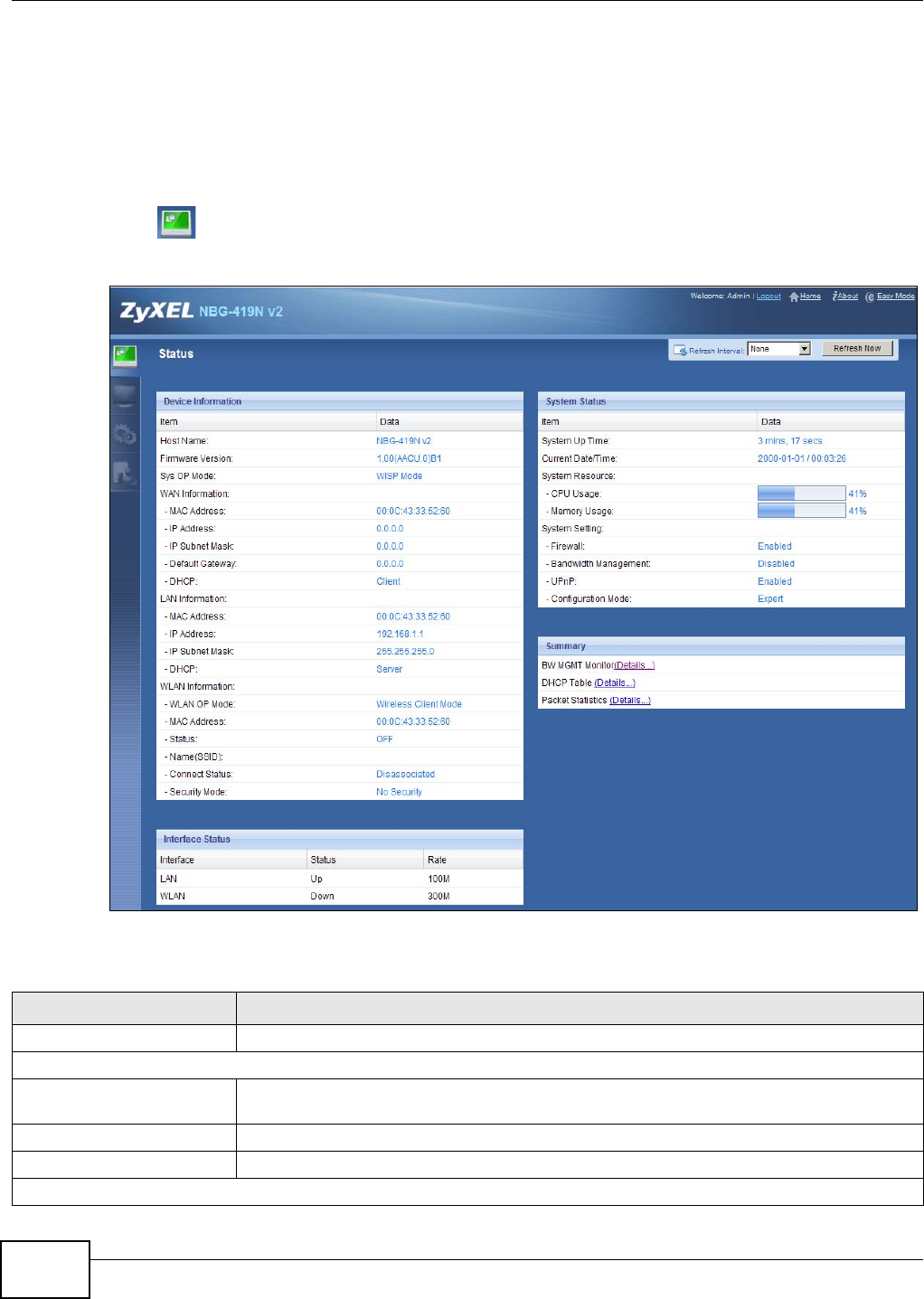
Chapter 11 WISP Mode
NBG-419N v2 User’s Guide
80
Note: After clicking Login, the Easy mode appears. Refer to Section on page 53 for the
Easy mode screens. Click Expert mode to see the screens described in the sections
following this.
11.4 WISP Mode Status Screen
Click to open the status screen.
Figure 57 Status: WISP Mode
The following table describes the labels shown in the Status screen.
Table 33 Status Screen: WISP Mode
LABEL DESCRIPTION
Logout Click this at any time to exit the Web Configurator.
Device Information
Host Name This is the System Name you enter in the Maintenance > General screen. It is for
identification purposes.
Firmware Version This is the firmware version and the date created.
Sys OP Mode This is the device mode (Section 7.1.2 on page 51) to which the Router is set - WISP Mode.
WAN Information

Chapter 11 WISP Mode
NBG-419N v2 User’s Guide 81
- MAC Address This shows the WAN Ethernet adapter MAC Address of your device.
- IP Address This shows the WAN port’s IP address.
- IP Subnet Mask This shows the WAN port’s subnet mask.
- Default Gateway This shows the WAN port’s gateway IP address.
- DHCP This shows the LAN port’s DHCP role - Client or Server.
LAN Information
- MAC Address This shows the LAN Ethernet adapter MAC Address of your device.
- IP Address This shows the LAN port’s IP address.
- IP Subnet Mask This shows the LAN port’s subnet mask.
- DHCP This shows the LAN port’s DHCP role - Server or None.
WLAN Information
- WLAN OP Mode This is the device mode (Section 7.1.2 on page 51) to which the Router’s wireless LAN is set
- Access Point Mode.
- MAC Address This shows the wireless adapter MAC Address of your device.
- Status This shows the current status of the Wireless LAN - ON or OFF.
- Name (SSID) This shows a descriptive name used to identify the Router in the wireless LAN.
- Connect Status This shows whether or not the Router has successfully associated with an access point -
Connected or Disassociated.
- Security Mode This shows the level of wireless security the Router is using.
- 802.11 Mode This shows the wireless standard.
System Status
Item This column shows the type of data the Router is recording.
Data This column shows the actual data recorded by the Router.
System Up Time This is the total time the Router has been on.
Current Date/Time This field displays your Router’s present date and time.
System Resource
- CPU Usage This displays what percentage of the Router’s processing ability is currently used. When this
percentage is close to 100%, the Router is running at full load, and the throughput is not
going to improve anymore. If you want some applications to have more throughput, you
should turn off other applications (for example, using bandwidth management.
- Memory Usage This shows what percentage of the heap memory the Router is using.
System Setting
- Firewall This shows whether the firewall is enabled or not.
- Bandwidth
Management This shows whether the bandwidth management is enabled or not.
- UPnP This shows whether UPnP is enabled or not.
- Configuration Mode This shows the web configurator mode you are viewing - Expert.
Interface Status
Interface This displays the Router port types. The port types are: LAN and WLAN.
Status For the LAN and WAN ports, this field displays Down (line is down) or Up (line is up or
connected).
For the WLAN, it displays Up when the WLAN is enabled or Down when the WLAN is
disabled.
Table 33 Status Screen: WISP Mode (continued)
LABEL DESCRIPTION
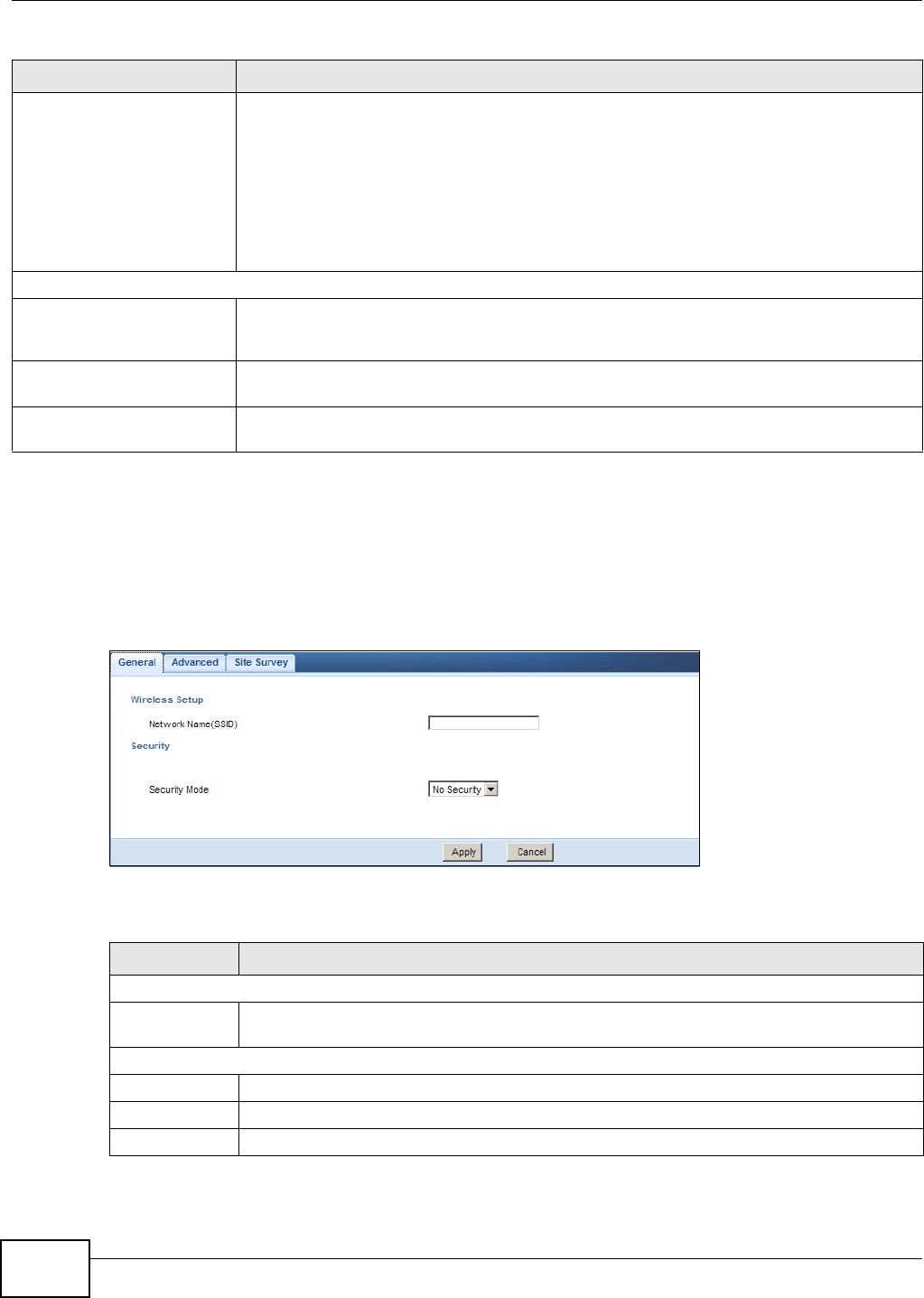
Chapter 11 WISP Mode
NBG-419N v2 User’s Guide
82
11.5 Wireless LAN General Screen
Use this screen to configure the wireless LAN settings of your Router. Go to Configuration >
Wireless LAN > General to open the following screen.
Figure 58 WISP Mode: LAN > General Screen
The following table describes the labels in this screen.
Rate For the LAN ports, this displays the port speed and duplex setting or N/A when the line is
disconnected.
For the WAN port, it displays the port speed and duplex setting if you’re using Ethernet
encapsulation and Idle (line (ppp) idle), Dial (starting to trigger a call) and Drop (dropping
a call) if you're using PPPoE or PPTP encapsulation. This field displays N/A when the line is
disconnected.
For the WLAN, it displays the maximum transmission rate when the WLAN is enabled and N/
A when the WLAN is disabled.
Summary
BW MGMT Monitor Click Details... to go to the Monitor > BW MGMT Monitor screen (Section 6.4 on page
47). Use this screen to view the amount of network bandwidth that applications running in
the network are using.
DHCP Table Click Details... to go to the Monitor > DHCP Table screen (Section 6.5 on page 47). Use
this screen to view current DHCP client information.
Packet Statistics Click Details... to go to the Monitor > Packet Statistics screen (Section 6.6 on page 48).
Use this screen to view port status and packet specific statistics.
Table 33 Status Screen: WISP Mode (continued)
LABEL DESCRIPTION
Table 34 WISP Mode: LAN > General Screen
LABEL DESCRIPTION
Wireless Setup
Network Name
(SSID)
Enter the name of the access point to which you are connecting.
Security
Security Mode Select the security mode of the access point to which you want to connect.
Apply Click Apply to save your changes back to the Router.
Reset Click Reset to reload the previous configuration for this screen.
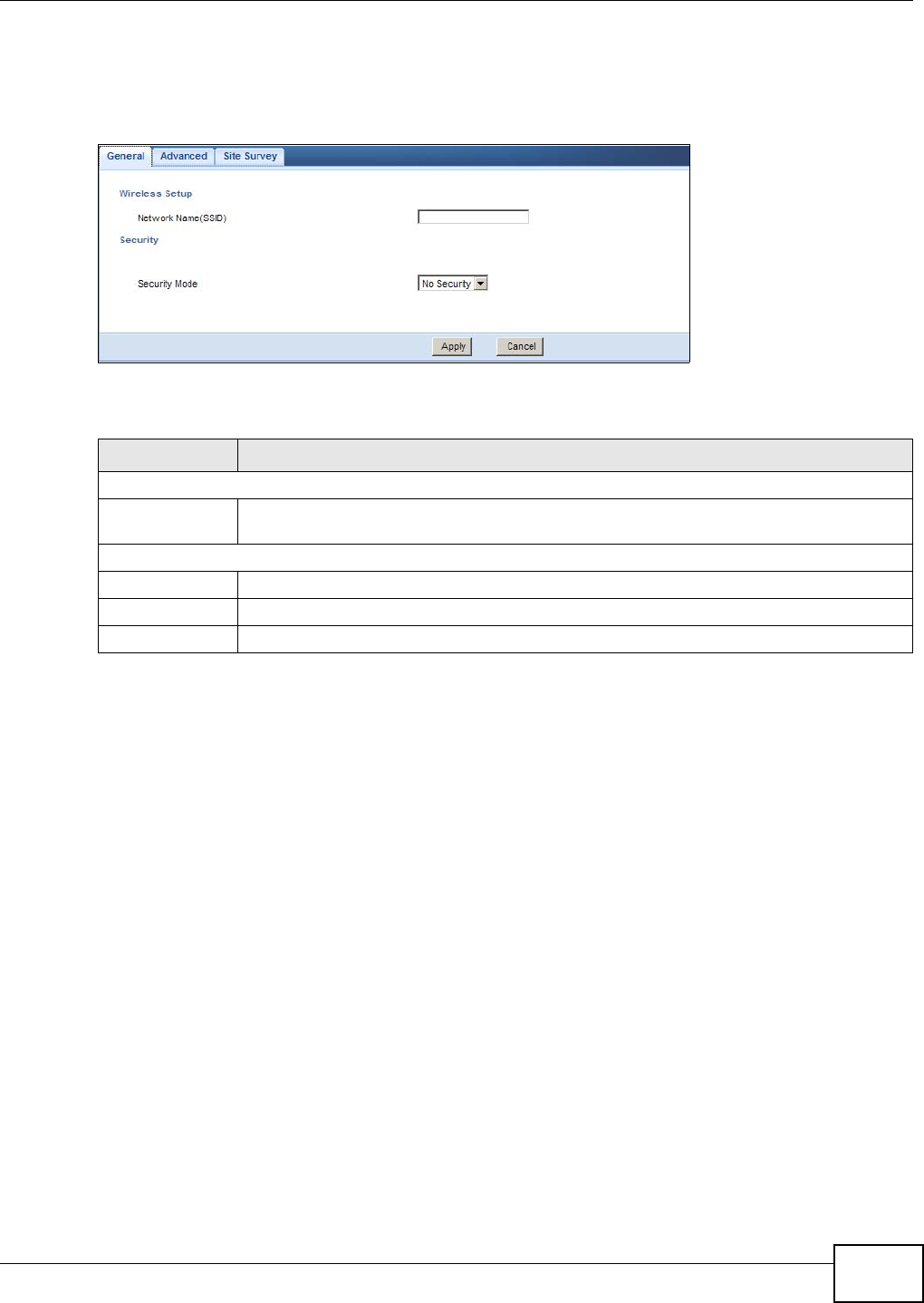
Chapter 11 WISP Mode
NBG-419N v2 User’s Guide 83
11.5.0.1 No Security
Use this screen if the access point to which you want to connect does not use encryption.
Figure 59 No Security (WISP)
The following table describes the labels in this screen.
Table 35 No Security (WISP)
LABEL DESCRIPTION
Wireless Setup
Network Name
(SSID)
Enter the name of the access point to which you are connecting.
Security
Security Mode Select No Security in this field.
Apply Click Apply to save your changes back to the Router.
Cancel Click Cancel to reload the previous configuration for this screen.
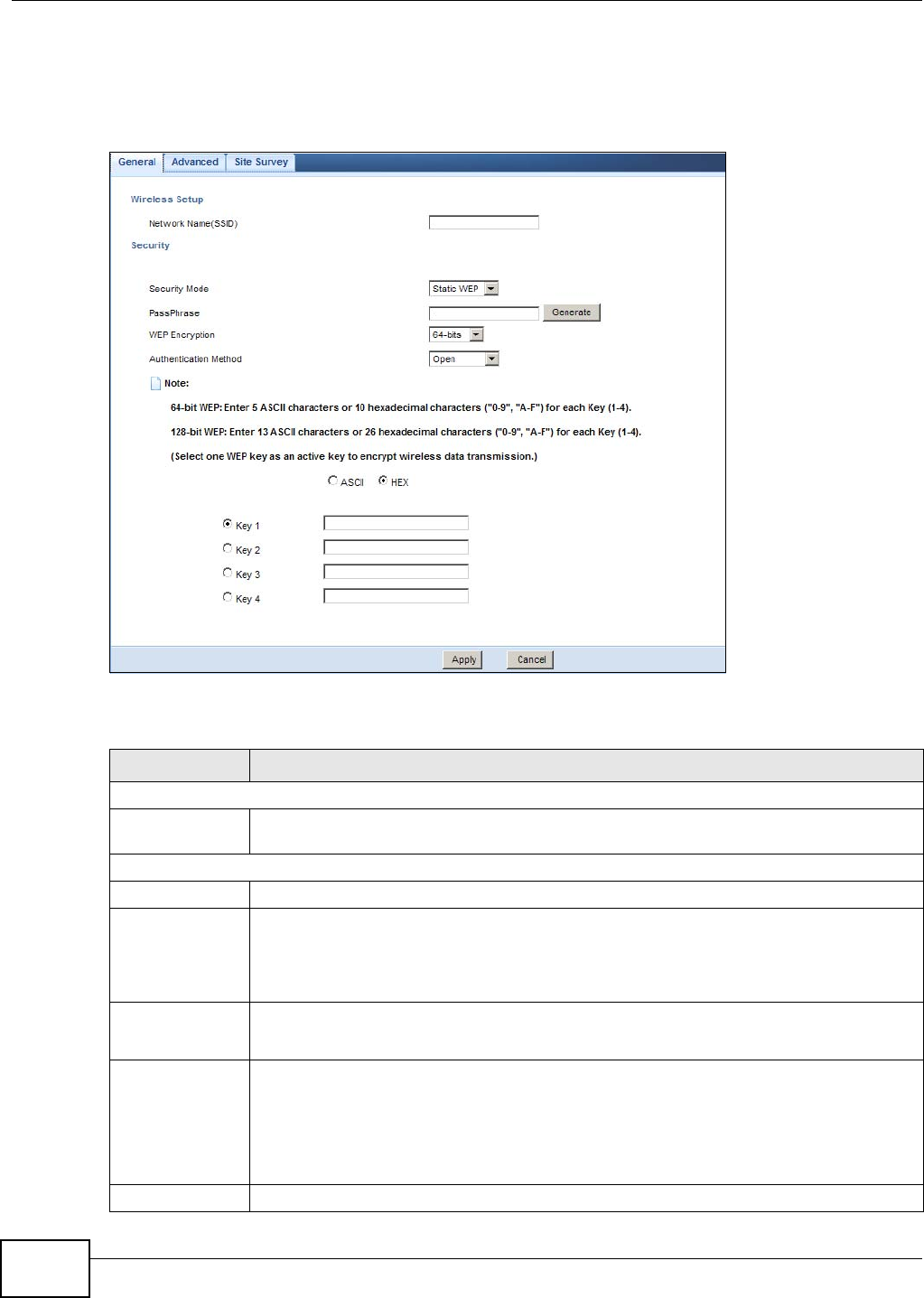
Chapter 11 WISP Mode
NBG-419N v2 User’s Guide
84
11.5.1 Static WEP
Use this screen if the access point to which you want to connect to uses WEP security mode.
Figure 60 WEP (WISP)
The following table describes the labels in this screen..
Table 36 WEP (WISP)
LABEL DESCRIPTION
Wireless Setup
Network Name
(SSID)
Enter the name of the access point to which you are connecting.
Security
Security Mode Select Static WEP to enable data encryption.
PassPhrase Enter a Passphrase (up to 26 printable characters) and click Generate.
A passphrase functions like a password. In WEP security mode, it is further converted by
the Router into a complicated string that is referred to as the “key”. This key is requested
from all devices wishing to connect to a wireless network.
WEP Encryption Select 64-bit WEP or 128-bit WEP.
This dictates the length of the security key that the network is going to use.
Authentication
Method
Select Auto or Shared Key from the drop-down list box.
This field specifies whether the wireless clients have to provide the WEP key to login to the
wireless client. Keep this setting at Auto unless you want to force a key verification before
communication between the wireless client and the Router occurs.
Select Shared Key to force the clients to provide the WEP key prior to communication.
ASCII Select this option in order to enter ASCII characters as WEP key.
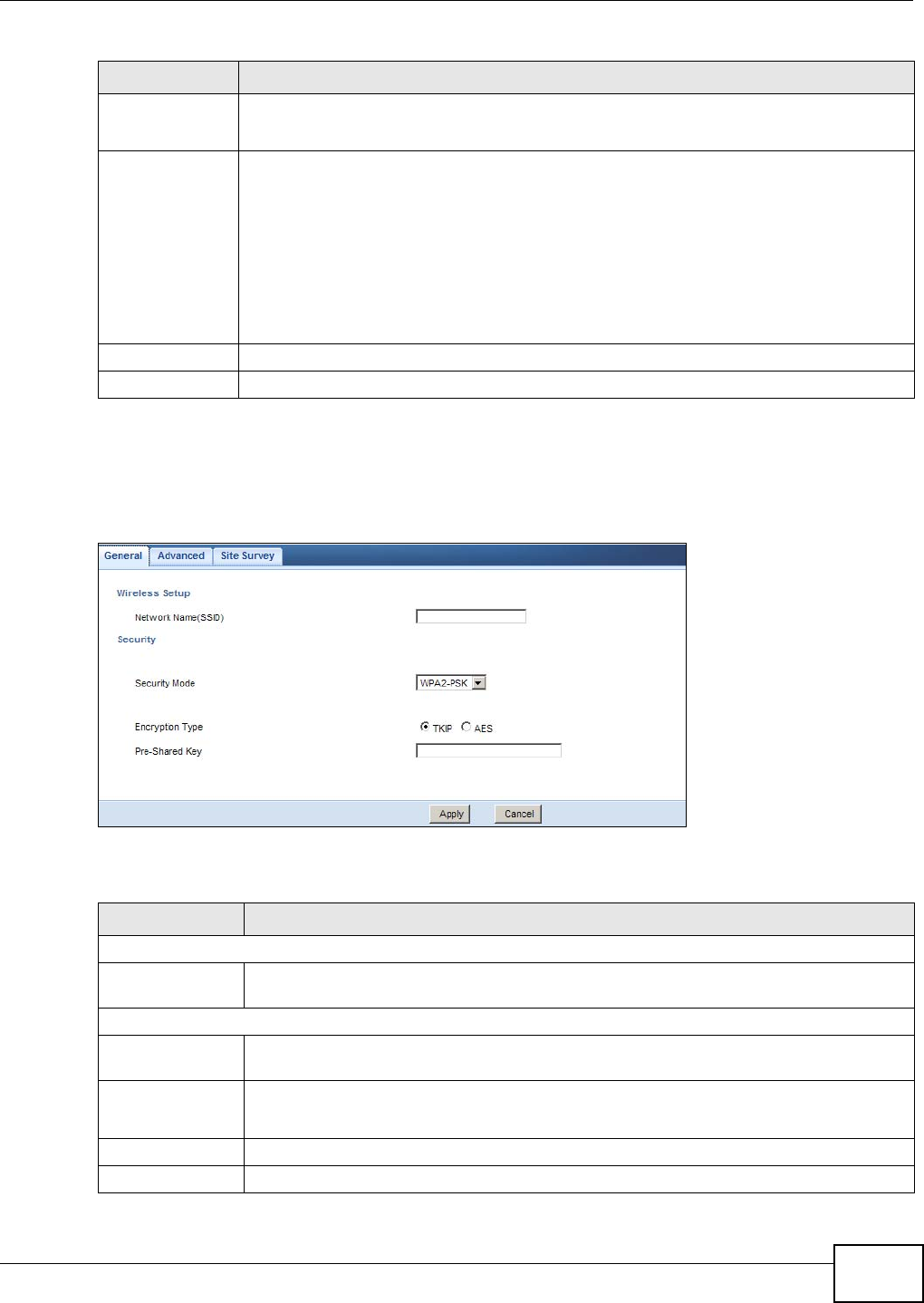
Chapter 11 WISP Mode
NBG-419N v2 User’s Guide 85
11.5.2 WPA(2)-PSK
Use this screen if the access point to which you want to connect uses WPA(2)-PSK security mode.
Figure 61 WPA-PSK/WPA2-PSK (WISP)
The following table describes the labels in this screen. .
Hex Select this option in order to enter hexadecimal characters as a WEP key.
The preceding "0x", that identifies a hexadecimal key, is entered automatically.
Key 1 to Key 4 The WEP keys are used to encrypt data. Both the Router and the wireless stations must
use the same WEP key for data transmission.
If you chose 64-bit WEP, then enter any 5 ASCII characters or 10 hexadecimal characters
("0-9", "A-F").
If you chose 128-bit WEP, then enter 13 ASCII characters or 26 hexadecimal characters
("0-9", "A-F").
You must configure at least one key, only one key can be activated at any one time. The
default key is key 1.
Apply Click Apply to save your changes back to the Router.
Cancel Click Cancel to reload the previous configuration for this screen.
Table 36 WEP (WISP) (continued)
LABEL DESCRIPTION
Table 37 WPA-PSK/WPA2-PSK (WISP)
LABEL DESCRIPTION
Wireless Setup
Network Name
(SSID)
Enter the name of the access point to which you are connecting.
Security
Encryption Type Select the type of wireless encryption employed by the access point to which you want to
connect.
Pre-Shared Key WPA-PSK/WPA2-PSK uses a simple common password for authentication.
Type the pre-shared key employed by the access point to which you want to connect.
Apply Click Apply to save your changes back to the Router.
Cancel Click Cancel to reload the previous configuration for this screen.
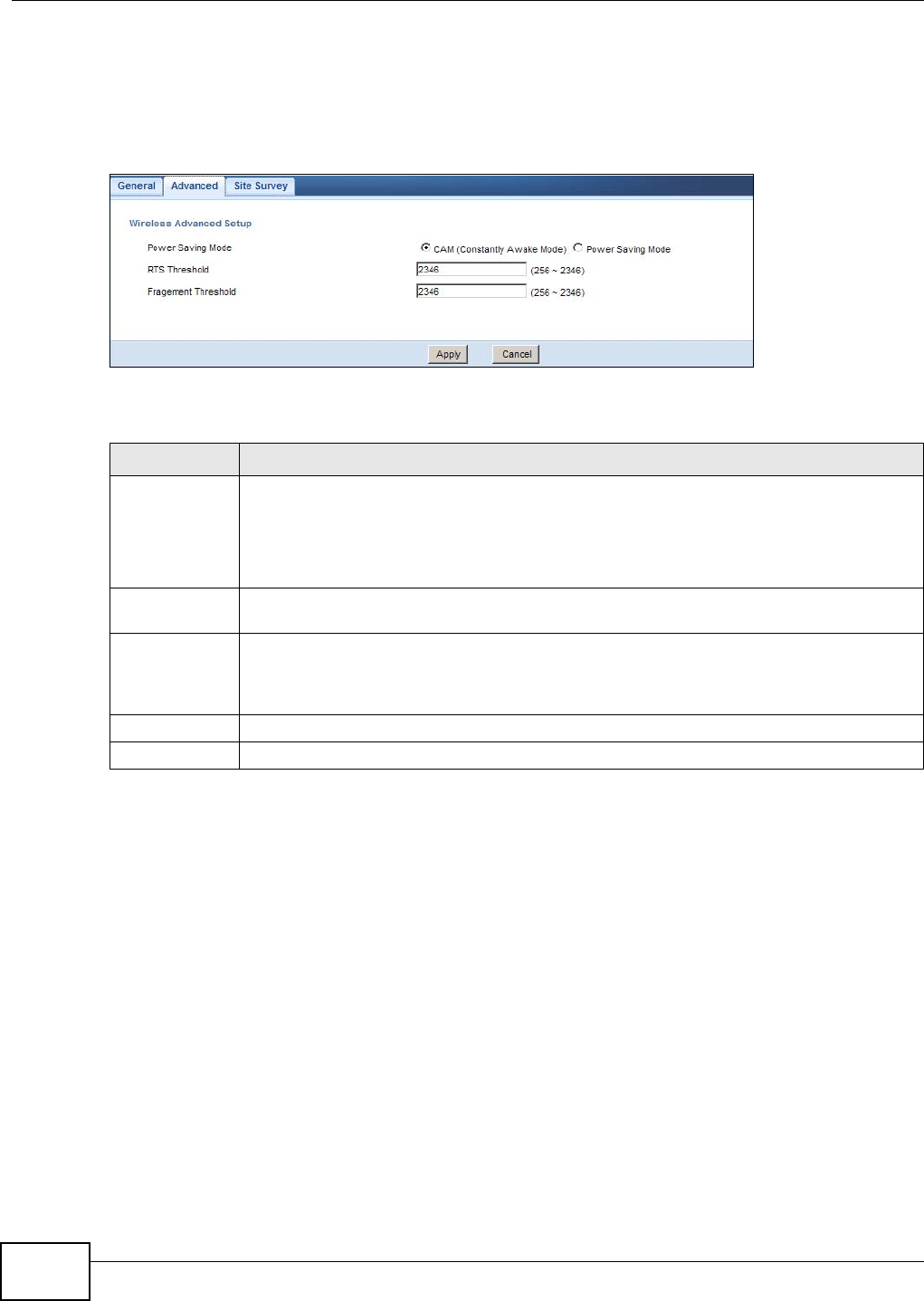
Chapter 11 WISP Mode
NBG-419N v2 User’s Guide
86
11.5.3 Advance Screen
Use this screen to enable the power saving mode of your Router. Go to Configuration > Wireless
LAN to open the following screen.
Figure 62 Configuration > Wireless LAN > Advance Screen (WISP)
The following table describes the labels in this screen.
Table 38 Configuration > Wireless LAN > Advance Screen (WISP)
LABEL DESCRIPTION
Power Saving
Mode
Select CAM (Constantly Awake Mode) if you do not want your Router to go to “sleep”
when no wireless activity is detected in the Wireless LAN.
Select Power Saving Mode if you want the Router to go to sleep when no wireless
connection is needed for a period of time. This means the Router consumes less electrical
power.
RTS Threshold This is the maximum data fragment size that can be sent in a wireless network before the
AP fragments the packet into smaller data frames.
Fragment
Threshold
This value controls how often wireless clients must get permission to send information to
the AP. The lower the value, the more often the wireless clients must get permission. If this
value is greater than the fragmentation threshold value, then wireless clients never have to
get permission to send information to the AP.
Apply Click Apply to save your changes back to the Router.
Cancel Click Cancel to reload the previous configuration for this screen.
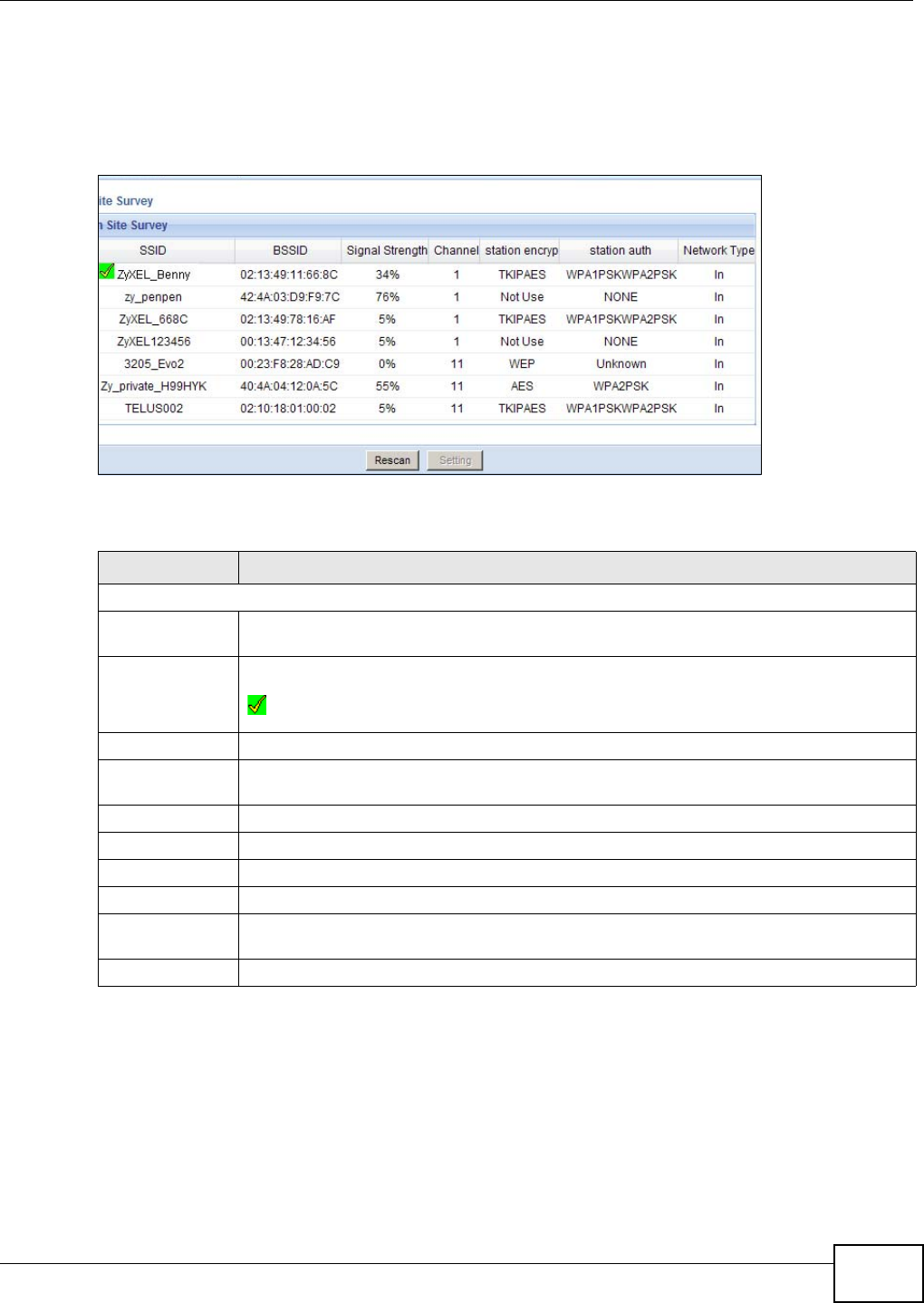
Chapter 11 WISP Mode
NBG-419N v2 User’s Guide 87
11.5.4 Site Survey Screen
Use this screen to scan for and connect to a wireless network automatically. Go to Configuration >
Site Survey to open the following screen.
Figure 63 Configuration > Wireless LAN > Site Survey (WISP)
The following table describes the labels in this screen.
Table 39 Configuration > Wireless LAN > Site Survey (WISP)
LABEL DESCRIPTION
Station Site Survey
# Select a wireless device and click Add Profile to open a configuration screen where you
can add the selected wireless device to a profile and then enable it.
SSID This displays the SSID of the wireless device.
indicates the wireless device is added to an activated profile and the Router is
connecting to it.
BSSID This displays the MAC address of the wireless device.
Signal Strength This displays the strength of the wireless signal. The signal strength mainly depends on the
antenna output power and the distance between your Router and this device.
Channel This displays the channel number used by this wireless device.
station encryp This displays the data encryption method used by this wireless device.
station auth This displays the authentication method used by this wireless device.
Network Type This displays the network type (In (Infrastructure) or Ad (Ad Hoc) of this wireless device.
Rescan Click this button to search for available wireless devices within transmission range and
update this table.
Setting Select a wireless device and click this button to add it to a profile.

Chapter 11 WISP Mode
NBG-419N v2 User’s Guide
88
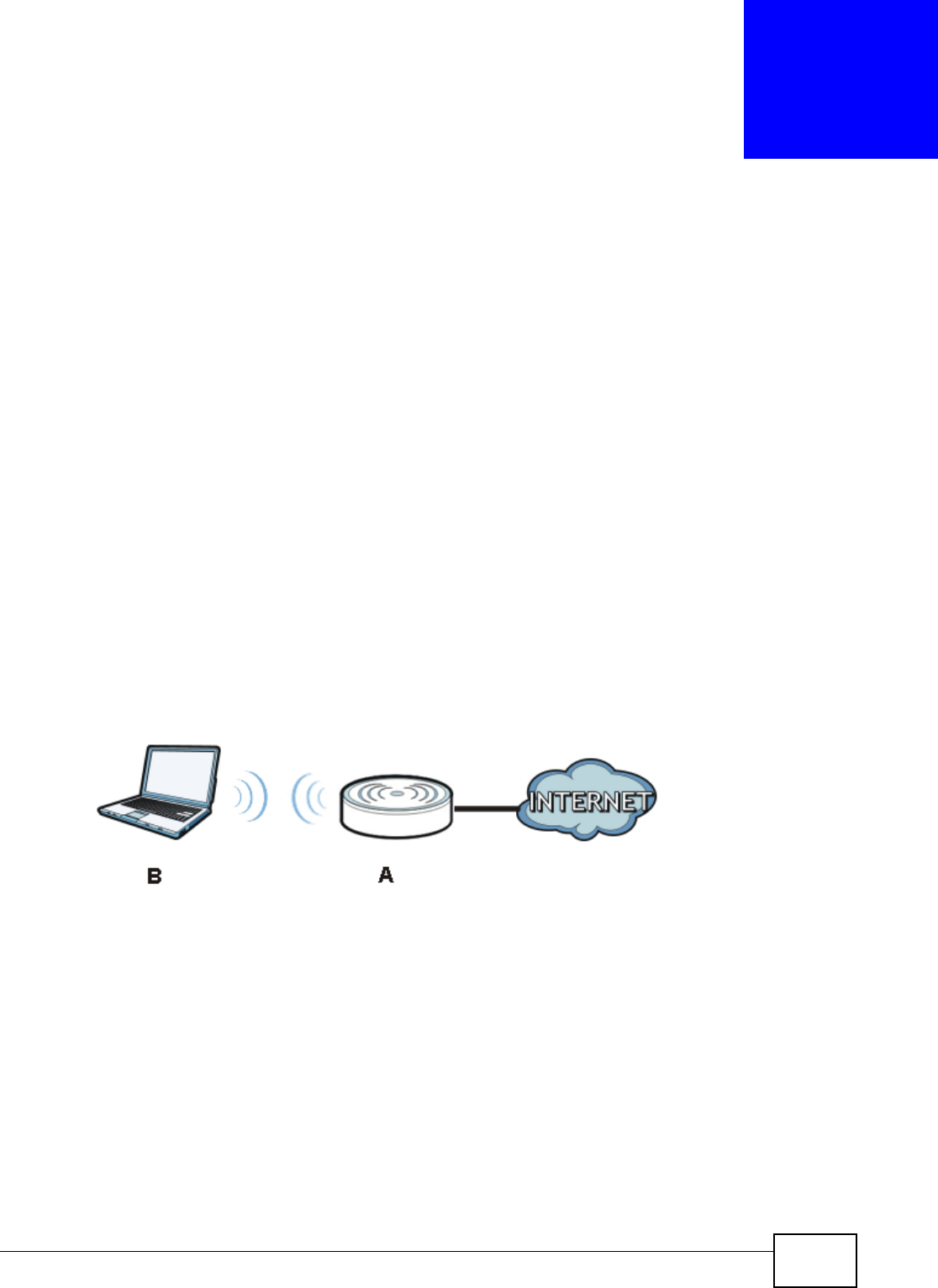
NBG-419N v2 User’s Guide 89
CHAPTER 12
Tutorials
12.1 Overview
This chapter provides tutorials for your Router as follows:
•Connecting to the Internet from an Access Point
•Configuring Wireless Security Using WPS
•Enabling and Configuring Wireless Security (No WPS)
•Connecting to USB Storage with the ZyXEL NetUSB Share Center Utility
•Automatically Connecting to a USB Printer
12.2 Connecting to the Internet from an Access Point
This section gives you an example of how to set up an access point (AP) and wireless client (a
notebook (B), in this example) for wireless communication. B can access the Internet through the
access point wirelessly.
Figure 64 Wireless Access Point Connection to the Internet
12.3 Configuring Wireless Security Using WPS
This section gives you an example of how to set up wireless network using WPS. This example uses
the Router as the AP and NWD210N as the wireless client which connects to a notebook.
Note: The wireless client must be a WPS-aware device (for example, a WPS USB adapter
or PCI card).
There are two WPS methods for creating a secure connection. This tutorial shows you how to do
both.

Chapter 12 Tutorials
NBG-419N v2 User’s Guide
90
•Push Button Configuration (PBC) - create a secure wireless network simply by pressing a
button. See Section 12.3.1 on page 90.This is the easier method.
•PIN Configuration - create a secure wireless network simply by entering a wireless client's PIN
(Personal Identification Number) in the Router’s interface. See Section 12.3.2 on page 91. This is
the more secure method, since one device can authenticate the other.
12.3.1 Push Button Configuration (PBC)
1Make sure that your Router is turned on and that it is within range of your computer.
2Make sure that you have installed the wireless client (this example uses the NWD210N) driver and
utility in your notebook.
3In the wireless client utility, find the WPS settings. Enable WPS and press the WPS button (Start or
WPS button)
4Log into Router’s Web Configurator and press the Push Button button in the Network > Wireless
Client > WPS Station screen.
Note: Your Router has a WPS button located on its panel, as well as a WPS button in its
configuration utility. Both buttons have exactly the same function; you can use one
or the other.
Note: It doesn’t matter which button is pressed first. You must press the second button
within two minutes of pressing the first one.
The Router sends the proper configuration settings to the wireless client. This may take up to two
minutes. Then the wireless client is able to communicate with the Router securely.
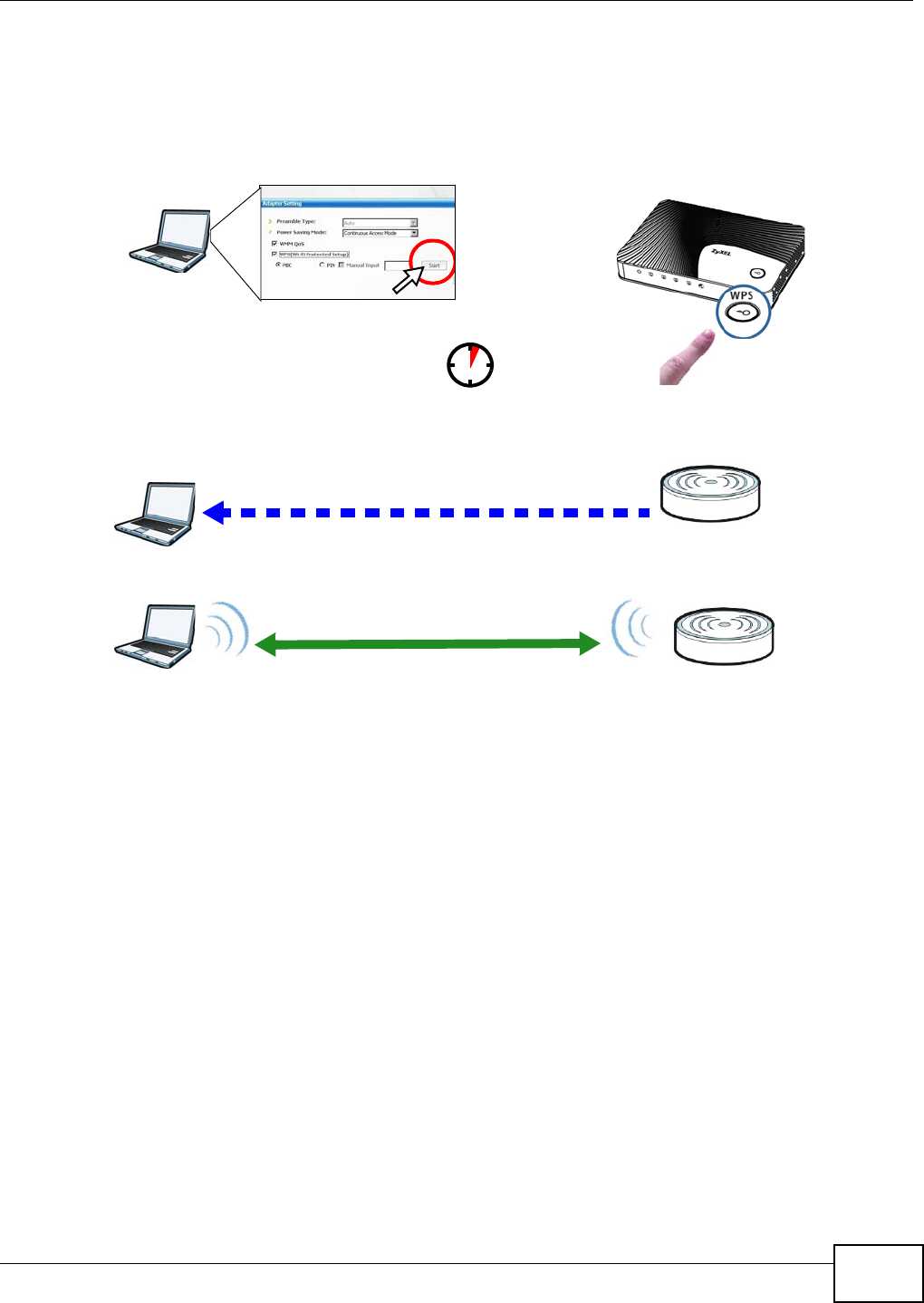
Chapter 12 Tutorials
NBG-419N v2 User’s Guide 91
The following figure shows you an example to set up wireless network and security by pressing a
button on both Router and wireless client (the NWD210N in this example).
Figure 65 Example WPS Process: PBC Method
12.3.2 PIN Configuration
When you use the PIN configuration method, you need to use both Router’s configuration interface
and the client’s utilities.
1Launch your wireless client’s configuration utility. Go to the WPS settings and select the PIN method
to get a PIN number.
2Enter the PIN number to the PIN field in the Network > Wireless LAN > WPS Station screen on
the Router.
3Click Start buttons (or button next to the PIN field) on both the wireless client utility screen and the
Router’s WPS Station screen within two minutes.
The Router authenticates the wireless client and sends the proper configuration settings to the
wireless client. This may take up to two minutes. Then the wireless client is able to communicate
with the Router securely.
Wireless Client NBG-419N v2
SECURITY INFO
COMMUNICATION
WITHIN 2 MINUTES
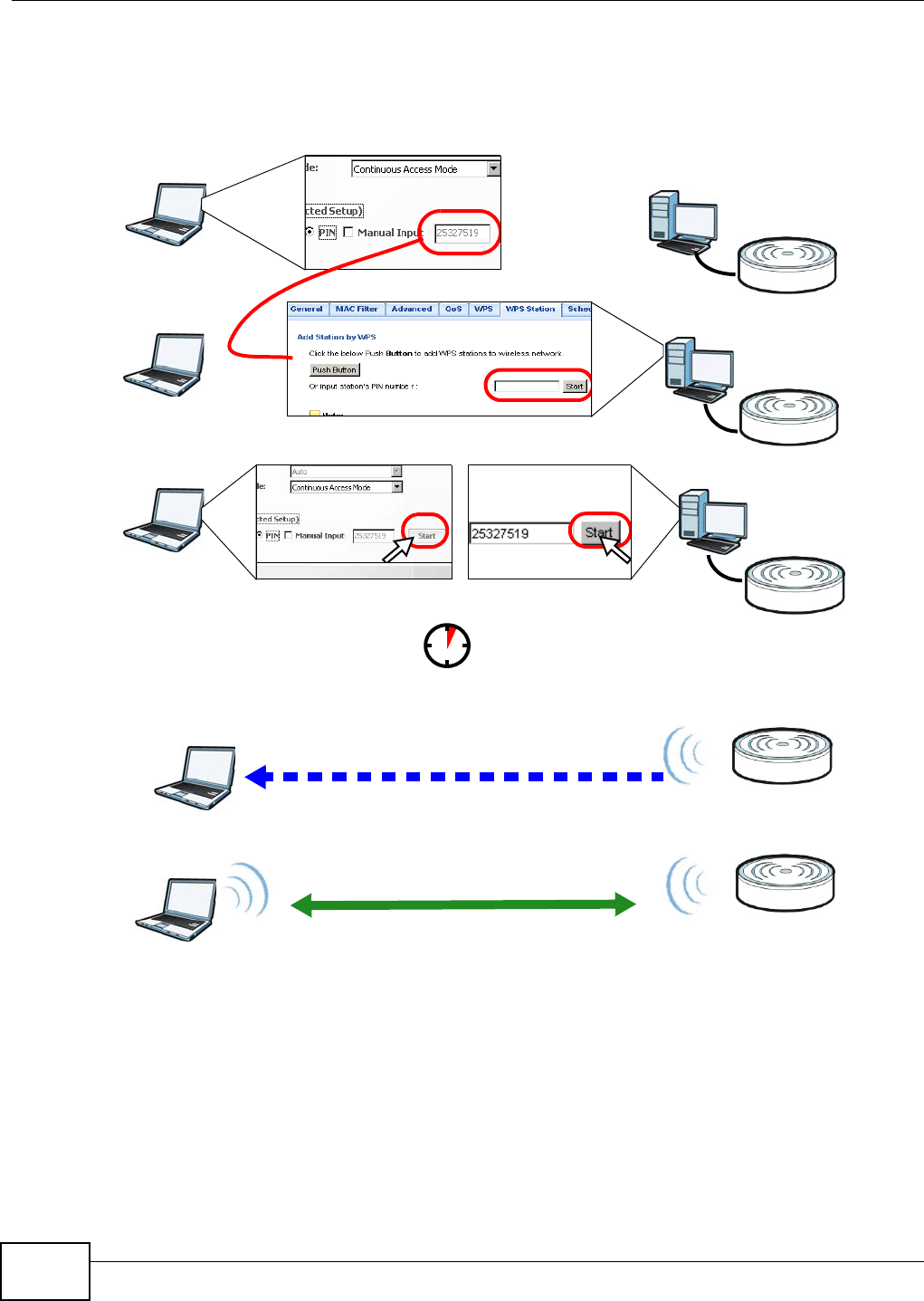
Chapter 12 Tutorials
NBG-419N v2 User’s Guide
92
The following figure shows you the example to set up wireless network and security on Router and
wireless client (ex. NWD210N in this example) by using PIN method.
Figure 66 Example WPS Process: PIN Method
Authentication by PIN
SECURITY INFO
WITHIN 2 MINUTES
Wireless Client
NBG-419N v2
COMMUNICATION
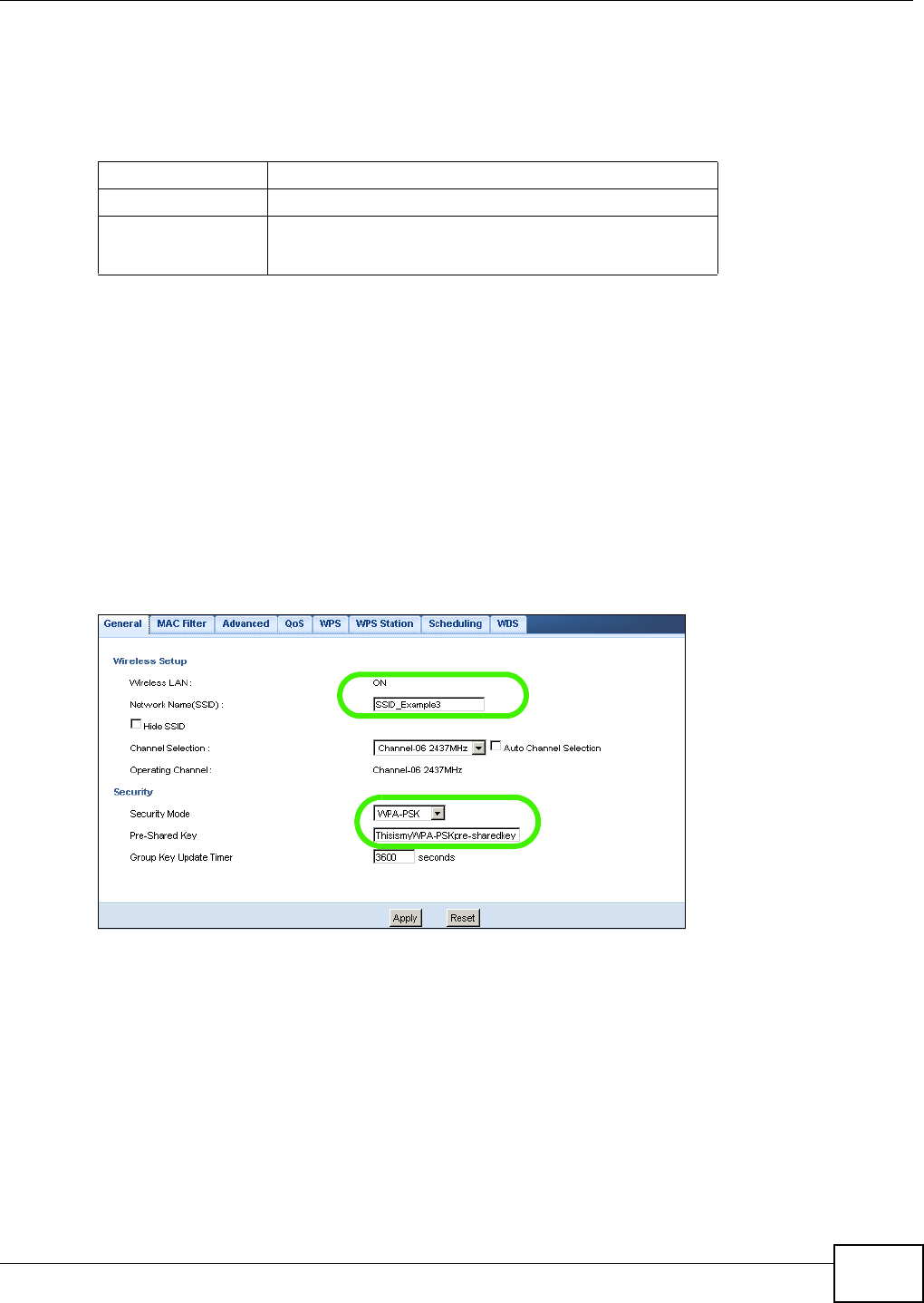
Chapter 12 Tutorials
NBG-419N v2 User’s Guide 93
12.4 Enabling and Configuring Wireless Security (No WPS)
This example shows you how to configure wireless security settings with the following parameters
on your Router.
Follow the steps below to configure the wireless settings on your Router.
The instructions require that your hardware is connected (see the Quick Start Guide) and you are
logged into the Web Configurator through your LAN connection (see Section 5.2 on page 39).
1Open the Wireless LAN > General screen in the AP’s Web Configurator.
2Make sure the Enable Wireless LAN check box is selected.
3Enter SSID_Example3 as the SSID and select a channel.
4Set security mode to WPA-PSK and enter ThisismyWPA-PSKpre-sharedkey in the Pre-Shared
Key field. Click Apply.
Figure 67 Tutorial: Network > Wireless LAN > General
SSID SSID_Example3
Channel 6
Security WPA-PSK
(Pre-Shared Key: ThisismyWPA-PSKpre-sharedkey)
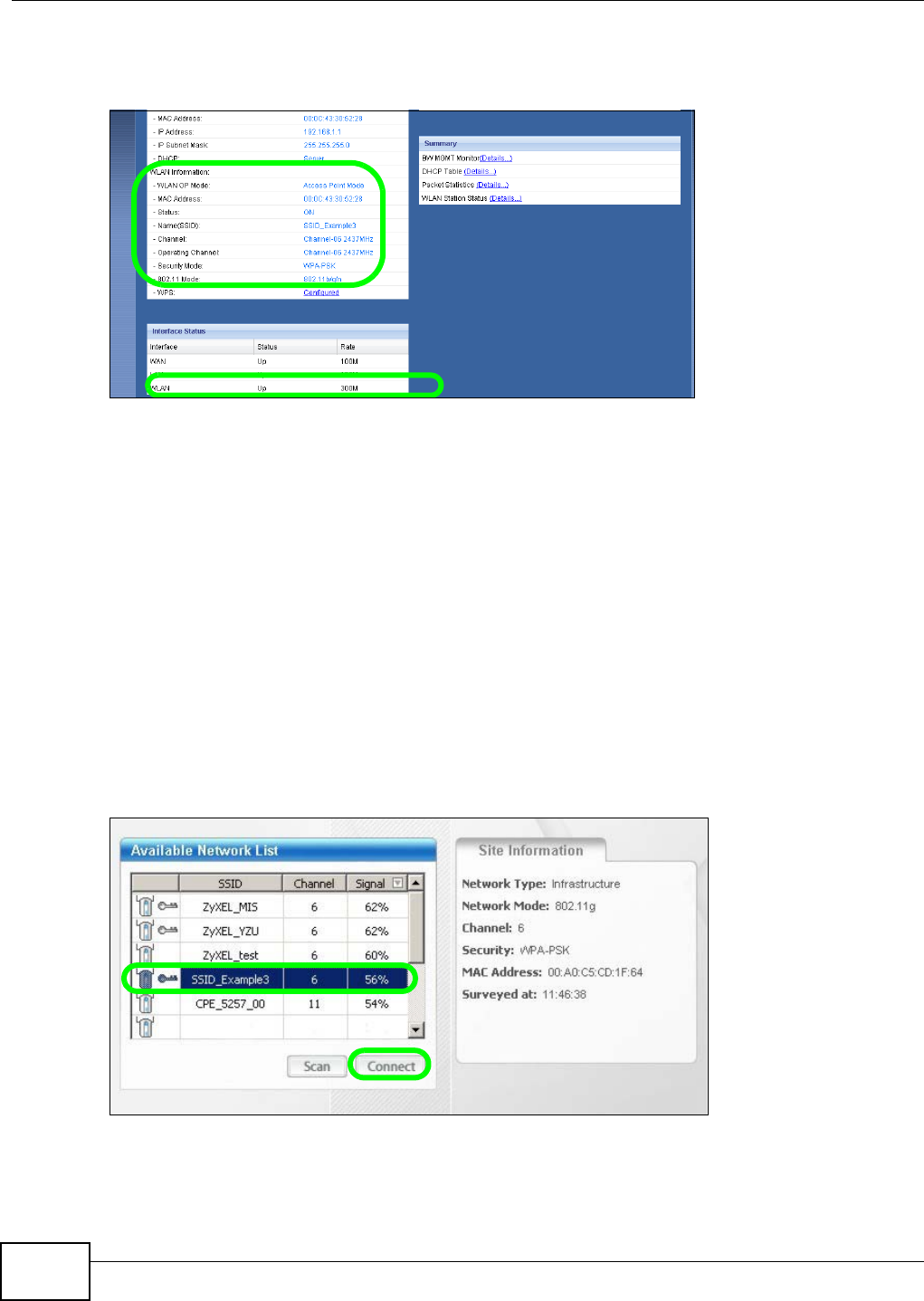
Chapter 12 Tutorials
NBG-419N v2 User’s Guide
94
5Open the Status screen. Verify your wireless and wireless security settings under Device
Information and check if the WLAN connection is up under Interface Status.
Figure 68 Tutorial: Checking Wireless Settings
12.4.1 Configure Your Notebook
Note: We use the ZyXEL M-302 wireless adapter utility screens as an example for the
wireless client. The screens may vary for different models.
1The Router supports IEEE 802.11b, IEEE 802.11g and IEEE 802.11n wireless clients. Make sure that
your notebook or computer’s wireless adapter supports one of these standards.
2Wireless adapters come with software sometimes called a “utility” that you install on your
computer. See your wireless adapter’s User’s Guide for information on how to do that.
3After you’ve installed the utility, open it. If you cannot see your utility’s icon on your screen, go to
Start > Programs and click on your utility in the list of programs that appears. The utility displays
a list of APs within range, as shown in the example screen below.
4Select SSID_Example3 and click Connect.
Figure 69 Connecting a Wireless Client to a Wireless Network t
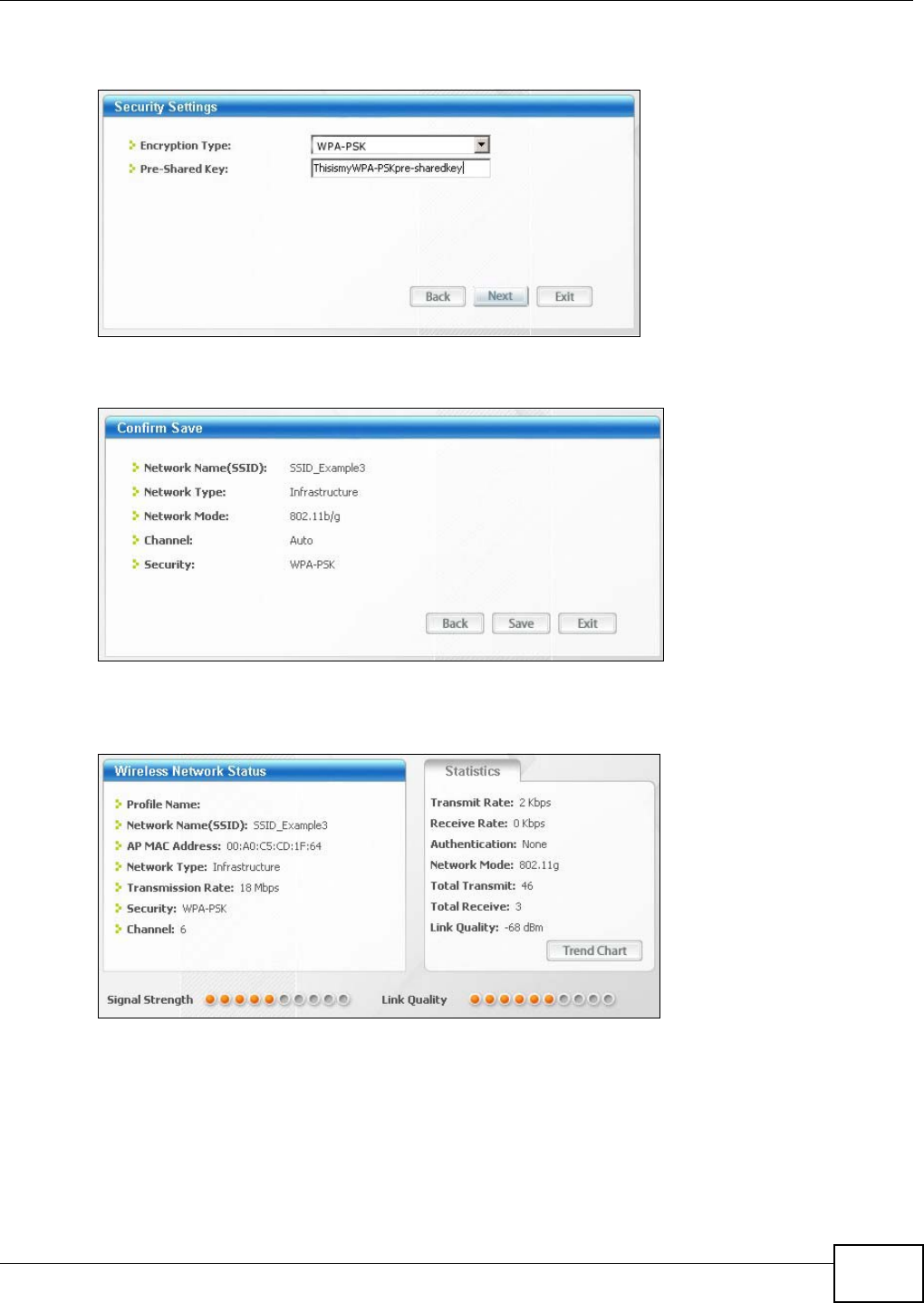
Chapter 12 Tutorials
NBG-419N v2 User’s Guide 95
5Select WPA-PSK and type the security key in the following screen. Click Next.
Figure 70 Security Settings
6The Confirm Save window appears. Check your settings and click Save to continue.
Figure 71 Confirm Save
7Check the status of your wireless connection in the screen below. If your wireless connection is
weak or you have no connection, see the Troubleshooting section of this User’s Guide.
Figure 72 Link Status
If your connection is successful, open your Internet browser and enter http://www.zyxel.com or the
URL of any other web site in the address bar. If you are able to access the web site, your wireless
connection is successfully configured.
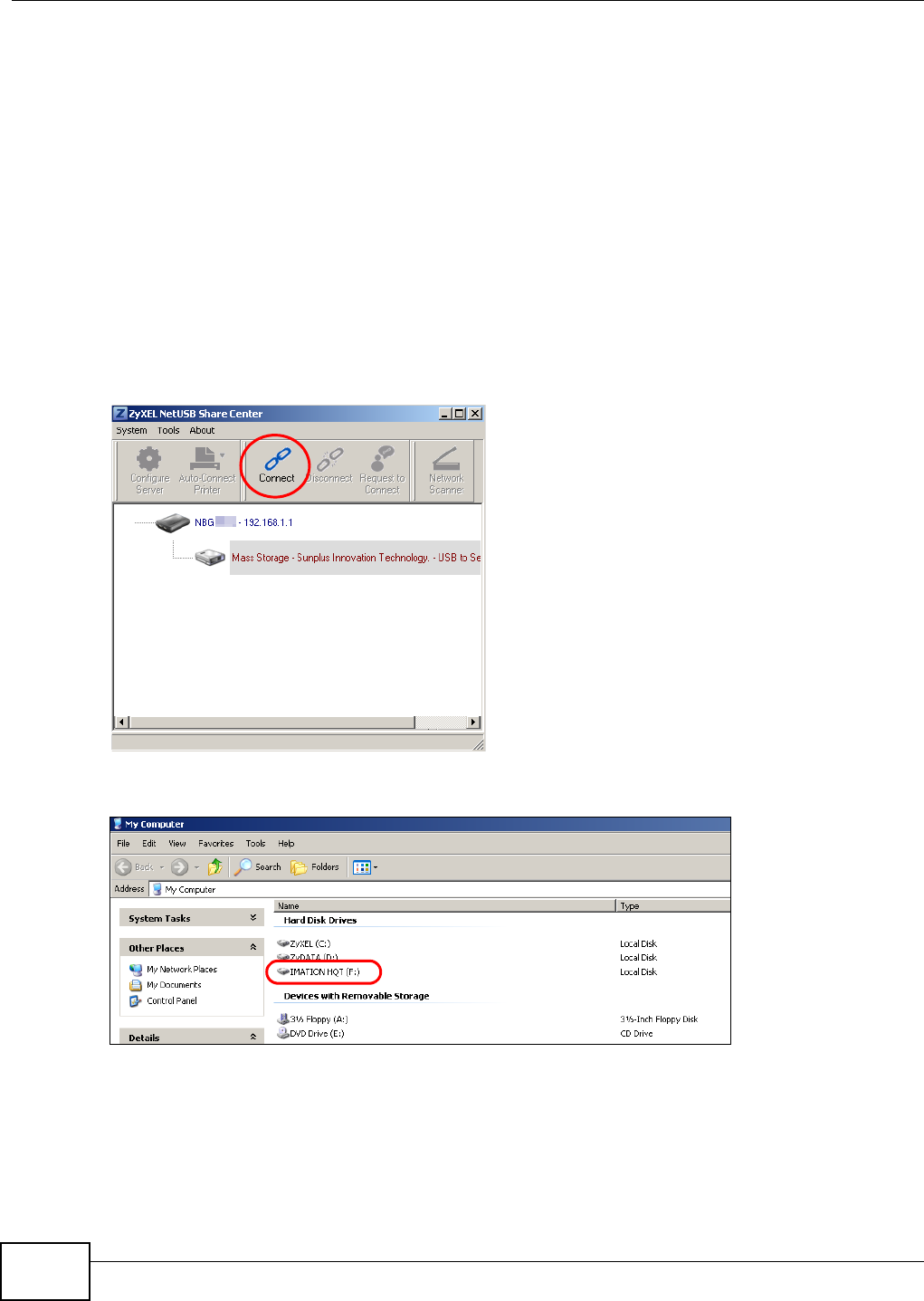
Chapter 12 Tutorials
NBG-419N v2 User’s Guide
96
12.5 Connecting to USB Storage with the ZyXEL NetUSB
Share Center Utility
This tutorial shows you how to connect to a USB device over your Router network by using the
ZyXEL NetUSB Share Center Utility.
1Install the ZyXEL NetUSB Share Center Utility on the computer to which you want to connect the
USB device. See Chapter 3 on page 21 for details on the installation.
2Connect a USB device to one of the USB ports of the Router.
3Open the ZyXEL NetUSB Sharing Center Utility on your computer. The name of the USB device
automatically shows in the Utility screen.
4Click on the USB device’s name. Then click Connect.
5The device mounts on your system.
12.5.1 Multiple Connections to the USB Device
The Utility supports one connection to the Router’s USB device at a time. If more than one
computer want to connect to the USB device, follow the steps below:
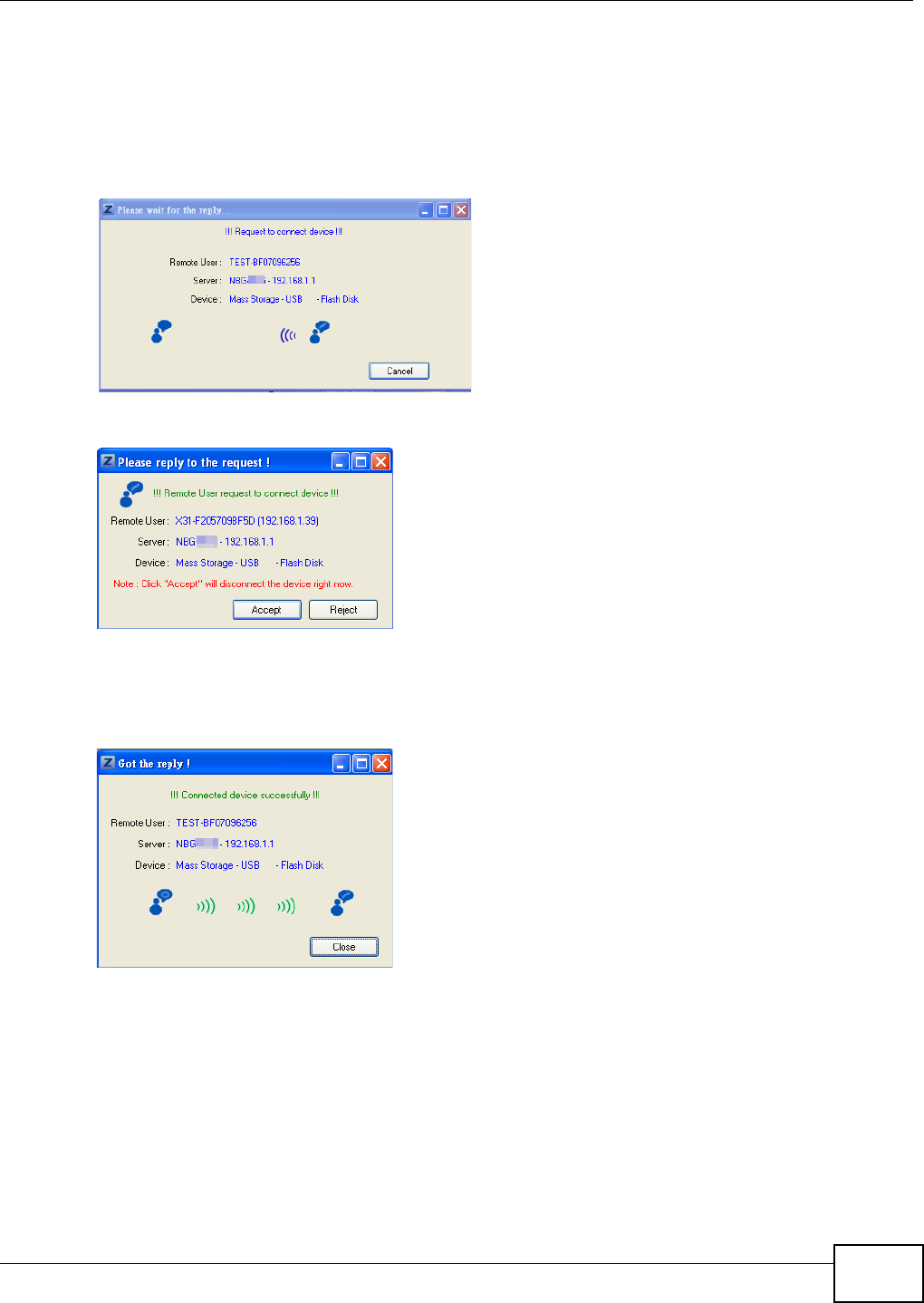
Chapter 12 Tutorials
NBG-419N v2 User’s Guide 97
1After the first computer (A) finishes using the USB device, click Disconnect on the Utilty to
unmount it.
2Click Connect on the Utility of the second computer (B) to mount the USB device on B.
3If A does not disconnect from the USB device, B cannot use it. B can click the Request to Connect
button to request A to disconnect. B will see the following message on its Utility:
4A will receive the following message on its Utility screen.
5A should click Accept to disconnect to the USB device.
6After A is disconnected from USB device, B will see the following message on its Utility. Now B can
access the USB device.
Note: If your computer is connected to a USB device, you must disconnect it and use Exit
to close the Utility. If you use the X on the Utility screen, it only closes the Utility
window. The Utility is still connected. Do not exit the Utility until the USB device is
disconnected via the Utility or until you receive a request to disconnect. See
Chapter 3 on page 21 for details on how to exit the Utility.
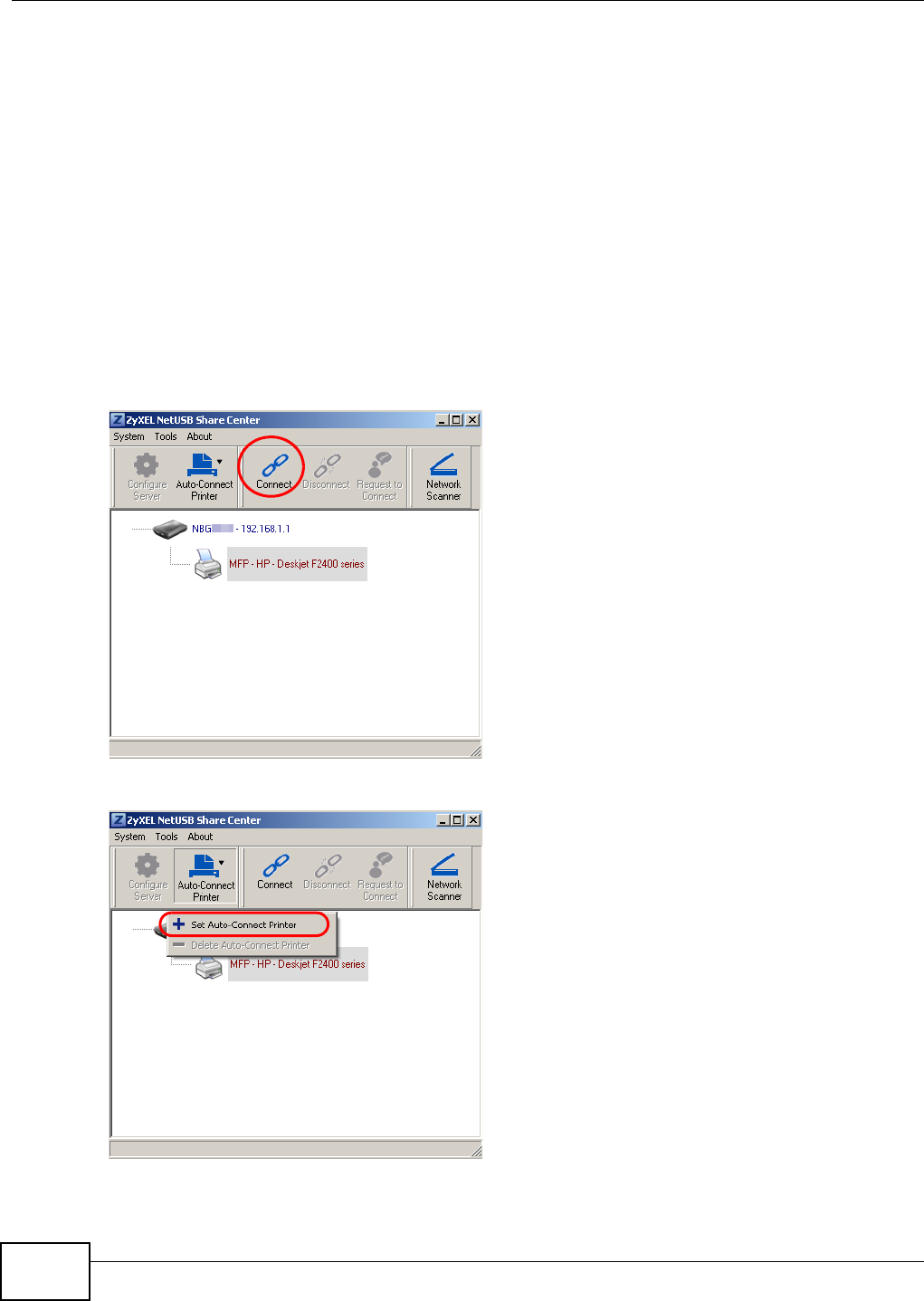
Chapter 12 Tutorials
NBG-419N v2 User’s Guide
98
12.6 Automatically Connecting to a USB Printer
Your computer can connect to a shared USB printer by using the ZyXEL NetUSB Share Center
Utility. This tutorial shows you how to set your computer to automatically connect to a shared USB
printer over your Router network each time you log into your computer.
1Install the ZyXEL NetUSB Share Center Utility to your computer. See Chapter 3 on page 21 for
details on the installation.
2Connect a USB printer to one of the USB ports of the Router.
3Open the ZyXEL NetUSB Sharing Center Utility on your computer. The name of the USB printer
automatically shows in the Utility screen.
4Click on the printer name. Then click Connect. Your computer will search for the printer driver. You
may be prompted to install the driver. Follow the driver’s installation steps to finish installing.
5Click the Auto-Connect Printer menu and select Set Auto-Connect Printer from the menu.
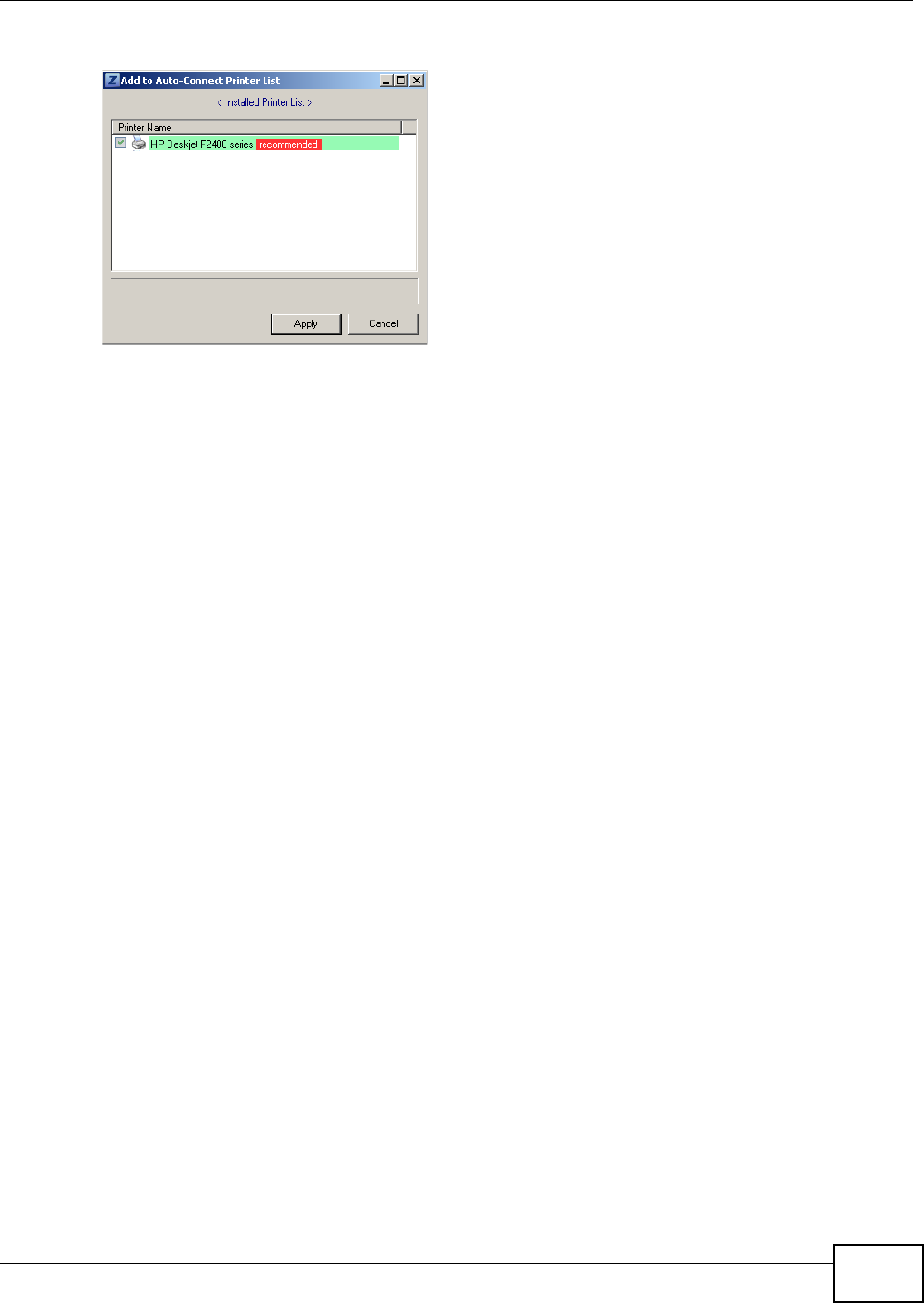
Chapter 12 Tutorials
NBG-419N v2 User’s Guide 99
6Select the USB printer you want to connect to and click Apply.
7Now your computer can automatically connect to this shared USB printer over your Router network
each time you log into your computer. The printer will be automatically added to your printer list.
8The Utility supports one connection to the Router’s USB device at a time. If more than one
computer is using the printer and are all auto-connected to the USB device, the second computer
automatically starts printing after the first computer finishes its printing task.

Chapter 12 Tutorials
NBG-419N v2 User’s Guide
100

101
PART II
Technical Reference

102
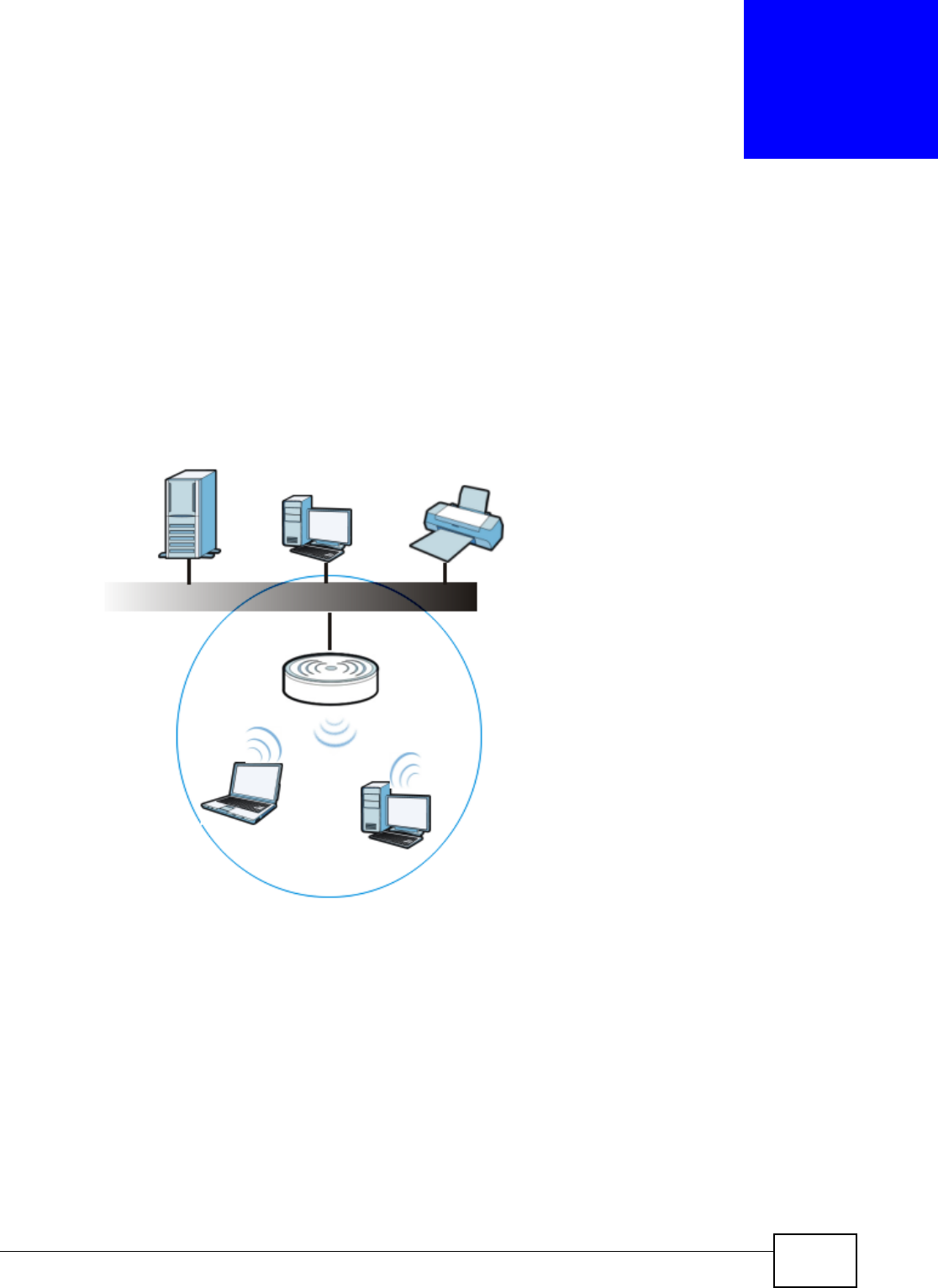
NBG-419N v2 User’s Guide 103
CHAPTER 13
Wireless LAN
13.1 Overview
This chapter discusses how to configure the wireless network settings in your Router. See the
appendices for more detailed information about wireless networks.
The following figure provides an example of a wireless network.
Figure 73 Example of a Wireless Network
The wireless network is the part in the blue circle. In this wireless network, devices A and B are
called wireless clients. The wireless clients use the access point (AP) to interact with other devices
(such as the printer) or with the Internet. Your Router is the AP.
13.2 What You Can Do
•Use the General screen (Section 13.4 on page 106) to enable the Wireless LAN, enter the SSID
and select the wireless security mode.
•Use the MAC Filter screen (Section 13.5 on page 110) to allow or deny wireless stations based
on their MAC addresses from connecting to the Router.
AB
Router

Chapter 13 Wireless LAN
NBG-419N v2 User’s Guide
104
•Use the Advanced screen (Section 13.6 on page 111) to allow wireless advanced features, such
as intra-BSS networking and set the RTS/CTS Threshold.
•Use the QoS screen (Section 13.7 on page 113) to set priority levels to services, such as e-mail,
VoIP, chat, and so on.
•Use the WPS screen (Section 13.8 on page 114) to quickly set up a wireless network with strong
security, without having to configure security settings manually.
•Use the WPS Station screen (Section 13.9 on page 115) to add a wireless station using WPS.
•Use the Scheduling screen (Section 13.10 on page 116) to set the times your wireless LAN is
turned on and off.
•Use the WDS screen (Section 13.11 on page 117) to configure Wireless Distribution System on
your Router.
13.3 What You Should Know
Every wireless network must follow these basic guidelines.
• Every wireless client in the same wireless network must use the same SSID.
The SSID is the name of the wireless network. It stands for Service Set IDentity.
• If two wireless networks overlap, they should use different channels.
Like radio stations or television channels, each wireless network uses a specific channel, or
frequency, to send and receive information.
• Every wireless client in the same wireless network must use security compatible with the AP.
Security stops unauthorized devices from using the wireless network. It can also protect the
information that is sent in the wireless network.
13.3.1 Wireless Security Overview
The following sections introduce different types of wireless security you can set up in the wireless
network.
13.3.1.1 SSID
Normally, the AP acts like a beacon and regularly broadcasts the SSID in the area. You can hide the
SSID instead, in which case the AP does not broadcast the SSID. In addition, you should change
the default SSID to something that is difficult to guess.
This type of security is fairly weak, however, because there are ways for unauthorized devices to
get the SSID. In addition, unauthorized devices can still see the information that is sent in the
wireless network.
13.3.1.2 MAC Address Filter
Every wireless client has a unique identification number, called a MAC address.1 A MAC address is
usually written using twelve hexadecimal characters2; for example, 00A0C5000002 or
1. Some wireless devices, such as scanners, can detect wireless networks but cannot use wireless networks. These kinds
of wireless devices might not have MAC addresses.
2. Hexadecimal characters are 0, 1, 2, 3, 4, 5, 6, 7, 8, 9, A, B, C, D, E, and F.

Chapter 13 Wireless LAN
NBG-419N v2 User’s Guide 105
00:A0:C5:00:00:02. To get the MAC address for each wireless client, see the appropriate User’s
Guide or other documentation.
You can use the MAC address filter to tell the AP which wireless clients are allowed or not allowed to
use the wireless network. If a wireless client is allowed to use the wireless network, it still has to
have the correct settings (SSID, channel, and security). If a wireless client is not allowed to use the
wireless network, it does not matter if it has the correct settings.
This type of security does not protect the information that is sent in the wireless network.
Furthermore, there are ways for unauthorized devices to get the MAC address of an authorized
wireless client. Then, they can use that MAC address to use the wireless network.
13.3.1.3 Encryption
Wireless networks can use encryption to protect the information that is sent in the wireless
network. Encryption is like a secret code. If you do not know the secret code, you cannot
understand the message.
The types of encryption you can choose depend on the type of user authentication.
Usually, you should set up the strongest encryption that every wireless client in the wireless
network supports. Suppose the wireless network has two wireless clients. Device A only supports
WEP, and device B supports WEP and WPA-PSK. Therefore, you should set up WEP in the wireless
network.
Note: It is recommended that wireless networks use WPA-PSK or stronger encryption.
IEEE 802.1x and WEP encryption are better than none at all, but it is still possible
for unauthorized devices to figure out the original information pretty quickly.
When you select WPA2-PSK in your Router, you can also select an option (WPA Compatible) to
support WPA as well. In this case, if some wireless clients support WPA and some support WPA2,
you should set up WPA2-PSK (depending on the type of wireless network login) and select the
WPA Compatible option in the Router.
Many types of encryption use a key to protect the information in the wireless network. The longer
the key, the stronger the encryption. Every wireless client in the wireless network must have the
same key.
13.3.1.4 WPS
WiFi Protected Setup (WPS) is an industry standard specification, defined by the WiFi Alliance. WPS
allows you to quickly set up a wireless network with strong security, without having to configure
security settings manually. Depending on the devices in your network, you can either press a
button (on the device itself, or in its configuration utility) or enter a PIN (Personal Identification
Number) in the devices. Then, they connect and set up a secure network by themselves. See how
to set up a secure wireless network using WPS in the Section 12.3 on page 89.
Table 40 Types of Encryption for Each Type of Authentication
NO AUTHENTICATION
Weakest No Security
WEP
WPA-PSK
Strongest WPA2-PSK
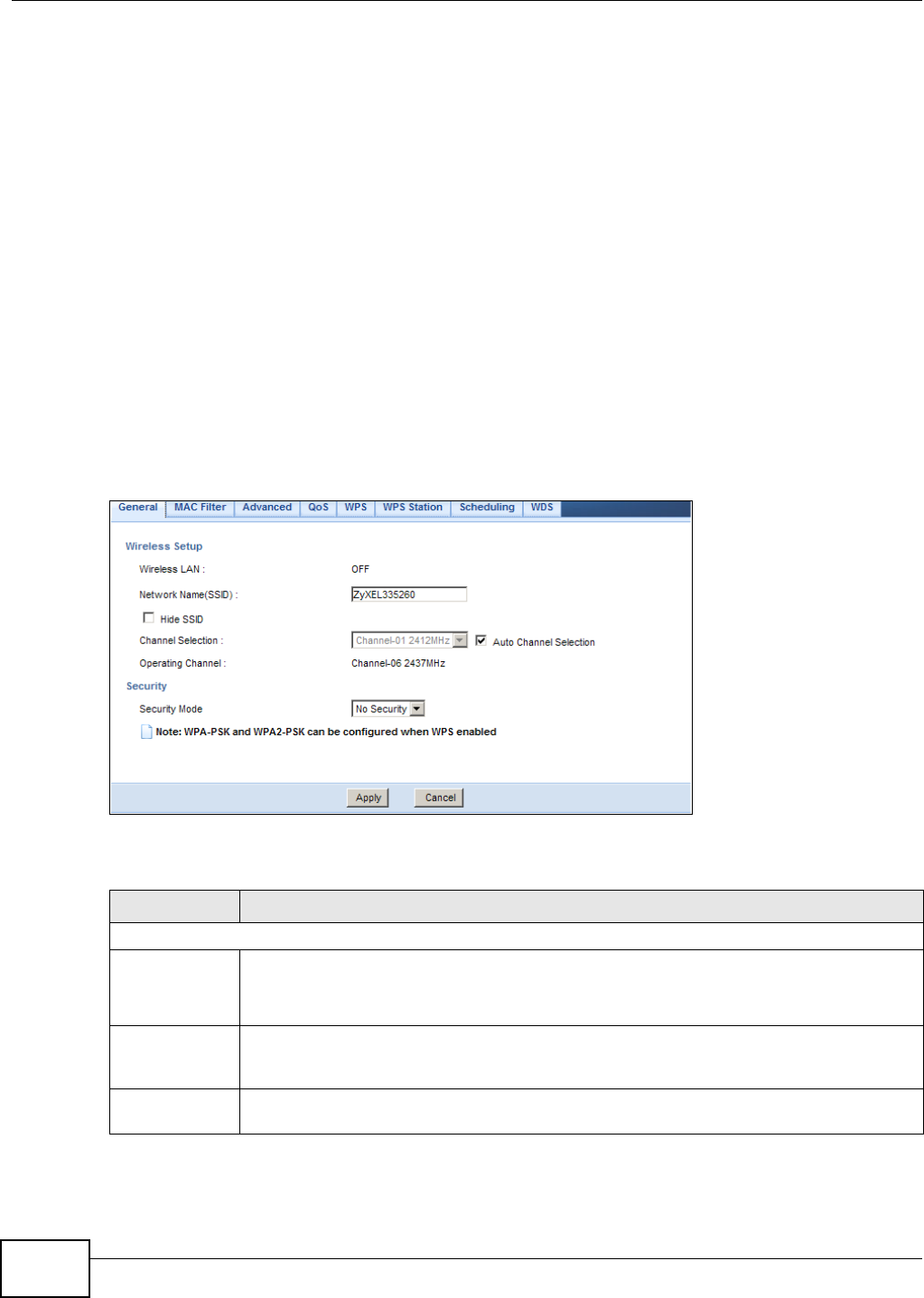
Chapter 13 Wireless LAN
NBG-419N v2 User’s Guide
106
13.3.1.5 WDS
Wireless Distribution System or WDS security is used between bridged APs. It is independent of the
security between the wired networks and their respective APs. If you do not enable WDS security,
traffic between APs is not encrypted. When WDS security is enabled, both APs must use the same
pre-shared key.
13.4 General Wireless LAN Screen
Use this screen to enable the Wireless LAN, enter the SSID and select the wireless security mode.
Note: If you are configuring the Router from a computer connected to the wireless LAN
and you change the Router’s SSID, channel or security settings, you will lose your
wireless connection when you press Apply to confirm. You must then change the
wireless settings of your computer to match the Router’s new settings.
Click Network > Wireless LAN to open the General screen.
Figure 74 Network > Wireless LAN > General
The following table describes the general wireless LAN labels in this screen.
Table 41 Network > Wireless LAN > General
LABEL DESCRIPTION
Wireless Setup
Wireless LAN This is turned on by default.
You can turn the wireless LAN on or off using the switch at the rear panel of the Router. The
current wireless state is reflected in this field.
Network
Name(SSID)
(Service Set IDentity) The SSID identifies the Service Set with which a wireless station is
associated. Wireless stations associating to the Router must have the same SSID. Enter a
descriptive name (up to 32 keyboard characters) for the wireless LAN.
Hide SSID Select this check box to hide the SSID in the outgoing beacon frame so a station cannot
obtain the SSID through scanning using a site survey tool.
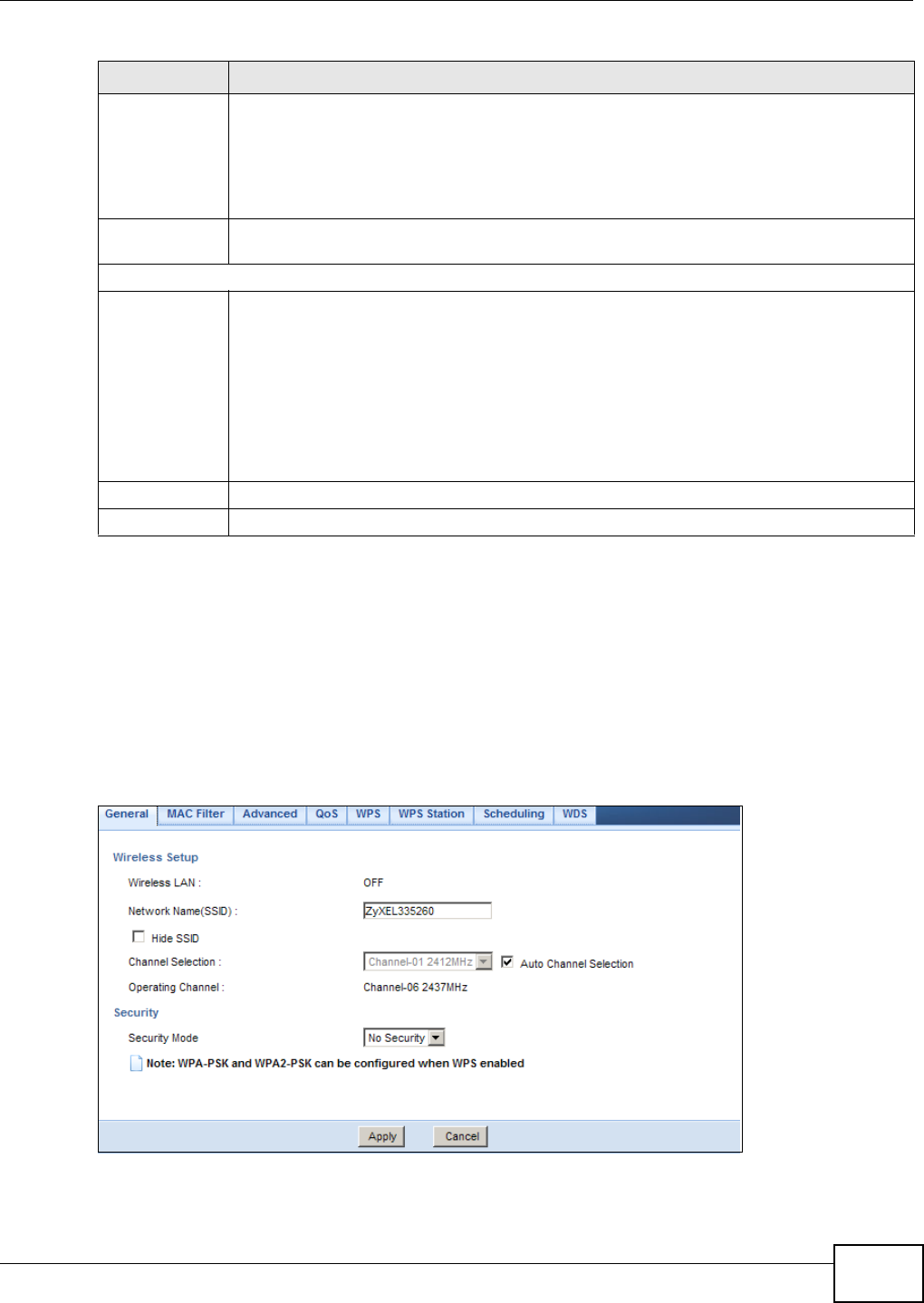
Chapter 13 Wireless LAN
NBG-419N v2 User’s Guide 107
See the rest of this chapter for information on the other labels in this screen.
13.4.1 No Security
Select No Security to allow wireless stations to communicate with the access points without any
data encryption.
Note: If you do not enable any wireless security on your Router, your network is
accessible to any wireless networking device that is within range.
Figure 75 Network > Wireless LAN > General: No Security
Channel
Selection
Set the operating frequency/channel depending on your particular region.
Select a channel from the drop-down list box. The options vary depending on the frequency
band and the country you are in.
Refer to the Connection Wizard chapter for more information on channels. This option is
only available if Auto Channel Selection is disabled.
Operating
Channel
This displays the channel the Router is currently using.
Security
Security Mode Select WEP, WPA-PSK or WPA2-PSK to add security on this wireless network. The
wireless clients which want to associate to this network must have same wireless security
settings as the Router. After you select to use a security, additional options appears in this
screen. See 13.4.2 and 13.4.3 sections.
Or you can select No Security to allow any client to associate this network without
authentication.
Note: If you enable the WPS function, only No Security, WPA-PSK and WPA2-PSK are
available in this field.
Apply Click Apply to save your changes back to the Router.
Reset Click Reset to reload the previous configuration for this screen.
Table 41 Network > Wireless LAN > General (continued)
LABEL DESCRIPTION
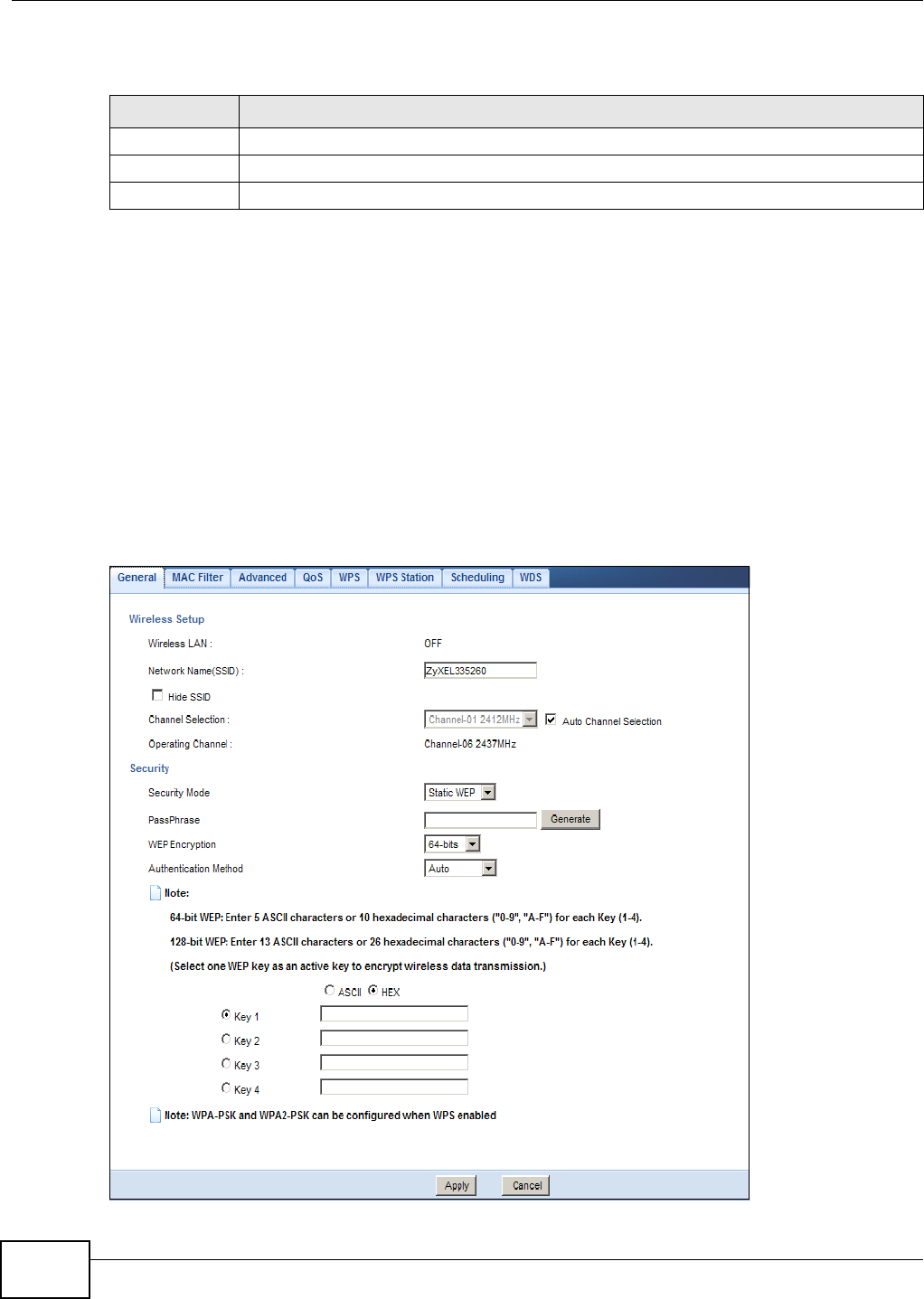
Chapter 13 Wireless LAN
NBG-419N v2 User’s Guide
108
The following table describes the labels in this screen.
Refer to Table 41 on page 106 for descriptions of the other labels in this screen.
13.4.2 WEP Encryption
WEP encryption scrambles the data transmitted between the wireless stations and the access points
to keep network communications private. It encrypts unicast and multicast communications in a
network. Both the wireless stations and the access points must use the same WEP key.
Your Router allows you to configure up to four 64-bit or 128-bit WEP keys but only one key can be
enabled at any one time.
In order to configure and enable WEP encryption, click Network > Wireless LAN to display the
General screen. Select Static WEP from the Security Mode list.
Figure 76 Network > Wireless LAN > General: Static WEP
Table 42 Network > Wireless LAN > General: No Security
LABEL DESCRIPTION
Security Mode Choose No Security from the drop-down list box.
Apply Click Apply to save your changes back to the Router.
Cancel Click Cancel to reload the previous configuration for this screen.

Chapter 13 Wireless LAN
NBG-419N v2 User’s Guide 109
The following table describes the wireless LAN security labels in this screen.
Refer to Table 41 on page 106 for descriptions of the other labels in this screen.
Table 43 Network > Wireless LAN > General: Static WEP
LABEL DESCRIPTION
Security Mode Select Static WEP to enable data encryption.
PassPhrase Enter a Passphrase (up to 26 printable characters) and click Generate.
A passphrase functions like a password. In WEP security mode, it is further converted by the
Router into a complicated string that is referred to as the “key”. This key is requested from
all devices wishing to connect to a wireless network.
WEP Encryption Select 64-bit WEP or 128-bit WEP.
This dictates the length of the security key that the network is going to use.
Authentication
Method
Select Auto or Shared Key from the drop-down list box.
This field specifies whether the wireless clients have to provide the WEP key to login to the
wireless client. Keep this setting at Auto unless you want to force a key verification before
communication between the wireless client and the Router occurs.
Select Shared Key to force the clients to provide the WEP key prior to communication.
ASCII Select this option in order to enter ASCII characters as WEP key.
Hex Select this option in order to enter hexadecimal characters as a WEP key.
The preceding "0x", that identifies a hexadecimal key, is entered automatically.
Key 1 to Key 4 The WEP keys are used to encrypt data. Both the Router and the wireless stations must use
the same WEP key for data transmission.
If you chose 64-bit WEP, then enter any 5 ASCII characters or 10 hexadecimal characters
("0-9", "A-F").
If you chose 128-bit WEP, then enter 13 ASCII characters or 26 hexadecimal characters
("0-9", "A-F").
You must configure at least one key, only one key can be activated at any one time.
Apply Click Apply to save your changes back to the Router.
Cancel Click Cancel to reload the previous configuration for this screen.
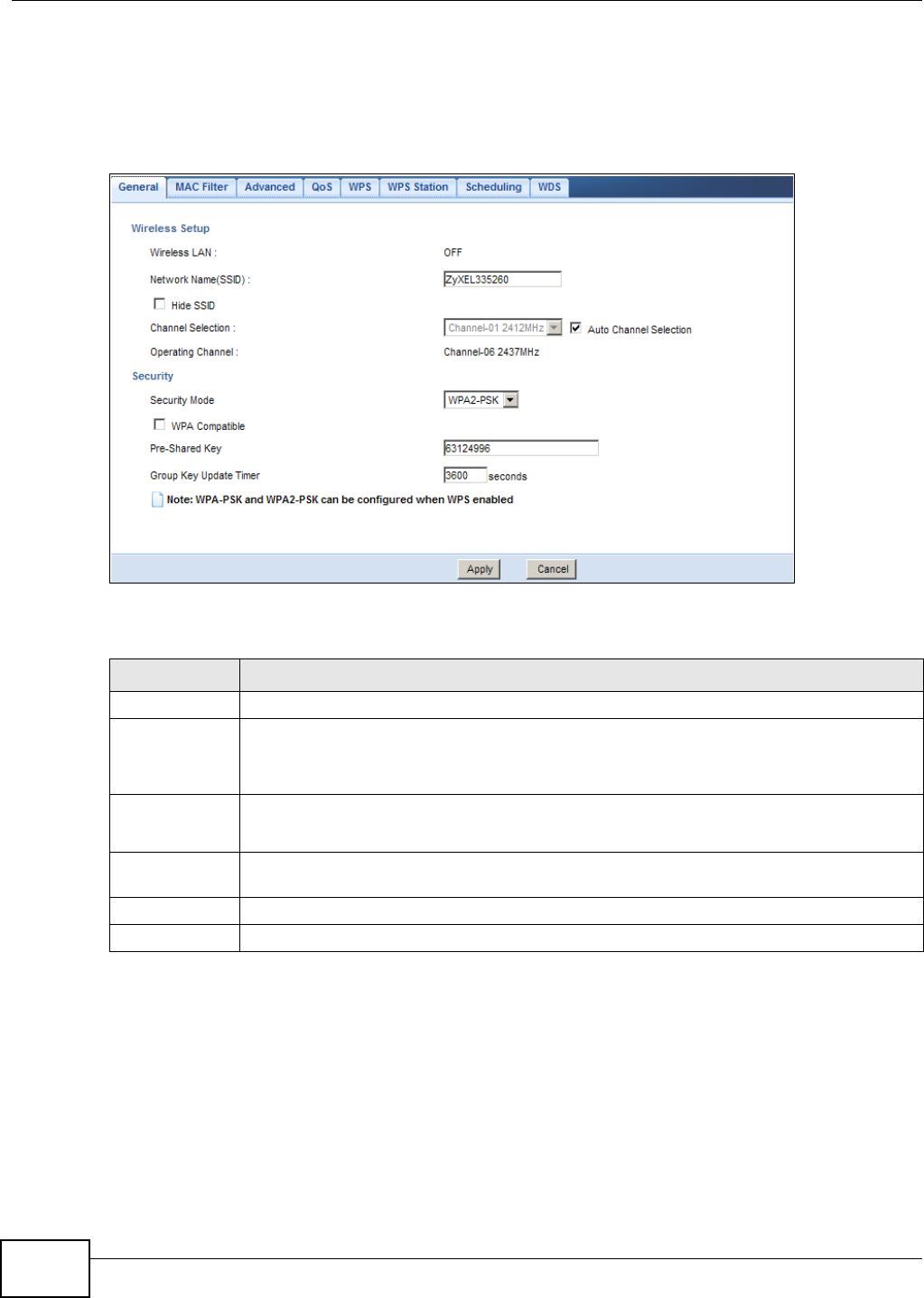
Chapter 13 Wireless LAN
NBG-419N v2 User’s Guide
110
13.4.3 WPA-PSK/WPA2-PSK
Click Network > Wireless LAN to display the General screen. Select WPA-PSK or WPA2-PSK
from the Security Mode list.
Figure 77 Network > Wireless LAN > General: WPA-PSK/WPA2-PSK
The following table describes the labels in this screen.
Refer to Table 41 on page 106 for descriptions of the other labels in this screen.
13.5 MAC Filter
The MAC filter screen allows you to configure the Router to give exclusive access to devices (Allow)
or exclude devices from accessing the Router (Deny). Every Ethernet device has a unique MAC
(Media Access Control) address. The MAC address is assigned at the factory and consists of six
Table 44 Network > Wireless LAN > General: WPA-PSK/WPA2-PSK
LABEL DESCRIPTION
Security Mode Select WPA-PSK or WPA2-PSK to enable data encryption.
WPA-PSK
Compatible
This field appears when you choose WPA-PSK2 as the Security Mode.
Check this field to allow wireless devices using WPA-PSK security mode to connect to your
Router.
Pre-Shared Key WPA-PSK/WPA2-PSK uses a simple common password for authentication.
Type a pre-shared key from 8 to 63 case-sensitive keyboard characters.
Group Key
Update Timer
The Group Key Update Timer is the rate at which the AP sends a new group key out to all
clients.
Apply Click Apply to save your changes back to the Router.
Cancel Click Cancel to reload the previous configuration for this screen.
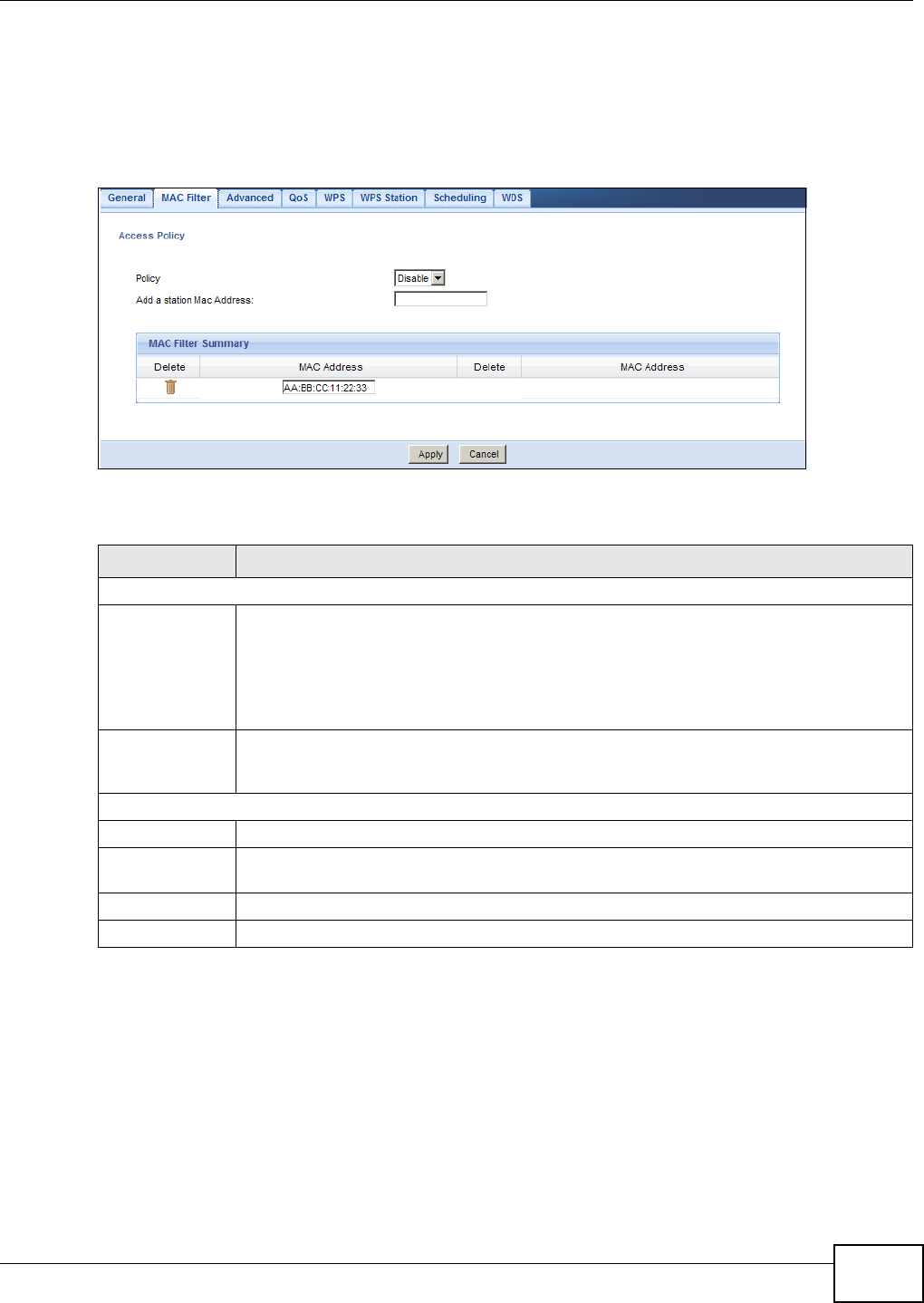
Chapter 13 Wireless LAN
NBG-419N v2 User’s Guide 111
pairs of hexadecimal characters, for example, 00:A0:C5:00:00:02. You need to know the MAC
address of the devices to configure this screen.
To change your Router’s MAC filter settings, click Network > Wireless LAN > MAC Filter. The
screen appears as shown.
Figure 78 Network > Wireless LAN > MAC Filter
The following table describes the labels in this menu.
13.6 Wireless LAN Advanced Screen
Use this screen to allow wireless advanced features, such as intra-BSS networking and set the
RTS/CTS Threshold
Table 45 Network > Wireless LAN > MAC Filter
LABEL DESCRIPTION
Access Policy
Policy Define the filter action for the list of MAC addresses in the MAC Address table.
Select Allow to permit access to the Router, MAC addresses not listed will be denied
access to the Router.
Select Reject to block access to the Router, MAC addresses not listed will be allowed to
access the Router
Add a station
Mac Address
Enter the MAC addresses of the wireless station that are allowed or denied access to the
Router in these address fields. Enter the MAC addresses in a valid MAC address format,
that is, six hexadecimal character pairs, for example, 12:34:56:78:9a:bc. Click Add.
MAC Filter Summary
Delete Click the delete icon to remove the MAC address from the list.
MAC Address This is the MAC address of the wireless station that are allowed or denied access to the
Router.
Apply Click Apply to save your changes back to the Router.
Cancel Click Cancel to reload the previous configuration for this screen.
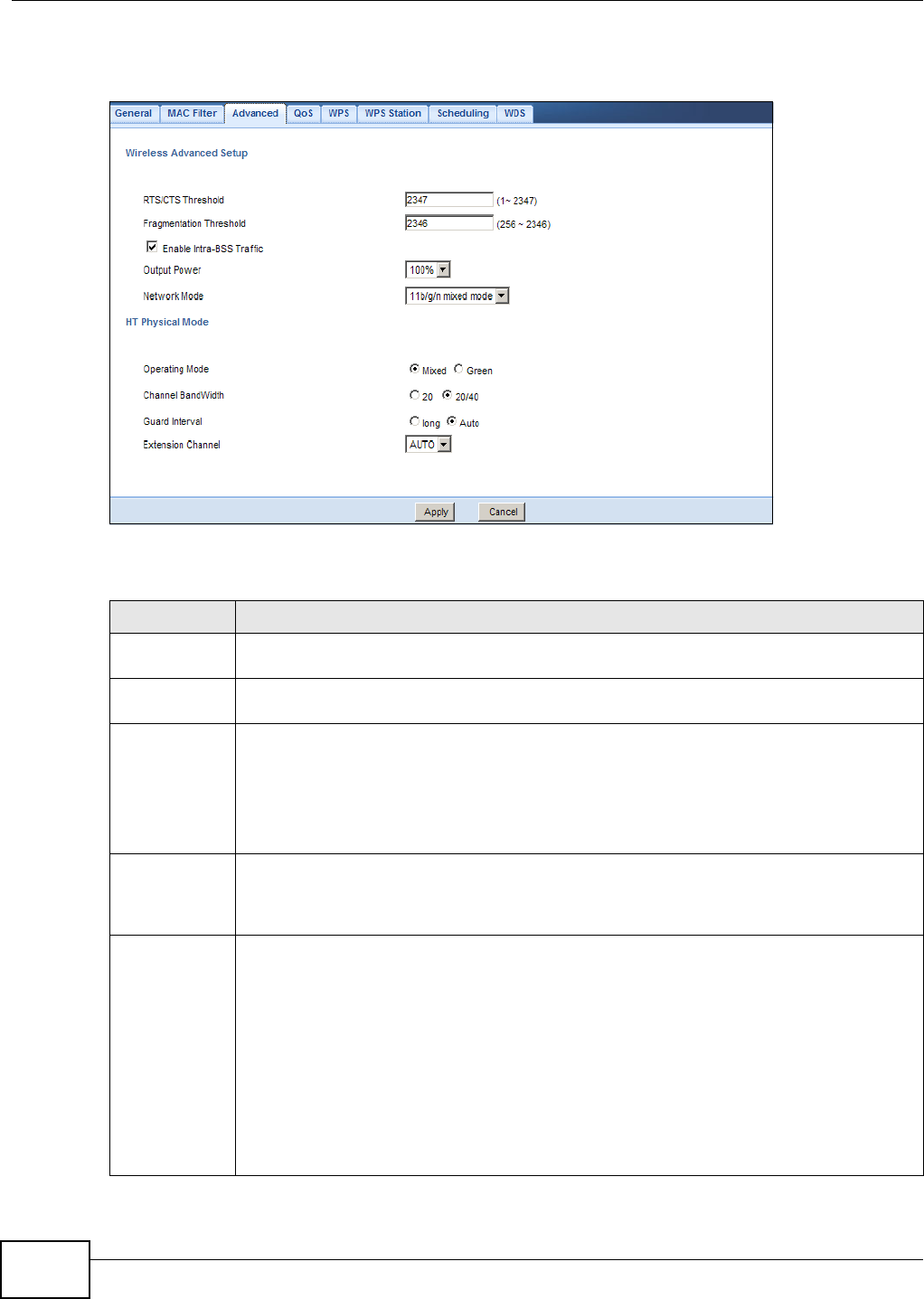
Chapter 13 Wireless LAN
NBG-419N v2 User’s Guide
112
Click Network > Wireless LAN > Advanced. The screen appears as shown.
Figure 79 Network > Wireless LAN > Advanced
The following table describes the labels in this screen.
Table 46 Network > Wireless LAN > Advanced
LABEL DESCRIPTION
RTS/CTS
Threshold
Data with its frame size larger than this value will perform the RTS (Request To Send)/CTS
(Clear To Send) handshake.
Fragmentation
Threshold
The threshold (number of bytes) for the fragmentation boundary for directed messages. It is
the maximum data fragment size that can be sent. Enter an even number.
Enable Intra-
BSS Traffic
A Basic Service Set (BSS) exists when all communications between wireless clients or
between a wireless client and a wired network client go through one access point (AP).
Intra-BSS traffic is traffic between wireless clients in the BSS. When Intra-BSS is enabled,
wireless client A and B can access the wired network and communicate with each other.
When Intra-BSS is disabled, wireless client A and B can still access the wired network but
cannot communicate with each other.
Output Power Set the output power of the Router in this field. If there is a high density of APs in an area,
decrease the output power of the Router to reduce interference with other APs. Select one of
the following 100%, 90%, 75%, 50%, 25%, 10% or Minimum. See the product
specifications for more information on your Router’s output power.
Network Mode Select 11b/g mixed mode to allow IEEE802.11b and IEEE802.11g compliant WLAN devices
to associate with the Router.
Select 802.11b only to allow only IEEE 802.11b compliant WLAN devices to associate with
the Router.
Select 802.11g only to allow only IEEE 802.11g compliant WLAN devices to associate with
the Router.
Select 802.11n only to allow only IEEE 802.11n compliant WLAN devices to associate with
the Router.
Select 11b/g/n mixed mode to allow IEEE802.11b, IEEE802.11g and IEEE802.11n
compliant WLAN devices to associate with the Router.
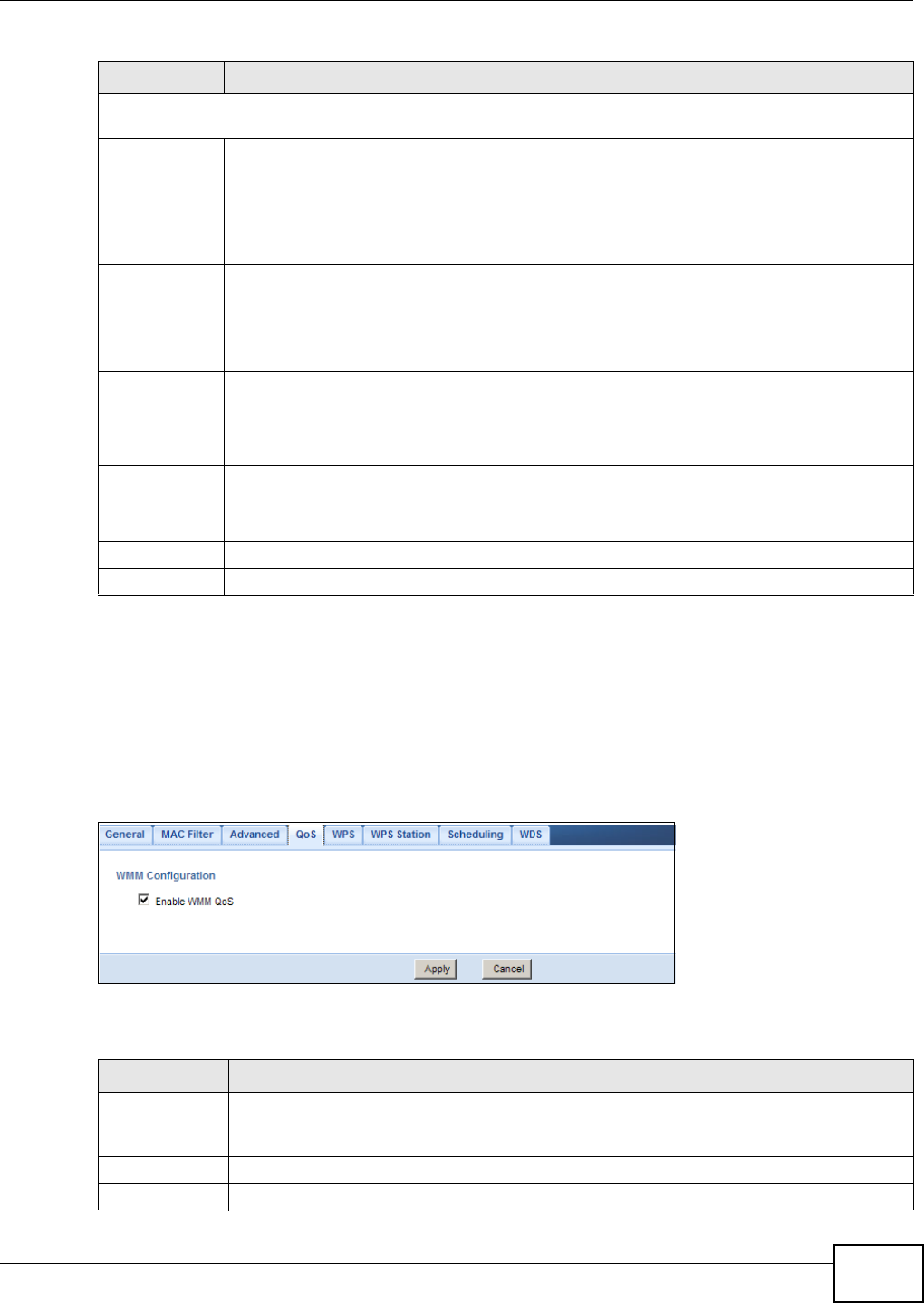
Chapter 13 Wireless LAN
NBG-419N v2 User’s Guide 113
13.7 Quality of Service (QoS) Screen
The QoS screen allows you to automatically give a service (such as VoIP and video) a priority level.
Click Network > Wireless LAN > QoS. The following screen appears.
Figure 80 Network > Wireless LAN > QoS
The following table describes the labels in this screen.
HT (High Throughput) Physical Mode - Use the fields below to configure the 802.11 wireless environment of
your Router.
Operating
Mode
Choose this according to the wireless mode(s) used in your network.
Mixed Mode - Select this if the wireless clients in your network use different wireless modes
(for example, IEEE 802.11b/g and IEEE 802.1n modes)
Green Mode - Select this if the wireless clients in your network uses only one type of
wireless mode (for example, IEEEE 802.11 n only)
Channel
Bandwidth
Select the channel bandwidth you want to use for your wireless network.
It is recommended that you select 20/40 (20/40 MHz).
Select 20 MHz if you want to lessen radio interference with other wireless devices in your
neighborhood.
Guard Interval Select Auto to increase data throughput. However, this may make data transfer more prone
to errors.
Select Long to prioritize data integrity. This may be because your wireless network is busy
and congested or the Router is located in an environment prone to radio interference.
Extension
Channel
This is set to Auto by default.
If you select 20/40 as your Channel Bandwidth, the extension channel enables the Router
to get higher data throughput. This also lowers radio interference and traffic.
Apply Click Apply to save your changes back to the Router.
Cancel Click Cancel to reload the previous configuration for this screen.
Table 46 Network > Wireless LAN > Advanced (continued)
LABEL DESCRIPTION
Table 47 Network > Wireless LAN > QoS
LABEL DESCRIPTION
Enable WMM
QoS
Check this to have the Router automatically give a service a priority level according to the
ToS value in the IP header of packets it sends. WMM QoS (Wifi MultiMedia Quality of
Service) gives high priority to voice and video, which makes them run more smoothly.
Apply Click Apply to save your changes to the Router.
Cancel Click Cancel to reload the previous configuration for this screen.
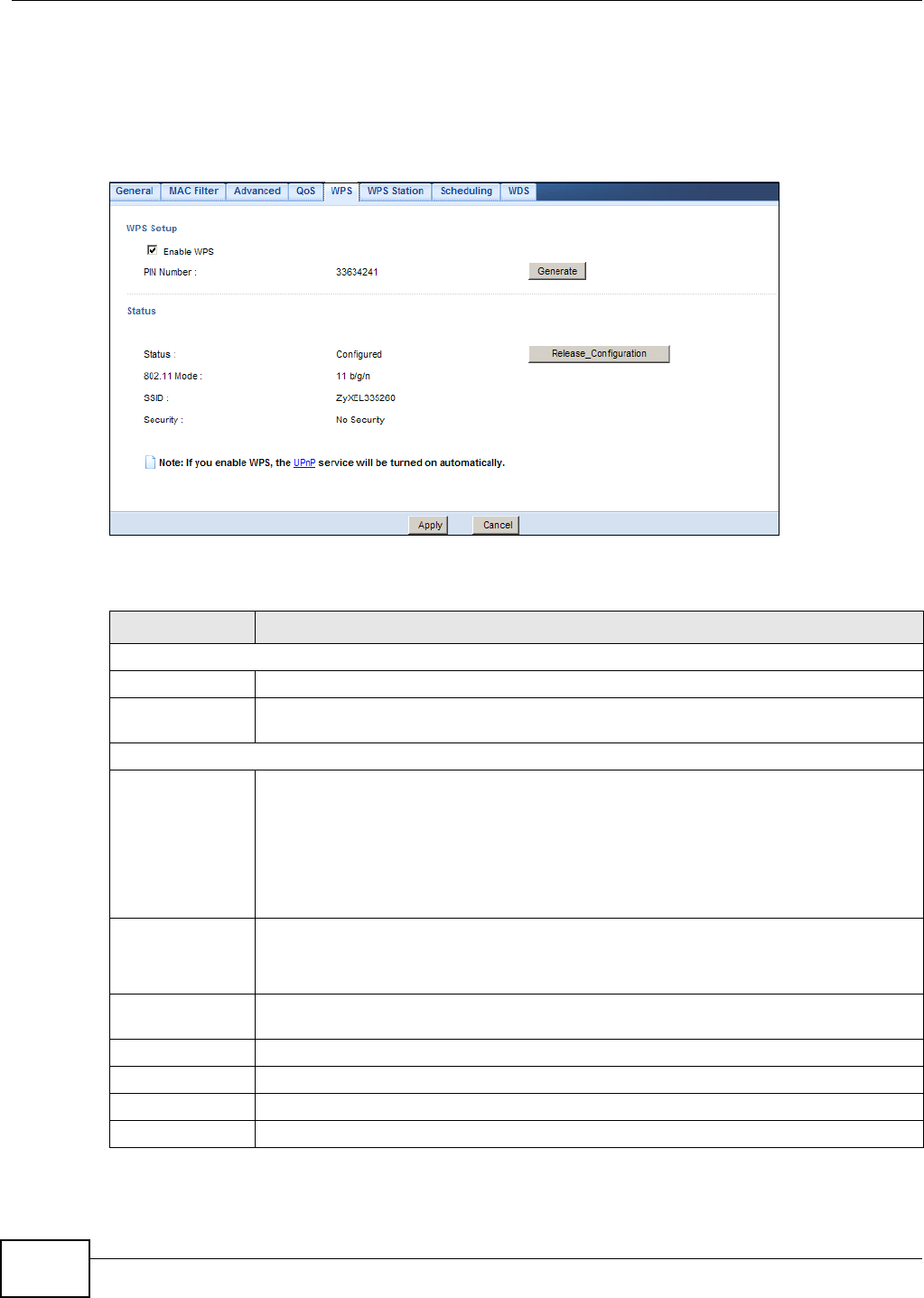
Chapter 13 Wireless LAN
NBG-419N v2 User’s Guide
114
13.8 WPS Screen
Use this screen to enable/disable WPS, view or generate a new PIN number and check current WPS
status. To open this screen, click Network > Wireless LAN > WPS tab.
Figure 81 Network > Wireless LAN > WPS
The following table describes the labels in this screen.
Table 48 Network > Wireless LAN > WPS
LABEL DESCRIPTION
WPS Setup
Enable WPS Select this to enable the WPS feature.
PIN Number This displays a PIN number last time system generated. Click Generate to generate a
new PIN number.
Status
Status This displays Configured when the Router has connected to a wireless network using
WPS or when Enable WPS is selected and wireless or wireless security settings have
been changed. The current wireless and wireless security settings also appear in the
screen.
This displays Unconfigured if WPS is disabled and there are no wireless or wireless
security changes on the Router or you click Release_Configuration to remove the
configured wireless and wireless security settings.
Release
Configuration
This button is only available when the WPS status displays Configured.
Click this button to remove all configured wireless and wireless security settings for WPS
connections on the Router.
802.11 Mode This is the 802.11 mode used. Only compliant WLAN devices can associate with the
Router.
SSID This is the name of the wireless network.
Security This is the type of wireless security employed by the network.
Apply Click Apply to save your changes back to the Router.
Cancel Click Cancel to reload the previous configuration for this screen.
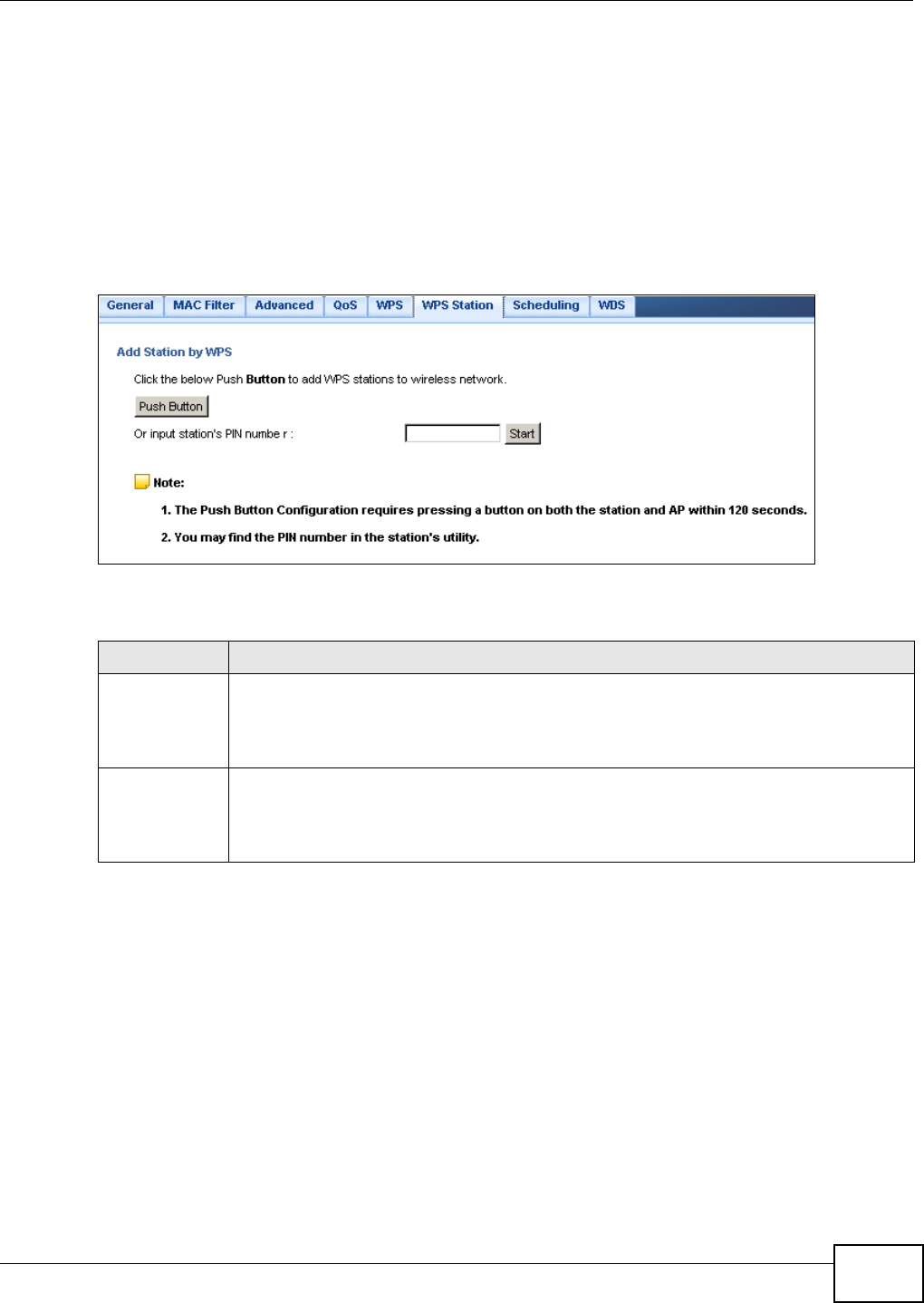
Chapter 13 Wireless LAN
NBG-419N v2 User’s Guide 115
13.9 WPS Station Screen
Use this screen when you want to add a wireless station using WPS. To open this screen, click
Network > Wireless LAN > WPS Station tab.
Note: Note: After you click Push Button on this screen, you have to press a similar
button in the wireless station utility within 2 minutes. To add the second wireless
station, you have to press these buttons on both device and the wireless station
again after the first 2 minutes.
Figure 82 Network > Wireless LAN > WPS Station
The following table describes the labels in this screen.
Table 49 Network > Wireless LAN > WPS Station
LABEL DESCRIPTION
Push Button Use this button when you use the PBC (Push Button Configuration) method to configure
wireless stations’s wireless settings. See Section 12.3.1 on page 90.
Click this to start WPS-aware wireless station scanning and the wireless security information
synchronization.
Or input
station’s PIN
number
Use this button when you use the PIN Configuration method to configure wireless station’s
wireless settings. See Section 12.3.2 on page 91.
Type the same PIN number generated in the wireless station’s utility. Then click Start to
associate to each other and perform the wireless security information synchronization.
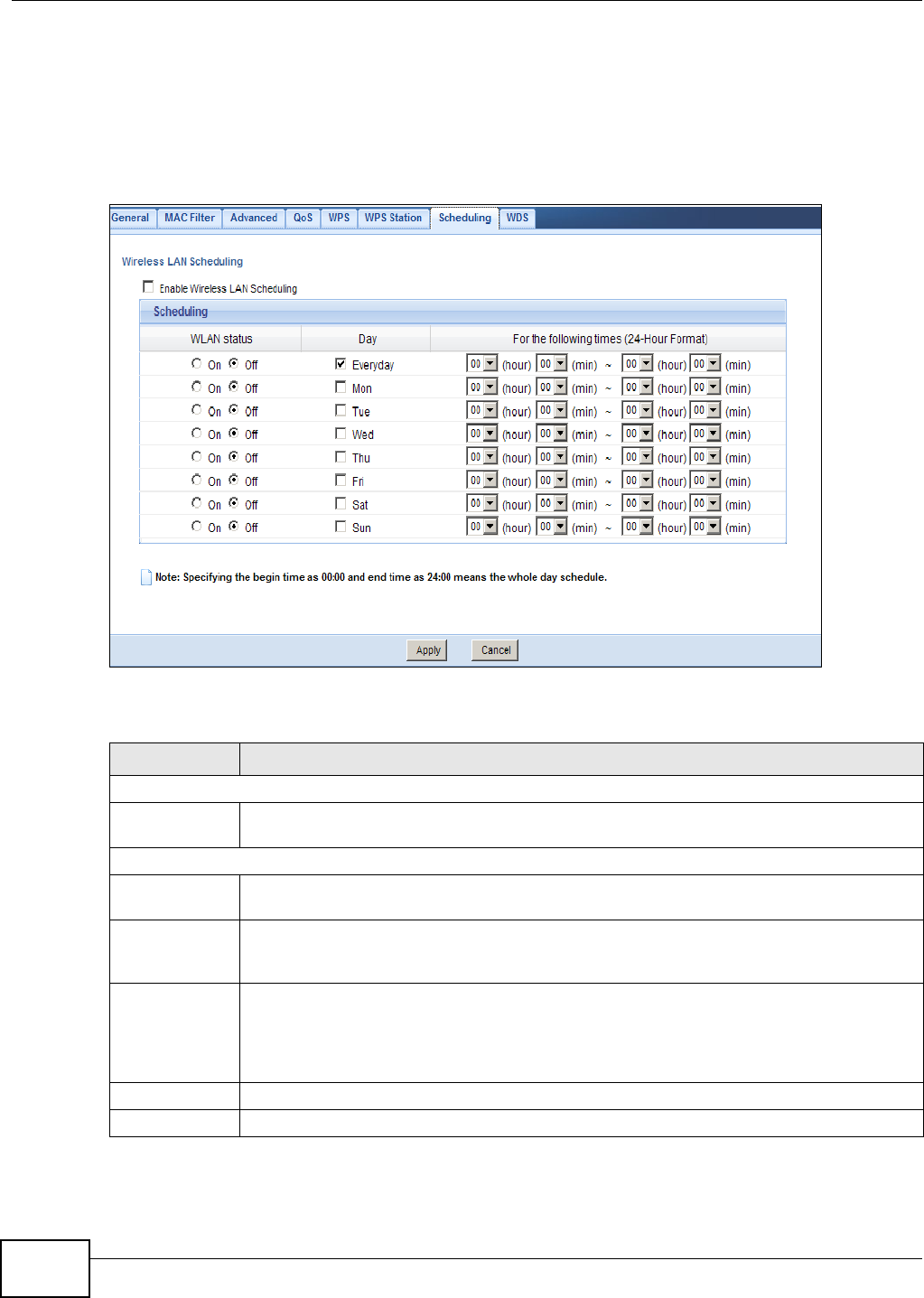
Chapter 13 Wireless LAN
NBG-419N v2 User’s Guide
116
13.10 Scheduling Screen
Use this screen to set the times your wireless LAN is turned on and off. Wireless LAN scheduling is
disabled by default. The wireless LAN can be scheduled to turn on or off on certain days and at
certain times. To open this screen, click Network > Wireless LAN > Scheduling tab.
Figure 83 Network > Wireless LAN > Scheduling
The following table describes the labels in this screen.
Table 50 Network > Wireless LAN > Scheduling
LABEL DESCRIPTION
Wireless LAN Scheduling
Enable Wireless
LAN Scheduling
Select this to enable Wireless LAN scheduling.
Scheduling
WLAN Status Select On or Off to specify whether the Wireless LAN is turned on or off. This field works in
conjunction with the Day and Except for the following times fields.
Day Select Everyday or the specific days to turn the Wireless LAN on or off. If you select
Everyday you can not select any specific days. This field works in conjunction with the
Except for the following times field.
For the
following times
(24-Hour
Format)
Select a begin time using the first set of hour and minute (min) drop down boxes and
select an end time using the second set of hour and minute (min) drop down boxes. If you
have chosen On earlier for the WLAN Status the Wireless LAN will turn on between the two
times you enter in these fields. If you have chosen Off earlier for the WLAN Status the
Wireless LAN will turn off between the two times you enter in these fields.
Apply Click Apply to save your changes back to the Router.
Cancel Click Cancel to reload the previous configuration for this screen.
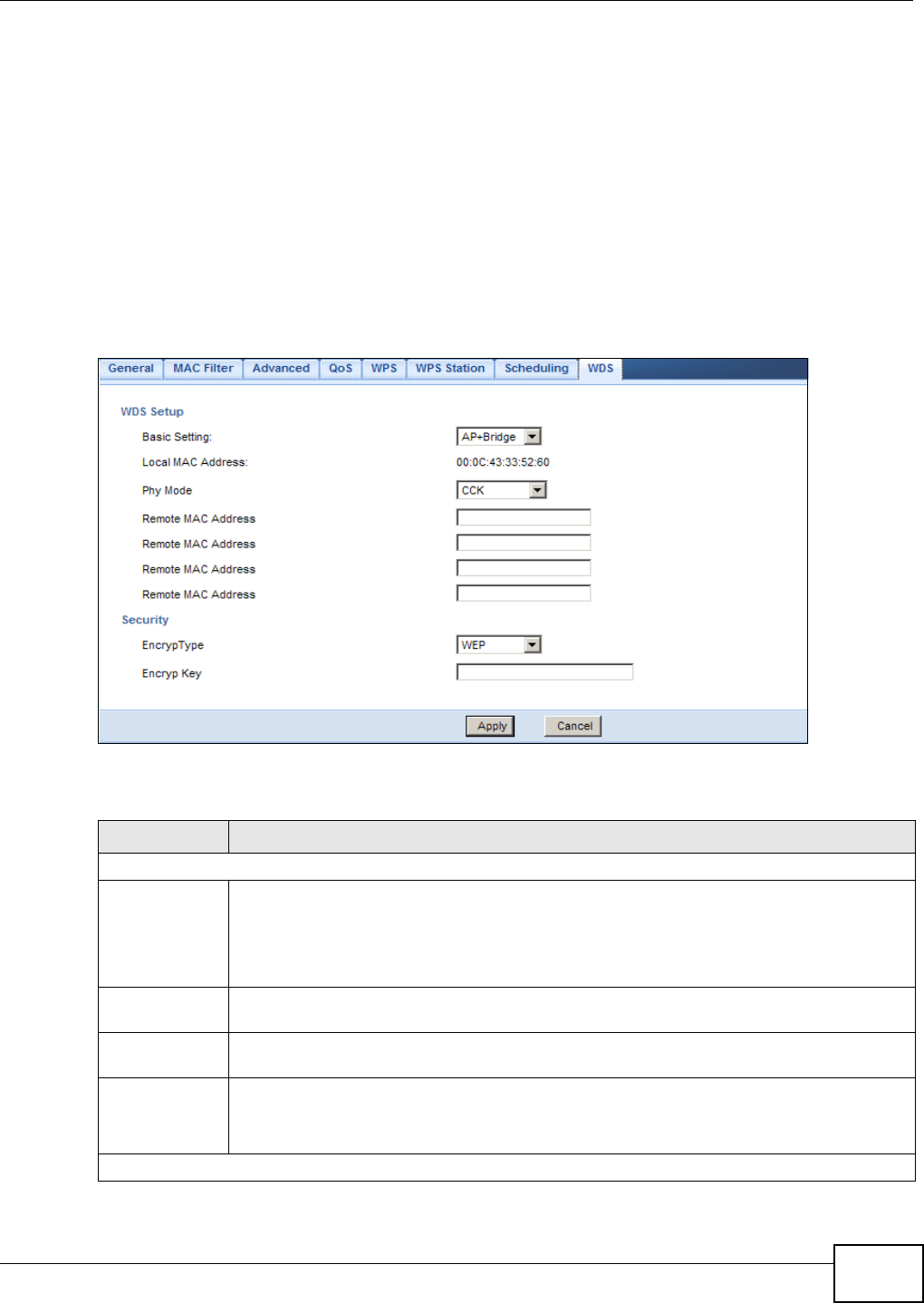
Chapter 13 Wireless LAN
NBG-419N v2 User’s Guide 117
13.11 WDS Screen
A Wireless Distribution System is a wireless connection between two or more APs. Use this screen
to set the operating mode of your Router to AP + Bridge or Bridge Only and establish wireless
links with other APs. You need to know the MAC address of the peer device, which also must be in
bridge mode.
Note: You must enable the same wireless security settings on the Router and on all
wireless clients that you want to associate with it.
Click Network > Wireless LAN > WDS tab. The following screen opens with the Basic Setting
set to Disabled, and Security Mode set to No Security.
Figure 84 Network > Wireless LAN > WDS
The following table describes the labels in this screen.
Table 51 Network > Wireless LAN > WDS
LABEL DESCRIPTION
WDS Setup
Basic Settings Select the operating mode for your Router.
•AP + Bridge - The Router functions as a bridge and access point simultaneously.
•Bridge - The Router acts as a wireless network bridge and establishes wireless links with
other APs. You need to know the MAC address of the peer device, which also must be in
bridge mode. The Router can establish up to five wireless links with other APs.
Local MAC
Address
This is the MAC address of your Router.
Phy Mode Select the Phy mode you want the Router to use. This dictates the maximum size of packets
during data transmission.
Remote MAC
Address
This is the MAC address of the peer device that your Router wants to make a bridge
connection with.
You can connect to up to 4 peer devices.
Security

Chapter 13 Wireless LAN
NBG-419N v2 User’s Guide
118
EncrypType Select whether to use WEP, TKIP or AES encryption for your WDS connection in this field.
Otherwise, select No Security.
EncrypKey The Encryp key is used to encrypt data. Peers must use the same key for data transmission.
Apply Click Apply to save your changes to Router.
Cancel Click Cancel to reload the previous configuration for this screen.
Table 51 Network > Wireless LAN > WDS (continued)
LABEL DESCRIPTION
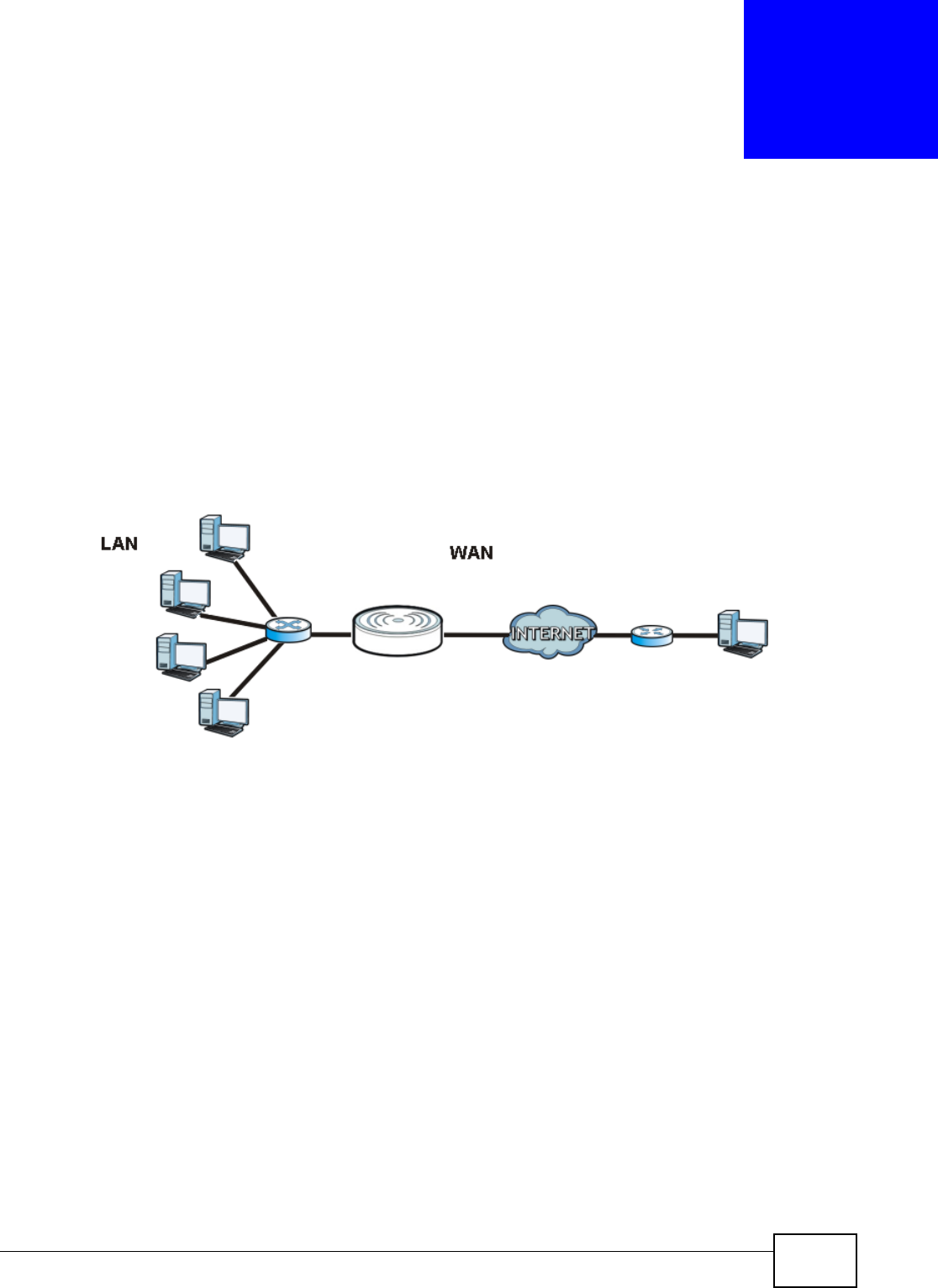
NBG-419N v2 User’s Guide 119
CHAPTER 14
WAN
14.1 Overview
This chapter discusses the Router’s WAN screens. Use these screens to configure your Router for
Internet access.
A WAN (Wide Area Network) connection is an outside connection to another network or the
Internet. It connects your private networks such as a LAN (Local Area Network) and other
networks, so that a computer in one location can communicate with computers in other locations.
Figure 85 LAN and WAN
14.2 What You Can Do
•Use the Internet Connection screen (Section 14.4 on page 121) to enter your ISP information
and set how the computer acquires its IP, DNS and WAN MAC addresses.
•Use the Advanced screen (Section 14.5 on page 130) to enable multicasting, configure Windows
networking and bridge.
•Use IGMP Blocking screen (Section 14.6 on page 131) to enable IGMP blocking in the LAN
ports.
14.3 What You Need To Know
The information in this section can help you configure the screens for your WAN connection, as well
as enable/disable some advanced features of your Router.
Router

Chapter 14 WAN
NBG-419N v2 User’s Guide
120
14.3.1 Configuring Your Internet Connection
Encapsulation Method
Encapsulation is used to include data from an upper layer protocol into a lower layer protocol. To set
up a WAN connection to the Internet, you need to use the same encapsulation method used by your
ISP (Internet Service Provider). If your ISP offers a dial-up Internet connection using PPPoE (PPP
over Ethernet) or PPTP (Point-to-Point Tunneling Protocol), they should also provide a username
and password (and service name) for user authentication.
WAN IP Address
The WAN IP address is an IP address for the Router, which makes it accessible from an outside
network. It is used by the Router to communicate with other devices in other networks. It can be
static (fixed) or dynamically assigned by the ISP each time the Router tries to access the Internet.
If your ISP assigns you a static WAN IP address, they should also assign you the subnet mask and
DNS server IP address(es) (and a gateway IP address if you use the Ethernet or ENET ENCAP
encapsulation method).
DNS Server Address Assignment
Use Domain Name System (DNS) to map a domain name to its corresponding IP address and vice
versa, for instance, the IP address of www.zyxel.com is 204.217.0.2. The DNS server is extremely
important because without it, you must know the IP address of a computer before you can access
it.
The Router can get the DNS server addresses in the following ways.
1The ISP tells you the DNS server addresses, usually in the form of an information sheet, when you
sign up. If your ISP gives you DNS server addresses, manually enter them in the DNS server fields.
2If your ISP dynamically assigns the DNS server IP addresses (along with the Router’s WAN IP
address), set the DNS server fields to get the DNS server address from the ISP.
WAN MAC Address
The MAC address screen allows users to configure the WAN port's MAC address by either using the
factory default or cloning the MAC address from a computer on your LAN. Choose Factory Default
to select the factory assigned default MAC Address.
Otherwise, click Clone the computer's MAC address - IP Address and enter the IP address of
the computer on the LAN whose MAC you are cloning. Once it is successfully configured, the
address will be copied to configuration file. It is recommended that you clone the MAC address prior
to hooking up the WAN Port.
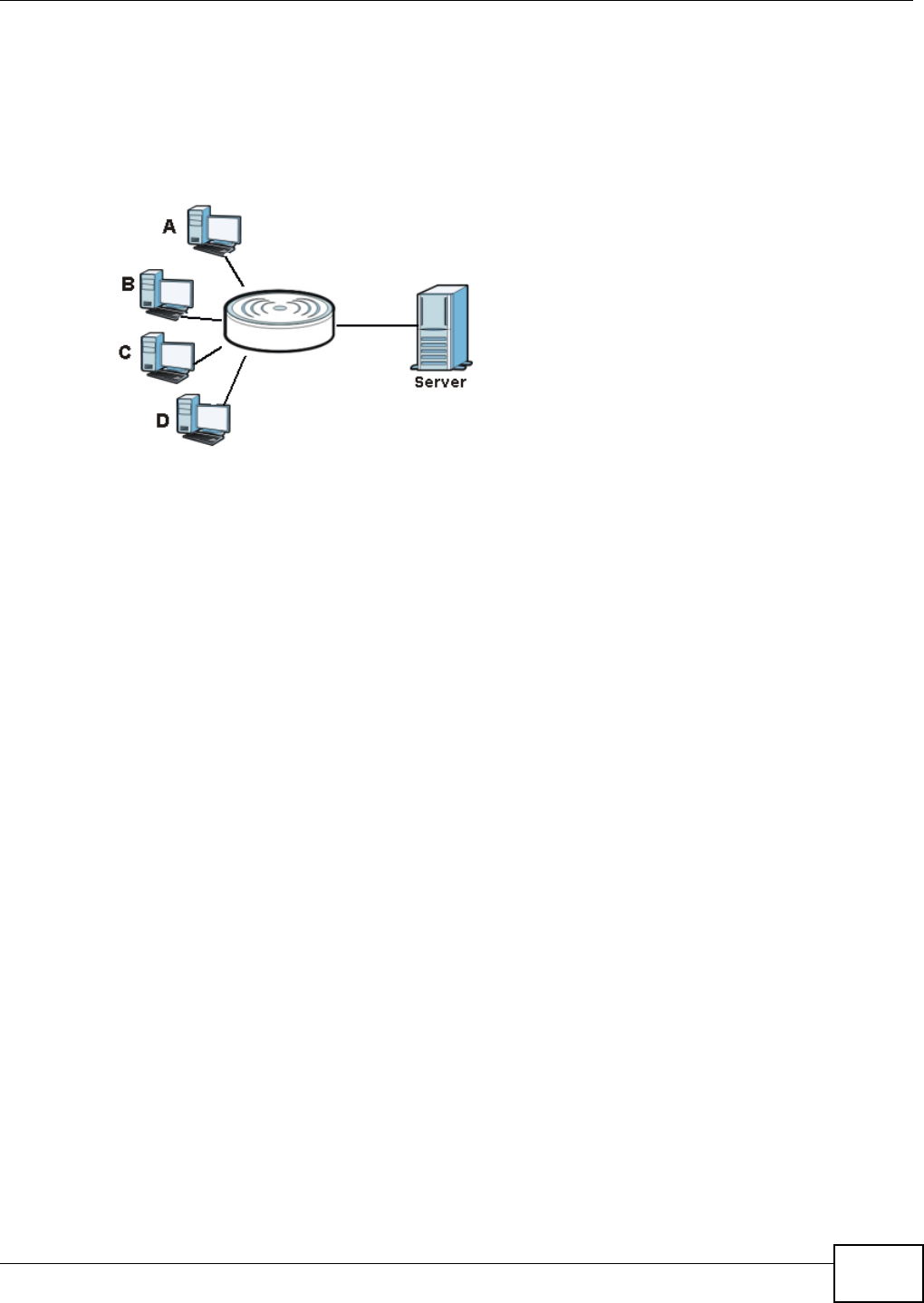
Chapter 14 WAN
NBG-419N v2 User’s Guide 121
14.3.2 Multicast
Traditionally, IP packets are transmitted in one of either two ways - Unicast (1 sender - 1 recipient)
or Broadcast (1 sender - everybody on the network). Multicast delivers IP packets to a group of
hosts on the network - not everybody and not just 1.
Figure 86 Multicast Example
In the multicast example above, systems A and D comprise one multicast group. In multicasting,
the server only needs to send one data stream and this is delivered to systems A and D.
IGMP (Internet Group Multicast Protocol) is a network-layer protocol used to establish membership
in a multicast group - it is not used to carry user data. The Router supports both IGMP version 1
(IGMP-v1) and IGMP version 2 (IGMP-v2).
At start up, the Router queries all directly connected networks to gather group membership. After
that, the Router periodically updates this information. IP multicasting can be enabled/disabled on
the Router LAN and/or WAN interfaces in the Web Configurator (LAN; WAN). Select None to
disable IP multicasting on these interfaces.
14.4 Internet Connection
Use this screen to change your Router’s Internet access settings. Click WAN from the Configuration
menu. The screen differs according to the encapsulation you choose.
14.4.1 Ethernet Encapsulation
Router
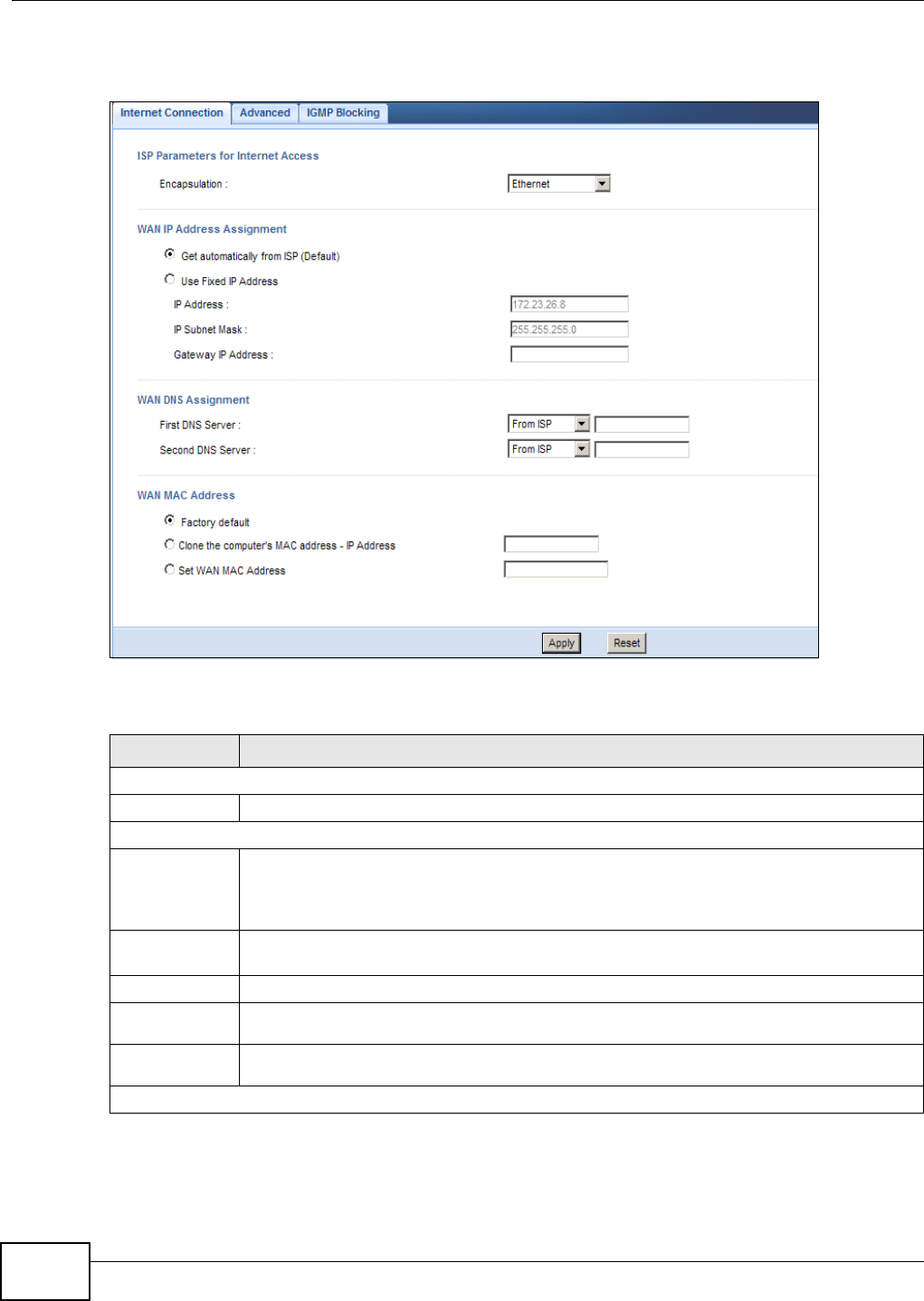
Chapter 14 WAN
NBG-419N v2 User’s Guide
122
This screen displays when you select Ethernet encapsulation.
Figure 87 Network > WAN > Internet Connection: Ethernet Encapsulation
The following table describes the labels in this screen.
Table 52 Network > WAN > Internet Connection: Ethernet Encapsulation
LABEL DESCRIPTION
ISP Parameters for Internet Access
Encapsulation You must choose the Ethernet option when the WAN port is used as a regular Ethernet.
WAN IP Address Assignment
Get
automatically
from ISP
(Default)
Select this option If your ISP did not assign you a fixed IP address. This is the default
selection.
Use Fixed IP
Address
Select this option If the ISP assigned a fixed IP address.
IP Address Enter your WAN IP address in this field if you selected Use Fixed IP Address.
IP Subnet
Mask Enter the IP Subnet Mask in this field.
Gateway IP
Address Enter a Gateway IP Address (if your ISP gave you one) in this field.
WAN DNS Assignment

Chapter 14 WAN
NBG-419N v2 User’s Guide 123
14.4.2 PPPoE Encapsulation
The Router supports PPPoE (Point-to-Point Protocol over Ethernet). PPPoE is an IETF standard (RFC
2516) specifying how a personal computer (PC) interacts with a broadband modem (DSL, cable,
wireless, etc.) connection. The PPP over Ethernet option is for a dial-up connection using PPPoE.
For the service provider, PPPoE offers an access and authentication method that works with existing
access control systems (for example Radius).
One of the benefits of PPPoE is the ability to let you access one of multiple network services, a
function known as dynamic service selection. This enables the service provider to easily create and
offer new IP services for individuals.
Operationally, PPPoE saves significant effort for both you and the ISP or carrier, as it requires no
specific configuration of the broadband modem at the customer site.
By implementing PPPoE directly on the Router (rather than individual computers), the computers on
the LAN do not need PPPoE software installed, since the Router does that part of the task.
Furthermore, with NAT, all of the LANs’ computers will have access.
First DNS
Server
Second DNS
Server
Select From ISP if your ISP dynamically assigns DNS server information (and the Router's
WAN IP address). The field to the right displays the (read-only) DNS server IP address that
the ISP assigns.
Select User-Defined if you have the IP address of a DNS server. Enter the DNS server's IP
address in the field to the right. If you chose User-Defined, but leave the IP address set to
0.0.0.0, User-Defined changes to None after you click Apply. If you set a second choice
to User-Defined, and enter the same IP address, the second User-Defined changes to
None after you click Apply.
Select None if you do not want to configure DNS servers. If you do not configure a DNS
server, you must know the IP address of a computer in order to access it.
WAN MAC
Address
The MAC address section allows users to configure the WAN port's MAC address by either
using the Router’s MAC address, copying the MAC address from a computer on your LAN or
manually entering a MAC address.
Factory default Select Factory default to use the factory assigned default MAC Address.
Clone the
computer’s
MAC address -
IP Address
Select Clone the computer's MAC address - IP Address and enter the IP address of the
computer on the LAN whose MAC you are cloning.
Set WAN MAC
Address
Select this option and enter the MAC address you want to use.
Apply Click Apply to save your changes back to the Router.
Reset Click Reset to begin configuring this screen afresh.
Table 52 Network > WAN > Internet Connection: Ethernet Encapsulation (continued)
LABEL DESCRIPTION
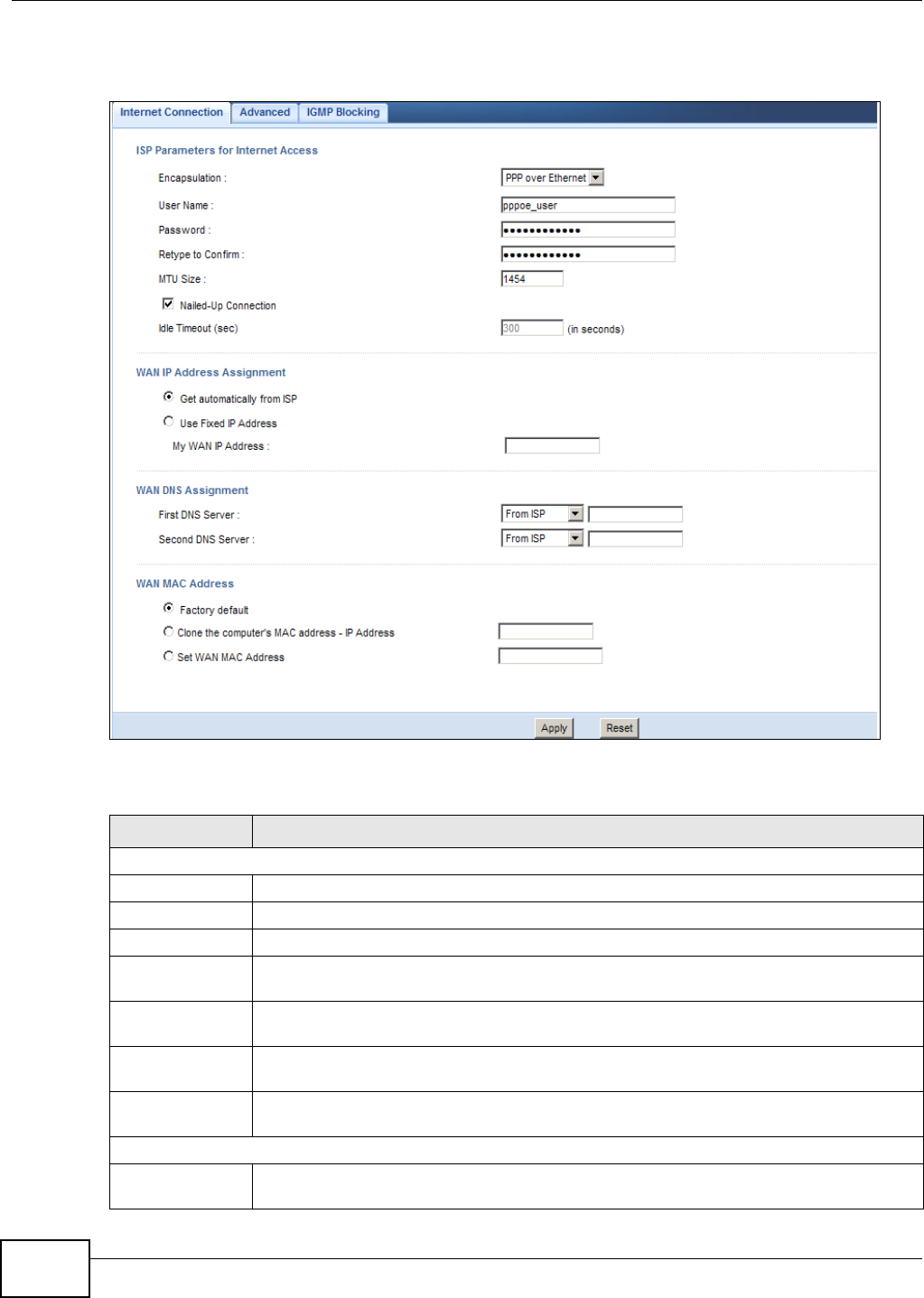
Chapter 14 WAN
NBG-419N v2 User’s Guide
124
This screen displays when you select PPPoE encapsulation.
Figure 88 Network > WAN > Internet Connection: PPPoE Encapsulation
The following table describes the labels in this screen.
Table 53 Network > WAN > Internet Connection: PPPoE Encapsulation
LABEL DESCRIPTION
ISP Parameters for Internet Access
Encapsulation Select PPP over Ethernet if you connect to your Internet via dial-up.
User Name Type the user name given to you by your ISP.
Password Type the password associated with the user name above.
Retype to
Confirm
Type your password again to make sure that you have entered is correctly.
MTU Size Enter the Maximum Transmission Unit (MTU) or the largest packet size per frame that your
Router can receive and process.
Nailed-Up
Connection
Select Nailed-Up Connection if you do not want the connection to time out.
Idle Timeout
(sec)
This value specifies the time in minutes that elapses before the router automatically
disconnects from the PPPoE server.
WAN IP Address Assignment
Get automatically
from ISP
Select this option If your ISP did not assign you a fixed IP address. This is the default
selection.

Chapter 14 WAN
NBG-419N v2 User’s Guide 125
14.4.3 PPTP Encapsulation
Point-to-Point Tunneling Protocol (PPTP) is a network protocol that enables secure transfer of data
from a remote client to a private server, creating a Virtual Private Network (VPN) using TCP/IP-
based networks.
PPTP supports on-demand, multi-protocol and virtual private networking over public networks, such
as the Internet.
Use Fixed IP
Address
Select this option If the ISP assigned a fixed IP address.
My WAN IP
Address Enter your WAN IP address in this field if you selected Use Fixed IP Address.
WAN DNS Assignment
First DNS Server
Second DNS
Server
Select From ISP if your ISP dynamically assigns DNS server information (and the
Router's WAN IP address). The field to the right displays the (read-only) DNS server IP
address that the ISP assigns.
Select User-Defined if you have the IP address of a DNS server. Enter the DNS server's
IP address in the field to the right. If you chose User-Defined, but leave the IP address
set to 0.0.0.0, User-Defined changes to None after you click Apply. If you set a second
choice to User-Defined, and enter the same IP address, the second User-Defined
changes to None after you click Apply.
Select None if you do not want to configure DNS servers. If you do not configure a DNS
server, you must know the IP address of a computer in order to access it.
WAN MAC
Address
The MAC address section allows users to configure the WAN port's MAC address by using
the Router’s MAC address, copying the MAC address from a computer on your LAN or
manually entering a MAC address.
Factory default Select Factory default to use the factory assigned default MAC Address.
Clone the
computer’s MAC
address - IP
Address
Select Clone the computer's MAC address - IP Address and enter the IP address of
the computer on the LAN whose MAC you are cloning.
Set WAN MAC
Address
Select this option and enter the MAC address you want to use.
Apply Click Apply to save your changes back to the Router.
Reset Click Reset to begin configuring this screen afresh.
Table 53 Network > WAN > Internet Connection: PPPoE Encapsulation (continued)
LABEL DESCRIPTION
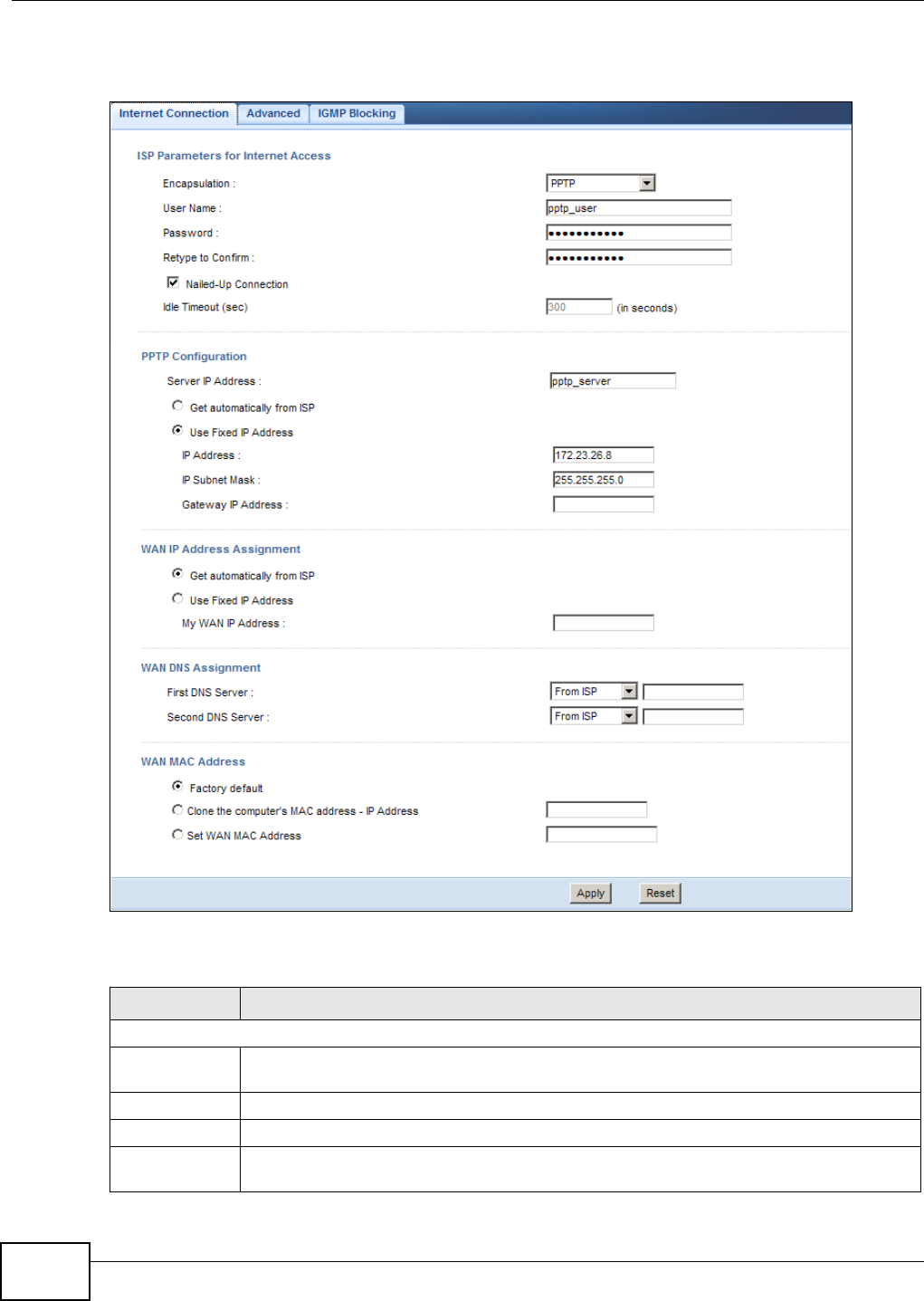
Chapter 14 WAN
NBG-419N v2 User’s Guide
126
This screen displays when you select PPTP encapsulation.
Figure 89 Network > WAN > Internet Connection: PPTP Encapsulation
The following table describes the labels in this screen.
Table 54 Network > WAN > Internet Connection: PPTP Encapsulation
LABEL DESCRIPTION
ISP Parameters for Internet Access
Connection
Type
To configure a PPTP client, you must configure the User Name and Password fields for a
PPP connection and the PPTP parameters for a PPTP connection.
User Name Type the user name given to you by your ISP.
Password Type the password associated with the User Name above.
Retype to
Confirm
Type your password again to make sure that you have entered is correctly.

Chapter 14 WAN
NBG-419N v2 User’s Guide 127
Nailed-up
Connection
Select Nailed-Up Connection if you do not want the connection to time out.
Idle Timeout This value specifies the time in minutes that elapses before the Router automatically
disconnects from the PPTP server.
PPTP Configuration
Server IP
Address
Type the IP address of the PPTP server.
Get
automatically
from ISP
Select this option If your ISP did not assign you a fixed IP address. This is the default
selection.
Use Fixed IP
Address
Select this option If the ISP assigned a fixed IP address.
IP Address Enter your WAN IP address in this field if you selected Use Fixed IP Address.
IP Subnet
Mask Your Router will automatically calculate the subnet mask based on the IP address that you
assign. Unless you are implementing subnetting, use the subnet mask computed by the
Router.
Gateway IP
Address Enter a Gateway IP Address (if your ISP gave you one) in this field.
WAN IP Address Assignment
Get
automatically
from ISP
Select this to get your WAN IP address from your ISP.
Use Fixed IP
Address
Select this option If the ISP assigned a fixed IP address.
My WAN IP
Address Enter your WAN IP address in this field if you selected Use Fixed IP Address.
WAN DNS Assignment
First DNS
Server
Second DNS
Server
Select From ISP if your ISP dynamically assigns DNS server information (and the Router's
WAN IP address). The field to the right displays the (read-only) DNS server IP address that
the ISP assigns.
Select User-Defined if you have the IP address of a DNS server. Enter the DNS server's IP
address in the field to the right. If you chose User-Defined, but leave the IP address set to
0.0.0.0, User-Defined changes to None after you click Apply. If you set a second choice
to User-Defined, and enter the same IP address, the second User-Defined changes to
None after you click Apply.
Select None if you do not want to configure DNS servers. If you do not configure a DNS
server, you must know the IP address of a computer in order to access it.
WAN MAC
Address
The MAC address section allows users to configure the WAN port's MAC address by either
using the Router’s MAC address, copying the MAC address from a computer on your LAN or
manually entering a MAC address.
Factory default Select Factory default to use the factory assigned default MAC Address.
Clone the
computer’s
MAC address -
IP Address
Select Clone the computer's MAC address - IP Address and enter the IP address of the
computer on the LAN whose MAC you are cloning.
Set WAN MAC
Address
Select this option and enter the MAC address you want to use.
Apply Click Apply to save your changes back to the Router.
Reset Click Reset to begin configuring this screen afresh.
Table 54 Network > WAN > Internet Connection: PPTP Encapsulation (continued)
LABEL DESCRIPTION
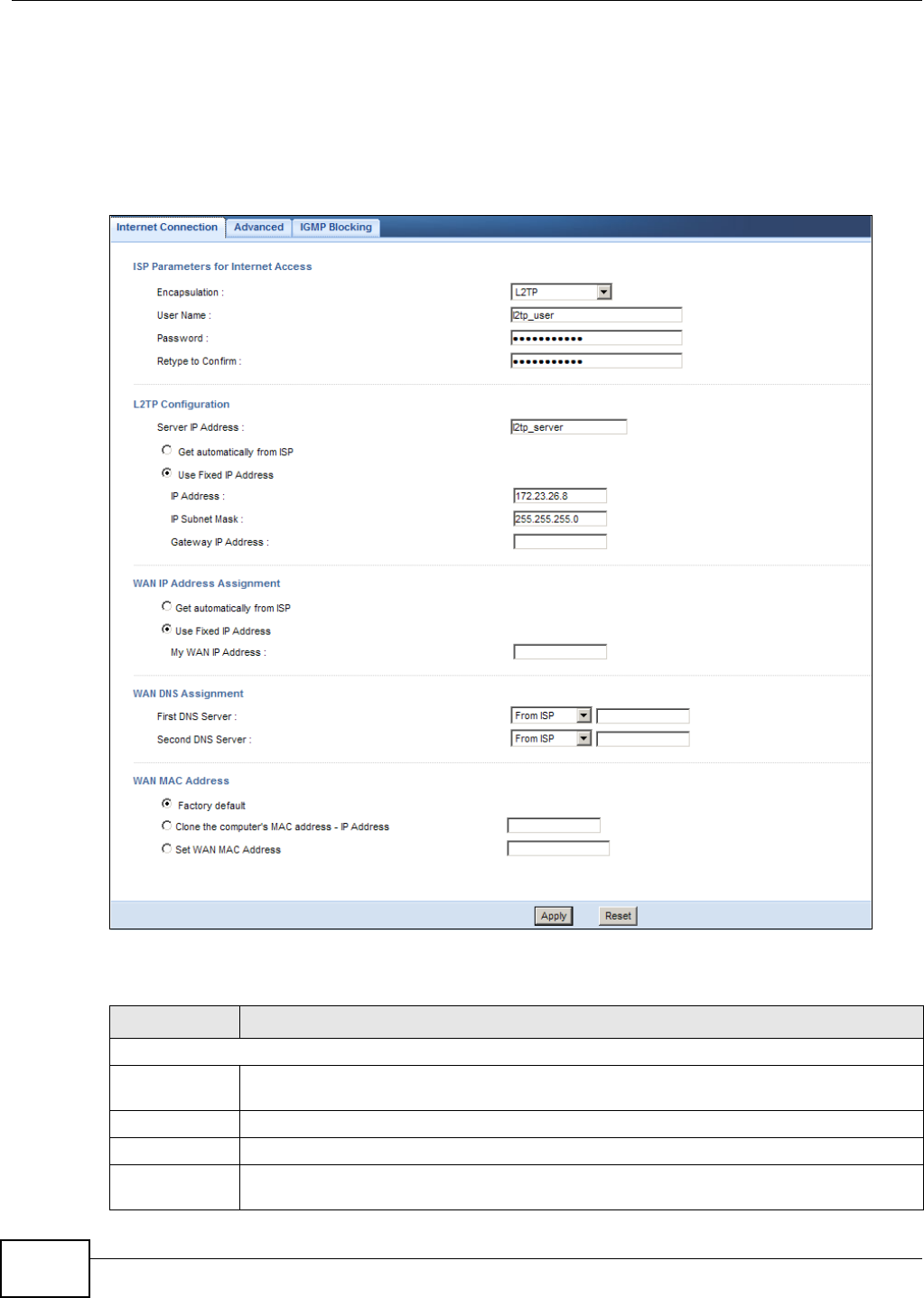
Chapter 14 WAN
NBG-419N v2 User’s Guide
128
14.4.4 L2TP Encapsulation
The Layer 2 Tunneling Protocol (L2TP) works at layer 2 (the data link layer) to tunnel network traffic
between two peer devices over another network (like the Internet).
This screen displays when you select L2TP encapsulation.
Figure 90 Network > WAN > Internet Connection: L2TP Encapsulation
The following table describes the labels in this screen.
Table 55 Network > WAN > Internet Connection: L2TP Encapsulation
LABEL DESCRIPTION
ISP Parameters for Internet Access
Connection
Type
To configure a L2TP client, you must configure the User Name and Password fields for a
layer-2 connection and the L2TP parameters for an L2TP connection.
User Name Type the user name given to you by your ISP.
Password Type the password associated with the User Name above.
Retype to
Confirm
Type your password again to make sure that you have entered is correctly.

Chapter 14 WAN
NBG-419N v2 User’s Guide 129
L2TP Configuration
Server IP
Address
Type the IP address of the L2TP server.
Get
automatically
from ISP
Select this option If your ISP did not assign you a fixed IP address. This is the default
selection.
Use Fixed IP
Address
Select this option If the ISP assigned a fixed IP address.
IP Address Enter your WAN IP address in this field if you selected Use Fixed IP Address.
IP Subnet
Mask Your Router will automatically calculate the subnet mask based on the IP address that you
assign. Unless you are implementing subnetting, use the subnet mask computed by the
Router.
Gateway IP
Address Enter a Gateway IP Address (if your ISP gave you one) in this field.
WAN IP Address Assignment
Get
automatically
from ISP
Select this to get your WAN IP address from your ISP.
Use Fixed IP
Address
Select this option If the ISP assigned a fixed IP address.
My WAN IP
Address Enter your WAN IP address in this field if you selected Use Fixed IP Address.
WAN DNS Assignment
First DNS
Server
Second DNS
Server
Select From ISP if your ISP dynamically assigns DNS server information (and the Router's
WAN IP address). The field to the right displays the (read-only) DNS server IP address that
the ISP assigns.
Select User-Defined if you have the IP address of a DNS server. Enter the DNS server's IP
address in the field to the right. If you chose User-Defined, but leave the IP address set to
0.0.0.0, User-Defined changes to None after you click Apply. If you set a second choice to
User-Defined, and enter the same IP address, the second User-Defined changes to None
after you click Apply.
Select None if you do not want to configure DNS servers. If you do not configure a DNS
server, you must know the IP address of a computer in order to access it.
WAN MAC
Address
The MAC address section allows users to configure the WAN port's MAC address by either
using the Router’s MAC address, copying the MAC address from a computer on your LAN or
manually entering a MAC address.
Factory default Select Factory default to use the factory assigned default MAC Address.
Clone the
computer’s
MAC address -
IP Address
Select Clone the computer's MAC address - IP Address and enter the IP address of the
computer on the LAN whose MAC you are cloning.
Set WAN MAC
Address
Select this option and enter the MAC address you want to use.
Apply Click Apply to save your changes back to the Router.
Reset Click Reset to begin configuring this screen afresh.
Table 55 Network > WAN > Internet Connection: L2TP Encapsulation (continued)
LABEL DESCRIPTION
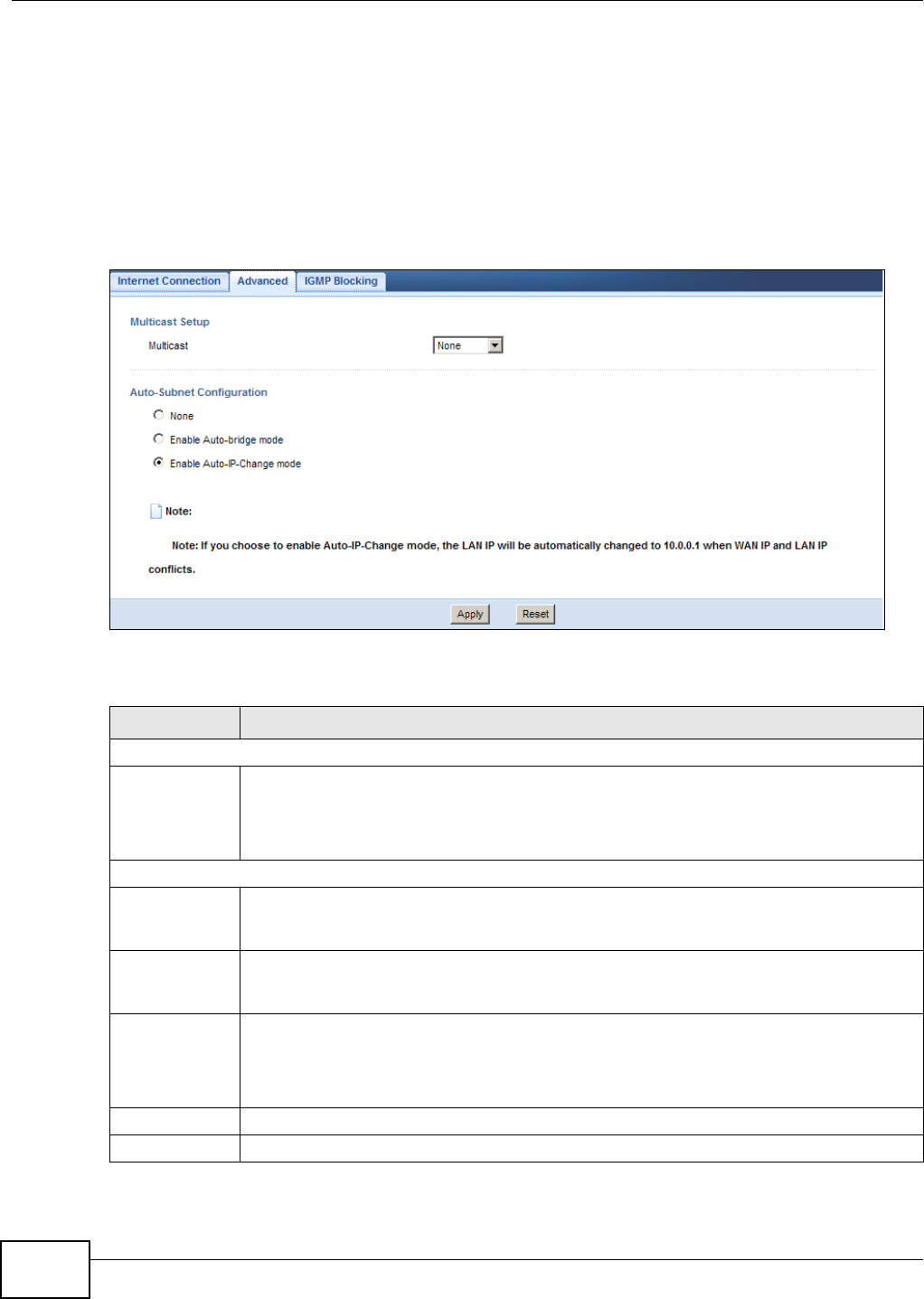
Chapter 14 WAN
NBG-419N v2 User’s Guide
130
14.5 Advanced WAN Screen
Use this screen to enable Multicast and enable Auto-bridge.
Note: The categories shown in this screen are independent of each other.
To change your Router’s advanced WAN settings, click Network > WAN > Advanced. The screen
appears as shown.
Figure 91 Network > WAN > Advanced
The following table describes the labels in this screen.
Table 56 Network > WAN > Advanced
LABEL DESCRIPTION
Multicast Setup
Multicast Select IGMPv1/v2 to enable multicasting. This applies to traffic routed from the WAN to
the LAN.
Select None to disable this feature. This may cause incoming traffic to be dropped or sent
to all connected network devices.
Auto-Subnet Setup
None Select this option to have the Router do nothing when it gets a WAN IP address in the range
of 192.168.x.y (where x and y are from zero to nine) or in the same subnet as the LAN IP
address.
Enable Auto-
bridge mode
Select this option to have the Router switch to bridge mode automatically when the Router
gets a WAN IP address in the range of 192.168.x.y (where x and y are from zero to nine) no
matter what the LAN IP address is.
Enable Auto-IP-
Change mode
Select this option to have the Router change its LAN IP address to 10.0.0.1 or 192.168.1.1
accordingly when the Router gets a dynamic WAN IP address in the same subnet as the LAN
IP address 192.168.1.1 or 10.0.0.1.
The NAT, DHCP server and firewall functions on the Router are still available in thismode.
Apply Click Apply to save your changes back to the Router.
Reset Click Reset to begin configuring this screen afresh.
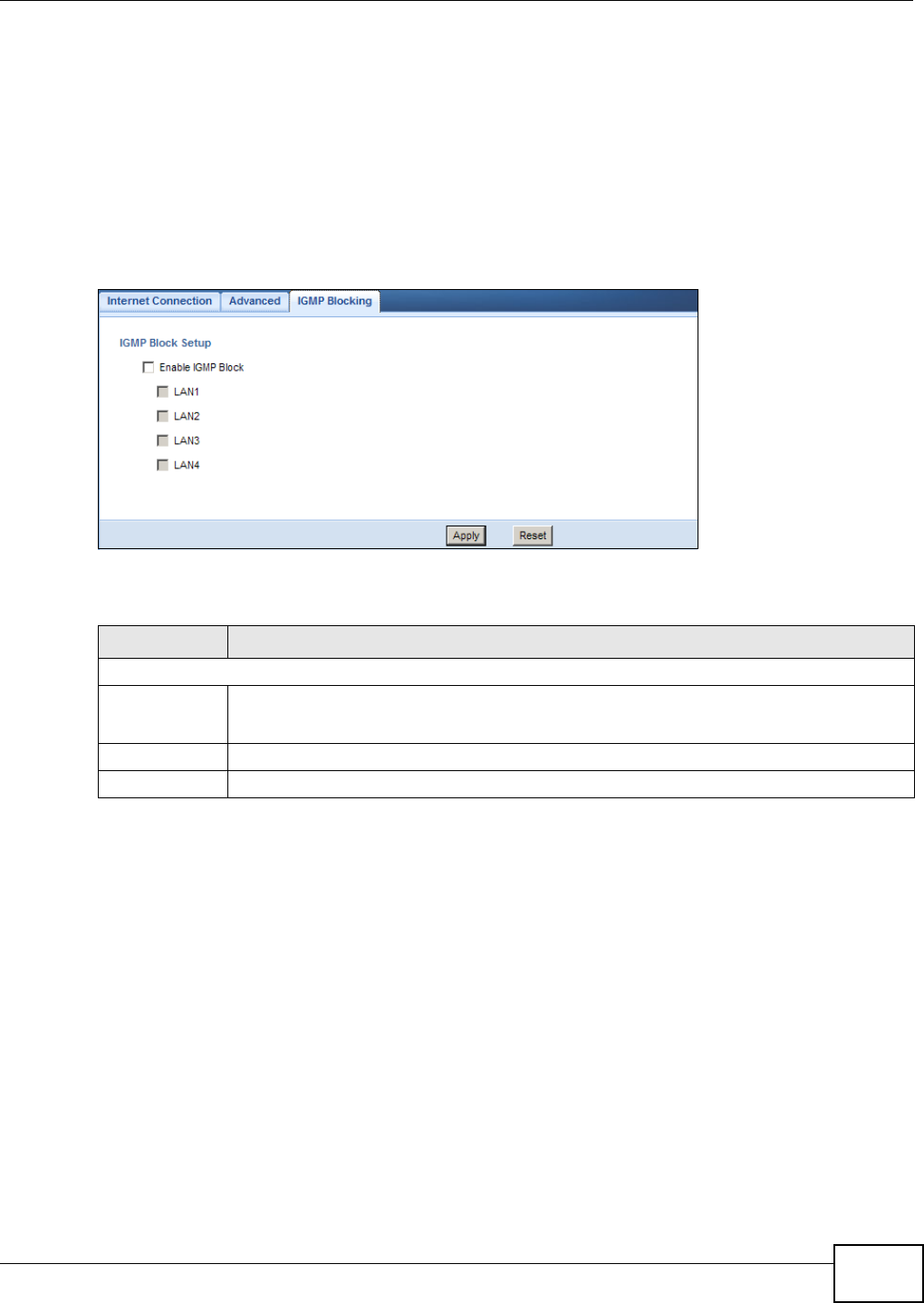
Chapter 14 WAN
NBG-419N v2 User’s Guide 131
14.6 IGMP Blocking Screen
Use this screen to enable IGMP blocking (snooping) if you have LAN users that subscribe to
multicast services.
IGMP (Internet Group Multicast Protocol) is a network-layer protocol used to establish membership
in a multicast group - it is not used to carry user data.
Click Network > WAN > IGMP Blocking. The screen appears as shown.
Figure 92 Network > WAN > IGMP Blocking
The following table describes the labels in this screen.
Table 57 Network > WAN > IGMP Blocking
LABEL DESCRIPTION
IGMP Block Setup
Enable IGMP
Block
Select this option to have the Router use IGMP blocking (snooping).
Check the LAN port/s to which IGMP snooping applies.
Apply Click Apply to save your changes back to the Router.
Reset Click Reset to begin configuring this screen afresh.

Chapter 14 WAN
NBG-419N v2 User’s Guide
132
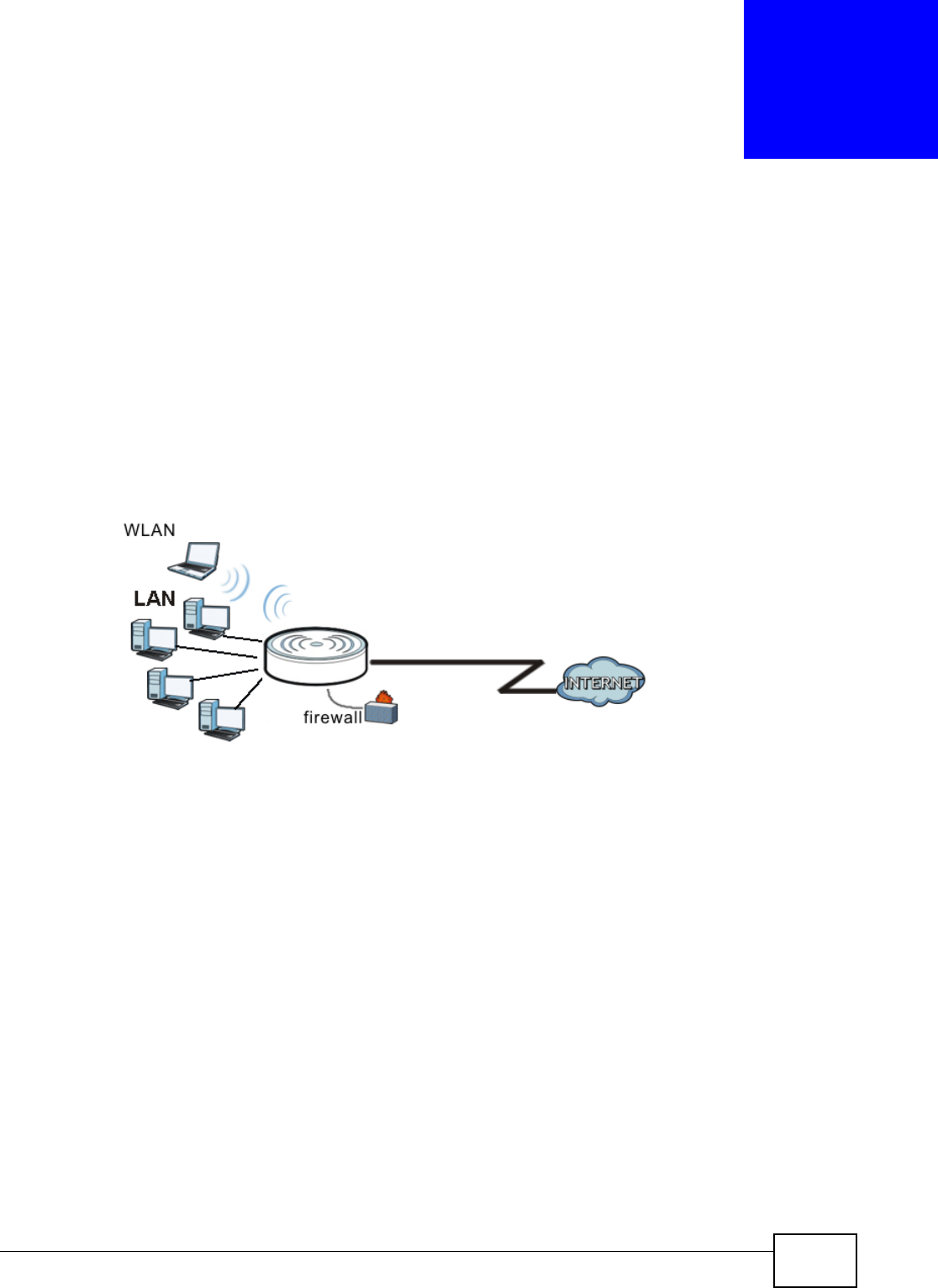
NBG-419N v2 User’s Guide 133
CHAPTER 15
LAN
15.1 Overview
This chapter describes how to configure LAN settings.
A Local Area Network (LAN) is a shared communication system to which many computers are
attached. A LAN is a computer network limited to the immediate area, usually the same building or
floor of a building. The LAN screens can help you configure a LAN DHCP server, manage IP
addresses, and partition your physical network into logical networks.
Figure 93 LAN Example
The LAN screens can help you manage IP addresses.
15.2 What You Can Do
•Use the IP screen (Section 15.4 on page 135) to change the IP address for your Router.
•Use the IP Alias screen (Section 15.5 on page 135) to have the Router apply IP alias to create
LAN subnets.
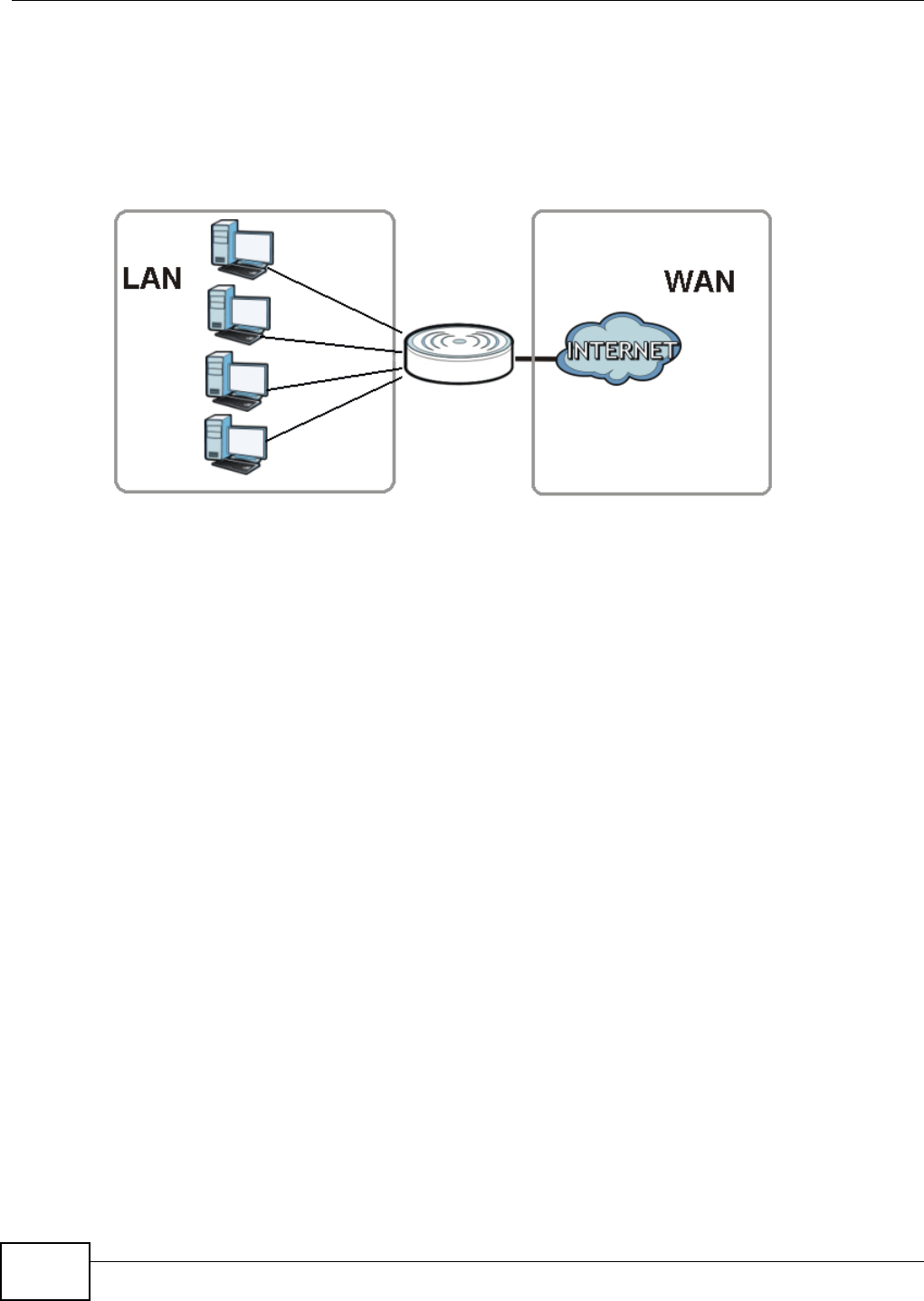
Chapter 15 LAN
NBG-419N v2 User’s Guide
134
15.3 What You Need To Know
The actual physical connection determines whether the Router ports are LAN or WAN ports. There
are two separate IP networks, one inside the LAN network and the other outside the WAN network
as shown next.
Figure 94 LAN and WAN IP Addresses
The LAN parameters of the Router are preset in the factory with the following values:
• IP address of 192.168.1.1 with subnet mask of 255.255.255.0 (24 bits)
• DHCP server enabled with 32 client IP addresses starting from 192.168.1.33.
These parameters should work for the majority of installations. If your ISP gives you explicit DNS
server address(es), read the embedded Web Configurator help regarding what fields need to be
configured.
15.3.1 IP Pool Setup
The Router is pre-configured with a pool of 32 IP addresses starting from 192.168.1.33 to
192.168.1.64. This configuration leaves 31 IP addresses (excluding the Router itself) in the lower
range (192.168.1.2 to 192.168.1.32) for other server computers, for instance, servers for mail,
FTP, TFTP, web, etc., that you may have.
15.3.2 LAN TCP/IP
The Router has built-in DHCP server capability that assigns IP addresses and DNS servers to
systems that support DHCP client capability.
15.3.3 IP Alias
IP alias allows you to partition a physical network into different logical networks over the same
Ethernet interface. The Router supports three logical LAN interfaces via its single physical Ethernet
interface with the Router itself as the gateway for each LAN network.
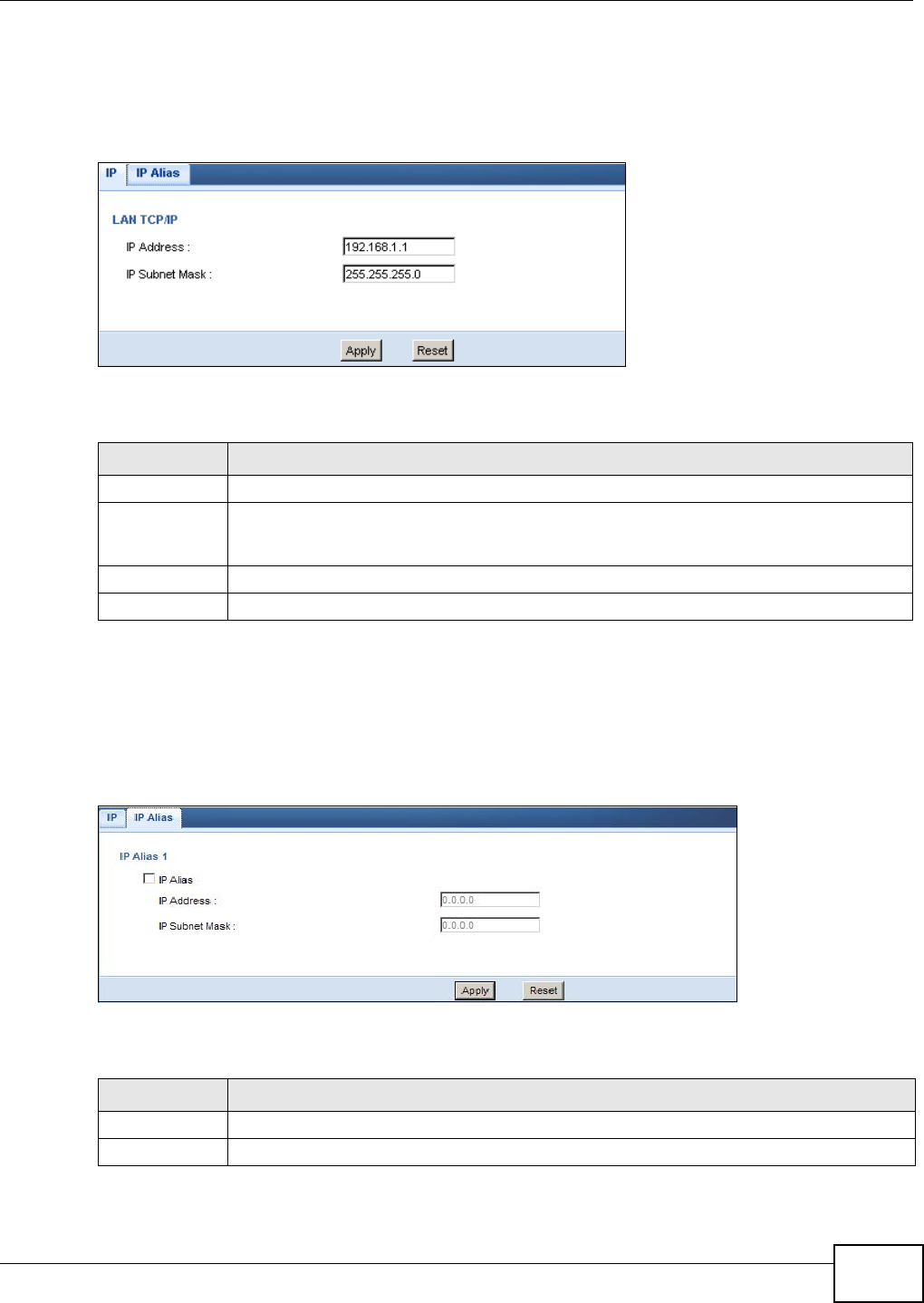
Chapter 15 LAN
NBG-419N v2 User’s Guide 135
15.4 LAN IP Screen
Use this screen to change the IP address for your Router. Click Network > LAN > IP.
Figure 95 Network > LAN > IP
The following table describes the labels in this screen.
15.5 IP Alias Screen
Use this screen to have the Router apply IP alias to create LAN subnets. Click LAN > IP Alias.
Figure 96 Network > LAN > IP Alias
The following table describes the labels in this screen.
Table 58 Network > LAN > IP
LABEL DESCRIPTION
IP Address Type the IP address of your Router in dotted decimal notation.
IP Subnet Mask The subnet mask specifies the network number portion of an IP address. Your Router will
automatically calculate the subnet mask based on the IP address that you assign. Unless
you are implementing subnetting, use the subnet mask computed by the Router.
Apply Click Apply to save your changes back to the Router.
Reset Click Reset to begin configuring this screen afresh.
Table 59 Network > LAN > IP Alias
LABEL DESCRIPTION
IP Alias Check this to enable IP alias.
IP Address Type the IP alias address of your Router in dotted decimal notation.

Chapter 15 LAN
NBG-419N v2 User’s Guide
136
IP Subnet Mask The subnet mask specifies the network number portion of an IP address. Your Router will
automatically calculate the subnet mask based on the IP address that you assign. Unless
you are implementing subnetting, use the subnet mask computed by the Router.
Apply Click Apply to save your changes back to the Router.
Reset Click Reset to begin configuring this screen afresh.
Table 59 Network > LAN > IP Alias (continued)
LABEL DESCRIPTION
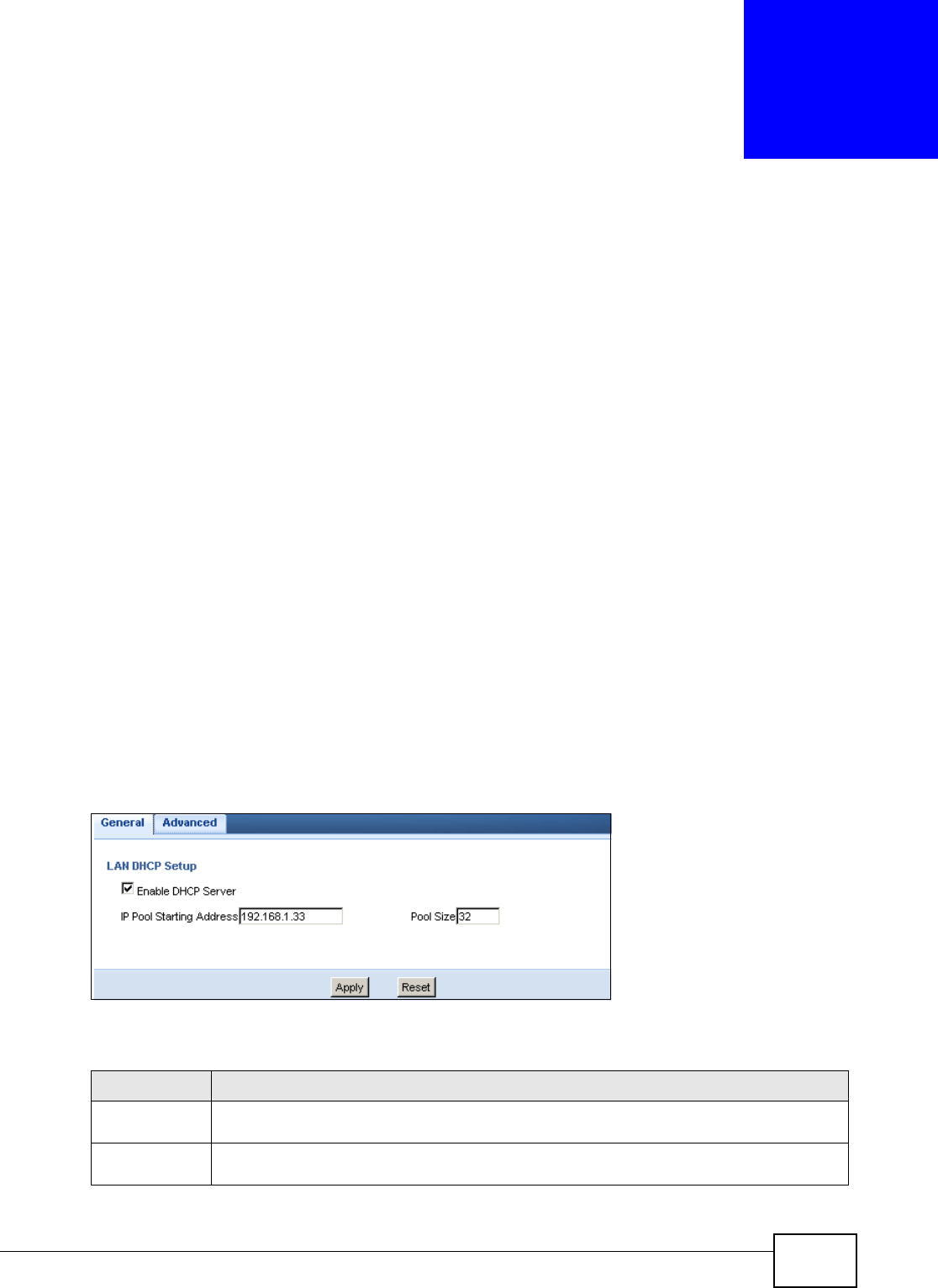
NBG-419N v2 User’s Guide 137
CHAPTER 16
DHCP Server
16.1 Overview
DHCP (Dynamic Host Configuration Protocol, RFC 2131 and RFC 2132) allows individual clients to
obtain TCP/IP configuration at start-up from a server. You can configure the Router’s LAN as a DHCP
server or disable it. When configured as a server, the Router provides the TCP/IP configuration for
the clients. If DHCP service is disabled, you must have another DHCP server on your LAN, or else
the computer must be manually configured.
16.2 What You Can Do
•Use the General (Section 16.3 on page 137) screen to enable the DHCP server.
•Use the Advanced (Section 16.4 on page 138) screen to assign IP addresses on the LAN to
specific individual computers based on their MAC Addresses.
16.3 General Screen
Use this screen to enable the DHCP server. Click Network > DHCP Server. The following screen
displays.
Figure 97 Network > DHCP Server > General
The following table describes the labels in this screen.
Table 60 Network > DHCP Server > General
LABEL DESCRIPTION
Enable DHCP
Server
Enable or Disable DHCP for LAN.
IP Pool Starting
Address
This field specifies the first of the contiguous addresses in the IP address pool for LAN.
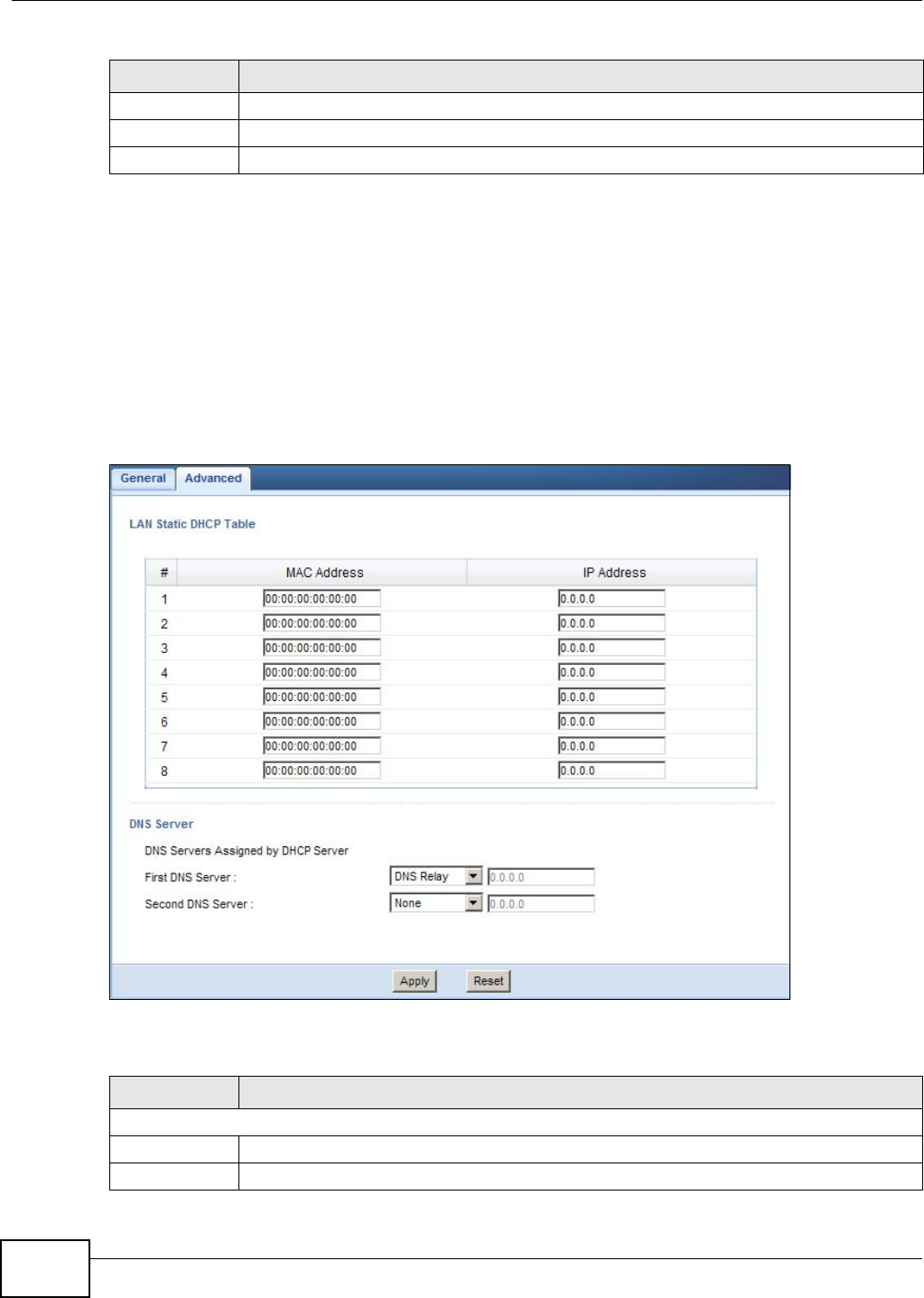
Chapter 16 DHCP Server
NBG-419N v2 User’s Guide
138
16.4 Advanced Screen
This screen allows you to assign IP addresses on the LAN to specific individual computers based on
their MAC addresses. You can also use this screen to configure the DNS server information that the
Router sends to the DHCP clients.
To change your Router’s static DHCP settings, click Network > DHCP Server > Advanced. The
following screen displays.
Figure 98 Network > DHCP Server > Advanced
The following table describes the labels in this screen.
Pool Size This field specifies the size, or count of the IP address pool for LAN.
Apply Click Apply to save your changes back to the Router.
Reset Click Reset to begin configuring this screen afresh.
Table 60 Network > DHCP Server > General (continued)
LABEL DESCRIPTION
Table 61 Network > DHCP Server > Advanced
LABEL DESCRIPTION
LAN Static DHCP Table
# This is the index number of the static IP table entry (row).
MAC Address Type the MAC address (with colons) of a computer on your LAN.

Chapter 16 DHCP Server
NBG-419N v2 User’s Guide 139
IP Address Type the LAN IP address of a computer on your LAN.
DNS Server
DNS Servers
Assigned by
DHCP Server
The Router passes a DNS (Domain Name System) server IP address (in the order you
specify here) to the DHCP clients. The Router only passes this information to the LAN DHCP
clients when you select the Enable DHCP Server check box. When you clear the Enable
DHCP Server check box, DHCP service is disabled and you must have another DHCP sever
on your LAN, or else the computers must have their DNS server addresses manually
configured.
First DNS
Server
Second DNS
Server
Select From ISP if your ISP dynamically assigns DNS server information (and the Router's
WAN IP address). The field to the right displays the (read-only) DNS server IP address that
the ISP assigns.
Select User-Defined if you have the IP address of a DNS server. Enter the DNS server's IP
address in the field to the right. If you chose User-Defined, but leave the IP address set to
0.0.0.0, User-Defined changes to None after you click Apply. If you set a second choice to
User-Defined, and enter the same IP address, the second User-Defined changes to None
after you click Apply.
Select DNS Relay to have the Router act as a DNS proxy. The Router's LAN IP address
displays in the field to the right (read-only). The Router tells the DHCP clients on the LAN
that the Router itself is the DNS server. When a computer on the LAN sends a DNS query to
the Router, the Router forwards the query to the Router's system DNS server (configured in
the WAN > Internet Connection screen) and relays the response back to the computer.
You can only select DNS Relay for one of the three servers; if you select DNS Relay for a
second or third DNS server, that choice changes to None after you click Apply.
Select None if you do not want to configure DNS servers. If you do not configure a DNS
server, you must know the IP address of a computer in order to access it.
Apply Click Apply to save your changes back to the Router.
Reset Click Reset to begin configuring this screen afresh.
Table 61 Network > DHCP Server > Advanced (continued)
LABEL DESCRIPTION

Chapter 16 DHCP Server
NBG-419N v2 User’s Guide
140